

EVEREST THREE PASSES TREKKING ROUTE

EVEREST THREE PASSES
ROUTE GUIDE

Pin Tweet Share WhatsApp
A GUIDE TO THE TRAIL
In this guide we share detailed trail notes about the Everest Three Passes trekking route. This includes section distances and estimated trekking times, plus info about food, services, and accommodation options along the way. There is also a description of the trail and we offer a downloadable route map for online or offline use. As a visual accompaniment to this written guide you can watch our Everest Three Passes film, and for everything else you need to know to plan your trek, check out our Essential Guide To The Everest Three Passes Trek .
TREK OVERVIEW THREE PASSES FILM MAP & GPX DOWNLOAD THREE PASSES ITINERARY ELEVATION PROFILE
TREKKING ROUTE LUKLA → MONJO MONJO → NAMCHE BAZAAR NAMCHE ACCLIMATISATION DAY NAMCHE → PANGBOCHE PANGBOCHE → DINGBOCHE NANGKARTSHANG HIKE DINGBOCHE → CHUKHUNG CHUKHUNG RI HIKE CROSSING KONGMA LA LOBUCHE → GORAK SHEP KALA PATTHAR HIKE EVEREST BASE CAMP GORAK SHEP → LOBUCHE LOBUCHE → DZONGLHA CROSSING CHO LA DRAGNAG → GOKYO GOKYO RI HIKE CROSSING RENJO LA THAME → MONJO MONJO → LUKLA
*Some of the links in this post are affiliate links – if you purchase a product or service via these links, we may earn a small commission at no extra cost to you . This helps offset the cost of running this blog and keeps us travelling so that we can continue to produce great content for you. We greatly appreciate your support!*
EVEREST THREE PASSES TREK OVERVIEW
- DISTANCE | Approx 160 km (incl. acclimatisation/day hikes)
- DURATION | 17 – 22 days (incl. flying to/from Lukla)
- START/END | Lukla
- PERMITS REQUIRED | Khumbu Trek Card 2000 NPR; Sagarmatha National Park Fee 3000 NPR (SAARC nationals 1500 NPR / Nepali nationals 100 NPR)
- TREKKING SEASON | Best Seasons: April to Mid-May , October to Mid-November ; Shoulder Seasons: March, Late May, September, Mid-November to December ; Avoid: June to August, January to February
- TREK DIFFICULTY | Challenging
- ELEVATION GAIN/LOSS | +/- approx 13500 metres (incl. acclimatisation/day hikes)
- MAX ALTITUDE | 5611 m (Kala Patthar) or 5514 m (Kongma La)
- GUIDE MANDATORY? | Khumbu Pasanglhamu Rural Municipality has stated that it is NOT mandatory to trek with a guide in the Khumbu region
- ACCOMMODATION | Teahouses/Guesthouses in villages along the trail
- TREK COST | $34 – $140 USD per person, per day (budget independent trekker to fully inclusive package)
- RECOMMENDED TREKKING AGENCY | Himalayan Masters , Quote HOGG5 for 5% discount
DISTANCE Approx 160 km (incl. acclimatisation/day hikes)
DURATION 17 – 22 days (incl. flying to/from Lukla)
START/END Lukla
PERMITS REQUIRED Khumbu Trek Card 2000 NPR Sagarmatha National Park Fee 3000 NPR (SAARC nationals 1500 NPR, Nepali nationals 100 NPR)
TREKKING SEASON Best Season April to Mid-May October to Mid-November Shoulder Seasons March, Late May, September Mid-November to December Months To Avoid June, July, August January and February
TREK DIFFICULTY Challenging
ELEVATION GAIN/LOSS +/- approx 13500 metres (incl. acclimatisation/day hikes)
MAX ALTITUDE 5611 m (Kala Patthar) or 5514 m (Kongma La)
GUIDE MANDATORY? Khumbu Pasanglhamu Rural Municipality has stated that it is NOT mandatory to trek with a guide in the Khumbu region
ACCOMMODATION Teahouses/Guesthouses in villages along the trail
TREK COST $34 – $140 USD per person, per day (budget independent trekker to fully inclusive package)
OUR RECOMMENDED TREKKING AGENCY Himalayan Masters , Quote HOGG5 for 5% discount
EVEREST THREE PASSES TREKKING FILM
Get a sense of the Everest Three Passes trekking route in our ‘silent hiking’ style ambient film.
Watch the behind the scenes version of our Everest Three Passes trek on Instagram stories
Watch the behind the scenes version of our three passes trek on instagram stories .
Everest Three Passes Trek Stories
MAP & GPX DOWNLOAD
EVEREST THREE PASSES TREKKING ROUTE //
We have created a detailed Everest Three Passes digital trekking map to accompany this guide. The full trekking route is marked, including Everest Base Camp and Gokyo Lakes, along with day hikes around Namche Bazaar and Gokyo, and to Nangkartshang, Chukhung Ri, Kala Patthar, and Gokyo Ri. Alternative routes avoiding the passes are also marked, as is the overland route between Salleri and Lukla.
Detailed stats and an elevation profile are included for each route section. Guesthouse settlements and tea shops are also marked, as well as key sights and practical info such as checkpoints, hospitals, and transport hubs. Guesthouses as per our own trek itinerary are marked, including info about prices and services, phone numbers (where possible), and a copy of the menu. Photos are included with almost every pin.
You can use the digital map online, or download it for offline use with a mapping app such as Organic Maps, Maps.me or Gaia GPS. This is very helpful for navigation assistance on the trail. It allows you to quickly pinpoint key places and services along the way and calculate distances and elevation differences between destinations.
Note that while we’ve tried to be as accurate as possible when recording and mapping the route, changes on the ground are inevitable (especially on routes crossing glaciers) and this map should not be solely relied upon for navigation.
EVEREST THREE PASSES TREK ITINERARY
TREK ITINERARY
We have outlined below what we feel is an ideal itinerary for the Everest Three Passes trekking route. This is a 19 day itinerary which includes flying to and from Lukla. We have noted the trekking distance and an approximate trekking time for each day (excluding lunch stops, breaks, etc), as well as stats on elevation gain/loss and sleeping altitude.
Note that this itinerary outlines an anti-clockwise trekking route, crossing Kongma La first, and Renjo La last. You can read more about our thoughts on why this is the best direction to trek in the ‘Is it best to do the Everest Three Passes trek clockwise or anti-clockwise?’ section of our guide.
For a few alternative route options which you may wish to consider, check out this section of our guide .
If viewing on a mobile device or tablet, scroll to the right to see the full table or flip your screen to landscape mode
*On days 10 and 11 the standard itinerary that most people follow is to visit EBC after lunch at Gorak Shep, then hike up Kala Patthar in the dark for sunrise the next morning (when it is bitterly cold). If you swap these two around as per the above suggested itinerary, you are guaranteed to have a less busy experience at both EBC and on the trail up Kala Patthar. As the skies are usually clearer in the morning you are also likely to have better views at EBC, however it is possible that the views from Kala Patthar will be obscured by afternoon clouds. If you’re lucky and have clear afternoon skies, then you will be treated to a fiery sunset glow on Everest and the surrounding mountains. If you hike up Kala Patthar in the morning, your mountain views will be brief as the sun rises directly behind Everest and you’ll soon be looking directly into the sun.
OUR RECOMMENDED TREKKING AGENCY
We partnered with Himalayan Masters for our Langtang Valley, Gosainkunda, and Everest Three Passes treks, and found them to be very professional and committed to a high level of service
To enquire about booking your own trek, get in touch via email at [email protected] and mention the code HOGG5 to get a 5% discount off the cost of your trip
EVEREST THREE PASSES TREK ELEVATION PROFILE
ELEVATION PROFILE
The image below shows the elevation profile of the Everest Three Passes trek, starting and ending in Lukla and going in an anti-clockwise direction, crossing Kongma La first, Cho La second, and Renjo La third. The route shown here includes the various acclimatisation and side hikes outlined in this guide. Elevation is displayed in metres and distance in kilometres.

3D ROUTE MAP
Watch our 3D relief map video of the route to visualise the landscape and get a sense of the Everest Three Passes trek.
EVEREST THREE PASSES TREKKING ROUTE BREAKDOWN
ROUTE BREAKDOWN AND TRAIL DESCRIPTION
Below is the breakdown of the Everest Three Passes trekking route as outlined in the itinerary table above. Each day includes an overview, distances, elevation gain and loss, estimated trekking times without breaks, a detailed description of the trail, and info about food, services, and accommodation options.
The following route breakdown starts and ends in Lukla. For detailed information about the various ways of getting to/from Lukla, check out the the ‘How to get to Lukla’ section of our guide.
DAY 1: LUKLA → MONJO
Everest three passes trekking route day 1:, lukla → monjo, 12.6 km | + 1117 m / – 1148 m | 4.5 hours, + 1117 m / – 1148 m.
Today is a straightforward introduction to the trek. There are no lengthy ascents or descents and mostly wide stone paths to walk on, although there are plenty of short ups and downs throughout the day. There are a couple of checkpoints along the way and regular villages with guesthouses where you can eat or stop for tea. You’ll no doubt encounter plenty of pack mules and yaks – when letting them pass, be sure to wait on the side of the trail without a drop-off.

PLACES ON THE LUKLA TO MONJO ROUTE
The table below details the main guesthouse villages and services available along the route from Lukla to Monjo. On this section, there are also many smaller settlements and guesthouses that lie between those mentioned in the table. The distances and times noted cover the sections between the stops, not the total from the start.
If viewing on a mobile device or tablet, scroll to the right to see the full table or flip your screen to landscape mode.
Lukla → Phakding
7.5 km | + 472 m / – 687 m | 2.5 hours, + 472 m / – 687 m.
From the airport, the route leads through the town of Lukla, a bustling place with shop-lined streets and plenty of guesthouses and restaurants. Pass through the Pasang Lhamu Gate (celebrating the first Nepali woman to summit Everest) and at the bottom of the steps you’ll reach the Khumbu Trek Card registration desk.
It takes around 2 hours to trek from here to Phakding. The route leads downhill from Lukla before climbing towards Phakding, although there are plenty of flatter sections and some short ups and downs. The trail is mostly on wide stone paths, with a few bridges to cross along the way. You’ll pass through villages regularly and there are plenty of options for tea or food stops. There are also a number of mani stones and prayer wheels – be sure to walk on the left when passing these.
Phakding is a busy lunch spot and also a popular overnight stop for trekkers heading to Namche Bazaar. You’ll come to the main part of the village first, with a few more guesthouses situated across the bridge on the opposite side of the Dudh Koshi. Phakding is bigger than Monjo and tends to be the busier accommodation option. Continuing to Monjo means less people to share the trail with come morning.

Passing mani stones on the left between Lukla and Phakding

Phakding → Monjo
5.1 km | + 645 m / – 461 m | 2 hours, + 645 m / – 461 m.
The trail from Phakding to Monjo includes more uphill sections than before Phakding, but it isn’t too challenging. The route is similar: passing through various villages, walking on stone paths, and crossing a couple of bridges. There is another Khumbu Trek Card checkpoint at Toc Toc.
The village of Monjo is situated on a hillside and there are numerous guesthouses spread throughout, most with good views looking towards the impressive tree-covered cliffs opposite.
OUR MONJO ACCOMMODATION
NAME | Hotel Mini Tibet
ROOM | Two single beds, table, sheet and pillow, blanket + attached bathroom
ROOM COST | 1000 NPR
BATHROOM | Attached bathroom; sit down toilet; hot shower (solar)
DAL BHAT | 600 NPR (see full menu in our e-map )
SHOWER | 300 NPR for gas shower (no charge for solar shower in attached bathroom)
CHARGING | 200 NPR
WIFI | 300 NPR
PHONE SIGNAL | Phone signal, weak data
DAY 2: MONJO → NAMCHE BAZAAR
Everest three passes trekking route day 2:, monjo → namche bazaar, 5.1 km | + 983 m / – 390m | 3 hours, + 983 m / – 390m.
Today you’ll enter Sagarmatha National Park. You can enjoy lovely river and forest views and get to experience the thrill of crossing the 125 metre high Hillary Suspension Bridge (along with a couple of others). There is only one village along the way, Jorsale, which is around 40 minutes’ walk from Monjo. There are no teahouses after this however pop-up vendors can be found at a couple of spots on the climb to Namche, serving soft drinks, biscuits, fruit, face masks, strepsils, cigarettes… all the essentials ; ) Make sure you have enough water with you to last until Namche Bazaar.

PLACES ON THE MONJO TO NAMCHE BAZAAR ROUTE
Climb up through Monjo and you’ll reach the Sagarmatha National Park entrance on the edge of the village, where your permit will be checked.
Pass through the decorative gate and descend the wide stone staircase before crossing the Dudh Koshi on a suspension bridge and entering the small village of Jorsale. There are a few guesthouses, small shops, and cafes here.
Shortly after Jorsale you’ll cross a second suspension bridge and follow a wide trail alongside the river where you can enjoy increasingly beautiful views. About 1 km from the second suspension bridge you’ll reach a wonderful viewpoint where you can look up at the Hillary Suspension Bridge, the third and most impressive of the day.

The Hillary Suspension Bridge as seen from the valley floor, with the old bridge still in place below

From here you’ll be climbing all the way to Namche Bazaar, an ascent of about 700 metres. A wide stone staircase leads up to the bridge, where you may need to wait a few minutes depending on how busy the trail is. The Hillary Bridge can be pretty nerve wracking to cross, given its height from the ground (125 metres), and also if it’s especially windy and/or crowded.
After the bridge the climb continues up through pine forest on a rock and dirt trail which can get quite dusty, and which is also fairly steep in parts. This section can be a bit of a bottleneck, with lots of yak and mule trains, porters, and groups of trekkers moving in both directions. Look out for a convenient side trail favoured by porters which leads slightly uphill to the right shortly after the public toilets. This route runs parallel to the main trail for a while before rejoining it near the top, and it’s usually less busy. You’ll need to show your Khumbu Trek Card at the checkpoint on the outskirts of Namche, after which it’s just a short distance to the town itself.
Namche Bazaar has a mix of guesthouses and local homes, dotted up the terraced hillsides in a horseshoe shape. It’s a bustling place and the main hub for the region, with trekkers and climbers converging here on the way up and down to Everest Base Camp, the Three Passes, Gokyo Lakes, and elsewhere. There are lots of shops, bakeries, cafes, and even an ATM or two (although it’s best not to rely on this and bring cash from Kathmandu). If you need to pick up any extra gear, there are at least three genuine gear shops stocking Icebreaker, Osprey, Sea to Summit, Black Diamond, Salomon, La Sportiva, Katadyn, The North Face, etc, plus the usual fake gear shops.
OUR NAMCHE BAZAAR ACCOMMODATION
NAME | Hotel 8848
ROOM | Two single beds, table, sheets and pillows, blanket + attached bathroom
ROOM COST | 1500 NPR (attached bathroom); 1000 NPR (shared bathroom)
BATHROOM | Attached bathroom; sit down toilet; hot shower (solar and gas)
DAL BHAT | 750 NPR (see full menu in our e-map )
SHOWER | Free (rooms with attached bathroom); 500 NPR (rooms with shared bathroom)
CHARGING | Free in room with attached bathroom
WIFI | Free
PHONE SIGNAL | Yes
OTHER | Comfortable; great rooms (with attached bathroom) on top floor
DAY 3: NAMCHE BAZAAR ACCLIMATISATION DAY
Everest three passes trekking route day 3:, namche bazaar acclimatisation day, 5.6 km – 9.1 km | +/- 550 – 740 m | 3 – 6 hours, 5.6 km – 9.1 km, +/- 550 – 740 m, 3 – 6 hours.
It’s important to acclimatise properly throughout your Everest Three Passes trek. This allows your body time to get used to the ever-increasing altitude as you ascend to 5000 metres and above. Building in rest days, staying well hydrated, and going on acclimatisation hikes (where you climb higher during the day but sleep lower at night) are all good ways of helping your body acclimatise. Unless you are already acclimatised (for example you have been at altitudes of 4000 metres and higher within the previous week), spending a second night at Namche Bazaar is highly recommended, even if it seems like you feel physically fine. Use the extra day to go on an acclimatisation hike (no big backpack required!) and take the time to rest and hydrate.

The most common destination for an acclimatisation hike from Namche Bazaar is the Hotel Everest View (3880 m) , where you can get lunch or a drink and enjoy fantastic views from the terrace. It takes around 3 hours to hike up to the hotel and back down again.

Morning view of Namche Bazaar from the northeast

A must-visit on the way is Sagarmatha Next , a learning/experience/visitor centre and gallery championing waste management solutions for the Khumbu region. There are exhibitions on local culture, geography, history, climbing and trekking, flora and fauna, and the environmental challenges facing the region. There is also an art gallery showcasing artwork made from waste, a film salon showing documentaries, a VR experience, and a shop selling upcycled souvenirs made from waste plastic from the Khumbu, designed by Super Local. Check out this video to learn more about the great design project. At the Waste Lab artists and product designers work on upcycling projects, and workshops are held regularly. There is a cafe, too.
If you are interested in extending your hike for the day and seeing more of the local area, doing a loop via Khumjung village is a great option. Khumjung is the largest Sherpa village in the region, with an impressive monastery and a school founded by Edmund Hillary in 1960. The original classroom is now the Sir Edmund Hillary Visitor Centre , another great place to visit and learn about the Khumbu region. The loop hike (including Hotel Everest View) is around 7.5 km, and you should allow up to 5 hours for the hike. If you are interested and have the energy you could also include a visit to Khunde village (home to another monastery). This would extend the route to around 9.1 km and you should allow up to 6 hours.
SEE MORE FROM NEPAL

Everest Base Camp Trek: The Essential Guide

Everest Three Passes Trekking Route Guide

Everest Three Passes Trek: The Essential Guide

Gosainkunda Helambu Trekking Route Guide

Gosainkunda Trek: The Essential Guide

Langtang Valley Trekking Route Guide

Langtang Valley Trek: The Essential Guide

What To Pack For Trekking In Nepal

Upper Mustang Trek: The Essential Guide

Upper Mustang Trek Itinerary: A Day By Day Account

Annapurna Circuit Trek: The Essential Guide

Annapurna Circuit Trek Itinerary: A Day By Day Account

Manaslu Circuit Trek: The Essential Guide

Manaslu Circuit Trek Itinerary: A Day By Day Account
Day 4: namche bazaar → pangboche, everest three passes trekking route day 4:, namche bazaar → pangboche, 13.6 km | + 1541 m / – 1020 m | 6 hours, + 1541 m / – 1020 m.
This day offers fantastic mountain scenery and a beautiful trekking trail, with a mix of open hillside and forest paths. The start and end of the day is mostly straightforward, with a big climb in the middle section between Phunki Thanga and Tengboche. The monastery in Tengboche is well worth visiting, so be sure to allow enough time if you are interested.

PLACES ON THE NAMCHE BAZAAR TO PANGBOCHE ROUTE
Namche bazaar → tengboche, 9.5 km | + 1197 m / – 753 m | 4.5 hours, + 1197 m / – 753 m.
After climbing the steep steps through Namche Bazaar, the trail follows a fairly flat, wide dirt path that leads around the hillside. There is a bit of up and down but it’s generally easy going up until Kyangjuma (about 4 km). You’ll pass the Tenzing Norgay memorial chorten on the way, a great spot where you can see Ama Dablam, Lhotse, Everest, and other famous peaks. There are a few guesthouses in Kyangjuma and the views are nice. This makes a good tea stop, or a quieter alternative to overnighting in Namche.

Trekkers enjoy mountain views from the Tenzing Norgay memorial chorten

From Kyangjuma to Phunki Thanga it’s mostly downhill on a pleasant forest trail, passing through the small teahouse village of Lawi Schyasa a little beyond the halfway point. The options for food and accommodation are better at Phunki Thanga, and this is a common early lunch stop, good for fueling up before the big climb to Tengboche.
From Phunki Thanga, cross the Dudh Koshi on the suspension bridge and stop at the checkpoint before tackling the big climb. It’s around a 600 metre ascent up to Tengboche, a mixture of open hillside and forest. This can take about 2 hours. The first half is quite steep on dusty switchbacks while the second half is a bit more gradual.
Tengboche is dominated by the large gompa (monastery), with just two guesthouses in the village. The Tashi Delek bakery serves excellent cakes and real coffee along with the usual food menu items. The views from the balcony are wonderful, looking over to the monastery and up the mountainous valley. You can visit the monastery daily from 7am – 8am, 9am – 11am, and 1pm – 5:30pm. You can witness the monks chanting at 3pm, an option for those who choose to stay overnight in Tengboche.

The large monastery complex at Tengboche

Tengboche → Pangboche
4.1 km | + 344 m / – 267 m | 1.5 hours, + 344 m / – 267 m.
From Tengboche the trail descends about 150 metres to Deboche, a small settlement with a handful of guesthouses. From here the trail is fairly flat before climbing gently on a wide path through lovely forest, with trees dripping in Old Man’s Beard and views over the Dudh Koshi. After crossing a suspension bridge you’ll climb an open hillside on a mixture of paths and stone staircases, the final stretch to Pangboche.
Pangboche is a good sized village, quite attractive with a mix of teahouses and homes, and lots of farming fields stretching towards the river. There are fantastic mountain views when the skies are clear.
OUR PANGBOCHE ACCOMMODATION
NAME | Om Kailash
ROOM COST | 1000 NPR (attached bathroom); 500 NPR (shared bathroom)
BATHROOM | Attached bathroom with sit-down toilet and sink but no shower
DAL BHAT | 695 NPR (see full menu in our e-map )
SHOWER | 700 NPR for gas shower
CHARGING | 300 NPR (full battery charge)
WIFI | 600 NPR (Airlink for 24 hours)
DAY 5: PANGBOCHE → DINGBOCHE
Everest three passes trekking route day 5:, pangboche → dingboche, 5.7 km | + 602 m / – 250 m | 2.5 hours, + 602 m / – 250 m.
This is a short and easy day with wonderful views throughout. The trail climbs gently up the valley between the two villages of Pangboche and Dingboche. There are just a couple of short steeper sections, before Shomare and after the bridge.

PLACES ON THE PANGBOCHE TO DINGBOCHE ROUTE
Leaving Pangboche, a dusty trail climbs gently up the valley across scrubby hillside, with the river below and fantastic mountain views above. It takes about an hour to reach Shomare, with a bit of a climb at the end. Here you’ll find a number of teahouses.
The gentle climb continues and in less than 1 km you’ll reach the lone Sunrise Lodge, situated in a broad valley with braided trails approaching it. These eventually funnel back into a single trail which leads to a small metal bridge at the confluence of the Lobuche and Imje Khola rivers.

The trail leads down to a small bridge then climbs up and around the next hillside until Dingboche is revealed

The trail climbs a little more steeply after the bridge, up and around the hillside, but soon becomes a gentle incline once again. About 30 minutes beyond the bridge you’ll catch your first sight of Dingboche and arrive in the village shortly after.

First sight of Dingboche, a village with many guesthouses where people stay two nights for acclimatisation

First sight of Dingboche, a big village with many guesthouses where people stay two nights for acclimatisation
There are many guesthouses in Dingboche, as well as local houses, and the views of Ama Dablam from the village are wonderful. There are a few bakeries showing mountain-related films in the afternoon. Good options include the cosy Cafe Himalaya, which shows Sherpa at 2:30pm and has lots of old mountaineering photos and gear on display inside, and Cafe 4410, which has a large modern interior, a big food menu, and shows Sherpa and Everest from 2pm. The French Bakery (which also has a pharmacy) shows Free Solo , Meru , and a film about Helicopter rescues in the Himalaya on alternate days. Most of them also offer free device charging if you spend 400 rupees, which is more or less what it will cost to charge at your guesthouse.
OUR DINGBOCHE ACCOMMODATION
NAME | Mountain Heritage Inn
ROOM | Two single beds, sheets, pillows, blankets, carpeted room; spacious window ledge (no table); attached bathroom
ROOM COST | 1500 NPR (attached bathroom)
BATHROOM | Sit-down toilet and sink in attached bathroom, but no shower
DAL BHAT | 1000 NPR (see full menu in our e-map )
SHOWER | 800 NPR for gas shower
CHARGING | 500 NPR per device
WIFI | 24 hr/48 hr Airlink cards (700 NPR / 1500 NPR)
PHONE SIGNAL | No
OTHER | Spacious dining room and spacious rooms too; extra blanket charged at 200 NPR
DAY 6: NANGKARTSHANG PEAK DAY HIKE
Everest three passes trekking route day 6:, nangkartshang peak (5039 m) day hike, 5 km | +/- 766 m | 4 hours.
The hike up to Nangkartshang Peak (5039 m) offers fantastic views. It is also great for acclimatisation as you will climb high but descend to sleep at around 4300 m again. There is a clear path all the way to the top. The 766 metre climb should take around 2.5 – 3 hours, with the descent about half that. It’s best to start early (around 7:30am) for the best chance of clear views and calm conditions. Ensure you have plenty of water, snacks, and warm layers.

The climbing starts immediately from Dingboche, with the trail leading up from behind the French Bakery and Mountain Heritage Inn. You’ll pass under two white stupas with painted eyes near the start, then reach a series of small chorten on the ridge. From here you can see the classic Everest Base Camp trekking trail heading northwest to Lobuche. Alternative trails from the upper part of the village also lead to the chorten, skipping the stupas.
Continue climbing steadily uphill and you’ll pass some small prayer flags and rock cairns at various points. The views are fantastic, looking northeast up the valley towards Chukhung, across to Ama Dablam (6812 m), and to numerous other mountains all around. The final section to the top is a little steep so take your time, and there are some big rocks around the prayer flags with a steep drop-off on the eastern side, so take care.
After enjoying the views, follow the same route back down to Dingboche.

Trekkers climbing towards the second stupa above Dingboche

People rest and take in the views from the prayer flags (5039 m) on Nangkartshang

Fantastic view of Ama Dablam (6812 m)
COME JOIN US ON INSTAGRAM

DAY 7: DINGBOCHE → CHUKHUNG
Everest three passes trekking route day 7:, dingboche → chukhung, 5 km | + 451 m / – 19 m | 2.5 hours, + 451 m / – 19 m.
Today you will depart from the classic Everest Base Camp trekking route, so you can expect the trail to be much less busy until you rejoin the EBC route at Lobuche. It is a short trekking day. You’ll climb gently up the valley on a dirt trail through scenic rocky, scrubby landscape to the small teahouse village of Chukhung, situated at 4730 m. There are no other villages or teahouses on the route, so be sure to have enough water with you for the duration of the walk.

Start today’s walk by heading up through Dingboche to reach the extensive terraces of walled fields at the northeastern edge of the village. Leaving Dingboche behind, the trail climbs gradually up the valley, with the Imja Khola flowing to the right. Ama Dablam takes on a different look with her two distinct peaks appearing side by side, and Island Peak will come into view as you get closer to Chukhung.

A memorial to climbers who lost their lives on Lhotse, with Island Peak in view behind and to the right

A memorial to climbers who lost their lives on Lhotse, with Island Peak behind to the right
There are just a handful of teahouses at Chukhung, and it’s usually much less busy than Dingboche as it’s off the EBC trail.
OUR CHUKHUNG ACCOMMODATION
NAME | Yak Land Lodge
ROOM | Two single beds, sheets, pillows, blankets; spacious window ledge to store stuff (no table)
ROOM COST | 1000 NPR (shared bathroom option only)
BATHROOM | Shared Bathroom: 1 x squat toilet, 1 x sit-down toilet, separate shower room; kept very clean; no indoor sink
DAL BHAT | 745 NPR (see full menu in our e-map )
SHOWER | 650 NPR for bucket shower; gas shower not working when we stayed
CHARGING | 500 NPR (phone); 1500 NPR (power bank)
WIFI | 24 hr Airlink cards (700 NPR)
OTHER | Very nice owners; warm dining room; highly recommend
DAY 8: CHUKHUNG RI DAY HIKE (5380 m or 5516 m)
Everest three passes trekking route day 8:, chukhung ri day hike (5380 m or 5516 m), 4.9 – 5.9 km | +/- 645 – 810 m | 3 – 5 hours, 4.9 – 5.9 km, +/- 645 – 810 m, 3 – 5 hours.
This is a fantastic day hike for both views and acclimatisation. The main viewpoint is at 5380 m, with a higher viewpoint at 5516 m. Both are accessed from the same saddle, with the lower viewpoint to the southwest and the higher viewpoint up a steeper and narrower rocky ridge trail to the northeast. Expect it to take around 2 to 3 hours to climb to the viewpoint at 5380 m, and around 1 hour to descend via the same route. It should take about an hour extra if you want to continue to the upper viewpoint at 5516 m. Leaving early in the morning gives you the best chance of clear views, and you can aim to return to Chukhung for lunch. Ensure you have plenty of water, snacks, and warm layers.

Head northeast out of Chukhung and cross a small metal bridge. The trail continues up the scrubby hillside, climbing steadily on a dirt trail for around an hour. After ascending approximately 240 metres, you’ll reach an open plateau where you can take a moment to appreciate the views.
Heading north, the trail climbs gently before becoming steeper on the far side of the plateau. From here you’ll climb to the saddle 200 metres above, on a long straight trail that turns to switchbacks nearer the top. The saddle is marked by numerous cairns and the ground here is made up of large slabs of shale. It’s absolutely worth continuing the short distance up the trail to the southwest (left) viewpoint, marked by more flags, cairns, and complete with stunning 360° views. In clear weather you’ll see Lhotse, Nuptse, Island Peak, Ama Dablam, and numerous other majestic snowy peaks. It’s a wonderful spot to relax for an hour or so and soak it all up.

Stopping to appreciate the views after the initial climb up from Chukhung

Looking up at the south face of Nuptse from the main Chukhung Ri viewpoint (5380 m)

Looking southwest down the valley towards Dingboche and beyond, from the main Chukhung Ri viewpoint (5380 m)
If you are confident on such terrain and have the energy, you can continue up to the higher viewpoint (5516 m). To get there, return to the saddle and follow the trail climbing northeast up the narrow rocky ridge (very steep towards the end).
When you’re done, descend to Chukhung the same way you came.
HOW ABOUT TACKLING THE MANASLU CIRCUIT?

THE ESSENTIAL GUIDE

DAY BY DAY ACCOUNT
DAY 9: CHUKHUNG → KONGMA LA (5514 m) → LOBUCHE
Everest three passes trekking route day 9:, chukhung → kongma la (5514 m) → lobuche, 9.8 km | + 973 m / – 792 m | 8 hours, + 973 m / – 792 m.
Today you’ll cross Kongma La (5514 m), the first (and highest) of the three passes on the Everest Three Passes trek. The day involves a long but beautiful ascent, followed by a steep and tiring descent, with a moraine glacier crossing at the end. Make sure you have plenty of water and snacks, and take a packed lunch with you. Leave early (around 6am) to have the best chance of clear views and less windy weather, and to ensure you arrive in Lobuche well before dark.

Chukhung → Kongma La
5.8 km | + 870 m / – 90 m | 5 hours, + 870 m / – 90 m.
From Chukhung, cross the bridge heading west and start climbing the scrubby hillside. It’s a fairly steep and steady climb, flattening out a bit at around 4750 m and then climbing again. The trail flattens out once more at around 5000 m, following the contour line of the hillside and curving into the next valley. From here, a gradual climb up the valley (with a few short steep sections) leads to an open expanse of grass where a big lake lies cradled by surrounding mountains.
Have a break and a snack here because the next section is the steepest climb of the day! The trail becomes narrow and climbs 150 metres on tight switchbacks over a distance of just 400 metres. From the top of the climb the trail heads north and becomes much more gradual until the final section immediately before the pass. There are a number of lakes up here, often frozen earlier in the year, and the views are wonderful. The final stretch up to the pass (marked by a cluster of prayer flags) is on a very narrow trail of loose dirt and shale, a fairly steep climb up the rocky slope.

The section before the final climb to the pass is fairly flat and offers the chance to catch your breath and use a bit less energy

The view of Kongma La as you approach from the east; the pass is at the lowest point of this ridge, reached by a short but steep rocky climb
The pass is fairly narrow but there’s still plenty of room, with lots of big rocks to sit on and soak up the incredible views. To the southeast, you can still see the distinctive form of Ama Dablam, to the north is the imposing Nuptse Lhotse massif, and to the northwest, you can see Lobuche far below on the western side of the Khumbu Glacier, a moraine glacier you’ll have to cross to reach your guesthouse for the night.

The eastern view from Kongma La, looking down over the route just trekked

Resting, having lunch, and enjoying views at Kongma La, with Nuptse visible to the north

The way down begins steeply on jumbled rocks before a clearer path descends to the valley floor and leads up onto the glacier, which you must cross to reach Lobuche
Kongma La → Lobuche
4 km | + 103 m / – 702 m | 3 hours, + 103 m / – 702 m.
The initial 200 metre descent from Kongma La is very steep. Care and concentration is required on the loose dirt, shale, and small rocks which can slide away underfoot. The next part of the descent (approx 400 metres) is still steep and slippery, but less challenging. It takes around 1.5 – 2 hours to reach the valley floor (4900 m). From here, there is a 50 metre climb up onto the rocky Khumbu Glacier. The route through this jumble of rocks and glacial lakes is marked by cairns and flags. It follows narrow dirt trails and crosses big boulders between two lakes, with a fair bit of up and down. When you reach the other side, it’s just a short descent down the grassy hillside to Lobuche.

The route down onto the glacier, where flags and small cairns mark the way

There are about eight guesthouses in Lobuche, a small teahouse settlement on the main EBC trail, situated below Lobuche East peak. It’s a busy place, packed with trekkers and climbers in peak season, and you should aim to arrive as early as possible to secure a room. If you are trekking with a guide, they may be able to call ahead and book a room for you, and if you are trekking with a porter, they may be able to go ahead and secure a room for you.
OUR LOBUCHE ACCOMMODATION
NAME | New EBC Guest House
ROOM | Two single beds, sheets, pillows, blankets; spacious room with table and big window
BATHROOM | Shared toilet (sit-down, bucket flush); sink with running water; toilet and sink on each floor
CHARGING | 500 NPR (phone); 1000 NPR (power bank)
OTHER | Large, warm dining area; comfortable rooms on top floor
DAY 10 (PART 1): LOBUCHE → GORAK SHEP
Day 10 (part 1):, lobuche → gorak shep, 4.5 km | + 316 m / – 70 m | 2.5 hours, + 316 m / – 70 m.
Altitude aside, the walk to Gorak Shep is pretty straightforward, although the up and down through the moraine glacier towards the end can be quite tiring. It’s common to check into a guesthouse, eat lunch, and then head off to Everest Base Camp in the afternoon, with most people climbing Kala Patthar for sunrise the next morning. However, if the weather is clear, we’d suggest climbing Kala Patthar for sunset (see Day 10: Part 2) and walking to EBC and back the following morning (see Day 11: Part 1) . This way you will avoid the crowds on both routes, and enjoy the best views.

PLACES ON THE LOBUCHE TO GORAK SHEP ROUTE
The initial 3 km is pretty gradual as you head up the valley from Lobuche, with one notably steep part towards the end of this section. You’ll pass the turn off for the Pyramid Hotel (also a research centre) about 900 metres beyond Lobuche. The Pyramid Hotel is a 15 minute walk off the main trail. It’s then possible to continue on a high trail from the hotel to rejoin the main route further up the valley.
Shortly after the steep section, you’ll set out across the moraine glacier. There is a fair bit of up and down on a narrow trail through rocky terrain, but spectacular mountain views abound. When you reach the edge of the glacier you’ll arrive at Gorak Shep, the highest settlement on this trek.

The route to Gorak Shep leads across a rocky and undulating path on a moraine-covered glacier

The route to Gorak Shep leads across a rocky, undulating path on a moraine-covered glacier
Gorak Shep is a small teahouse settlement with just four guesthouses. It can get very busy as almost everyone trekking to Everest Base Camp stays here. There is no good water supply, with water to serve all the guesthouses being carried from a small spring nearby. Therefore, you are unable to fill and treat water here. Instead you’ll need to carry enough with you from Lobuche or buy bottled water (approx 500 NPR per bottle). The elevation and lack of a good water supply unfortunately contributes to poor sanitation and services here.
DAY 10 (PART 2): KALA PATTHAR HIKE (5611 m)
Day 10 (part 2):, kala patthar hike (5611 m), 3.8 km | + 495 m / – 495m | 3.5 hours, + 495 m / – 495m.
Kala Patthar, translating as ‘Black Rock’, rises above Gorak Shep and offers wonderful views of Everest and other impressive mountains around here. It is the highest point you will hike to on the Everest Three Passes trek. It’s common for people to start the climb before dawn, watching the sun rise behind Everest from the top. It can be bitterly cold though, and once the sun has appeared you will be looking directly at it, obscuring the good views of Everest, Nuptse, and so on. A good alternative in clear weather is to climb Kala Patthar in the afternoon, for sunset, when the white peaks will be illuminated with an orange magic hour glow. A lack of crowds is an added bonus on an afternoon Kala Patthar hike.

Whether you decide to hike up Kala Patthar for sunset or sunrise, the climb starts directly behind Gorak Shep, with the trail leading steeply up the hillside above the settlement’s one water source. It soon levels out on a wide open hillside at about 5270 m, and Everest can now be seen from here.
Carry on up the trail, which climbs gradually for a while before a steeper section leads up to the flags at the first viewpoint. From here the final 30 metre ascent becomes rocky and difficult under foot. The top, at 5611 m, is festooned with prayer flags and there is also weather radar apparatus.

Climbing the Kala Patthar trail; the blue roofs of Gorak Shep can be seen far below, sitting alongside the extensive Khumbu Glacier

Close to the high point of Kala Patthar (the prayer flags and antenna can just be seen on the left), with Pumori (7161 m) rising majestically behind
The clouds parting to reveal the massive bulk of Mount Everest, about 30 minutes before sunset
It takes about 2 – 2.5 hours to get to the top, and about an hour to descend the same way.
OUR GORAK SHEP ACCOMMODATION
NAME | Himalaya Lodge and Restaurant
ROOM | Two single beds, sheets, pillows, blankets
BATHROOM | Basic shared squat and sit-down (that you wouldn’t actually want to sit down on) toilets; not clean; bucket flush
SHOWER | No shower facilities due to scarcity of water
CHARGING | 350 NPR per hour or 2000 NPR for full charge of a power bank
PHONE SIGNAL | Phone signal; weak data
OTHER | Very basic accommodation; very unpleasant toilet facilities
DAY 11 (PART 1): EVEREST BASE CAMP
Day 11 (part 1):, everest base camp, 6.3 km | + 255 m / – 255 m | 2.5 hours, + 255 m / – 255 m.
Start the day with a return hike to Everest Base Camp (or Kala Patthar if you visited EBC yesterday).

Head northeast out of Gorak Shep, climbing gradually up the valley. You’ll soon reach the western edge of the Khumbu Glacier, which you’ll follow the whole way to base camp. The trail is rocky in places and there is a bit of up and down, but it’s a mostly gradual climb.
Fantastic views open up towards the Khumbu Icefall, and during the spring climbing season, a sea of yellow tents can be seen spreading up the glacier to the west. As you near base camp, a trail leads downhill onto the glacier, passing small glacial lakes and perhaps some striking blue ice pinnacles.

Everest Base Camp on an April morning during the spring climbing season

After a short climb you’ll reach the ‘Everest Base Camp’ rock, which sits at an altitude of about 5280 m (not the 5364 m painted on the rock). This should be quiet enough in the morning, but expect long queues for a photo in the afternoon! You can explore further up the glacier, wandering between tented camps during climbing season in April and May.
It takes about 1.5 hours to get to EBC and around 1 hour for the return to Gorak Shep, following the same route.
DAY 11 (PART 2): GORAK SHEP → LOBUCHE
Day 11 (part 2):, gorak shep → lobuche, 4.5 km | + 68 m / – 312 m | 1.5 hours, + 68 m / – 312 m.
Retrace your steps back down the valley to Lobuche.

The return route to Lobuche follows the same trail as the day before, traversing the rocky moraine near Gorak Shep then following an easier trail for the last 3 km to Lobuche.
PLAN A TREK IN THE LANGTANG VALLEY

PLAN YOUR LANGTANG VALLEY TREK WITH OUR COMPLETE GUIDE

DETAILED TRAIL NOTES AND OTHER INFO FOR THE LANGTANG TREK
DAY 12: LOBUCHE → DZONGLHA
Everest three passes trekking route day 12:, lobuche → dzonglha, 6.6 km | + 230 m / – 321 m | 2.5 hours, + 230 m / – 321 m.
The route from Lobuche to Dzonglha is scenic and easygoing, with moderate elevation gain and loss, and straightforward terrain. It’s a day with plenty of opportunity to rest. This is welcome after a few strenuous days, and it will give you the chance to prepare for the following morning when you’ll start early to cross your second pass – Cho La. There are no villages or teahouses along the way, so be sure to have enough water and snacks for the duration of your walk.
It’s possible to combine Days 11 and 12 if you don’t need the rest, you’re pushed for time, or the weather is due to turn bad. See here for more info.

The route to Dzonglha follows the classic EBC trail southwest of Lobuche for the first 1.2 km or so, after which the trail to Dzonglha branches off to the right – a signpost marked ‘Cho La’ points the way. Follow the trail around the hillside and cross the open expanse to reach the trail leading up the opposite hillside.
After an initial short climb, the trail becomes very easygoing for the next 2 km, curving around the hillside, undulating a bit, but mostly sticking to the 4850 m contour line. It then drops down a little into a valley, climbs up the other side, and continues again on a straightforward trail around the hillside.
After another kilometre or so, you’ll spot Dzonglha on the hilltop to the left. The trail leads down through an open expanse with large rocks and climbs 50 metres or so to the small teahouse village. There are 6 guesthouses here and the mountain views are fantastic.

The clouds part to reveal Taboche (6495 m) at sunset

Clouds part to reveal Taboche (6495 m) at sunset
Climbing the hill behind Dzonglha offers a great view of the village, and even better views of the surrounding mountains.
OUR DZONGLHA ACCOMMODATION
NAME | Cholatse Guesthouse
ROOM | Two single beds, sheets, pillows, blankets; spacious room
BATHROOM | Shared toilets: 1 x squat, 1 x sit-down; sink for hand washing inside; clean
DAL BHAT | 950 NPR (see full menu in our e-map )
SHOWER | Gas shower 800 NPR
CHARGING | Phone 800 NPR; power bank 1000 NPR – 1500 NPR (depending on size)
WIFI | 24 hr Airlink cards 600 NPR
PHONE SIGNAL | None
OTHER | Cosy dining room; well kept space and toilets; recommended
DAY 13: DZONGLHA → CHO LA (5368 m) → DRAGNAG
Everest three passes trekking route day 13:, dzonglha → cho la (5368 m) → dragnag, 8.6 km | + 653 m / – 803 m | 6 hours, + 653 m / – 803 m.
Today you’ll cross the second pass on the Everest Three Passes trekking route – Cho La (5368 m). The climb to the pass is a nice mix of gradual and steep rocky trail, with an impressive icy glacier to cross just before the pass. The surrounding landscape is hugely impressive, with jagged peaks and flashes of red stone across the dramatic rock faces. From the pass, the descent is steep and rocky initially, after which a gradual climb leads up onto the ridge of a hill. From here, the final stretch leads steadily downhill to Dragnag (also known as Thangnak or Thagnak).
It’s a good idea to pack microspikes for the glacier crossing to ensure good footing and rule out any potential slips. Be sure to have plenty of water and snacks with you as there are no villages or teahouses along the way. You might want to take a packed lunch too, although there’s every chance you’ll be in Dragnag/Thangnak by lunch time. Leave early (eg. by 6:30am) to ensure you have the best chance of clear and calm weather for crossing the pass.

Dzonglha → Cho La
4.1 km | + 557 m / – 22 m | 3 hours, + 557 m / – 22 m.
Head west out of Dzonglha and climb the trail up the hillside. This soon flattens out and turns a corner, heading north. The route leads gradually up the valley for about 45 minutes before starting to climb. You’ll gain about 100 metres of elevation before the trail becomes gradual once again. You’ll then gain another 50 metres by climbing a very steep rocky trail, after which another gradual climb awaits. At the top of the next steep section, the glacier comes into view.

Impressive scenery as you head up valley from Dzonglha

Impressive scenery as you head up valley
Follow the rocky trail to the right of the valley as it climbs gently to the edge of the glacier. The route across the glacier is marked by metal poles and a well trodden path is visible. The ice is usually crunchy and not too slippery, but microspikes definitely make this crossing (680 metres distance, 80 metres elevation) less taxing. The glacier ends just below the pass and a short steep rocky climb leads up to it, with a metal rope there to assist if needed.
The pass is fairly flat, not too narrow, and is marked by a ‘Cho La’ rock and the usual prayer flags.

Crossing the glacier towards Cho La

Climbing the final rocky section up to the pass
Cho La → Dragnag
4.5 km | + 96 m / – 781 m | 3 hours, + 96 m / – 781 m.
From Cho La, the initial descent (approx 250 metres) is very steep and rocky, although a welcome metal rope is there to aid you. This steep section then ends rather abruptly, after which a flat dirt trail leads you to a boulder field which is crossed via a mixture of trail and rock-hopping.

Passing a group of trekkers ascending from the west; the trail descends steeply from Cho La for about 250 metres, crosses the valley, and climbs about 100 metres to reach the next ridge

A fairly flat trail leads across the rocky valley at the bottom of the steep descent from the pass
Beyond the rocks, follow the trail up the hillside (you have about 100 metres to climb). After this it’s downhill all the way to Dragnag/Thangnak, via a narrowing grassy valley with jumbled rocks and a stream running through it.
Dragnag has five guesthouses.
OUR DRAGNAG (THANGHAK) ACCOMMODATION
NAME | Mountain Paradise Lodge
ROOM | Two single beds, sheets, pillows, blankets; spacious room with table
BATHROOM | Shared squat toilets; sink for hand washing inside; clean
SHOWER | 700 NPR
- CHARGING | Phone 500 NPR; power bank 1200 NPR
CHARGING | Phone 500 NPR; power bank 200 NPR
DAY 14: DRAGNAG (THANGNAK) → GOKYO
Everest three passes trekking route day 14:, dragnag (thangnak) → gokyo, 3.8 km | + 184 m / – 112 m | 3 hours, + 184 m / – 112 m.
A short day but with plenty of up and down as you traverse the expansive Ngozumpa Glacier that separates Gokyo from Dragnag/Thangnak. This part of the route varies over time due to changes in the glacier, but the trail is mostly rock and dirt, with no icy sections to cross. Gokyo lake makes a spectacular end point. There are no villages or teahouses along the route so be sure to have enough water with you for the duration of the walk.
It’s possible to combine Days 13 and 14 if you don’t need the rest, you’re pushed for time, or the weather is due to turn bad. See here for more info.

From Dragnag, take the trail heading northwest around the hillside. The trail climbs gradually for about 1.1 km before reaching the edge of the glacier. From here the view towards Gokyo Ri reveals just how expansive the glacier is. You need to traverse it for about 2 km and there is a lot of up and down.

Heading down onto Ngozumpa Glacier the morning after fresh snowfall

Cairns mark the route, but the route can and does change over time due to shifts in the glacier. In heavy snow it would be very difficult to find the way, unless a track has already been made by others. There is a steep descent to get onto the glacier and a steep ascent to get off it, with an undulating trail in between. You’ll pass by numerous lakes, some likely frozen, with others a brilliant blue.
After climbing up and off the glacier, the trail curves around the hill and a spectacular view of Gokyo Lake is revealed. Beyond the lake (west) is Renjo La and looming over its northern side is Gokyo Ri, with the guesthouses of Gokyo to the right, clustered around its northeastern corner.

First sight of Gokyo Lake: Renjo La is lost in the clouds, the bulky sloping hill is Gokyo Ri, while Gokyo village lines the shore on the far right

Gokyo Lake: Renjo La is lost in the clouds beyond the lake, the bulky sloping hill is Gokyo Ri, while Gokyo itself lines the shore on the far right
There are lots of guesthouses in Gokyo and a few bakeries too. Gokyo village sits on the shore of Gokyo 3rd lake, Dudh Pokhari (commonly referred to as Gokyo Lake), which is the largest in a string of six lakes dotted up the valley. The 1st and 2nd lakes are a little to the south and the 4th, 5th, and 6th lakes are to the north, all of them running parallel to the Ngozumpa Glacier.
OUR GOKYO ACCOMMODATION
NAME | Fitzroy Inn
ROOM | Two single beds, sheets, pillows, blankets; table and chairs; lake view; attached bathroom with solar shower
ROOM COST | 3500 NPR (attached bathroom, free in-room charging, hot shower: solar or gas if too cold); 500 NPR (room with shared bathroom)
BATHROOM | Attached bathroom with sit-down toilet, sink, solar shower; shared bathroom facilities include gas shower, sit-down toilets, and indoor sinks
DAL BHAT | 900 NPR (see full menu in our e-map )
SHOWER | 700 NPR for gas shower (free if paying for attached bathroom)
CHARGING | Phone 500 NPR, power bank 1000 NPR (free in-room charging if paying for room w/attached bathroom)
WIFI | 24/48 hrs Airlink cards (600/1000 NPR)
PHONE SIGNAL | No
OTHER | Lake view from dining room and some bedrooms
DAY 15: CLIMBING GOKYO RI (5340 m)
Everest three passes trekking route day 15:, climbing gokyo ri (5340 m), 3.6 km | + 605 m / – 605 m | 3 hours, + 605 m / – 605 m.
A fantastic hike offering one of the best views in the Khumbu, taking in Gokyo Lake, the Ngozumpa Glacier, and four peaks over 8000 metres (Everest, Lhotse, Makalu, and Cho Oyu). It’s not to be underestimated though, with the 600 metre ascent entirely on a steep zig-zagging trail that climbs the hillside over a distance of 1.8 km. Hiking up for sunrise is a popular option, but if you can’t face the pre-dawn cold, an early morning climb in the warmth of the sun is spectacular too. Just don’t leave it too late as the clouds are likely to obscure your view and the wind will pick up as the morning progresses.
Be sure to take warm layers and plenty of water and snacks, plus a headtorch if you’re departing before dawn. Further hikes up to Gokyo 4th and 5th lakes are also a possibility later in the day if you have the energy and inclination.

Gokyo Ri sits on the northern side of Gokyo Lake, the trail clearly visible and the trailhead clearly marked by a signpost. To start, walk around the lakeside from the village, cross the makeshift bridge of large stones near the helipad, and soon you’ll come to the signpost. From here the climb starts, a relentlessly steep dirt trail all the way to the top. The views are wonderful throughout, and you’ll likely hear (and perhaps see) snowcocks if you and any fellow trekkers are quiet.
The area at the top is quite spread out and is extensively covered in prayer flags. You can weave your way around the rocks to get various views in all directions.

Looking down on Gokyo Lake from just below the summit of Gokyo Ri

Prayer flags and mountain views atop Gokyo Ri

A hazy view of Mount Everest (back right)
The climb takes around 2 hours. If you’re fast you can descend in about 30 – 40 minutes, otherwise allow about an hour.
If you are keen to explore more today, a good option is to walk north to Gokyo 4th lake , a 5 km return hike from Gokyo which takes around 1.5 hours, or to the 4th and 5th lakes, a 12.5 km return hike which can take up to 5 hours. If you are planning to add a third night at Gokyo onto your trek itinerary, this hike to the 4th and 5th lakes is a great option for the morning of your extra day.
PLAN YOUR GEAR WITH OUR PACKING GUIDE

WHAT TO PACK FOR YOUR TREK
DAY 16: GOKYO → RENJO LA (5388 m) → THAME
Everest three passes trekking route day 16:, gokyo → renjo la (5388 m) → thame, 20.6 km | + 909 m / – 1872 m | 8.5 hours, + 909 m / – 1872 m.
The climb to Renjo La is largely straightforward, with just a couple of steep sections amidst a generally gradual ascent. We can’t testify to the views from the pass (having crossed in falling snow), but they are supposed to be spectacular in clear weather, with Gokyo Lake and the Everest Range on display. The descent from the pass is also largely straightforward, with an initial steep section on a wide stone staircase followed by a gradual trail down the valley, and a final short steep section before Lungden.
If you have the time and energy, we’d recommend continuing to Thame after having lunch at Lungden. It’s a relatively easy walk down the valley and shouldn’t take more than 3 hours. Thame is a large, attractive village with more comfortable guesthouses than at Lungden, and at 3800 m, it’s the lowest (and warmest!) you’ll have been in nearly two weeks! As with the other high pass days, it’s advisable to leave early (6:30 am) to ensure you have the best chance of clear and calm weather. Be sure to carry enough water and snacks to last until Lungden.

PLACES ON THE GOKYO TO THAME ROUTE
Gokyo → renjo la, 4.5 km | + 706 m / – 77 m | 3 hours, + 706 m / – 77 m.
From Gokyo follow the path along the northern side of the lake. Bypass the trail to Gokyo Ri, taking the left fork and continuing straight for Renjo La. The first couple of kilometres are gradual, climbing alongside the lake to a covered shelter. Shortly after the shelter, the trail climbs steeply, gaining 240 metres in elevation over a distance of 620 metres. It then levels out, climbing gently for about 1 km and curving round to the right in a northerly direction. After this you’ll come to a steeper section once again.
The location of the pass itself isn’t obvious until the final approach, which is on a steep and rocky switchback trail. You’ll emerge at a small flat area covered in the usual prayer flags.

Approaching Renjo La, the pass isn’t the obvious dip ahead but is hidden from view; the trail leads up across the rocky section and round to the right

Resting and refueling at Renjo La
Renjo La → Lungden
6.8 km | + 59 m / – 1080 m | 2.5 hours, + 59 m / – 1080 m.
The initial descent from Renjo La is on a wide stone staircase, dropping quite steeply for around 200 metres before the trail becomes more gradual. Although steep, the steps make it relatively easy and this is the least difficult descent of the Three Passes when trekking in an anti-clockwise direction.
After the steps, the route passes a large lake and continues down the valley. About 3.5 km beyond the lake you’ll reach a notable mound of stones with a few flags. From here the trail drops down to the left and descends more steeply for the last 2 km to Lungden. There are a handful of basic teahouses in Lungden offering meals and overnight accommodation. This makes a good lunch stop if continuing to Thame.
Lungden → Thame
9.3 km | + 144 m / – 715 m | 3 hours, + 144 m / – 715 m.
From Lungden the trail descends gradually down the valley to Thame, passing through, and by, numerous scenic villages surrounded by stone-walled farming fields. These are local villages and there are just a couple of guesthouses along the route – the River View Lodge just beyond Marulung, and the Yeti Valley Guesthouse shortly before Tarangar.
There is a little bit of climbing, but the trail is mostly downhill, sticking to the right side of the Bhote Koshi after crossing the bridge at Marulung. As the altitude decreases, shrubs and trees start to appear once again. Shortly after the stupas on the southern side of Hungmo, you’ll climb to the top of a rise where Thame comes into view below. Picturesquely situated in a narrow valley, it’s a lovely village with mountains rising behind and a gompa perched on the northern hillside.

The sizeable village of Thame (3800 m), its trees and green fields a welcome sight after so many days above 4000 m

The village of Thame (3800 m), its green fields a welcome sight after so many days above 4000 m
A short downhill walk takes you into Thame where there are lots of guesthouses and plenty of local homes too.
OUR THAME ACCOMMODATION
NAME | Yak Hotel
ROOM | Two single beds, sheets, pillows, blankets; table; shared bathroom
ROOM COST | 500 NPR (rooms with shared bathroom only)
BATHROOM | Two self-contained shared bathrooms, each with a sit-down toilet, gas shower and sink
DAL BHAT | 650 NPR (see full menu in our e-map )
SHOWER | 5 00 NPR
CHARGING | 500 NPR (according to menu) but there were free-to-use working sockets in the bedrooms
WIFI | Free (not very good)
OTHER | Very nice owners, excellent food, cosy dining room; recommended; porters also allowed to sleep and eat at the guesthouse which is unusual in the Khumbu region
DAY 17: THAME → MONJO
Everest three passes trekking route day 17:, thame → monjo, 13.9 km | + 910 m / – 1872 m | 5 hours, + 910 m / – 1872 m.
There is plenty of up and down on the trail between Thame and Namche Bazaar, but the route is very scenic, passing through numerous Sherpa villages and lovely forests. From Namche onwards you’ll retrace your route from the first couple of days of this Three Passes trek, descending steeply to the Hillary Bridge, then more gradually down the valley to Monjo.

PLACES ON THE THAME TO MONJO ROUTE
Thame → namche bazaar, 8.7 km | + 517 m / – 879 m | 3 hours, + 517 m / – 879 m.
Head down through the village to return to the main trail, following the path above the river. Pass through the decorative gate and stick to the left trail curving around the hillside, ignoring any other trails that branch off to the opposite side of the valley. You’ll reach a new suspension bridge over the Bhote Koshi, crossing above the old bridge and three paintings of Guru Rinpoche on the cliff face below. The trail sticks to the northern side of the river all the way to Namche.
You’ll pass through a number of scenic Sherpa villages as you work your way down the valley. The trail descends at first and then becomes more undulating before finally rising towards Namche. Keep a look out for the Himalayan Monal, the strikingly colourful national bird of Nepal, which can be commonly spotted between Thame and Phurte. There are also beautiful sections of rhododendron and pine forest to appreciate, along with a number of gompas, mani walls, and other cultural points of interest.
As you round the hillside by the Namche Helipad, you’ll be greeted by a wonderful view of Namche Bazaar, curving around the sloping hillside in amphitheatre-like fashion. After descending to the town (and stopping for lunch) the remainder of the trek (this day and the next) involves retracing your steps from Day 1 and Day 2, all the way back to Lukla.

The view of Namche Bazaar from the west as you round the corner near the helipad

Namche Bazaar → Monjo
5.2 km | + 393 m / – 993 m | 2 hours, + 393 m / – 993 m.
Shortly after leaving Namche Bazaar you’ll reach the Sagarmatha National Park checkpoint. From here, you’ll descend 550 metres on the 2 km forest trail back to Hillary Bridge. Memories of this steep climb on Day 2 will no doubt be jogged by the many sweaty out-of-breath trekkers coming the opposite way as they start their own trek. This section can be a bit of a bottleneck, with traffic jams caused by yak and mule trains. Look out for the convenient side trail favoured by porters, leading slightly uphill to the left near the start of the descent. This route is usually less busy and runs parallel to the main trail for a while before rejoining it near the public toilets.
After crossing the Hillary Bridge, descend the stone steps and follow the scenic riverside trail to the next suspension bridge, leading to Jorsale village. On the southern side of Jorsale, cross the final suspension bridge of the day and climb the steep stone stairs to the national park entrance. From here it’s a short walk to the many guesthouses in Monjo.
NAME | Mount Kailash Lodge
ROOM | Two single beds, sheets, pillows, blankets; table; attached bathroom
BATHROOM | Sit-down toilet; sink, solar shower
DAL BHAT | 700 NPR (see full menu in our e-map )
SHOWER | 500 NPR for gas shower (free solar shower if staying in room with attached bathroom)
CHARGING | 300 NPR (phone); 500 NPR (power bank)
WIFI | 300 NPR
OTHER | Nice coffee shop attached to guesthouse
DAY 18: MONJO → LUKLA
Everest three passes trekking route day 18:, monjo → lukla, 12.6 km | + 1155 m / – 1123 m | 4 hours, + 1155 m / – 1123 m.
Today you’ll repeat the trail from Day 1 of this Everest Three Passes trekking route, a section with plenty of up and down on stone pathways. You could easily make it to Lukla in time for lunch, or you could choose to stop at Cheplung or one of the many other villages along the way, before ending your trek in Lukla in the early afternoon.

PLACES ON THE MONJO TO LUKLA ROUTE
From Monjo the trail descends to Chumoa then crosses the suspension bridge to Benkar. There is a bit of up and down on stone paths as you work your way around the hillside to the permit checkpoint at Toc Toc. Descend the steps to the metal bridge and up the other side, continuing on to the next bridge at Phakding. It takes around 1.5 – 2 hours to reach the numerous guesthouses at Phakding, likely too early for lunch. The undulating trail continues to the small villages of Ghat, Thadokoshi, and finally, Cheplung, a good lunch stop before the final 45 minute climb to Lukla.
OUR LUKLA ACCOMMODATION
NAME | The North Face Resort
ROOM | Deluxe room: double and single beds, sheets, pillows, blankets; table; large attached bathroom
ROOM COST | 2000 NPR (deluxe, 24/7 hot water); 1500 NPR (attached bathroom, solar shower); 500 NPR (shared bathroom)
BATHROOM | Large attached bathroom (deluxe room), hot shower, sink, flushing sit-down toilet
SHOWER | 500 NPR for gas shower if staying in room with shared bathroom
CHARGING | In room (no cost)
That’s it for our guide to the Everest Three Passes trekking route. We hope you found it useful. If you’ve any thoughts or experiences to share, or any questions about this trek, drop them in the comments below.
THANKS FOR READING!
If you’ve found this guide helpful, please consider leaving us a small tip. Your support is greatly appreciated and helps cover the costs of running this blog.
Kim and Del Hogg
If you’ve found this guide helpful, please consider leaving us a small tip.
Your support is greatly appreciated and helps cover the costs of running this blog.
ORGANISE YOUR TRIP
Still not sorted your travel insurance it’s not too late get a quote now.
Liked This Guide? Pin It For Later!
3 leave a reply.
Great information. Whats the situation with the teahouses on the three passes trek? First come first served? Book in advance? Is booking in advance even possible? These question are all assuming hiking in season.
Thanks, glad you’ve found it helpful. Guides will often call ahead and book a teahouse in advance, or porters might go ahead of the rest of their trekking group and secure rooms. If you’re trekking independently it’s not so easy to call ahead (you might not have a number, there may be a language barrier, etc.) so it tends to end up being a first come first served situation for independent trekkers and you might need to try a few different teahouses to get a room. Sometimes, especially in places with fewer teahouses such as Lobuche and Gorak Shep, you … Read more »
Thank you for the information.

WORK WITH US
We use cookies to ensure we give you the best possible user experience on Going the Whole Hogg. By continuing to browse this site, we assume you're happy with this.
Cookie and Privacy Settings
We may request cookies to be set on your device. We use cookies to let us know when you visit our websites, how you interact with us, to enrich your user experience, and to customize your relationship with our website.
Click on the different category headings to find out more. You can also change some of your preferences. Note that blocking some types of cookies may impact your experience on our websites and the services we are able to offer.
These cookies are strictly necessary to provide you with services available through our website and to use some of its features.
Because these cookies are strictly necessary to deliver the website, refusing them will have impact how our site functions. You always can block or delete cookies by changing your browser settings and force blocking all cookies on this website. But this will always prompt you to accept/refuse cookies when revisiting our site.
We fully respect if you want to refuse cookies but to avoid asking you again and again kindly allow us to store a cookie for that. You are free to opt out any time or opt in for other cookies to get a better experience. If you refuse cookies we will remove all set cookies in our domain.
We provide you with a list of stored cookies on your computer in our domain so you can check what we stored. Due to security reasons we are not able to show or modify cookies from other domains. You can check these in your browser security settings.
We also use different external services like Google Webfonts, Google Maps, and external Video providers. Since these providers may collect personal data like your IP address we allow you to block them here. Please be aware that this might heavily reduce the functionality and appearance of our site. Changes will take effect once you reload the page.
Google Webfont Settings:
Google Map Settings:
Google reCaptcha Settings:
Vimeo and Youtube video embeds:
You can read about our cookies and privacy settings in detail on our Privacy Policy Page.

How to Do the Everest Three Passes Trek Solo
This is possibly my favourite trek in the Himalayas. It’s 15 days of trekking through some of the tallest mountains of the world. It’s challenging and exhausting, but also one of the most rewarding hikes you’ll ever go on.
The Three Passes Trek is my favourite hike in the world. Stunning views, iconic sights (like the Khumbu glacier!), high altitude, comfortable tea houses, and so much culture all wrapped up into 17 days. This is going to be a pretty big post with everything you need to know about doing the Three Passes Trek solo, so before I jump into it, I’m going to give you a little table of contents. It’s a full three passes trek blog with loads of information about doing the 3 passes trek solo – this guide should have everything you need to know!
A Brief Summary of the Three Passes Trek

Not too many people know what this trek is! They know its a 3 pass trek, but that’s about it! I’m here to clarify.
The three passes trek is a two-week trip that follows the Everest Base Camp route before splitting off and taking you over three passes that give amazing views of the Himalayas and Mount Everest. It’s been dubbed one of the most beautiful treks in the world, and for good reason! While going on the Everest Base Camp route is nice because of its commercial status, the three passes trek takes you beyond that side of the region and show you even more of its beauty. The Gokyo Lakes trek is another popular trek in Sagarmatha National Park, and this takes you through the end point of that route.
Three Passes Trek in June?
The three passes can be a dangerous trek. You’ll only want to go when the weather is the best. The best months are November, December, and May. You want to avoid from June to September because it’ll be rainy and hazy, and flights to Lukla probably won’t operate. Furthermore, teahouses won’t be open. You also want to avoid from January to March, as it might be too snowy.
How hard is the Everest three passes trek?
You have to remember that this trek goes over three high passes. It’s definitely not easy, but it’s doable! There are some very technical paths over the passes, but if you’re fit and have mountain and altitude experience, you should be fine. That being said, I wouldn’t go alone – always make sure you’re going over a pass with other people! Everest three passes trekking is tougher than trekking just to base camp because of the tough terrain and high altitude over the three passes. This is NOT a trek for beginner hikers if you’re doing it alone.
Looking for hikes that are a little less intense? Everest Base Camp , the Annapurna Circuit, Annapurna Base Camp , Australian Base Camp , and Poon Hill are all stunning.
Three Passes Trek Itinerary

Fly to Lukla, walk to Phakding* | 3 hours | 2610m
*Alternatively, you can walk to Monjo, which is about 3 hours further, if you arrive early or are feeling up for it
Walk to Namche Bazaar | 6 hours | 3440m
Acclimatisation Day | A half day trek to Everest Viewpoint Hotel or up to Tenzing Norgay Statue
Walk to Tengboche | 4 hours | 3870m.
Walk to Dingboche | 5 hours | 4410m
Acclimatisation Day | Walk partly up Nagkartshang Peak
Walk to Chukkung | 3 hours | 4730m
Acclimatisation Day | Walk to Chukkung Ri
*Some choose to climb Island Peak from here, though you need to have a guide and proper training for that summit.*
Walk to Lobuche via Kongma La Pass (5535m)| 10 hours | 4940m
*From here, you can split from the Three Passes trek and go on to Everest Base Camp / Kala Patthar following THIS itinerary*
Walk to Dzongla | 3 hours | 4200m
Walk to Gokyo via Cho La Pass (5420m) | 10 hours | 4750 m
Rest Day | Go up Gokyo Ri or around the lakes
Walk to Lungde via Renjo La Pass (5340m) | 6 hours | 4380m
Walk to Thame | 3 hours | 3800m
Walk to Namche Bazar | 3 hours | 3440m
Walk to Lukla | 7 hours | 2850m
Budget for the Three Passes Trek or EBC

I’ve written a full budget breakdown of the Everest Base Camp trek HERE . The budget accounts for all necessary permits and your daily budget and includes a section on how much getting in and out of Lukla will cost. I would stick to this budget breakdown as a guide for the three passes trek as well.
Before You Go
You’ll need to get a TIMS card to do this trek. You can get a TIMS card in Kathmandu or Pokhara (directions here ), or on the trail in Lukla.
The trek starts in Lukla, a small mountain town. There are plenty of different ways to get to Lukla, which I’ve outlined below!
How to Get In/Out of Lukla

From Kathmandu, you’ll need to get up to Lukla for the start of the trek. You can do this many ways.
The most popular method of getting to Lukla is by aeroplane. Flights to Lukla only operate in good weather conditions (and while inconvenient, this is a good thing because the runway is VERY short), and they’ll only fly out of Kathmandu if they are sure to be able to do a round trip flight. There are often delays and cancellations, so make sure you have a couple days to spare before flights in and out of Kathmandu. You can book flight tickets online, but I recommend booking from a tour office in Kathmandu or emailing your hotel before you arrive to organise your tickets. Buy round trip! You can always cancel for a 10% (of the ticket price) fee, or if your flight is cancelled due to weather, you are entitled to a full refund of that ticket.
Helicopters
When flights are cancelled or delayed for days at a time, or for those who are on tight schedules, helicopters are the way to go. Helicopter flights are significantly cheaper going INTO Lukla than they are going OUT of Lukla. Helicopter prices depend on the season and demand. I’ve heard of people paying as little as $150 USD to fly into Lukla and as much as $500 USD to fly out. When there is a backlog of people in Lukla due to cancelled flights, helicopters are in high demand and the local “Lukla mafia” will charge as much as they please for a seat on a heli back to Kathmandu. It is standard to pay about $250 for a helicopter flight back to Kathmandu, but if there are many people who want to fly out of Lukla during peak season, I’d expect to pay $500.
That being said, if you are stuck in Lukla, you can take a helicopter to Phaplu, then a 10-hour jeep or bus ride . The helicopter will cost about $200 USD, and the jeep will cost 13,000r to 20,000r depending on the demand. I’ll go into more detail about this option in the last section.
Finally, you can walk in and out. It takes about 4 days of walking to get to Jiri or Salleri. It is hot and there is a lot of up and down, but you escape the touristy part of the trek and I’ve heard good things about this (if you like walking!).
Essential Items for Trekking in Nepal

After trekking in the Everest region multiple times, there are a few things that I’ve come to really appreciate bringing up into the mountains with me.
- • Babywipes
- • Hand Sanitizer
- • Sunscreen
- • Extra Pair of Socks
- • Trekking poles
- • Sleeping Bag (some people think relying on teahouse blankets is enough- its not!)
- • TRAVEL INSURANCE – this is very important in case you need to be helicopter evacuated out. Make sure your insurance covers this!
- • Some people like to take Diamox for altitude sickness. When I did EBC, I felt the altitude at Gorak Shep. On this trek, I didn’t feel the effects of altitude as much (excluding going over Kongma La).
Day By Day Overview / What to Expect / My Recommendations / Three Passes Trek Blog
While you can book flights to Lukla at around 8 or 9am, I’d go for the earliest flight, as those are the most likely to take off.
Our flight was early, and we got to Lukla no problem! In Lukla, you have to buy your trekking ticket. Just walk down the main street and you’ll be stopped to buy one. From there, head onto the trail! The walk to Phakding is downhill and pretty easy. Remember to walk left around the stupas and mani stones. We arrived in Phakding at about 11am, so we kept going onto Monjo, which is at a slightly higher altitude. There was more uphill on this section, but nothing so steep it was memorable.
Recommended teahouse: Mount Kailash in Monjo
The day starts off nicely. You’ll have to stop to get a national park permit and for a ticket check, and then you start walking along the river. I personally find this bit absolutely stunning! There’s a beautiful view of two suspension bridges. You’ll eventually cross the higher one. After this viewpoint, it’s all uphill to Namche. About an hour and a half into the uphill section, you’ll come up to a public bathroom. From there, you can see Everest. This is also halfway up the uphill section. You can refill water here. Continue uphill, and eventually, you’ll get to another ticket check. At this point, you’re only about 20 minutes from Namche!

Namche Bazaar is the biggest village on the trek, and it feels like paradise! I love going to the Liquid Bar at 3pm for a movie. Ordering popcorn is a must. There’s a Himalayan Java right next to the Khumbu Lodge that offers free wifi and charging if you purchase something. If you’re feeling the need for a massage, someone who summitted Everest and tried ALL the massage places in Namche recommended the one inside the Khumbu Lodge.
Recommended teahouse: Khumbu Lodge. We splurged on a room with an electric blanket, charging, an attached bathroom (with a hot shower!), and a double bed for $25 USD.
The weather for us was poop. We wanted to walk up to the Everest Viewpoint Hotel, but since it was so cloudy, we were sure we wouldn’t get a view and only went about a third of the way up. Instead, we walked to the Visitor Center and Tenzing Norgay Statue, which is the acclimatisation walk I usually do anyway. I love the Visitor Center and highly recommend going! Note that it is open from 8am to 4pm Sundays to Friday, and that it is closed Saturday and public holidays.
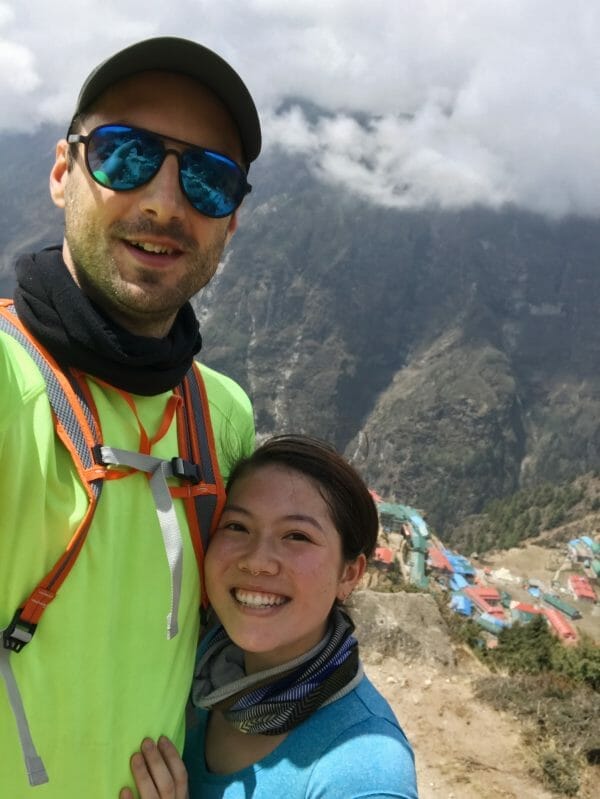
You’ll love the start of this day: it’s flat! And there are great views! Eventually, you’ll start going downhill. I’d stop at the river for a pot of tea or lunch, because after you cross the suspension bridge over the river, it’s a ticket check, then a lot of uphill! I always used to remember this bit as the WORST, but this time, I took it slow and steady, and it really wasn’t as bad as I remembered. Tengboche is absolutely beautiful. If you can, head into the monastery at 3pm for the prayer. You aren’t allowed to take photos.
Definitely go to the bakery to get a slice of apple crumble. It is necessary. And delicious.

Recommended teahouse: Tashi Delek
Our whole time in Nepal, the clouds had been really low and it was foggy, but this day, it cleared up! Tengboche is BEAUTIFUL on a clear day.

Your day will start with a downhill walk before it flattens out. The flat bit is full of blooming rhododendrons in March-May.
Once you hit the river, you’ll start heading uphill again. It’s a pretty bearable uphill hike to Dingboche. The land seems very vast and very barren here. It’s awesome.
In Dingboche, the first lodge you’ll hit is the Snowlion lodge. It’s attached to a French Bakery. I love this lodge and I love the chocolate truffles (more like a dense fudgey cake) at the bakery.
This is an acclimatisation day! Just above the Snowlion lodge is a stupa. Walk up there, and then further up the hill. There will be a rest stop. You can either continue up or stop around here. On my trips to this region, I’ve acclimated by going all the way to the top, to the rest area, and somewhere in between. I honestly don’t think that the height of your acclimatisation hike makes a huge difference, just make sure to get a hike in.
If the weather is clear, the peak offers some stunning views, but if it’s cloudy, I wouldn’t bother.

The walk to Chukkung is a very gradual uphill. It’s quite windy in this valley. I really liked this day because there was a great view, a gentle hike, and only 3 hours of trekking! We stayed at the Khangri Resort. Their dal bhat is fabulous and Skye (the manager) is soooo lovely! Again, the views from Chukkung are beautiful.

Another acclimatisation day! Walk up to Chukkung Ri. This is a pretty steep trail with a couple false peaks. You think you’re almost there, you make it over the ridge of the hill, and bam. Another hill to climb. That being said, the views are worth it! Once you get to the prayer flags, the rest of the trip up to the summit is a little scramble-y. It was really cloudy and we didn’t feel safe on the loose rocks, so we didn’t actually get to the summit, but maybe 30 meters below. Just be mindful of where you step! On the way down, you’ll be proud of how far you walked- it’s so much longer than it seems!

I would bring trekking poles with you- it’s a steep climb and on the way down, your knees will want that extra support!
Day 9: Kongma La
The day of the first pass! We didn’t really know what to expect regarding how long this pass would take… Lonely Planet said it would take 7 hours, online resources said 6, our guesthouse owner in Chukkung said 9. It took 10. This is a LONG day, guys.
You start by walking down towards Dingboche on the side of a hill. It’s a pretty gradual uphill. The walk isn’t too bad at the start, but it gets a lot steeper. Once you see the big frozen lake, it’ll flatten out. Even though it’s flatter, I found this section REALLY tough. I started seeing double, feeling nauseous, and feeling faint. For a moment, I thought I’d have to be med-evac’d out, but I took a breather and then continued when I was feeling better. It’s a steep scramble up to the pass. The view from the pass is amazing if you look behind you. Looking forwards, towards Lobuche, isn’t as impressive, so make sure to look back!

We spent about an hour at the top of the pass, but I would recommend instead having a quick snack and water and continuing to move. Though the uphill part of the pass is over, the hard part isn’t!

Going down, your walking on scree. It’s very slippery, so watch your step! There also isn’t a distinct trail; you’ll look out for rock cairns to guide you. After a couple hours of this, you’ll reach a valley. Unfortunately, you go down the valley only to go back up it. The uphill isn’t too bad, and it’s pretty short.
Once you get back to the top of the valley, you’ll meet the Khumbu Glacier. You have to cross this to get to any lodges. Again, there isn’t a distinct trail, so follow the rock cairns. Lonely Planet describes crossing this glacier as “a final sucker punch,” and I couldn’t agree more. It’s a LOT of up and down. Also, if you go in late May, the glacier will be melting from under you and rocks will be falling around you. It can feel a bit dicey. If you’re a solo trekker, DEFINITELY try to link up with others for this bit.
After you cross the glacier, you just have to walk up one last steep uphill bit, then go downhill, and Lobuche is there!
If you are skipping Everest Base Camp, go to Dzongla. We skipped EBC for two reasons. 1) I’ve already been there and the views are not that incredible compared to the passes. EBC is mainly something you visit to tick off the bucket list. 2) We were really effing tired.
The walk to Dzongla is amazing. It’s a gentle downhill, then a gentle uphill, and then you walk along a side of a mountain, so it’s flat! It takes 3-4 hours at a leisurely pace.

Recommended teahouse: Green Valley Lodge
If you are going to Everest Base Camp, read this post .
Day 11: Cho La
We woke up at about 5, had breakfast at 5:30, and were off by 6! I was honestly dreading another pass… Kongma La nearly killed me. But don’t worry if you’re feeling the same- Cho La is MUCH better.
It’s a gentle uphill for about an hour or two, and then you’re climbing up big boulders. Once you make it up the big boulders, you’ll see a string of prayer flags. There’s a great view from here, but it isn’t the pass.

Keep going up the gentle uphill. You’ll have to cross some very icy paths, which is technically challenging. If you have microspikes, I’d put them on for this section.
You’ll walk up a frozen glacier, then up maybe 10 meters of rocks, and you’ll have made it to Cho La!

The way down is steep and rocky. It was a little icy but not too bad. You’ll be walking on loads of boulders, and again, the path isn’t so clear, so follow the cairns. Once you make it through the boulders, you’ll have to walk up and down to a valley, from which it’s all downhill. You’ll go down the valley to Thangnag, a small town. You can either stop here or continue onto Gokyo. I recommend continuing on – Gokyo is THAT much more amazing when you’ve had a really tough day.
If you’re continuing onto Gokyo, you’ll have another glacier to cross. This one isn’t as tough as the Khumbu Glacier, navigation wise. Once you make it over the glacier, another uphill and downhill, and you’re in Gokyo!
I HIGHLY recommend staying at Thanka Inn. It’s a new hotel (only around 2 months old!) and it’s absolutely BEAUTIFUL. It’s right on the lakefront and the rooms are amazing. They have real duvets (a LUXURY to not have to use a sleeping bag), double glazed windows, and delicious food. I couldn’t recommend this place more.

This is the day most people go up to Gokyo Ri. We decided not to because we were feeling a little sick. Phil ended up having a bad cold with fevers and chills, and I just had some stomach troubles. We walked around the lake, which was more than enough for us.
The lake is beautiful.
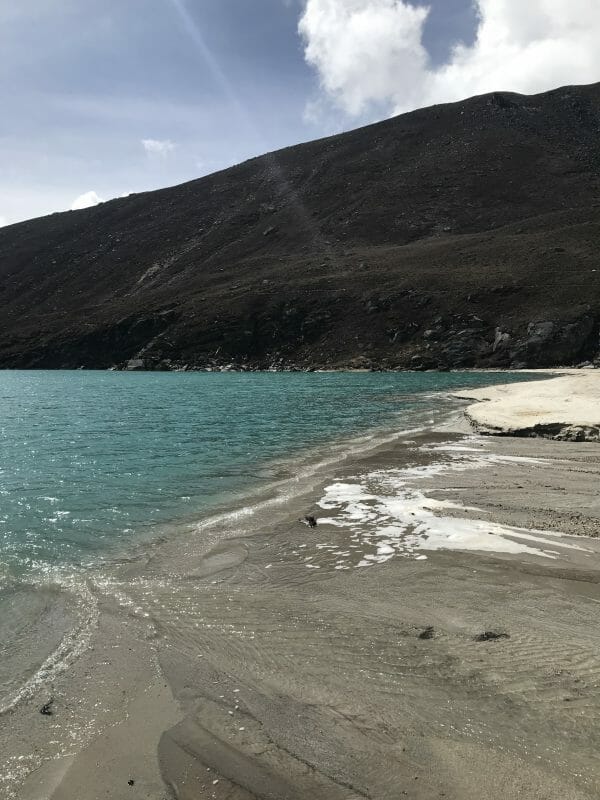
Day 13: Renjo La
The third pass- Renjo La! Follow the trail to Gokyo Ri, but instead of going up, continue straight. There is a sign that will make it easy to follow. It’s a very gradual uphill for about an hour, and then a steep uphill section all the way to the top. This is the easiest pass. That being said, I still found it quite tough- I think my body was just exhausted!

Luckily, once you make it to the top, it isn’t too bad. There was a LOT of ice when we were up there, so we had to be VERY careful for about 30 minutes on the way down. It was windy and cold, and the fog came out, so we couldn’t see very far in front of us. Total whiteout. If the weather is good, this part should be no problem.

It’s a steep downhill section, and then the trail flattens out. After about an hour and a half of walking on flat(ish) ground (HEAVEN), you’ll start going downhill again. It isn’t rocky so it’s easy to go down quickly. After losing 1000m from the pass, you’ll get to Lungdhen. There are a couple teahouses here, but we chose to just stop for tea, then continue walking down. 30 minutes below Lungdhen is another town called Marulung, but we continued down another 3 hours to Thame. The road is pretty flat and the scenery is absolutely beautiful, so it’s a nice day. It’s one of my favourite days on the trek. You get away from the commercial EBC route and get to see how people actually live.
You’ll be super excited to get going this day, because you’re heading to NAMCHE BAZAR! Namche feels like paradise after 2 weeks of trekking. There is a LOT of up and down the whole way to Namche, but with lower altitude is a lot more oxygen, so it doesn’t feel too bad.
It does feel quite warm compared to what you’ll be used to though, so wear short sleeves this day! You’ll make it to Namche in time for a movie at the Liquid Bar. We planned on doing that, but we accidentally fell asleep for about half the day. Our bodies were tired.
The trek down to Lukla is a lot tougher than you’ll have remembered. It’s steep downhill for the first hour or so, then lots of uphill and downhill, then just uphill. Again, it’ll feel really warm. Load up on sunscreen- I got SUPER burnt this day.
While the trek is pretty tiring, you’ll feel really motivated to make it to Lukla because it’ll mean you’re on your way to Kathmandu. Even if people dislike Kathmandu, after a trek in the Himalayas, you’ll crave comforts in Kathmandu you didn’t even know you had!
And that’s it! The Three Passes trek. Have any more questions? Don’t hesitate to leave a comment or email me.
Like this post? Pin it!

Related posts
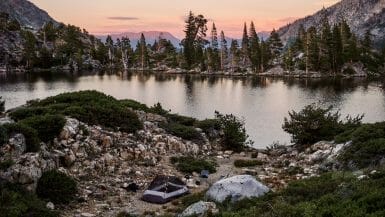
Everything You Need to Know About Backpacking the Grass Lake Trail in Desolation Wilderness
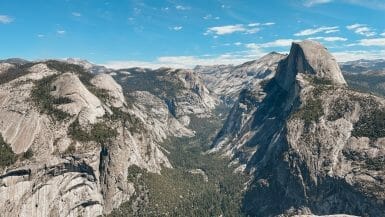
Glacier Point To Panorama Point Trail Guide: Everything You Need To Know About This Day Hike
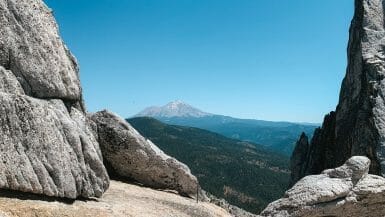
Hiking the Castle Dome Trail in Castle Crags State Park: Ultimate Trail Guide
Leave a reply cancel reply.
Your email address will not be published. Required fields are marked *
66 comments
This all looks amaaaaazing! Your photos are truly stunning! What an epic adventure!!
It was an incredible adventure! I couldn’t recommend it enough!
So jealous! This looks incredible!
We still need to go trekking together?!?!?!?
Hello. This looks amazing! I plan to do this trek next year. I have a question regarding permits: all the permits can be bought in Lukla? It is not necessary to go to Kathmandu first to get permits? Is it possible to exchange money in Lukla/Naamche Bazar as well? If not necessary I would like to avoid visit to Kathmandu and continue directly to Luka (to save one or two days and money in the process). I also have a question regarding shoes: for the last two years I have been trekking only in trail running shoes (adidas terrex), no boots. Would you say that boots are absolutely necessary? Was there snow (deep snow) in the passes in the spring?
All permits are possible to get in Lukla, however the only flights to Lukla go from Kathmandu. What month will you be going? There’s usually some snow, but not deep! I’d say micro spikes are a must!
Thank you for answer. I will be going in the middle of April-beginning of May. I know I have to go to Kathmandu airport, but after arrival I would like to continue directly to Lukla without visiting the city.
What time does your flight arrive? The flights to Lukla are all in the morning. Try to get the earliest one, as that has the highest chance of flying!
The plane should arrive 9:40 am. I hoped there would be flights around noon, but if all the flights are in the morning then I will have to stay in Kathmandu…
Hi Anya, Could you tell me what dates you did this trek,please? We are leaving in 4 weeks for Gokyo and plan to go over the Cho La Pass but in reverse. Did you meet many people coming the other way? It will be our third trek to the Khumbu. Louise
Hi! I did this in late may! We met loads of people going the other way- you just have to be more careful of acclimating! Have a BLAST! Xx
Fantastic post. It’s on my bucket list. I didn’t realise you could get flights into Lukla for as low as $150. I have a fear of flying and much prefer that idea to the teeny plane! Will look into it 🙂
Yes I loved helicoptering into Lukla and I think it would be a great way to make it to Lukla if you’re afraid of flying! But also, the pilots in Nepal that fly into and out of Lukla are some of the most skilled 🙂
Hey there Anya! Awesome post!! Sounds like yall had a fabulous time. May I ask for your advice? I want to do either EBC or the three passes trek solo in late march. I would much rather prefer the three passes trek as it seems far superior to EBC (as your post entails!) I am wondering, do you think I could find guides to take me across just the passes and not have them the whole way? I much rather prefer to hike on my own but am worried about the technical hiking that you spoke of with the glacier and Kongma pass. Would it be advisable for a semi experienced hiker (I am 24F) to go solo? Or should I do EBC? Thanks so much and happy trekking!!
I don’t think you need a guide IF you meet up with other people doing the same passes! If you can’t find anybody doing the Three Passes the same time you are, I’d definitely recommend hiring a guide, which you should be able to do in Dingboche or the towns right before the passes. The weather could be bad in March and if there’s a lot of snow, I’d do EBC. EBC is also an incredible hike and I loved it!!!
Hello, Thank you for your blog! How long are the distances without the internet access?
My son and partner are hiking the Three Passes Trek counterclockwise. We have not heard from them for 9 days.
Hi Claudia! Have you heard from them? Wifi can be spotty up along the passes, but you shouldn’t go more than a week without hearing from them unless they choose not to purchase wifi from their teahouses.
I am so glad I stumbled across your blog! We are planning to do the Three Passes trek but we won’t be starting until May 22. I realize this isn’t ideal. We are experienced in the mountains, but I am still a bit concerned. Any thoughts?
Great blog!
Thanks, Amy
I think you should be alright! I’d definitely go over Kongma La first, then Cho La, and then Renjo La with that timing. If you find Kongma La a little more slippy (and melted) than you like, I’d be careful over Cho La, as that’s the pass where there are crevasses. Definitely make sure other people are going over the passes the same days as you. I would give it a try, and if it feels too dicey, Everest Base Camp is a great backup. You could even hike down and go up to Gokyo if Cho La isn’t possible but Gokyo’s something you really want to see! 🙂
This is perfect & made me realize either a) I’m chicken or b) I’m never going to be prepared to do something like this. I’m glad you had an amazing time and got some awesome pictures!
Haha I guess it’s not for everyone, but there are loads of other amazing treks that are a little less scary in Nepal, too!
your blog more impressive how we start Everest Three pass trek.It very beautiful photos.Thanks for sharing best itinerary for my next trek.
Hi Anya! Thank you for such a detailed guide! My hubs and are planning to do this trek next October, and I had a question about the Lukla flight. We are looking at doing the trek without a guide. Do you know if we can change the date of our return flight from Lukla to Kathmandu, depending on when we return to Lukla? (Like, if we need to take an extra day coming back?) Is there a change fee? Thanks!
Hello! So sorry for the late reply! You can change the date of your return flight from Lukla, but you’ll need a phone! You won’t pay a change fee. You can easily get a SIM card in town, and you should have service from Namche Bazaar, which is a day hike away from Lukla. Alternatively, you could probably ask a very nice guide to help call for you in exchange for a beer or dinner 🙂
This hike looks so amazing! Those views and the sense of accomplishment you must feel when coming to the end. As an avid hiker, this would go on my bucket list of trails to do if it weren’t for the altitude. Nepal is a dream destination but not sure how many trails there are that stay under 2800m.
It is my absolute favourite trek! At 2800m, you can do some of the treks in the foothills- still great views!
WHAT?! How have I never heard of this?! This is so cool!!! It’s nice to know you get a comfy bed to sleep on after all the trekking you do! This definitely just went on my bucket list! (:
Thanks for the post, it’s very helpful! Just to let you know – the links to EBC are not working. If I’d like to connect two hikes together, how many more days would I need to add and would I need to go back from EBC the same route to continue with 3 passes? I was also wondering if it’s possible to stay longer on the trek to do some more rest days, I’d love to do that especially in some picturesque places away from main trails, at a local homestay, so I can enjoy being in the mountains and see the life of locals a would you advise that and which place would you recommend to stay longer? Thanks!
Hey! Thank you so much for letting me know. You can definitely do EBC along with the Three Passes – you’ll just need to add on an extra day to go from Lobuche to Gorak Shep. You’ll go to EBC the same day. And yes you can definitely do some more rest days. Typically homestays are only really available along the trails, but if you ask around I’m sure you’ll find something!
Anya, You post is really helpfull. Appreciated. Last year I did several treks in Annapurna region and the very comfortable thing in those was that you could adjust your daily itinenary on the go because the tea houses were quite abundant scattered between the main points of the trek. Therefore my question – is that the same when it comes to the Everest Three Passes. Are there any tea houses in between the start and stop daily points from your itinenary? And one more – how about the provisions (water, food). Can those be obtained only at your daily start and end point or is it easy to refill the water and purchase some snacks in between. Thanks a lot for the answer.
Hello! You can definitely adjust where you stays for most of the trek! The only days where you will not be able to adjust where you stay are the pass days – so you’ll have to stop in Chukkung before heading up to Kongma La and end in Lobuche, and you’ll have to stop in Dzongla before going up Cho La (though there is one place to stop before Gokyo). After heading up Renjo La, you can stop anywhere, as there are plenty of teahouses after you get over the pass on the descent. As for food and water, the same goes! You’ll be absolutely fine to fill up water bottles and eat anywhere there’s a teahouse, which are scattered around the three passes/Everest Base Camp route. On the days where you’ll be going over a pass, the teahouses can provide a packed lunch if you let them know you’re going over the pass the next day!
Thanks for the great blog, full of really helpful tips. Do you know if you can hire a porter who will also be your guide from Lukla? I have read you can only hire people from Naamche Bazar and also you can hire a porter and a guide but not a porter guide….
Thanks! Nathalie
Hi Nathalie! It’s difficult to find porter-guides in Lukla! I would suggest getting both a porter and a guide as it provides more jobs! Nepal’s been hit pretty hard by the pandemic, with those in the tourism sector losing out on both seasons for trekkers. Also, it’s rare to find porter-guides because there’s a hierarchy and most guides start as porters and don’t typically go back to being a porter-guide. Let me know if you have any other questions 🙂
Hello, I am 63 years old, fit & healthy with no known health issues, average 15 KM running daily. I did Kilimanjaro in 2018 (without any difficulties – Northern Circuit), ABC in 2019 and all the way planned to do EBC with Chola & Gokyo in 2020 & then The Great Himalayan Trail (High & Lower Route Mix)in 2023! Unfortunately, like many others, covid-19 pandemic forced to delay my trip. After reading your article & experience, now I have changed my mind, and would like to do 3-Pass trek with EBC. I have few questions.
Time is not an issue for me, and I never rush in the trail. I take my own pace as I go with my permanent guide & porter (through a Company) and keep more days for acclimatization etc.
Taking in to consideration of my age & fitness what is the difficult level of this entire trek? I can hike/trek long hours…
What is your advise on starting trek from Phaplu/Salleri or Jiri? and on our way back instead of taking a flight out of Lukla – get down to Salleri and take a local transport. (I would like to avoid taking a flight due to uncertainty/flight delays etc. and stick to our schedule as Oct/November is going to be too busy)
I will be doing it in end October/November, will it be the ideal time? If not, any recommendations?
As this will be my first and last trek inside Sagarmatha National Park, I wish to make this trip including EBC because of my forthcoming GHT. What is your opinion going first to Renjo La).
What is the best view at Kalapathar, Sunset or Sunrise? Your opinion matters…
Regards SOMAS
Hi SOMAS! Sorry for the late reply. You seem to be in much better shape than I am! You could absolutely do this trek! It’s definitely more difficult than base camp, but if you’re slow and steady, you shouldn’t have a problem. Of course, altitude can affect everyone differently depending on the day, even, so just be mindful of that and make sure that you aren’t pushing yourself should a problem arise. October or November is a great time as well! Starting from Jiri might be a little tough, especially if it’s been a rainy season because there can be lots of leeches. Let me know if you have any other questions!
I did the 3 Passes at your age. Fit, strong, experienced trail runner, trekker, cyclist, etc. Did this straight after Langtang trek. Was thinking of future ascent of Cho Oyu. You will do ok solo, but it is a challenge. I found 6000m my limit. Well worth doing you will love it. I am 83 now and will be back in Nepal later this year but sadly 3 Passes will be beyond me.
Hi Brian! That is incredible! I absolutely loved hiking the three passes, and completely agree that it was a challenge! Where are you heading in Nepal this year? All the best on your adventure!
Very inspirational account. I am so motivated to the 3 Passes 1st quarter 2023! I Did the ABC 2018 and EBC 2019. Thank you so much
I am planning to cross the 3 passes next Feb 2023. Solo. Anyone keen?
It’s a 17 days trek start n end in Lukla.
Thank you so much for your wonderful account!
Have the best time!
I want to do this trek starting october 21st ,22 i also want to cover base camp in between .Is it recommended to do this trek solo as a female traveller?how easy are the routes to follow if we are on our own
Hi Sneha! It’s definitely possible to do this trek as a solo female traveller, but I highly recommend going over all passes with at least one other person. With high altitude, you never know what to expect, so I personally wouldn’t attempt the passes alone! You’ll be able to find other groups on your schedule the night before most passes! The routes can be a little tricky over the passes—you end up relying on a lot of cairns, and because the glaciers are constantly changing, the route also changes.
I’ve read somewhere that doing that trek in oppsite direction (clockwise) is better. As I remember the reason was that you are gainig acclimatization in more gentle way. Also you are starting first with the “easiest” passes… What do you think about it?
Hi Krzysztof! I think you could do it either way! I did find Kongma La to be pretty brutal, so there’s probably a benefit to doing it clockwise. We chose to start with Kongma La because of the incredible views going counter clockwise. I don’t think you can go wrong 🙂
Wonderful post. Thanks alot! Just had a few questions: Do you think you could book guesthouses/teahouses on arrival or do they all have to be booked beforehand? Also, would you recommend microspikes in hiking in OCT/Nov? Thanks again!
I highly recommend booking on arrival; I think it would be very difficult to book ahead of time! October/November tends to be less snowy than the spring, but I’d still recommend bringing microspikes.
Hi ! I am planning to do this trek in a few months in October / November. If you are solo without a guide or travel agency, can you still easily find a room in every village without booking ? I read it was first come / first serve, but in high season i am worried to not find a room in crowdy places … Thank you !
There are plenty of teahouses to choose from and I’m sure there will be space! I have never had a problem, even in peak season!
Thank you so much for this! So helpful!! Can you share more details about the glacier crossings? Any need for mountaineering gear? Thank you!
Hi Nathalie! Unfortunately I can’t give out detailed information about the glacier crossings because the routes change every year. It’s definitely the trickiest part of the trek. I would highly recommend using microspikes and hiking poles, but full-on crampons aren’t required.
Hi Anya Thanks for your well documented blog. I’m leaving solo November 23, and have planned at least 15 days round trip. Are there others solo, late November ? What places do you recommend in Dzongla, Thame ? Many thanks. Andre
Hi Andre! There will most likely be other trekkers going the same time as you. I recommend trying to meet up with people in Kathmandu or on the route! 🙂 As for places to stay, I would turn up and see what looks good. Teahouses don’t really get full so you’ll have options!
Hi Andre, I am planning also to do it in late November 23. See you on the trek. Anton
Hi! I m planning to go there mid november 23, solo, do you guys know if this one is still allowed to do without a guide? If you want to team up, let me know! 🙂
Hi, thank you for sharing!! All the other guides I have read online state that it takes ~22 days to do the Three Passes Trek. How was your time significantly shorter / did you cut out a part of the loop? Thank you
We skipped EBC and combined a few days when it was safe and we were trekking quickly! In the bottom section of the guide, where I share our experience, I call out these days 🙂
hello, amazing blog.do I still need tims permit for three passes trek?
Yes, you do! Here’s more information about the TIMS card 🙂 https://ntb.gov.np/en/plan-your-trip/before-you-come/tims-card
Hello, when it comes to doing the three passes trek solo I am most concerned about navigation. What do you recommend bringing to be prepared for that ? Is the trail well marked ? I’m leaving on Friday and getting some final things together. How cold do you think it will be this time of year ? Please point me to whatever useful information you can ! And thank you
I love grabbing paper maps in Kathmandu and find them helpful. Over the glacier, navigation is quite tricky as the snow melt changes the route each year, but I’d recommend following the cairns and linking up with other travellers over the passes. The trail is incredibly well marked otherwise—it’s just the glaciers that are tricky to navigate!
Hi, I’m planning to do the 3 pass trek in the middle of January with 3 other mates (little scared as it is mid-winter), just wondering if you have any advice lol. Is this a bad idea? We are all fit and healthy but obviously worried about snow storm possibilities and the extreme cold.
Hey – great post! A tour company is advertising the three passes in 16 days. Would you say this is too quick?
What is the itinerary? I think it’s possible but you might be skipping out on some things.
Hi, thanks for posting an amazing blog about the Nepal three passes trek. I read your complete blog and you explained each and every thing very well. I am also planning to go this trek solo and from this blog i got wonderful information.
Once again thanks for useful content. Keep posting such types of blogs.
Thanks for the great informative post!
May I ask what maps you were using?
I used Himalayan Map House maps for this trek, although National Geographic also makes one. You can find the Himalayan Map House maps anywhere in Kathmandu or Pokhara and they’re what I’ve used for all my treks in the Himalayas.
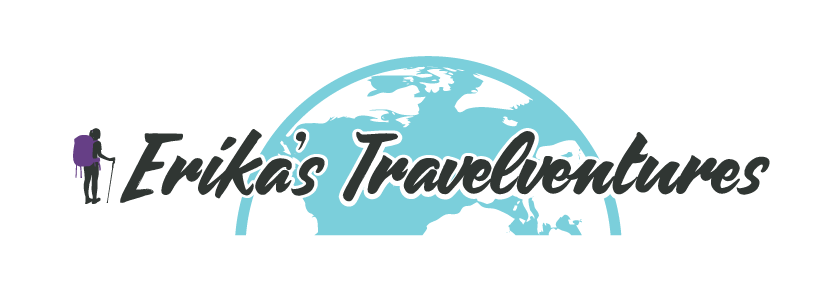
The Three Passes Trek + Everest Base Camp Without A Guide
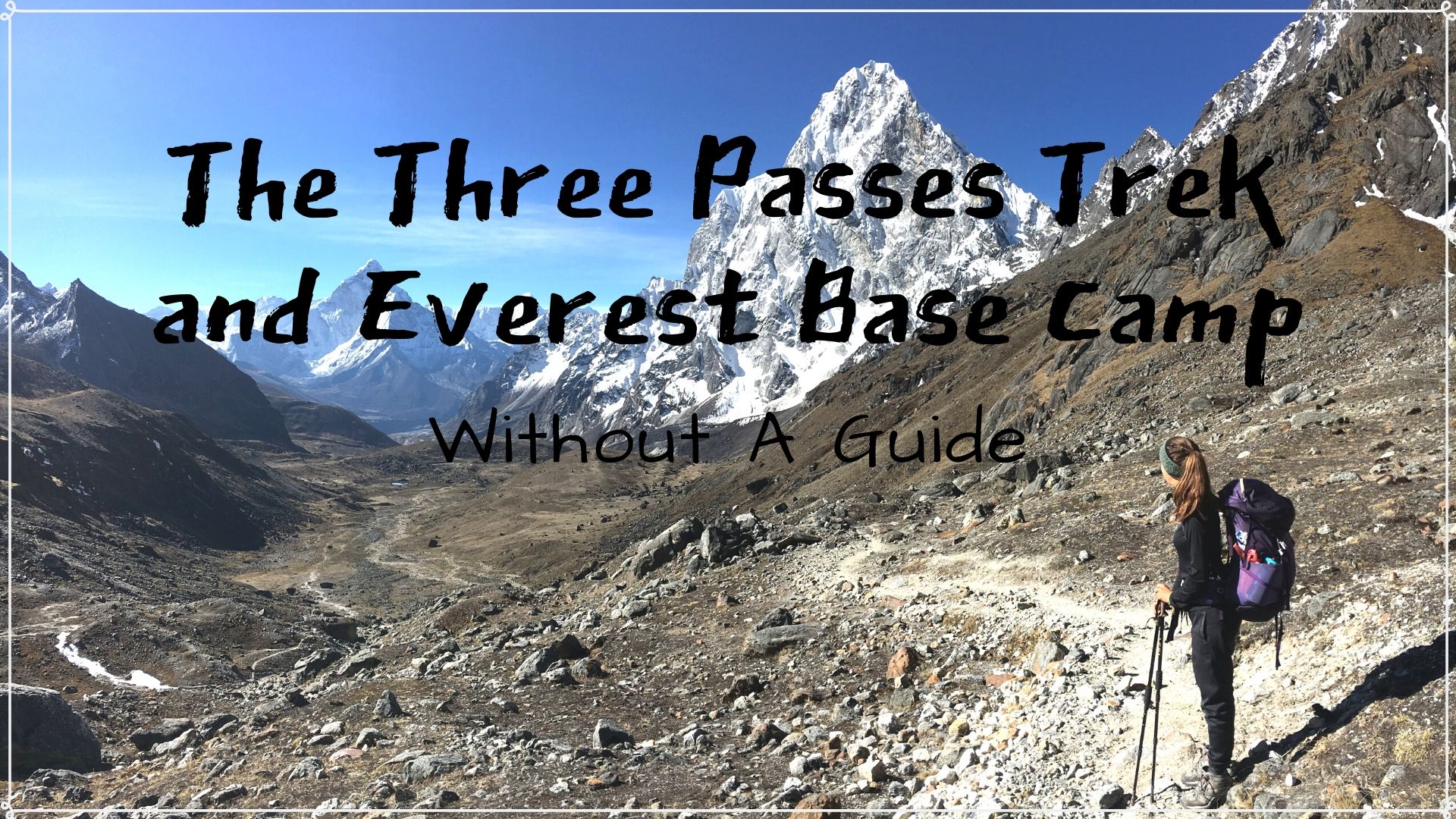
The Three Passes Trek is an opportunity for trekkers to challenge themselves in the world-famous Everest mountain region. There’s no need to train years and spend thousands of dollars to be in the presence of Mt. Everest on the Three Passes Trek.
The Three Passes Trek takes you over three high mountain passes, to an elevation of 5550m , AND to the popular Everest Base Camp .
Some people are content with hiking only to Everest Base Camp to tick off this bucket list item, but I recommend taking your experience to the next level. Push yourself harder, walk a little further, and climb a little higher. This trek is worth it, and my Three Passes Trek Guide will help you plan your trek, without a guide!
Safety Note:
The three high passes on the Three Passes Trek are all above 5400m in elevation . They should not be attempted by those without at least a medium fitness level and without previous trekking/hiking experience.
Everyone should expect to experience some signs of altitude sickness on the Three Passes Trek . Symptoms include shortness of breath, loss of appetite, blurry vision, headaches, nausea, trouble sleeping, and fatigue. It is critical to listen to your body and know when to take a rest day or drop down to lower elevation. Taking it slow is the best way to allow your body to adjust to the altitude.
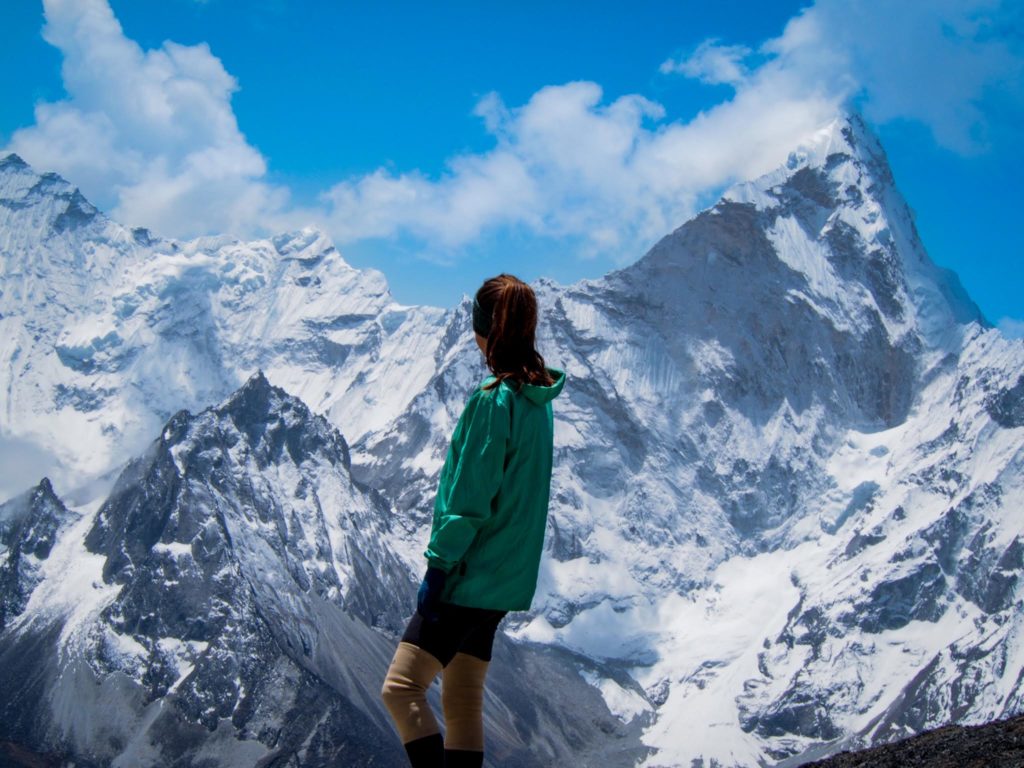
Skip to Section
Overview getting to the trek duration sample itinerary insurance permits accommodation foooood budget atm access packing list safety tips.
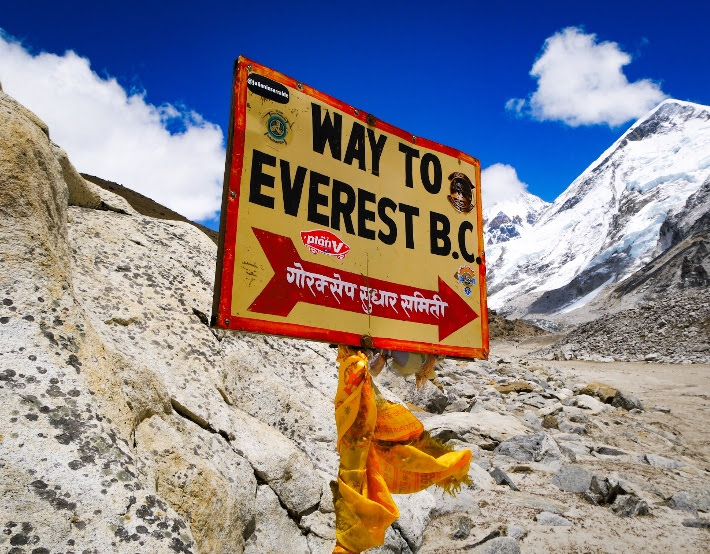
Overview of the Three Passes Trek Without A Guide
Duration : 14-26 days (depending on starting point & rest days) for the Three Passes Trek plus Everest Base Camp side trek
Starting Altitudes: Jiri – 1995m Salleri – 2390m Lukla – 2840m
Highest Altitudes: Kala Patthar (side trek) – 5550m Kongma La – 5535m Cho La – 5420m Renjo La – 5360m
Distance per day: 5km to 15km
Best season: April-May, September-November
Budget: $28 USD per day: At low altitude, $10/day. At high altitude, $35/day
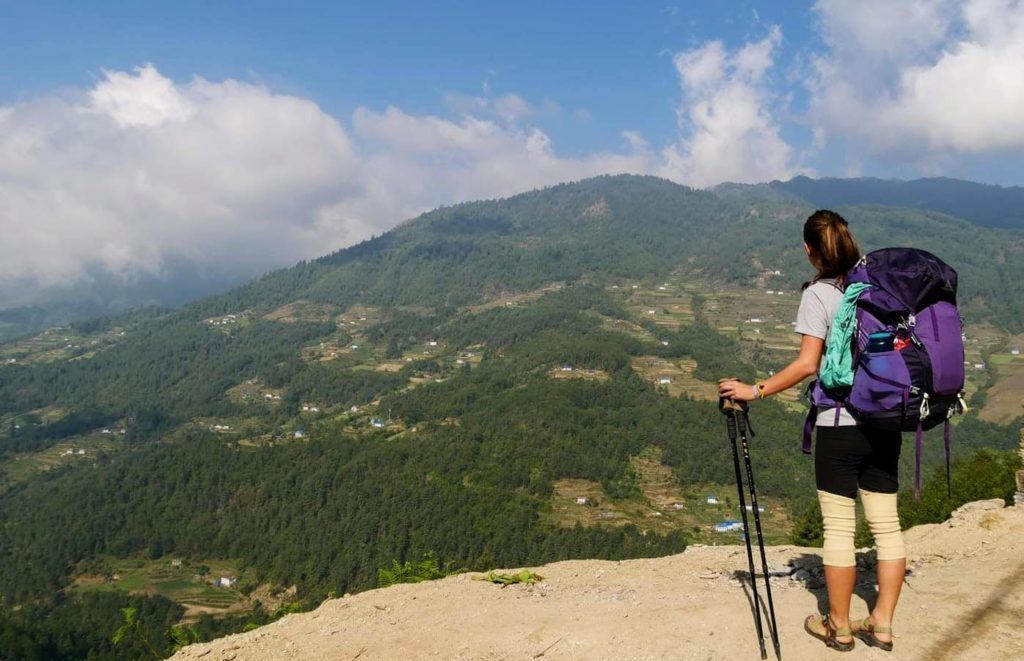
Intrepid Road and I completed the Three Passes Trek without a guide, going counter-clockwise. We met several people who were hiking the Three Passes Trek clockwise as well. The counter-clockwise direction takes you over the most difficult pass first, Kongma La, and the least difficult pass last, Renjo La.
Each high pass you go over counter-clockwise will start with a long, gradual uphill, then a steep downhill on the other side, before reaching the villages.
Likewise, trekking clockwise means there is a steep uphill before a gradual downhill.
Check out Intrepid Road’s Ultimate Three Passes Experience Video!
Getting to the three passes trek.
There are three different starting points for starting the Three Passes Trek unguided: Jiri, Salleri, and Lukla .
Jiri and Salleri are the cheapest to get to. The bus to Jiri from Kathmandu costs about 1500 rupees (~$15) and the jeep to Salleri from Kathmandu costs around 2000 rupees (~$20). Both options can be booked via tour or transport agencies in Kathmandu. Since these options are more popular with locals traveling to villages in the area, it may be difficult to book or find information about them outside of Kathmandu.
Lukla is the most popular entry point to the Everest Base Camp region. To get to Lukla, you need to catch a $170 flight (one-way) from Kathmandu.
When I hiked the Three Passes Trek without a guide, I chose to jeep from Kathmandu to Salleri, which took about 10 hours.
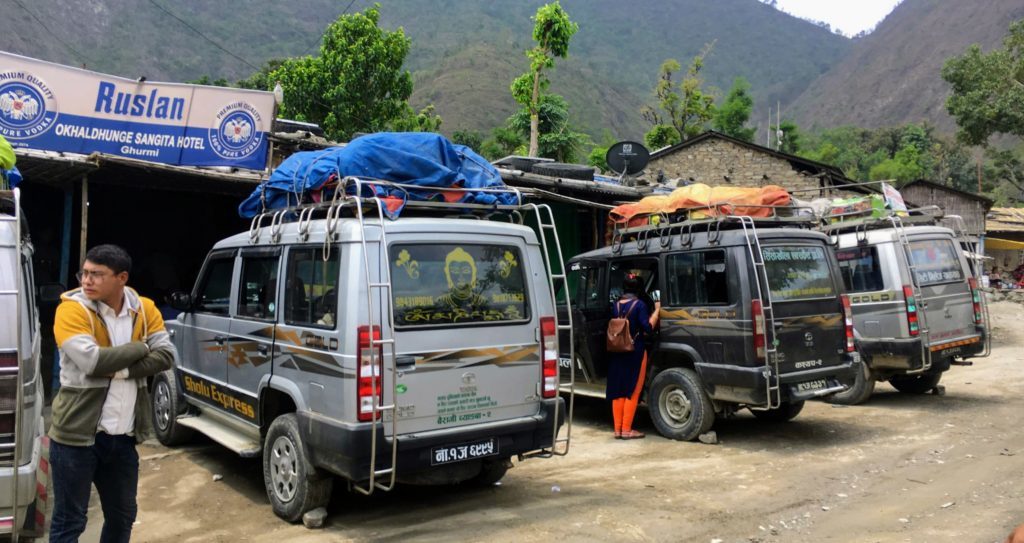
Duration of the Three Passes Trek Unguided
The number of days you spend on the Three Passes Trek totally depends on your trekking style: how fast you trek, the number of rest days you take, and especially where you start the trek.
From Jiri it will take you an extra 6-7 days on foot to reach Namche Bazaar, and from Salleri it will take you an extra 3 days .
If you fly into Lukla to start the Three Passes Trek, it will take you only one day to reach Namche Bazaar . (If your flight lands in the morning, you may even make it in the same day!)
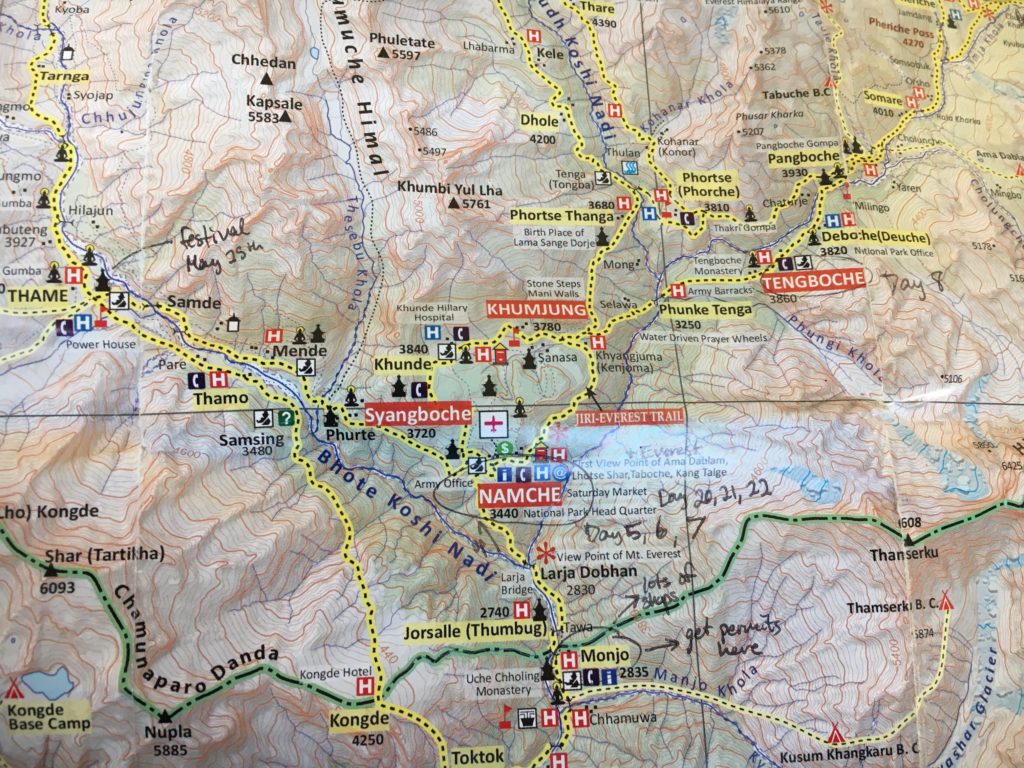
From Namche Bazaar, the Three Passes Trek can take a minimum of 10 days as you go over the three high mountain passes. This includes a side trek to Everest Base Camp and Kala Patthar , then looping back to Namche Bazaar. Going this fast should only be attempted by the super fit and those confident at high altitude!
Most people take rest days in Namche Bazaar, Chhukhung or Gorak Shep, and Gokyo, making it a 12-day loop. When I went, I took two rest days in Namche, one in Gorak Shep, and three in Gokyo, taking a total of 15 days to get back to Namche.
Check out my 10 things to do in Namche Bazaar to consider for your rest day!
Sample Itinerary
This is a sample itinerary for my Three Passes Trek Guide. It’s the path that I took when I completed the Three Passes Trek and Everest Base Camp without a guide:
- Day 1: Kathmandu -> Salleri (jeep)
- Day 2: Nunthala
- Day 3: Bupsa
- Day 4: Ghat (we passed Lukla on this day)
- Day 5, 6, 7: Namche Bazaar
- Day 8: Tengboche
- Day 9: Dingboche
- Day 10: Chhukhung (some people take a rest day here)
- Day 11: Lobuche
- Day 12, 13: Gorak Shep
- Day 14: Dzongla
- Day 15: Dragnag (some make it to Gokyo on this day)
- Day 16, 17, 18: Gokyo
- Day 19: Marulung
- Day 20, 21, 22: Namche Bazaar
- Day 23: Phakding
- Day 24: Paiya
- Day 25: Adheri -> Salleri (jeep)
- Day 26: Salleri -> Kathmandu
If you start the Three Passes Trek in Jiri, your first four days might look like this before Nunthala:
- Day 1: Kathmandu -> Jiri (bus)
- Day 2: Bhandar
- Day 3: Dakachu
- Day 4: Junbesi
- Day 5: Nunthala
If you fly in to Lukla to start the Three Passes Trek without a guide, your Days 4-23 might look the same as mine.
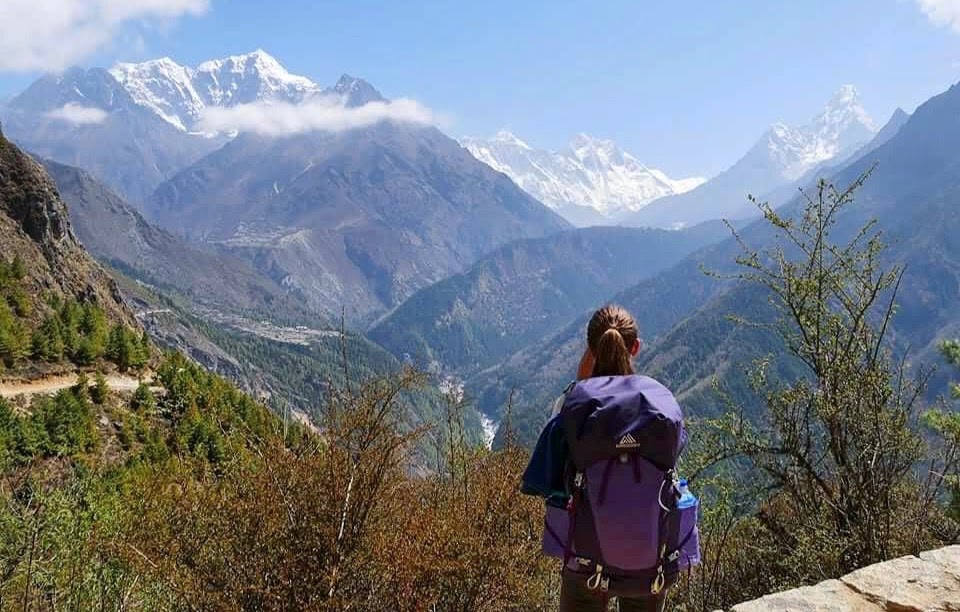
Insurance - SUPER Important!
Just in case you encounter serious problems while trekking, make sure you have traveler’s insurance . Safety is your FIRST priority while hiking the Three Passes Trek and Everest Base Camp.
It’s important to check if your insurance will cover up to 5550m in elevation ! Many will have an altitude limit that’s below 4000 or 5000m. World Nomads allows you to purchase insurance abroad and covers you for medical evacuations at high altitude.
Do NOT hesitate to go back down to lower elevation when you feel dizzy or sick! This could save your life!
Travel insurance. simple & flexible., which countries or regions are you traveling to, what's your country of residence, what is your province, what is your state, enter traveler's age.
When I was in Gorak Shep, we heard there was a man in Lobuche who died from severe altitude sickness. He didn’t have insurance for a helicopter to take him down, and the second best option available was to have a donkey carry him down. Unfortunately this wasn’t fast enough and he lost consciousness, and even being put in a zip-up oxygen bag couldn’t revive him.
Permits for the Three Passes Trek and Everest Base Camp
Hikers need two permits to hike the Three Passes Trek and Everest Base Camp. You also need to keep the permits on you for the entire hike. Although there are fewer checkpoints here than on the Annapurna Circuit , it’s still important that you keep the permits on you. In order to purchase the permits, you need 5400 rupees and your passport.
- The Sagarmartha National Park permit can be purchased in Kathmandu or en-route to Namche Bazaar. You can buy this permit in Lukla, as well as in Monjo, right outside of the entrance to the national park.
- The Khumbu Pasang Municipality permit can only be purchased on the trek. You buy it at a checkpoint right outside of Namche Bazaar . Here you will have to show your passport again.
The officer will ask you for the approximate number of days you will be trekking, and which trek you will be undertaking. It’s ok to let him know you are trekking the Three Passes Trek and Everest Base Camp without a guide.
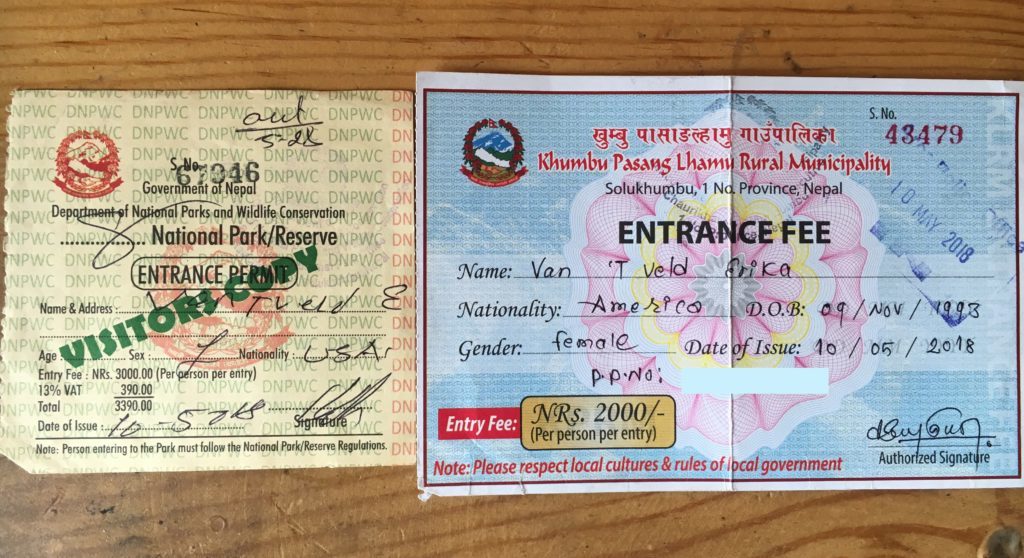
The National Parks pass costs 3390 rupees, and the trekking permit costs 2000 rupees.
Although they don’t ask for any insurance information, they do look at your passport to write down your information. Make sure you bring your passport with you on the trek AND a hefty 5390 rupees just for the permits!
Accommodation on the Three Passes Trek
Trekking the Three Passes Trek without a guide means finding your own accommodation. Don’t worry, there are plenty of options along the trek. Upon arriving at a village, ask around at any guesthouses if they have rooms available.
Although traditionally trekkers are able to stay for free in exchange for eating food at the teahouses/guesthouses, this is not the case anymore on the Everest trail.
2019 Update: Guesthouses after Namche Bazaar are now all charging at least 500 rupees to stay the night
When you arrive in town and are looking for guesthouses to stay in, usually the larger hotel-looking lodges will charge you more for the rooms. They likely have higher overhead costs of operating a larger kitchen and have more staff. These larger guesthouses usually bring out meals quickly, and have warmer rooms and more bathrooms.
The family-run, smaller guesthouses usually charge less or nothing at all. You may miss out on some luxuries of a fancier guesthouse, but in exchange you’ll probably get a more personal experience with the Nepali guesthouse owners.
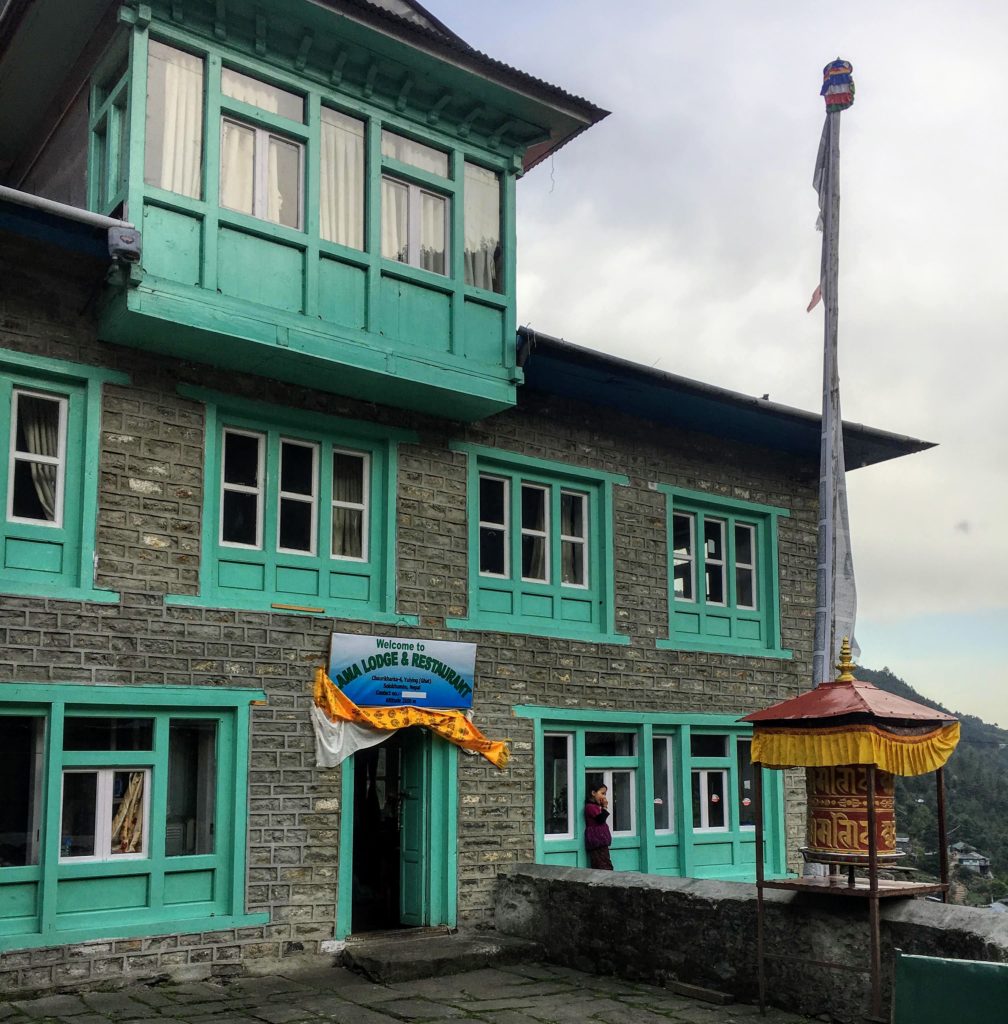
When trekking the Three Passes Trek without a guide, you can easily order food at every guesthouse you stay in.
Below is a sample menu from a guesthouse at Phakding, a town located between Lukla and Namche Bazaar. This is the medium- to low-end of prices for food items along the Three Passes Trek. The food and drink variety stays fairly constant from village to village.
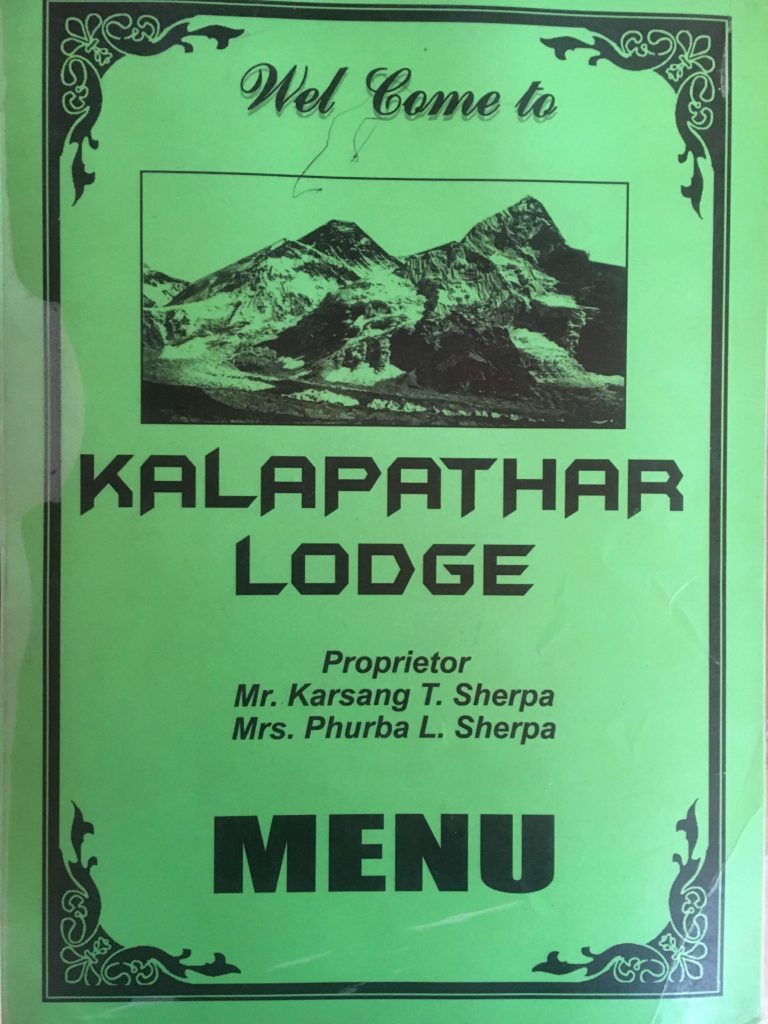
The cost for food changes exponentially along the Three Passes and Everest Base Camp trek.
I was surprised prematurely in Salleri when the cost for a Dahl Baht was 300 rupees (or $3. I was used to 150 rupees in Kathmandu). You’ll see up to 850 rupees ($8.50) at Gorak Shep for the same meal. Veg fried noodles which I liked to get for lunch or dinner, went from 200 rupees to 700 at higher elevation. My favorite breakfast, hash browns with vegetables and an egg went for 900 rupees at Gorak Shep.
The amount of money you’ll spend on food on the Three Passes Trek will vary depending on snacking, sickness, and mostly altitude. At low altitude, you can budget $10/day for food, and at high altitude (after Namche) you can expect to pay closer to $30/day.
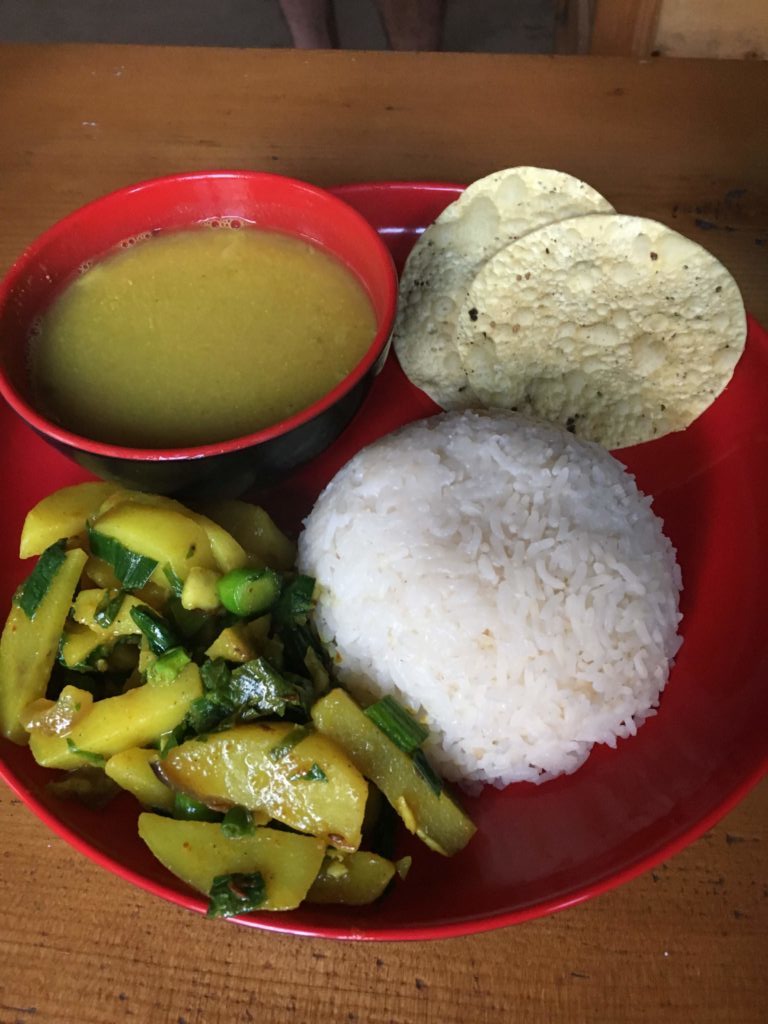
Budget for the Three Passes Trek and Everest Base Camp Without a Guide
I’ve tried to make a comprehensive budget for my Three Passes Trek Guide , but some things have changed since I did the trek in 2018. Most importantly, almost all guesthouses past Namche Bazaar will charge you 500 rupees per night. Guesthouse owners were tired of people staying for free! (Which is completely understandable).
All prices are listed in USD.
Accommodation
500 rupees per night at high elevation
Transportation
Transport costs will vary greatly depending on where you decide to start the Three Passes Trek without a guide. I recommend flying into Lukla if you’re short on time (keep in mind that its common for flights to be delayed or cancelled if there’s low visibility). This will set you back $170 x 2 = $340.
Trekking from Jiri or Salleri saves on flight costs, but you’ll pay for overland transportation from Kathmandu , $15-$20, and for the extra days you’re spending in the mountains, $10-$15 per day.
If you haven’t purchased any permits before leaving Kathmandu like I did, add an extra 5390 rupees ($54) to take with you to buy the permits on the trek!
Above, I mentioned a budget for $10 per day for food before Namche, and $30 per day after Namche. I thought I could cut down on this cost, but when every meal at high altitude cost $7-9, cups of tea are $2-3, and bottles of water are $3-4, it adds up quickly.
Charging Electronics
Charging electronics and free wifi are basically nonexistent on this trail unlike in the Annapurna region. Definitely invest in a portable battery charger .
Be sure to charge all of your electronics before you leave Namche Bazaar too. Some of the restaurants, bars, and bakeries there will let you charge for free while you spend time at their business. As you get to higher altitude, you’ll be spending 200-300 rupees an hour to charge phones and even more for battery packs because guesthouses run on solar power.
WiFi (Everest Link)
Since I had an NCell SIM card, in Namche I had 4G and in Tengboche I had 3G service. Everywhere else, to stay connected you need to purchase the Everest Link internet cards. These are 600 rupees ($6) for 200 MB of internet usage, which is ridiculous but there’s no other option.
Make sure you turn off auto-updates, and keep in mind that each code can only be used for one device. I only bought this once during the trek, after I had been offline for a week people at home had started to worry.
Personal Hygiene
Showers at high altitude cost from 200 rupees for a cold bucket of water, to 700 rupees for a gas shower. Some go the entire trek without showering, but I showered a number of times in 25 days just to retain some level of cleanliness.
Since I had some space in my bag, I invested in some extra toilet paper rolls to bring from Namche also. At shops in Namche toilet paper costs 200 rupees, but in the mountains you’ll be paying 400-500 per roll. Since I was sick and blowing my nose every 10 seconds, these came in very handy!
Coming from hot and humid India I didn’t have any winter clothing aside from a hat, leggings, sweatpants, and a NorthFace GoreTex jacket I picked up from a hostel in Cambodia. Luckily, you can find any trekking gear you can dream of in Thamel.
Check out my trekking in Nepal packing list !
I chose to buy gear instead of renting it because I trekked both the Annapurna Circuit AND the Three Passes Trek . I bought hiking boots ($40), sleeping bag ($25), trekking poles ($5), a fleece sweater ($5), trekking poles ($5), light windbreaker ($10), and microspikes ($10) = $100.
Total Budget for the Three Passes Trek Unguided
I personally spent about $700 USD on the Three Passes Trek over the course of 25 days (excluding the cost of gear I listed above).
I was sick for a while and buying pots of tea ($10) and throat lozenges ($4) everywhere, and I splurged on beers ($7) and apple pies ($4) in Namche. Real budget travelers can expect to spend around $600 trekking the Three Passes Trek unguided.
It’s a good idea to bring this entire sum of money with you when you start the trek.
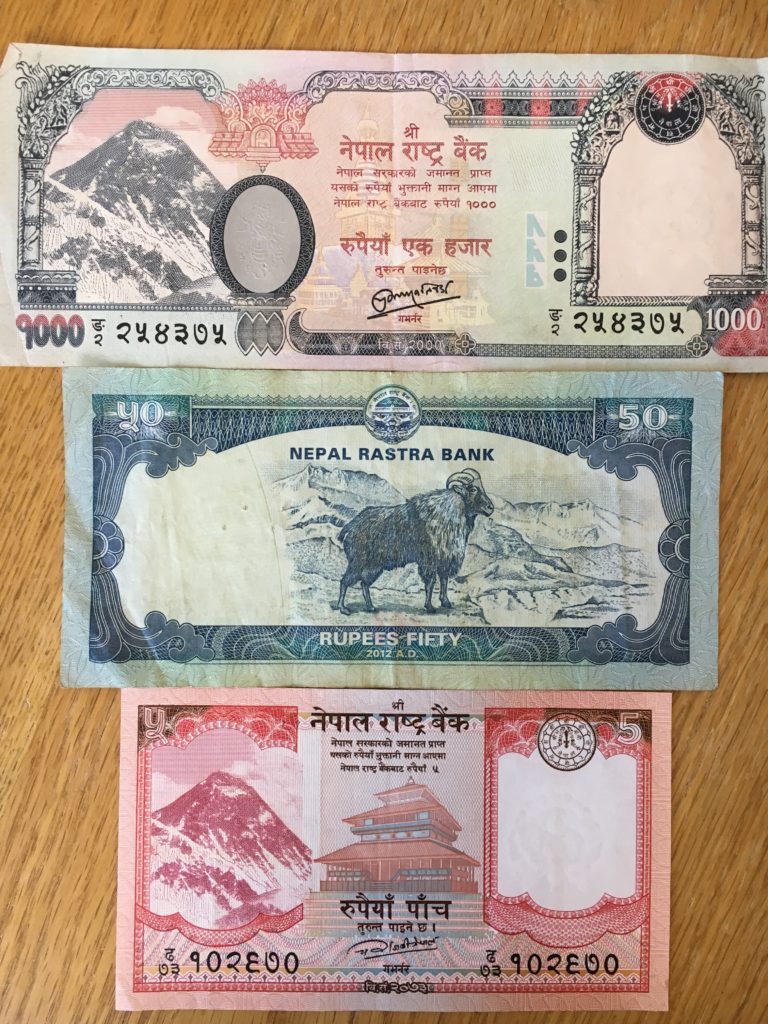
Bring all $600-$700 USD to spend on the Three Passes Trek with you, when you leave Kathmandu!
Namche Bazaar has several ATMs where you can stock up on rupees, but there’s a chance that they’re empty or not working. ATMs all turn off during frequent power outages. The ATM I used there had a 10,000 rupee ($100) withdrawal maximum, with a 500 rupee ($5) withdrawal charge.
Some sources say there is an ATM in Lukla, but when we asked around, we were told there isn’t one, only a bank for local account holders.
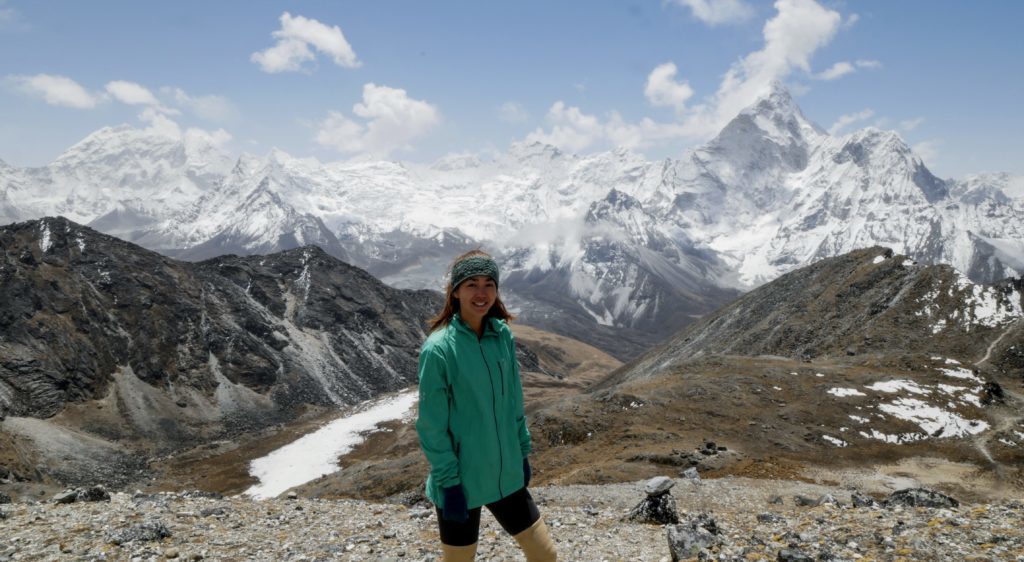
Packing List for the Three Passes Trek and Everest Base Camp
Check out my full packing list in my perfect trekking in nepal packing list post .
I’ve divided this section into four different parts: pharmacy, clothing, gear, and other.
One of many things that I hope you take away from this Three Passes Trek Guide: the goal is to bring as little as possible with you on the trek because you’ll be carrying it all!
Feminine products 16x Cough drops (wish I had brought more!) 10x Band-Aids 5x Rehydration Salts (Awful taste but really important) 1x Diamox strip (I didn’t use these but many people do) 1x Paracetamol strip 50x Water purification tablets (I used about 40 of these) Sunscreen Deodorant Toothbrush/toothpaste Packet of baby wipes Lotion Razor Hair ties Toilet Paper
1x long-sleeved under armour 1x long-sleeved heat-tech shirt 1x long heat-tech leggings 1x thick under armor sweatpants 1x T-shirt 6x underwear 2x bras 3x thick trekking socks 1x normal socks 1x fleece 1x Goretex thick North Face jacket 1x thin windbreaker 1x thin gloves 1x thick gloves 1x hat 1x neck wrap
1x 55-65L backpack 1 pair of mid hiking boots 1 pair of Chacos/ trekking sandals 1 pair of trekking poles 1 pair of microspikes
Reusable water bottle
Quick-dry towel
Sleeping bag
Battery pack ! Phone + charger GoPro + charger Kindle Flashlight or Headlamp
Optional to bring:
Small day bag Knee braces (450 rupees from a pharmacy in Kathmandu – these saved my life!) Flip flops Dry shampoo Honey Snickers bars Sunglasses Ear plugs
Many hostels in Kathmandu will let you keep you luggage at their hostel for a small daily fee, or even for free (I left three bags in Kathmandu’s Shantipur Hostel ) There may be some guesthouses in Namche Bazaar that have this service for a fee as well. It’s important to take advantage of this, or else you’ll have a hell of a time hiking at 5500m with a 15kg bag.
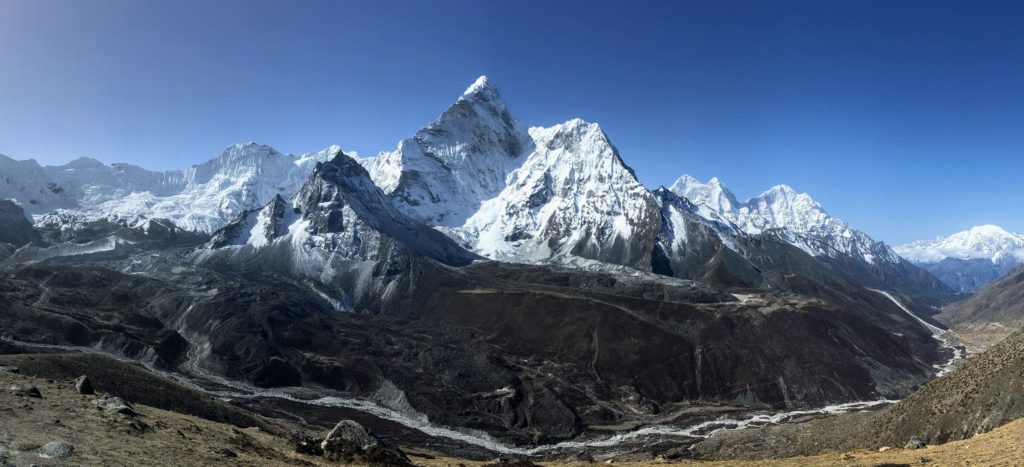
Safety Tips for Trekking the Three Passes Trek Unguided
This might be the most important section of this Three Passes Trekking Guide. The Three Passes and Everest Base Camp trek is a dangerous trek that people have died on! It should not be underestimated, especially when hiking without a guide.
- Always be attentive of the weather when you’re about to set out on a long trekking day. Better to postpone hiking a day than to be stuck in a snowstorm.
- Start your pass days early , and expect it to take from 8-12 hours guesthouse to guesthouse including breaks.
- Use maps.me for a pretty accurate trail map to follow.
- When you’re going over the glaciers, especially the Khumbu glacier after Kongma La, STAY ON THE TRAIL .
- Keep an eye out for rock cairns ahead of you.
- Listen to your body when you’re gaining altitude.
In Conclusion
Enjoy a month in the beautiful Himalaya mountain range and make the most out of your trip to Nepal by hiking the Three Passes Trek and Everest Base Camp without a guide.
The physical difficulty combined with amazing views will make this trip one of the most rewarding and amazing experiences of your life. If this Three Passes Trekking Guide was useful, or if you have any other tips or questions, leave them in the comments below!
Pin this TPT guide for later:
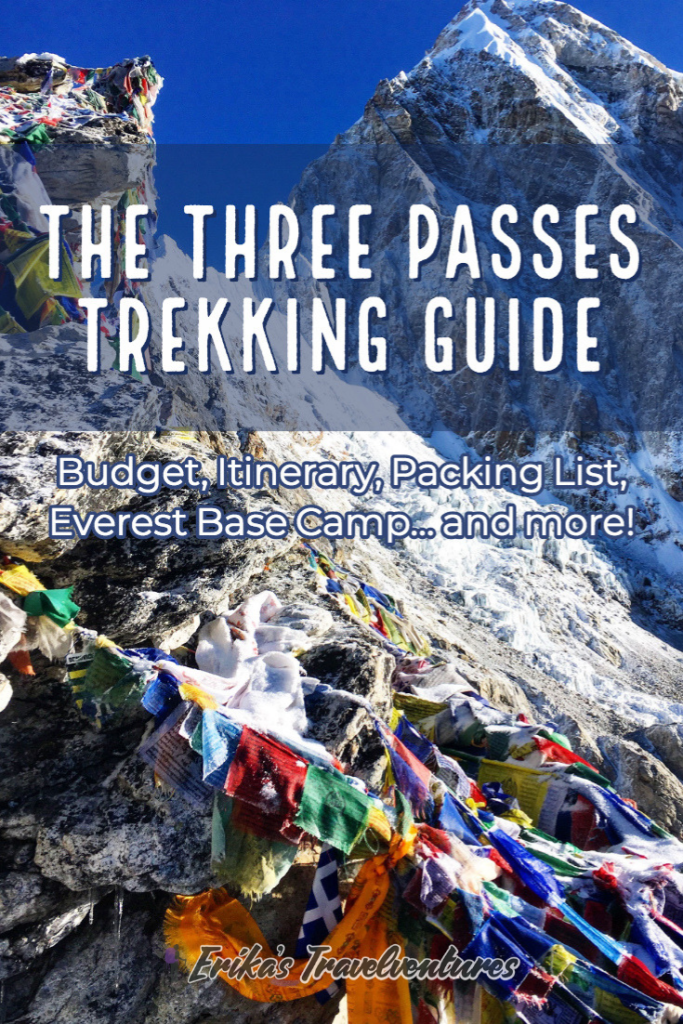
You might also like:
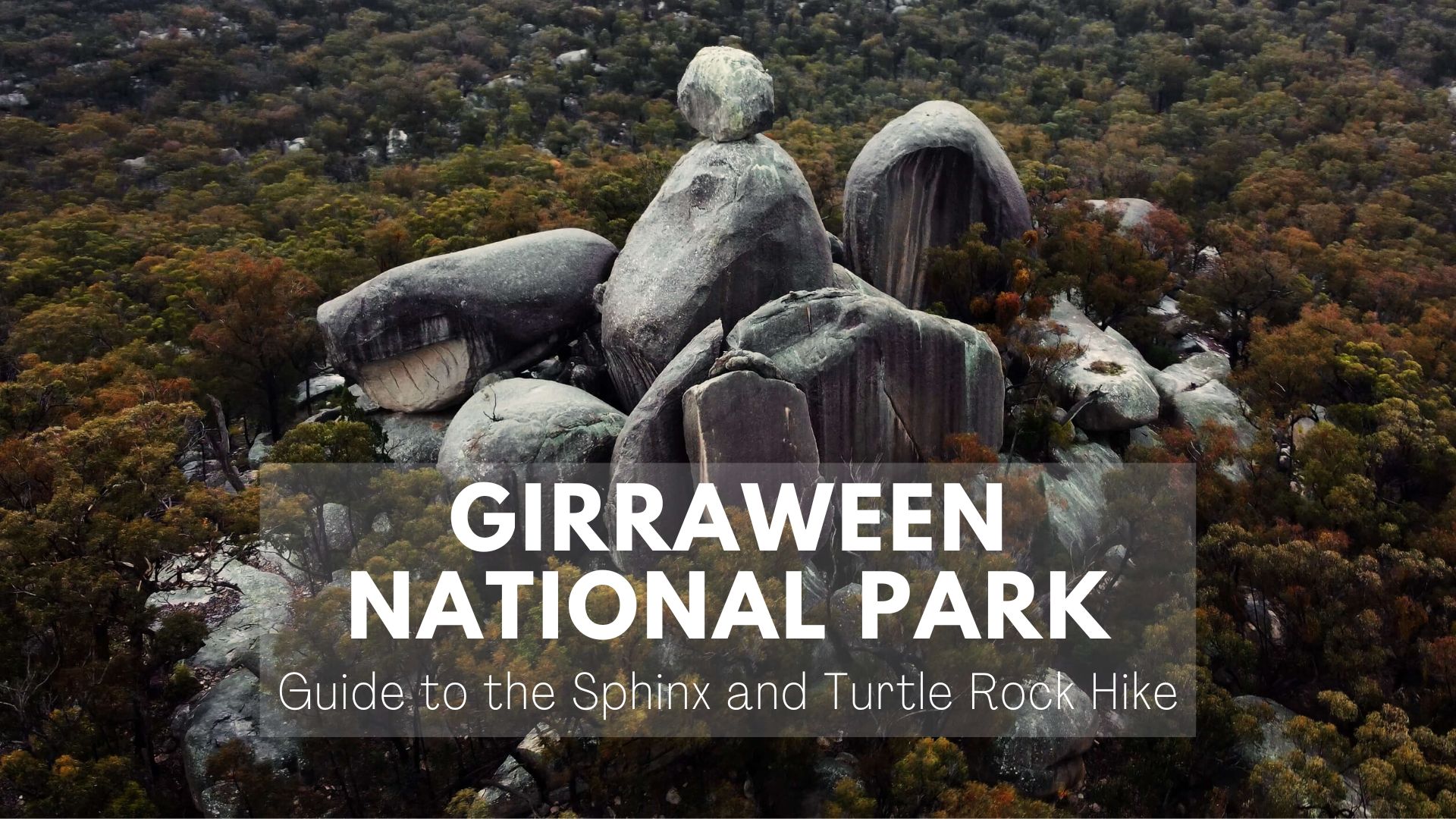
Turtle Rock and The Sphinx Hike at Girraween National Park
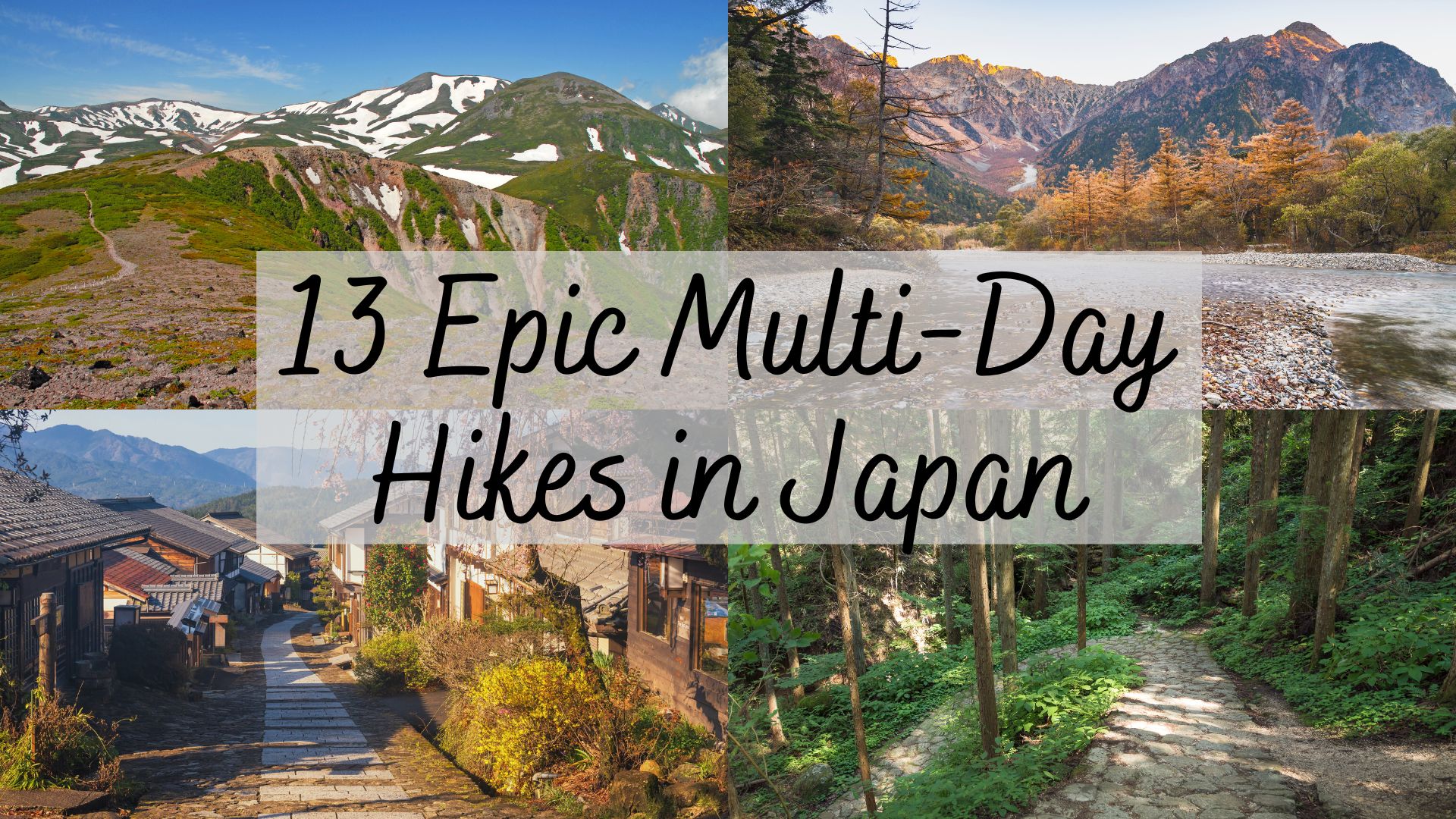
13 Best Multi-Day Hikes in Japan
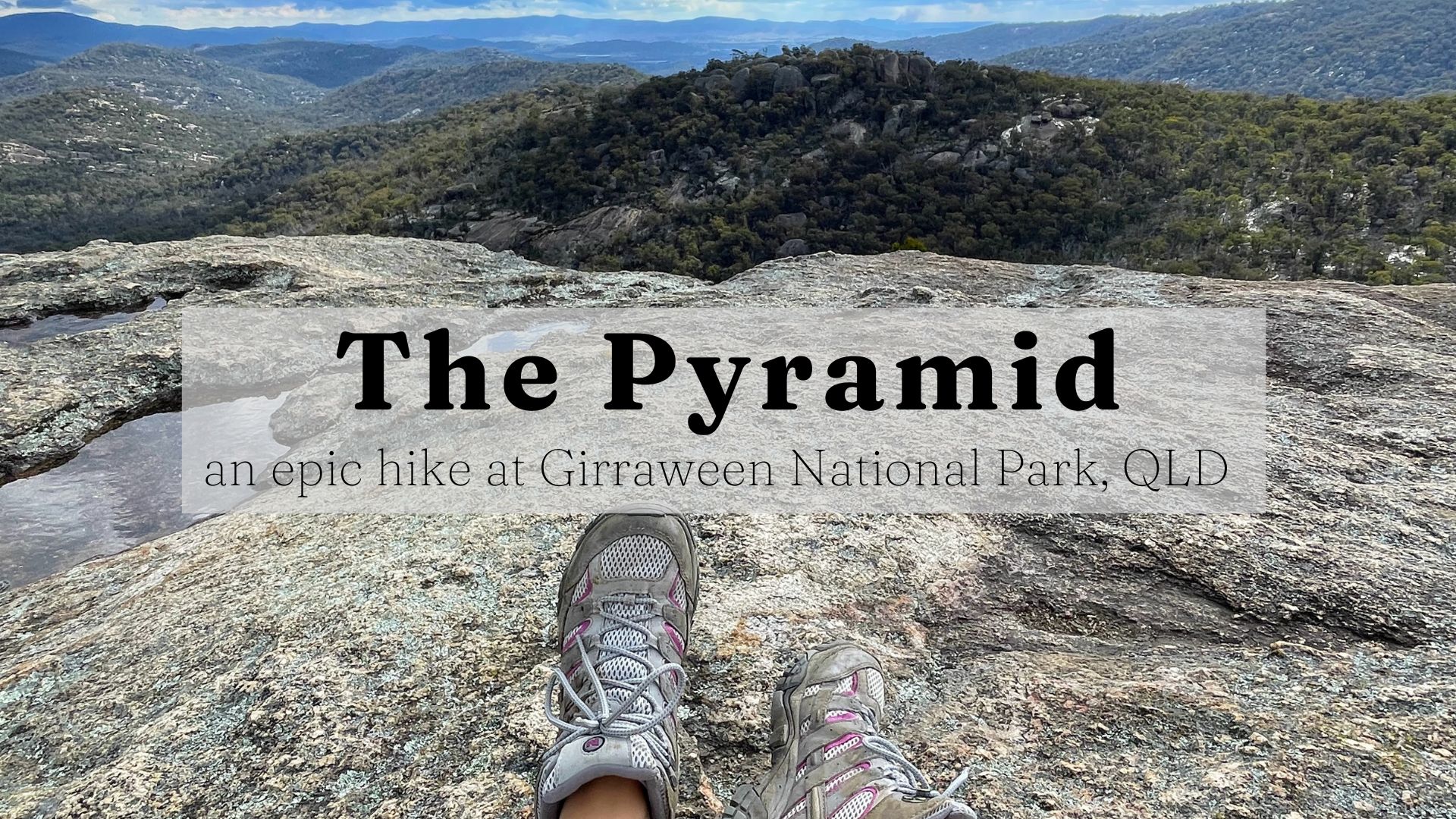
Guide to Hiking the Pyramid at Girraween National Park
0 thoughts on “ the three passes trek + everest base camp without a guide ”.
Very informative travel blog!
Wow, such a detailed post that would be so helpful to plan a great hike to Everest Base Camp. Loving the pictures so much.
This is a very complete guide for everyone who wants to trek to Everest base camp. It sounds like a tough trek but so rewarding when you get to the top.
Such an awesome post and very detail article. Wonderful tips and very good guide on how we can make thru this challenge. By doing your itinerary I may say this is very much possible to accomplish.
This is such a detailed pist. Thank you for sharing this. This will definitely help me when I go trekking. Love it.
I think it would be so neat to do a big hike like this. Maybe one day! I never knew about the insurance and permits thing either. That is good to know!
I would love to do this. I love the mountains
Its a great informative post! I was not aware of most of these things. Thanks for sharing.
It’s a great informative post. Thank you for sharing this. It sounds like a tough trek but so rewarding when you get to the top.
A great thanks really. I was thinking of doing EBC and this post is a boon to me. Downloading it really <3
I’m glad it’s helpful 🙂 Good luck!
Such a detailed post and you have beautiful pictures. this must have been incredible. Thanks for sharing 🙂
This is such a detailed guide!! I learned so much and anyone about to attempt this trek should read this.
Excellent post! You covered everything! I want to go back to the Himalayas someday, but I’m a bit discouraged for now – I picked up Salmonella and some nasty parasites during my trip :(.
Really impressive information about Everest Base Camp trek, Yes maps. me always provide right directions.
Thank you! I was happy to have maps.me with me on the trek for sure.
Leave a Reply Cancel reply
Your email address will not be published. Required fields are marked *
- Adventure Style
- Trekking / Hiking
Three Passes Trek - 21 Days
- Cost Details
- Availability

Among Nepal's hardest treks, these are within reach of most people; however, one must be fit. These trips go above 5000 meters and last 15 - 20 days, with walking up to 8 / 9 hours a day.
Three Passes Trek: Ultimate High Route in Everest
The Three Passes Trek offers the ultimate trekking experience in the Everest region. This Everest Three High Passes trekking adventure is a challenging high route in Nepal. The high-altitude route best suits experienced trekkers with good physical fitness who crave thrilling adventures and breathtaking landscapes. The epic exhilarating 3 Passes Trek explores not just one, not two, but four incredible valleys of Bhotekoshi, Gokyo, Khumbu, and Imja Tse in the Everest region. The traverse over Renjo La, Chola, and Kongmala will challenge your body and ignite your adventurous spirit. You will conquer three epic peaks of Gokyo Ri, Kalaparthar, and Chukung Ri with EBC on your journey to Everest base camp, Three Passes Trek in Nepal. All these seven incredible landmarks stand above 5000 meters in elevation. There is no need to have any climbing skills to join this Nepal Three Pass Trek.
Everest's 3 High Passes of Renjo, Chola, and Kongmala in Nepal
Nepal's Three Passes Trek begins with a thrilling flight to Lukla. You spend two nights at Namche for proper acclimation. You will explore and hike the less-trodden trail through Thame and Lungden on your journey to Gokyo. These incredible Himalayan settlements are nestled near the breathtaking Nepal-Tibet border. The ascend over Renjo La is challenging, but it offers stunning views, the best of its kind. Incomparable single-frame photo shots of parades of majestic Himalayan peaks, including the iconic Mt. Everest with serene Gokyo lakes. Your morning climb to Gokyo Ri is the first of the three peaks in our Everest three pass trek itinerary. You have time to savor the breathtaking scenery; no words can explain it. You traverse over the biggest Ngoumpa glacier and Chola pass en route to Lobuche and Gorakshep. Our guide scouts you to scale the Kalapathar, the second peak, and have the most incredible experience of exploring the awe-inspiring Mt. Everest base camp. You will traverse the Kongmala, the less trodden and rugged mountain pass. From Chukung, we climb our third peak: Chukung Ri. It offers a stunning view of Amadablam, Lhotse, Nuptse, and Makalu. While you descend to Lukla, you will be bewildered by exploring the Pangboche and Thyangboche monasteries.
How Difficult is this High Traverses Journey to Everest?
This Everest Three Passes trek takes around 3 weeks to complete. It is a challenging trek on its difficulty level that will push your limits and test your endurance. It involves 4 – 8 hours of walking at a higher elevation of 5000 meters for a week. The better you prepare, the more you enjoy the adventure that promises stunning landscapes and outstanding achievement. You can start the preparation for the epic adventure by engaging in comprehensive physical training. Such exercises are running, jogging, cycling, swimming, hiking, walking ups and downs starting with a day pack, and acclimatizing your body to altitude if possible. There are no age restrictions for joining the three-high traverses trekking in Nepal. However, it is not suitable for pregnant women and people with heart issues.
Best Company and Safety on High Altitude Journey in Nepal
The Everest Three Passes Trek is undoubtedly challenging with its high-altitude traverses, rugged terrains, and unpredictable weather. You can mitigate the potential risk by implementing safety and being well-prepared for the adventure. Choosing the best company and skilled medical guide is paramount for a safe experience to high pass routes in the Himalayas. We (Mountain Monarch) carry a handy supplementary oxygen cylinder and a medical kit to ensure a safe journey. Our signature responsible travel policy of assigning a dedicated porter to each trekker sets us apart from the rest of the travel companies. It is a tangible and impactful action every trekker feels while your porter is walking with less weight and ready for any support. We ensure that the Nepal Three Passes trek journey goes as planned, and trek itinerary adjustment is possible if needed for some.
Trip Cost and Best Time to Visit
Spring (March to May) or autumn (September to November) are the best times to join this Everest base camp three passes trek in Nepal. This season offers stable weather and clear skies. We provide an all-inclusive package at an affordable cost. The cost of these three traverses trek includes all your expenses en route. We provide the full board meal and stay in a twin-bedded room at a tea house on a hike. We ensure all trek permits and Lukla flights with a reliable guide/crew on service.
Join Three Passes Trekking in Spring or Autumn 2024 and 2025
Are you looking for an incredible adventure? Look no further! Join us on this epic journey to Three Passes during the breathtaking Spring or tantalizing Autumn season of 2024 or 2025. This Everest base camp three passes trekking in Nepal will take your breath away. Get ready for jaw-dropping views, thrilling challenges, and unforgettable memories. Don't miss the opportunity to Immerse yourself in nature's wonderland and recharge your soul on this wonderful journey to Everest.
Everest Three High Pass Trekking Itinerary. Check out the hiking route, elevation, walking hours, accommodation, and meals.
Mountain Monarch representative will receive you at the Airport. Then, transfer you to the hotel check-in briefing about Hotel facilities. Pre-trek briefing and trek pack distribution. Traditional Nepali dinner with a cultural show in the evening. The next morning, a half-day city tour followed by gear checking and trek preparation
Early morning flight to Lukla. 3 hour picturesque trek to Phakding for the first night sleeping in a mountain. Enter the Sagarmatha National Park World Heritage site. It offers spectacular high mountain views, including the majestic Mt. Everest. The following day acclimatization hike to Everest View Hotel. In the afternoon, explore the Sherpa Museum and the local market of Namche Bazar.
Today, we hike to Thame, the clockwise direction of Everest Base Camp. We follow the West Bhotekoshi River valley towards Nyangpala Pass. This is a gateway of the Tibet-Nepal traditional way. It is a short day trek from Thame to Lungden. It takes about 4 hours to get to the Nangpa La. This is the glaciated pass on the Nepal-Tibet border. At Lungen, we spend our second day hiking to the surrounding Hills.
Start early to reach Rinjola on top of time for a great view. The views from the pass are incredible Majestic. Mt. Everest, Nuptse, Lhotse, Makalu, the fourth highest in the world. There are many more gigantic Himalayan peaks, Cho- Oyu above 8000 m, in close view. We descend to Gokyo at an elevation of 4,7900 meters.
We start a steady ascent of Gokyo Ri early in the morning. Average 4 hours walk to top Nepal's best panoramic viewpoint. In the afternoon, we crossed the glacier sections to Thangna.
We start walking in the early morning to avoid unforeseen situations. In addition, frozen conditions have more stability advantages. So, there are fewer chances of falling loose rocks before a pass. After the Pass, there are no hazardous sections to come across.
We traverse high pasture land before we reach Lobuche. We get Lobuche by lunchtime. Walk the western side of Khumbu Glacier and pass the moraine to Gorak Shep. We hike Everest Base camp after lunch. It is a strenuous day excursion due to the high altitude.
Early morning Ascent Kalapathar with the help of a flashlight. The trail is challenging to follow in the dark. But gets rewarding views from the summit of Kalapathar. We descend to the lodge and have breakfast before continuing to Lobuche.
The route leads to wilderness away from the main trekking area. We walk carefully to climb and cross the glacier. Then we reach nearby the Nuptse wall. Steady climb toward the Kongmala pass, 5535 meters, the highest pass on our trip. The walk leads higher up and then descends towards the glacier pond. Furthermore, the walk leads to the Chukung village.
Chhukung Ri, 5,550 meters, is an accessible trekking peak. It used to be an NMA peak that required a climbing permit. Don't require any specific climbing gear and skills to summit this trekking peak. The summit view of parades of peaks is simply breathtaking.
You descend the windy trail to Pangboche. We pass the beautiful village Dingboche, set on the Imjatse valley. We explore the Pangboche monastery, the oldest in Khumbu Valley. There can be a tendency to rush on the way back. We visit Tengboche Monastery, which sits on the lap of Amadablam Peak. We retrace our route back to Namche, making a big circle. We trek out to Lukla and spend the last night on the trek. We celebrate the success of the trek with our crew.
This morning we fly back to Kathmandu. This will likely have Lukla to Ramechhpa flight and then drive to Kathmandu. It is due to the heavy air traffic at Kathmandu airport. The next day, we organized the airport transfer for the onward flight,
- Airport transfers on both domestic and international flights
- Standard hotel accommodation in Kathmandu on a twin with breakfast.
- Full board meals while on three passes trekking.
- Responsible for trekking, having a Porter for each trekker
- Accommodation at a teahouse or lodge on twin shares a private room.
- Welcome dinner with cultural program as listed in the itinerary.
- A half-day guided city tour with a world heritage entrance permit.
- All Domestic flights and airport taxes are listed in the itinerary.
- Free use of quality trekking gear - sleeping bag, fleece liner, down jacket, and rain poncho as required.
- Professional trek guide trained in Wilderness First Aid and trek crew with salary, wages, transportation, proper insurance, and required trek gear.
- Supplementary OXYGEN cylinder and comprehensive First Aid Kit as a safety backup
- Complementary trek Duffle bag, Mountain Monarch T-shirts, and trek map
- TIMS or VDC trekking permit, Everest National Park entry fees, VAT, all government taxes, etc.
- Nepal entry Visa fees, Your travel insurance of any kin
- International Airfare
- All beverage drinks
- Main meals ( Lunch and Dinner) in cities.
- Tips and Items of personal expenses like the hot shower, battering charge, wifi, and beverage drinks

My husband and I had an amazing trip to 3 Passes and Everest Base Camp area with Mountain Monarch and Ram as our trusty guide. This area is one of...
Just back in Australia after completing a wonderful 3-Passes adventure with Mountain Monarch. The trip was perfectly organized and executed. I was the sole client for my trek with an...

Everest High Passes and Peaks - 23 Days

Everest Circuit Trek - 19 Days

Annapurna Circuit Trek with Tilicho Lake - 16 Days

Classic EBC Trek
- EBC + Gokyo Trek
- Jiri to EBC
- 3 Passes Trek to EBC
- Island Peak and EBC
- Acclimatisation
- Packing List
Get a Trek Quote
Three passes trek to everest base camp .
This guide covers the clockwise variation of the EBC and Three Passes Trek circuit by providing a detailed itinerary, route maps as well as answering questions on cost, packing, best times to trek and more.
The Three Passes Trek to Everest Base Camp is arguably the most complete trek in Nepal as it covers most of the Everest region on its circular route. The trek is more challenging than the classic Everest Base Camp Trek and its other variations as it involves traversing the three high passes that lend the trek its name – Renjo La, Cho La and Kongma La – each over 5,000m.
The trek begins in the popular starting point of Lukla before heading north along the classic trek to Namche Bazaar. Here, the route veers west as it splits from the main trek and heads up the Dudh Koshi valley, where you will encounter the first of the Three Passes – Renjo La (5,370m). After reaching the high point, the trail descends to the idyllic Gokyo Lakes and further on to the village of Gokyo .
The route then turns east as you make your way to Everest Base Camp by crossing the second pass called Cho La Pass (5,420m). After the second pass you will have the opportunity to explore the intricacies of Everest Base Camp life as well as soaking up some of the best views of Everest and the surrounding peaks when you climb the iconic viewpoint of Kala Patthar .
The inwards leg of the trek involves traversing the final of the Three Passes – Kongma La Pass (5,545m) – to join up with the classic Everest Base Camp Trek route that will take you down to Lukla, where the trek ends.
We do not sell tours, we simply provide impartial advice . If you would like an exact quote from our recommended tour operator click Get a Quote.
Three Passes Trek
Regional map.
The Three Passes Trek is situated in the Everest or Khumbu region of Nepal as indicated by the orange block on the map below. Your journey will begin with a flight into the international airport in Kathmandu, the capital city, followed by a domestic flight to Lukla where the actual trekking begins.

Instead of flying to Lukla – an experience itself – you can trek the Jiri to Everest Base Camp variation . This involves taking a bus from Kathmandu to Jiri where you trek through the Solu Khumbu Valley up to Lukla before re-joining the main trek. This variation can be used for any trek that starts in Lukla, but will add at least 6 days onto the trek.
Trekking Map
This simplified map below shows the Three Passes Circuit and the major towns and villages it goes through. Both the clockwise and anticlockwise variations of the trek start with the 2-day trek to Namche Bazaar where you will spend a day exploring to acclimatise to the high altitude .
The clockwise variation, detailed in this guide, follows the route north-west through the Dudh Koshi valley and the village of Thame before reaching the first pass – Renjo La. You will pass through Gokyo as you move east towards the second pass of Cho La, which takes you to the town of Lobuche. From Lobuche you will trek north to Gorak Shep – your base while you visit Everest Base Camp and Kala Patthar viewpoint.
The trek back to Lukla crosses the third and final pass of Kongma La, reaching Chhukung before joining up with the classic route back to Lukla. The last few days of the trek involve the relatively easy descent back to Lukla where your flight will be waiting to take you back to Kathmandu.
Recommended Guidebooks
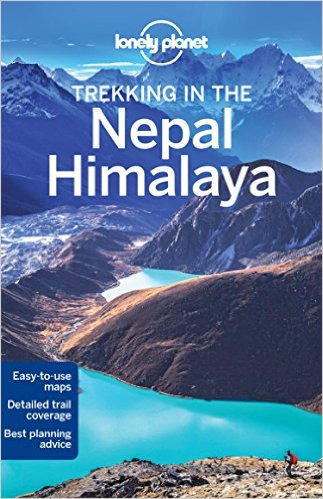
The Three Passes Trek is quite challenging as it involves traversing very high passes over 19 days of trekking. For this reason, we do not recommend trekking solo or without a guide who will have extensive knowledge and experience of trekking in the region.
A good guide book with a map, however, can be very useful when wanting to learn more about the area or when searching activities to do on your rest or acclimatization days.
The Lonely Planet Trekking in Nepal Himalaya guide is a regularly updated and informative guide that will include maps and sightseeing opportunities for a variety of treks in the region.
In terms of a map we recommend Nepa Maps – Three Passes and Everest Region map.
Detailed Itinerary
As with all treks, your journey to trek the Three Passes will start with an international flight into Kathmandu. A short flight to Lukla will precede the start of the trek that takes you through the Dudh Koshi valley before looping around through Gokyo and heading to Everest Base Camp. The inwards leg will take you east over your final pass and back to Lukla.
Most tour operators will list the Three Passes Trek as an 18/19-day trek. Of these days, usually 15 will be spent trekking with a further 1 or 2 acclimatization days, meaning 14 days of actual trekking can be expected.
Day 1: Arrive in Kathmandu
Arrive in the capital of Kathmandu after what is sure to be a long flight from home. Make your way to the hotel where you can relax for a bit before setting out to explore some of the vibrant city.
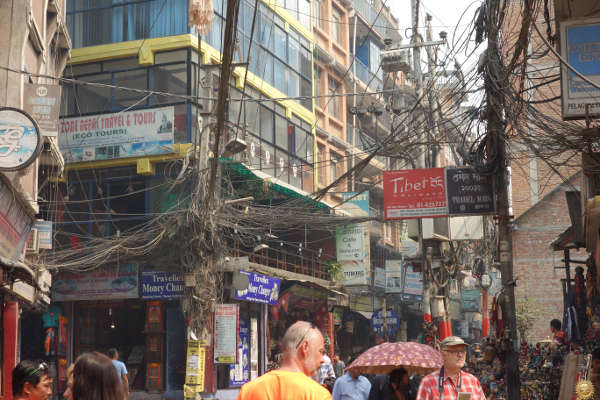
Vibrant streets of Thamel, Kathmandu
Day 2: Fly from Kathmandu to Lukla. Trek to Pkadking
An early morning flight will take you to Lukla, the starting point of the trek. Despite being only 35 minutes, the flight is a memorable one! Try to sit on the right-hand side of the plane for the best views of Everest as you approach Lukla.
The trek starts with fairly short descent to Phadking, where you will pass stone walls decorated with prayer inscriptions – called Mani in the local language. You will spend the night in Phadking.
Day 3: Trek to Namche Bazaar
The trek to Namche Bazaar will see you enter the Sagarmatha National Park , a UNESCO World Heritage Site. The village of Namche Bazaar is the central trading post of the region and is always bustling with life.
Day 4: Acclimatisation Day
Day 4 is an acclimatisation day spent in Namche Bazaar. Explore the village, stock up on some much-needed snacks for the trek ahead and be sure to check out the bakery – one of the best! The market on a Saturday is also a major attraction.
Day 5: Namche to Thame
The trail now splits from the popular base camp route and heads north-west through the small Sherpa village of Thamo before reaching Thame, where you will be staying the night. Take some time to learn a bit about the local traditions and their intrinsic connection with the mountain on which you are standing.
Day 6: Thame to Lumde
4-5 hours of trekking will see you cross the Bhote Koshi river before heading up the valley to Lumde. As you start to gain altitude you should get some great views of the snow-capped peaks in the region.
Day 7: Lumde over Renjo La to Gokyo
Today you will encounter your first of the Three Passes – Renjo La. The route starts off easy but will soon turn into a hard day of hiking as you near the end of the ascent of Renjo La. Try to think of the magnificent views you will get at the top to motivate you!
After the pass, you will descend to the third of the Gokyo Lakes and then trek onto the village of Gokyo for the night. After some rest you can even climb up the ridge to get some amazing views of the lakes, the highest freshwater lake system in the world.
Day 8: Gokyo Ri (Acclimatisation Day)
Today you climb your first peak Gokyo Ri for fabulous views of Cho Oyu. You will do this climb early and then have the rest of the day to rest.
Day 9: Gokyo to Thaknak
Cross the Ngozumpa Glacier – the largest glacier in Nepal – over the course of an easy day’s trekking. Once again, keep your camera close as you trek through this beautiful part of Nepal!
You will reach Thaknak where you will go on a small acclimatization hike before lodging for the night.
Day 10: Over Cho La to Zungla
Often considered the hardest day of the trek, today involves traversing the second pass of Cho La. At over 5,300m, reaching the top will require some effort.
You will spot the famous prayer flags as you near the top of the pass, after which you descend over the other side of the pass to reach Zungla.
Day 11: Zungla to Gorak Shep
Start the day with an easy downhill portion to reach Lobuche, one of the major stops on the classic Everest Base Camp Trek. Join up with the crowds of trekkers as you make your way to Gorak Shep.
You will be afforded great views of the famous Khumbu Glacier as well as the peaks of Everest, Lhotse and Nuptse. Spend the night in the busy Gorak Shep.
Day 12: Gorak Shep to EBC and back
A short trek following the ridge of the Khumbu Glacier will take you to the Everest Base Camp. Make the most of your time here, as trekking groups are not typically allowed to stay overnight at the base camp.
Feel the buzz and excitement of the place, packed with potential future summiteers of Everest! Descend later that day down the same ridge back to Gorak Shep for some much-earned rest and sleep.
Day 13: Kala Patthar hike and then onto Lobuche
An early morning start is needed to summit the trekking peak of Kala Patthar – the iconic viewpoint of Everest. After snapping some pics, head back to Gorak Shep for a quick meal before descending further to Lobuche for the night.

View of Everest, EBC and Khumbu Glacier from Kala Pattar
Day 14: Kongma La Pass and onto Chukkung
You leave the classic base camp route today as you head east through the Khumbu Glacier to reach the third and final pass of the trip – Kongma La Pass. At 4,700m the pass is the highest of the three and lacks any shops or tea houses along the way.
After a tiring ascent to the top, descend into the Chukkung Valley and eventually to the village of Chukkung where you will stay in the lodge overnight.
Day 15: Chukkung Ri and then to Dingboche
Today you will climb Chukkung Ri (5,550m) and trek to Dingboche (4,410m)This peak is the hardest of the three you can attempt on this treks and involves some easy scrambling near the summit. The views from the top down the Khumbu Valley are superb. You descend to Dingboche where you will stay in a lodge overnight
Day 16: Dingboche to Namche Bazaar
A downhill trekking day will take you through the verdant fields and rhododendron covered hillside on your way to Namche Bazaar. Pass through the village of Khumjung where you can eat lunch before completing the descent to Namche Bazaar where you will stay overnight.
Day 17: Namche to Phakding
You continue through Namche Bazaar, descend Namche Hill and cross the Dudh Koshi. You are now sauntering back along familiar paths to Phakding. Overnight lodge.
Day 18: Phakding to Lukla
The last day of trekking will take you through some lovely pine scented forests before reaching Lukla where a cold drink and a hot meal await you!
Day 19: Fly back from Lukla to Kathmandu
Weather permitting, catch the morning flight back to Kathmandu to end off what is sure to be the trip of a lifetime.
Day 20: Depart Nepal
After your last night in Nepal, make your way to the airport to hop onto your flight back home, where you can tell all your friends and family about the time you had!
Altitude Profile
The altitude chart below shows the typical progression of the Three Passes Hike through the major stopping points along the way. The three spikes of the passes are clearly visible along with the spike of Kala Patthar – the iconic viewpoint.
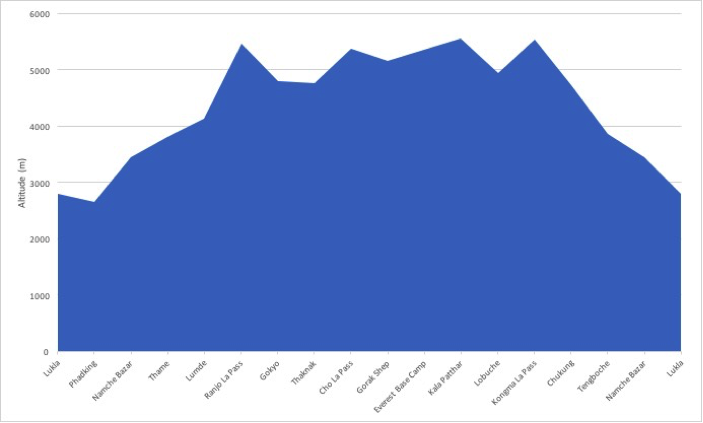
The ascent profile of this trek is slightly harder than the classic Everest Base Camp trek because it involves rapid ascents of the passes.
Three Passes Trek FAQ
How long does the 3 passes trek take.
The 3 passes trek generally takes 20-21 days depending on the operator and route. This is one of the longest commercial treks available in this region of Nepal.
How much does the Three Passes Trek Cost?
Tour operators will charge in the region of £1,200 to £2,500 for a guided Three Passes Trek. We definitely recommend using a tour operator for a trek of this difficulty and length – preferably a western tour operator whose guides and equipment will be of a higher standard.
The cost will include all board and lodging for the 18 days, all domestic travel and domestic flights, meals, shared equipment and knowledgeable guides. For a detailed breakdown of costs on the classic Everest Base Camp Trek, read our article here .
What are the three passes on the EBC and Three Passes route?
The Three Passes route gets its name from the three high mountain passes that you will cross during this trek. These are Kongma La (5,550m / 18,209 ft, Cho La (5,420m / 17,782 ft) and Renjo La (5, 360m / 17,560 ft).
When is the best time to trek the Three Passes?
As with all treks in the Everest region, it is advisable to avoid the winter months as well as the peak summer months during the monsoon season. The shoulder months of February-May and September-October provide the most stable and dry weather conditions for trekking.
Our detailed article on the best time to trek in the Everest region will give a much more in-depth analysis of the conditions faced in different months.
How difficult is the 3 passes trek?
The Three Passes Trek is considerably harder than the classic Everest Base Camp Trek so we recommend you have a good fitness level before embarking. Ascending the high passes involves long days of strenuous trekking that would not be encountered on the classic base camp trek and other variations.
6/7 hours of trekking per day is to be expected and altitudes of up to 5,500m are reached on the trek. That being said, the trek is still very popular among people wanting a bit more of a challenge. Read our training article to get an idea of how much you should prepare for a trek in Nepal.
Will I get altitude sickness?
Despite crossing some very high passes, the trek has been designed to follow the principle of trek high, sleep low. That means that you will not be spending extended periods of time at altitudes above 5,000m. The itinerary also has acclimatisation days as well as nights spent at lower altitudes to help the acclimatisation progress. If you follow the guide you should not have a problem.
That being said, altitude sickness can affect anyone regardless of age or level of fitness so we recommend doing some preparation reading. Our detailed article on altitude sickness and acclimatisation is a good starting point.
What gear should I pack for the Three Passes Trek?
The packing list for a trek of this length can look quite long! For this reason, we have dedicated an article to help you tackle the challenge that is packing. In our Everest Base Camp Trek packing list we provide list of clothing and equipment that you should bring, as well as some brands that we recommend based on our experience of using them.
What insurance do I need?
The short answer is yes. Trekking in Nepal at high altitudes comes along with various risks that are not covered by typical travel insurance. We recommend taking out insurance that covers trekking to altitudes up to 6,000m as well as medical evacuation from the mountain.
We have a detailed article to help to find the best policy that will suit your needs. Alternatively, use the quote calculator below from our recommended partner, World Nomads. They offer insurance that covers guided hikes up to 6000m and include a premium for Helicopter Evacuation in Nepal.
Route Variations
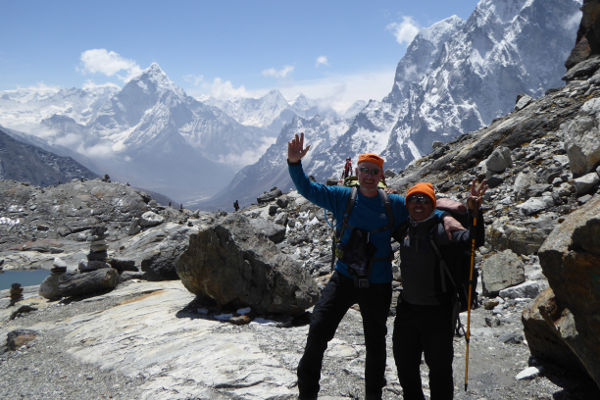
One of the more popular variations of the Everest Base Camp Trek , the Gokyo Lakes Trek, also starts at Lukla and follows the classic base camp trek to Namche Bazar where it forks north-west.
The trek proceeds through the towns of Dole and Machhermo before reaching the stunning Gokyo Lakes. From there you ascend to the peak of Gokyo Ri in the north, before traversing Cho La Pass and re-joining the classic trek at Lobuche.
The detour adds 2/3 days onto the trek but provides the wonderful opportunity to summit a peak while also avoiding some of the busier parts of the trek.
Gokyo Lakes Trek
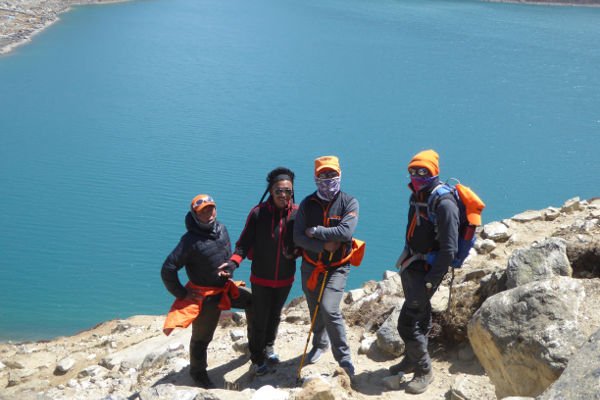
One of the more popular variations of the Everest Base Camp Trek, the Gokyo Lakes Trek, also starts at Lukla and follows the classic base camp trek to Namche Bazar where it forks north-west.
Jiri to Everest Base Camp

This variation of the classic trek offers an alternative to flying into to Lukla from Kathmandu to start the trek. The Jiri variation starts with an 8-hour bus ride from Kathmandu to Jiri, where the trek begins.
The variation adds an extra 5/6 days onto the trip as you trek through the Solu-Khumbu region and make your way past Lukla, where the trek then follows the same route as the classic Everest Base Camp Trek.
It involves a scenic, yet very long, bus ride as well as a lot more exposure to the Tibetan and Sherpa cultures. Expect to trek through more forests and streams as you start at the relatively low altitude of 1,800m and work your way up to Lukla and beyond.
Island Peak Climb

The variation trek that involves summiting Island Peak is significantly harder than the classic Everest Base Camp Trek. The climb to the peak is somewhat technical although and requires basic knowledge of using crampons and ice axes. Standing at just under 6,200m, however, altitude can be the real challenge.
Most climbers of Island Peak use the traditional base camp trek as a means of acclimatising before heading to the Island Peak Base Camp via Dingboche on the main trail, or by traversing the Chongma La pass. Summiting from the base camp typically takes two days and the whole variation will add around 4 days onto the classic trek.
Mark Whitman
Hi, I'm Mark! Welcome to EBC Trek Guide - the Web's No.1 Trekking Guide to Everest Base Camp. I have trekked all over Nepal, but the Everest region remains my favourite. I hope you find all the answers you are looking for on this site. If you have any questions don't hesitate to drop a comment below! Happy Trekking!
Leave a Reply
Your email address will not be published. Required fields are marked
Thank you. How slippery or rocky is the terrain on cho la pass? I don’t feel comfortable boulder hopping or walking on slippery terrain. You can train for uphill or distances but being able to balance on icy or scree surfaces is something else. We are looking at going in october . Any comments would be most welcome.
Hi Brigitte, the Cho La Pass consists of mix terrain that can vary quite considerably depending on prevailing weather conditions during the week you go. In general through you can expect mixed rock / scree terrain with areas that can be a little slippery with black / blue ice. Careful footing throughout is important. Show cover is quite likely too so it is worth taking basic yak tracks just in case you need additional grip. Hope this helps!
Is the path traveled and visible? Are there cairns, that Point the pass? Are there some kind of signs along the path? Is it easy to get accommodation for the night? Thank you
Hi Francisco, the three passes trek does follow a well defined route but it is not very well signposted. I would recommended taking a guide and / or getting a detailed map of the region. Accommodation throughout the route is not a problem, there are many small villages on the route and all have teahouse accommodation for trekkers. All the best!
What do you do for food along the route? The 3 peak pass in particular. Do you buy food for the day at every tea house? Thanks
Hi Frank, there are lots of teahouses along the Three Passes trek. In terms of lunch you can usually find a teahouse to stop at half way through your daily trek, or take a snack with you and only stop for dinner.
Thanks for the reply Mark!
Thanks for the useful information. Is this trek possible late December-early January? I did ACC last year late Dec-early Jan (including Tilicho), and it was wonderful, although desperately cold at higher altitudes. I assume this trek is colder as I would spend more time at higher elevation. I also appreciated that although less crowded that time of the year, there was good company in the higher teahouses and passes. Although I have no problem trekking alone, I would not feel completely comfortable spending days around 5000m completely alone. So my question would be, is this trek less crowded generally and colder than Annapurna Circuit?
Hi Daniel, I would say this trek will be colder than the Annapurna Circuit in Dec/Jan as you spend a lot more time at high altitude. The passes are also prone to closing in the winter if the weather is bad and there has been a lot of snow fall. I would definitely recommend taking a guide if you plan to trek the three passes.
I am planning for three pass trek in the first week of may. I have 15 days Itinerary. Is it possible to get it done including island peak. I am fit and I have plan to walk 9 hours per day. Plz let me know.
Thanks & Regards, Gopal
Hi Gopal, it’s possible to complete the 3 passes trek in 15 days, but the risk of altitude sickness (unless you are pre-acclimatised) is pretty high. Adding in Island Peak in addition would be a big ask, but doable if you are super fit and deal with the altitude well on the passes trek.
Hello there. I’m planning on attempting the 3 passes trek November 20-Dec 9 of this year. Is there a reason that you suggest clockwise? Most of the other places I have seen are suggesting counterclockwise. Any info would be greatly appreciated. Thanks!
Hi Murphy, thanks for getting in touch. I have no strong preference for either format. The reason why I suggest the clockwise route is because this is the I followed when completing the 3 Passes. The counterclockwise is equally as valid though.
Hi Mark, I am thinking about doing the Three Passes Trek. I have done Kilimanjaro one year before and further I do sport (mostly running, climbing, cycling) 3-4 times a week. However, I have never trekked for 19 days at high altitude and I don’t do a lot of trekking in my free time. Neither do I live in a place where my body is accustomed to higher altitude. I wonder if this is a trek I could do? Thank you in advance for your thoughts.
Hi Elene, you definitely sound fit enough to complete the 3 Passes. The key is to pace yourself, build in enough acclimatisation days to get accustomed to the high altitude, and make sure to look after your health with a good diet throughout. If you completed Kilimanjaro, you can definitely do the Three Passes. All the best!
Hi Mark thanks for all your useful information. I’m hoping to complete the Three Passes soon. I have years of experience. When would you suggest is the earliest I can expect to safely complete it. Mid-February OK?
Hi Rick, mid Feb can still be quite snowy and the passes may be closed. If you can push your dates a little bit further out – to mid March – then the probability of closed passes reduces (obviously there are no guarantees though). All the best!
Get a quote from the best local trek operator in Nepal!
Nepal Guide Treks & Expedition – Hiking & Peak Climbing Agency
- +977-98510-29613
- [email protected]
- Everest Three Passes Trek
- Activities Everest three passes including Chola Pass, Renjola Pass and Kong ma La pass
- Max Elevation 5545m at Kalapatthar
- Trip Duration 20 Days
- Trip Grade Moderate & Adventure
- Lodging Tea House Trek
- Meals Full Board on Trek & BB Plan on City
- Transportation Private vehicle & flight
- Communication Available
- Group Size Minimum 2
- Best Season Autumn and Spring
- Per Day Walk Approx. 4 - 7 hours
Things You Can Experience During The Trip
- Incredible sunrise view from the famous viewpoint of Kala Patthar.
- Exploring the three highest mountain passes of the region, including Kongma La Pass (5,535m), Cho La Pass (5,360m), and Renjo La Pass (5,385m).
- Trekking to the beautiful base camp of Mt. Everest (8848.86m)
- Mountain flight to Lukla observing the snow-clad mountains
- Cultural exploration in the Sherpa settlements along the trail, including Namche Bazaar.
- Passing through the cultural and religious landmarks, including the Tengboche monastery.
- Traversing and exploring through the Sherpa cultural settlements
Everest Three Passes Trek is an adventurous trek in the beautiful Everest region. This incredible trekking journey from “Nepal Guide Treks and Expeditions” will take you through the three majestic mountain passes. Moreover, the trekkers will traverse various natural landmarks of the region.
This alternative route is quieter than the more mainstream Everest base camp trek. The Everest Three High Passes trek remains in the Solukhumbu district of Province no 1 in eastern Nepal. The trails of this trek pass through the serene landscapes of the Sagarmatha National Park. These landscapes include glaciers, lakes, rivers, and others.
The cultural settlements in the region are unique. The majority ethnic group is the Sherpa community followed by Bhotiya and Tamang ethnic groups. They mostly follow Tibetan Buddhism and other forms of Buddhism. There are different Buddhist heritages in the form of religious landmarks like monasteries, chortens, stone inscriptions, prayer flags, etc.
The three significant mountain passes that you will traverse include Kongma La Pass (5,535m), Cho La Pass (5,360m), and Renjo La Pass (5,385m). In the beautiful terrains, you can observe rare and endangered wildlife species. These include Snow leopards, Red panda, Musk deer, Himalayan tahr, Danfe, and others.
This Everest Three Passes trek itinerary starts from Kathmandu as you take on a mountain flight to Lukla. After sightseeing in the medieval city of Kathmandu, you will continue your tour along the region. The beautiful Lukla is the primary gateway of the Everest region. From there, you will trek to the Phakding and Namche, passing through the various settlements, including Monjo and Jorsale.
The trails on this trek section pass through the beautiful accommodations of Sagarmatha National Park. Namche is a beautiful settlement where you can find many vibrant places, including cafes, hotels, restaurants, and others. This commercial town remains known for these incredible landmarks of the region. From the settlement of Namche, you will acclimatize and explore before making your way ahead on the trek.
There are beautiful settlements from Namche to Thame. This is where the trail diverts from the regular EBC trek. You will then pass through the beautiful Lungdhen settlement, from where you will lead to Gokyo. The trail passes through Renjo La pass, the first mountain pass.
You will then continue through the various settlements to reach the top of the Gokyo Ri summit. We will then continue exploring the Gokyo region and trek to Dragnak. From Dragnak, you will trek to Dzongla, passing through the second mountain pass of Chol La. The trail then takes you to Gorak Shep, where you also have an option to trek to the Everest base camp.
From the Gorakshep, you can hike to Kalapathar the following day and then return before trekking to Lobuche. From Lobuche, you will pass through the last mountain pass of Kongma La to arrive at Chukung, From Chukkung, you will gradually trail to Dingboche and, finally, arrive at Namche.
From Namche, you will arrive at the settlements of Lukla. Lukla is the place from where you started your trek and will now fly back to Kathmandu. You can fly to your desired destination after a free rest day in Kathmandu. Overall, this outstanding Everest Three High Passes trek is one of the best trekking journeys in the region.
Read further for more details about this stunning trek in the Himalayas. We at “Nepal Guide Treks and Expedition” have provided you with a detailed itinerary, best time, difficulty, and other tips for the tour. Happy traveling!
Everest Three Passes Trek Itinerary
Day 1 – Arrival at Kathmandu (1345m). Day 2 – Kathmandu Sightseeing Day 3 – Kathmandu to Lukla Flight and Trek to Phakding. Day 4 – Trek from Phakding to Namche Bazar (3440m) Day 5 – Acclimatization at Namche Bazaar. Day 6 – Trek from Namche Bazaar to Thame Day 7 – Trek from Thame to Lungdhen Day 8 – Trek to Gokyo via Renjo La Pass Day 9 – Summit Gokyo Ri and explore around Gokyo Day 10 – Trek from Gokyo to Dragnag Day 11 – Trek from Dragnag to Dzongla via Chola pass Day 12 – Trek from Dzongla to Gorakshep and optional trek to Everest Base Camp Day 13 – Early morning hike to Kalapatthar and back to Gorak Shep. Trek to Lobuche Day 14 – Trek from Lobuche to Chhukung via Kongma La Pass Day 15 – Trek from Chhukung to Dingboche Day 16 – Trek from Dingboche to Namche Bazar. Day 17 – Trek from Namche Bazaar to Lukla. Day 18 – Lukla to Kathmandu Flight Day 19 – Free day in Kathmandu Day 20 – Departure from Kathmandu.
- Includes/Excludes
- Fixed Departure
- Useful Info
Kathmandu altitude: 1345m
Overnight: Hotel/Resort
Upon your arrival in Kathmandu, you will get transferred to the hotel in the city. The representative staff will pick you up from the airport and help you check-in at the hotel. You can rest at the hotel or travel to our office for a short briefing about the tour. Exploring the city’scity’s beautiful landmarks is also on the cards. You will return to the hotel and rest for the night.
The medieval city of Kathmandu has incredible cultural and religious landmarks. On this day, you will go on a sightseeing tour of Kathmandu city. Numerous UNESCO listed world heritage sites in the region, including the durbar squares of Kathmandu. Lalitpur and Bhaktapur are highlights of the area. Since you cannot travel to all these places in a single day, you must select the places to travel to in advance.
You will also travel to the religious heritage sites of Pashupatinath, Boudhanath, and Swayambhunath. These sacred heritage sites are centuries-old and of high significance in the country. You will then travel to the Amazon to Basantapur Durbar Square, where you can find many temples, including the college Taleju Bhavani temple and Kumari Ghar. After exploring, you can return to your hotel and prepare and pack for the trip. You can also shop for any tracking equipment if required in the Thamel area.
Lukla altitude: 2886m
Phakding altitude: 2610m
Flight duration: 35-40 minutes
Walking hours: 3-4 hrs
Overnight: Teahouse of Phakding
On this trekking day, you will start your journey with a mountain flight from Kathmandu to Lukla. Our staff and representative will pick you up from the hotel in the city and then transfer you to the Tribhuvan International Airport. You will fly from the airport to the Everest region’s gateway.
You will land at the Tenzing-Hillary airport, which is a thrilling experience due to its location on a cliff side and small runway. After arriving at the airport, we will rest for a while before continuing our journey, climbing gradually to an uphill train through Dudh Koshi River’sRiver’s left bank.
We observe many Buddhist Heritage landmarks and sites as we trek through the region to arrive at Ghat. We will then continue our journey through various paths before finally arriving at a destination of Phakding.
Namche Bazaar altitude: 3440m
Walking duration: 5-6 hrs
Overnight: Fine Hotel of Namche
You will trek from Phakding to Namche Bazar early after having breakfast at the teahouse. The thrill of passing through the various challenging landscapes is quite exciting. The constant uphill and downhill terrain in the Sagarmatha National Park will enchant travelers.
At the checkpoint of this national park, we can complete the formalities of showing trekking permits. We will continue our journey alongside the Bhote Koshi river. The trek steeply ascends to the ultimate destination of Namche Bazaar.
We will continue our uphill climb to the top of a range that provides you with the sweeping Himalayan Vista of Mt. Everest (8,848m), Lhotse (8,516m), and other snow-clad mountains of the region. We will then travel through the forested areas to arrive at our destination of Namche Bazaar. We will spend the night at a lodge or hotel in the town.
Overnight: Fine Hotel of Namche Bazar
On this day of Everest three passes trek, you will acclimatize and explore the beautiful town of Namchi Bazar. We will go on various hiking peaks in the region. They will provide you with the opportunity to observe the Himalayas of the area.
There is also a Syangboche viewpoint from where we can get sweeping views of the region. From this viewpoint, you can observe Everest, Lhotse, Nuptse, Ama Dablam, Kusum Kangaru, and Thamserku, other snow-capped mountains. There is also another Sherpa museum that provides you with the cultural heritage of the region.
Namche Bazaar also is famous for its vibrant atmosphere, including cafes, hotels, restaurants, bars, lodges, etc. You can also go souvenir shopping in the shops around the town. After acclimatizing and exploring the area, you can rest in the evening at the lodge.
Thame altitude: 3739m
Overnight: Teahouse of Thame
Under this section of the trek, you will pass from the village of Namche Bazaar to Thame. The trekking trail starts after you have breakfast and observe the Himalayan sunrise from a viewpoint. The course then takes a western direction and moves upward to arrive at the Bhote Koshi Valley.
We will pass through various heritage sites with incredible cultural landmarks. Prayer flags and stone encryption with this Mantra written on it can get found along the trails. This region’s Tibetan Buddhist culture and tradition get reflected in these monuments and heritage along the route.
We descend through the Bhote Koshi trail before taking an uphill climb to Thame. Thame Gompa is an essential religious heritage site located at the valley’s top. You can also celebrate regional festivals if you travel in the spring. The village also overlooks the valley and is the site for the spring celebrations of the Mani Rimdu festival. You will spend the night at Thame teahouse.
Lungdhen altitude: 4380m
Overnight: Teahouse of Lungdhen
On this trekking day, you will continue our journey from Thame to Lungden. This incredible section is quite challenging as you will trek alongside the natural diversities of the Himalayan region.
However, you will trek on a busy trail alongside the Bhote Khosi river banks. We will then continue our path to the various settlements of the area. After traveling for a few hours, we will arrive at the teahouse in Lungdhen, where we will spend the night.
Renjo La Pass altitude: 5435m
Walking duration: 6-7 hrs
Overnight: Teahouse of Gokyo
This is an important section of the Everest three passes trek itinerary. On this day, you will continue your journey to observe the beautiful landscapes of Gokyo. Trekkers will pass through the Renjo La pass to arrive at the destination of Gokyo.
The uphill trek takes you on an uphill climb to arrive at a large kharka. Trekkers will then pass through the village settlements to arrive at the glacial lake. From this destination, you will encounter various stony steps to climb to the top of Renjo La Pass (5,435m).
You can observe the entire Khumbu region from the top of the pass. The trail then gradually travels on rocky terrain to reach the valley of Gokyo.
Gokyo Ri altitude: 5483m
In this trek, you will climb the incredible Gokyo Ri (5,483m), from where you can observe the Himalayan mountains, including Mt. Everest (8848.86m), Mt. Makalu (8481m), Mt. Lhotse (8516m), Mt. Cho Oyu (8201m) and others.
We will explore the area and take incredible pictures at the top of Gokyo Ri. We will descend to the Gokyo valley, where we will explore for some more time around the lake. You will stay tonight at the Gokyo teahouse.
Dragnag altitude: 4650m
Walking duration: 3-4 hrs
Overnight: Teahouse of Dragnag
This section of the track from Gokyo to Dragnag is quite an adventure as it passes through the beautiful terrains. You will need to traverse various challenging terrains before arriving at your destination. The trail is more accessible initially, but you will have to cross various terrains to cross the Ngozumpa glacier.
There are icy trails, making them quite challenging and slippery. You should be careful on the journey and remain protected with the help of trekking gear and equipment as the snow starts to melt during the day.
The Glacier can get quite dangerous during the daytime. Hence, we will trek early to avoid this. Finally, we will hike a few hours along the descending trail to arrive at Dragnag village settlement and then stay overnight.
Dzongla altitude: 4843m
Chola Pass altitude: 5420m
Overnight: Teahouse of Dzongla
This is an incredible section of the Everest three passes trek. On this day of the walk, you will pass through the settlements of Drangnag to arrive at the territory of Dzongla. You will also pass through the majestic Chola Pass during this journey which lies at an altitude of 5420 meters.
The trail moves ahead in the beautiful regions to arrive at the beautiful Cho La Pass. The mountain remains covered in snow most of the time. We love seeing stunning views of the entire Himalayan landscape and the Gokyo valley. After descending along the trail, we will finally arrive at the village settlement of Dzongla, where we will spend the night.
Gorak Shep altitude: 5435m
Everest Base Camp altitude: 5380m
Walking duration: 7-8 hrs
Overnight: Teahouse of Gorakshep
From the village settlement of Dzongla, we will continue our trek to Gorakshep. We will continue the way, passing through the beautiful settlements early in the morning. As you cross the high mountain, you will lead the trails to arrive at the Khumbu Glacier. We can also find the memorials of those climbers who have perished on the way to the Glacier.
It will then take you to the settlements of Lobuche, and then we will continue our trek to the Gorakshep. After arriving at the village settlement of Gorakshep, we will rest and have lunch. We will then continue our journey to the Everest base camp, an optional trek. Once we reach Gorakshep, we can follow the trail, which takes another 3 hours to complete the journey.
After arriving at the incredible destination of Everest base camp, we will explore the area and observe the snow-capped Himalayas. There are many trekkers and climbers in colorful tents training for the expedition. We will take some time exploring the area. Then we will return to our destination of Gorakshep.
Kalapathar altitude: 5545m
Overnight: Teahouse of Lobuche
We will start trekking in the dark before sunrise. We will walk in the dark so that we will get to observe the beautiful Himalayas and sunrise views. From Kala Patthar (5,545m), you can also observe the Himalayan mountains, including Mt. Everest (8848.86m), Mt. Makalu (8481m), and Mt. Cho Oyu (8201m), Mt. Lhotse (8516m), and other surrounding peaks.
After exploring the beautiful Kalapathar, we can take incredible pictures of the silver mountains, including Mount Everest. We will then finally return to our trail to arrive at Gorakshep. After spending some time at the teahouse, we will continue our route to arrive at Lobuche, where we will stay for the night.
Chukkung altitude: 4730m
Kongma La Pass: 5535m
Overnight: Teahouse of Chukkung
In this section, you will trek from the settlement of Lobuche to Chhukkung. We will have breakfast in the region and observe the most outstanding Himalayan Sunrise from the area. We will get to observe the silver Himalayas of the region as well.
The trail ahead will take you to the challenging trains to arrive at the significant mountain pass of Kongma La Pass (5,535m). We will take uphill terrain during the journey to cross the majestic Khumbu Glacier. Our journey takes you alongside a river and crosses it multiple times during the trip.
After reaching the mountain pass top, we can observe the essential snow-clad mountains of the region. We will finally reach Chhukung after a few hours of trekking. This village settlement is also known as the Valley of Glaciers. After arriving at the region’s settlement, you will rest overnight in the local teahouse.
Dingboche altitude: 4410m
Walking duration: 4-5 hrs
Overnight: Teahouse of Dingboche
The trail from Chhukung to Dingboche is another exciting section of the trek. The relatively easy trail passes through the streams and snow to arrive at the village settlement. From there, you will pass through the green field covered in walls of stone and Alpine forests. After trekking for a few hours, we finally arrive at Dingboche.
Overnight: Teahouse of Namche Bazaar
At the settlement of Dingboche, you will continue your journey along a relatively easy route to arrive at Tengboche. The trail passes through the Alpine forest leading you to the settlement. You will pass through the region’s spectacular landscapes, observing the area’s natural diversities. You will trek for a few hours to finally arrive at Namche Bazaar.
Namche altitude: 3650m
Overnight: Lodge of Lukla
The beautiful trails of the track will finally take you to Lukla. From Namche, you will trek through the beautiful terrains to arrive at your destination. This is the last day of the Everest Three pass trek passing through the settlements of Monjo and Jorsale. The trail is generally descending outside the Bhote Koshi River. After arriving at the territory of Namche, you will stay overnight.
Lukla altitude: 2860m
Flight Duration: 35-40 minutes
The Everest three high passes trekking journey comes to an end in Lukla. You will take a mountain flight after having a delicious breakfast. You can observe the snow-capped mountains for the last time during this mountain flight.
You can take this early morning flight from Lukla to Kathmandu. In the beautiful medieval city of Kathmandu, you can find the old cultural heritage of the town. Finally, you will arrive at the city of Kathmandu, where you will rest overnight.
Overnight at Hotel/Resort with Farewell Dinner
This is a free day in Kathmandu, where you can explore the region’s beautiful temples and cultural heritage sites. Other incredible heritages will provide you with the best artistic exploration in the region. You can also walk around the Thamel area and relax or celebrate the completion of the journey. We return to the hotel and stay overnight.
Our representative will pick you up from the hotel and transfer you to the airport in Kathmandu. From there, you can travel to your desired destination.
- Airport Arrival and transfer to Hotel
- 4 nights ‘Day 01, 02 & Day 18, 19” stay in Kathmandu with BB Plan
- All land transportation by private vehicle
- Sightseeing Tour in Kathmandu including Private Vehicle, all entry fees & experienced city guide
- Kathmandu – Lukla – Kathmandu both way flight
- All meals [B/F, Lunch & Dinner] During Trekking period
- Tea House & Lodges Accommodation during Trekking
- Sagarmatha (Everest) National Park Fee & TIMS [Trekkers Information Management System] fee.
- Highly experienced Trekking guide for the entire trek
- Required Number of Porters “2:1Ratio”
- Staffs food, clothing & salary, Insurance.
- General First aid Kids
- All tax, vats and necessary paper works
- Airport Drop
- Personal nature expenses
- Bar bill and all kind of drinks
- Rescue & Evacuation
- Gratitude (tip) for staff
The given rates are per person with guaranteed departure schedules. If the given dates are not appropriate for you, please feel free to contact us for requesting a new dates, we will gladly personalize the itinerary and schedule of the trip that fits for you.
Check our assured departure schedules given below:
Best Season for Everest Three Passes Trek
The incredible Everest three high passes trek is ideal in the peak season of Summer and Autumn. The perfect season provides you with the best Himalayan views from various viewpoints. Weather conditions also remain suitable for any sort of adventure in these seasons. Read more about these trekking seasons below:
Spring season
Spring has beautiful weather with a stable climate throughout. From March to May, you will experience beautiful weather, with conditions perfect for trekking at a higher altitude. There is minimal risk, and the Himalayas look incredibly beautiful in clear blue skies. Spring is also ideal because of the temperatures that remain in the suitable range.
You will not feel too hot or too cold during this season. There is green vegetation all around, with diverse wildlife along the trails. There are fewer weather-related challenges like heavy rainfall, snowfall, landslides, avalanches, etc. Hence, you can trek freely without any hassle during this season.
Autumn is another ideal time for trekking in the Everest region. The beautiful season from September to November has stable weather and climate. The temperatures remain at a moderate level. Trekkers will face fewer weather-related challenges this season.
Autumn is also when the local people celebrate many festivals in the region. It is an opportunity for travelers to go on a cultural exploration during their trekking journey. Silver Himalayas look incredible from the viewpoints along the trail. The clear blue sky during this time of the year and unobstructed views of the mountains are highlights of the trek.
Offseason treks
There are various off-seasons where you can travel and climb the Everest region. The season of summer-monsoon and winter are the two off seasons because of the challenges it comes with.
Weather-related difficulties during the off-season include heavy rainfall, snowfall, floods, landslides, etc. In the winters, you can observe the weather conditions with icy conditions. Hence, for these reasons, you should trek the peak season of Spring and Autumn as far as possible.
Everest Three Passes Trek Difficulties
This unique Everest three pass trek is generally considered a relatively complex and challenging adventure in the Everest region. This incredible trek passes through challenging landscapes and virgin territories. To complete the trek, you will need to be in a tremendous physical and mental state.
This trekking route and itinerary passes through adventurous trails in the remote region. There you will pass through the uphill and downhill terrains of the area. You will also pass through the naturally diverse terrains. You can find the beautiful Himalayan landscapes to be a great adventure.
Altitude sickness is a common problem in high-altitude regions above 5000m. There are various symptoms of altitude sickness, including headache, nausea, lack of appetite, insomnia, etc. Their beautiful trails provide you with the best acclimatization opportunities.
Hence, acclimatizing as much as possible in multiple stops along the trail is essential. Rest and hydration will also help you tackle altitude sickness in the region. Diamox tablets are anti-nausea medications that can help you tackle the symptoms of acute mountain sickness. If the symptoms persist, you will need to descend or abandon the trek altogether.
There are challenging adventure terrains, as you will cross three major mountain passes during the trek. To complete this journey, you will need incredible physical fitness, stamina, and patience. Trekkers will also need to build the strength and endurance required for the trek. Hence, proper training ahead of the tour is a must.
Another difficulty in this high-altitude Everest three high passes trek is that you will need to stay in local accommodation. These facilities are without many compared to the hotels in the city areas. Hence, you should manage these accommodations on the high-altitude trek.
Besides, the variety of food on the menu in these regions is quite limited. Since you will travel to a high altitude, all the food ingredients must get transported with the help of porter or yaks. Hence, you will only get Nepalese cuisine like “Dal Bhaat” along with pasta, noodles, momo, etc.
There is unpredictable weather in the high-altitude region, especially in the off-seasons. You will find the weather conditions changing in a quick span in these high-altitude regions. You can experience bright sunny days to overcast conditions with heavy rainfall in a few hours. Heavy rainfalls, landslides, floods, etc., are common in the off-seasons.
Hence, these are the different challenges you must face in the Everest three high passes trek.
Why Go For Everest Three Passes Trek?
Mesmerizing himalayan views.
Everest three high passes trek is a great scenic adventure in the region. The trails pass through various viewpoints from where you can also observe the total 360-degree views of the Khumbu region. Silver mountains, glorious Himalayan sunrises, and sunsets are beautiful highlights of this trek. Other natural diverse landmarks include hills, valleys, alpine forests, mountain passes, streams, glaciers, lakes, etc.
Culture and heritage exploration
The most underrated aspect of the Everest three passes trek is the cultural exploration. Since the trails pass through various cultural settlements of the region, you will get to observe the beautiful cultural elements.
Trekkers can follow the Buddhist landmarks in the area, including monasteries, gompas, mani walls, chortens, etc. If you travel in the autumn season, you will get to celebrate the local festivities with the people. You can even interact with them and learn about their culture with a professional guide.
Exploration of the flora and fauna
The trek also passes through various habitats of the diverse flora and fauna of the region. You can observe rare and endangered wildlife species, especially if you travel during peak seasons when they remain active. There are large vegetation areas with alpine forests. Trekkers can observe wild animals like Himalayan Tahr, Snow Leopards, Red Panda, Monal, Danfe, etc.
Rugged, adventurous terrains
The Everest three high passes trek is an adventure that includes various uphill and downhill terrain. This region requires you to pass through the beautiful landscapes before arriving at its ultimate destination. Hence this adrenaline-rushing adventure is one of the most desired trekking journeys in the world.
Food and Accommodation
The Everest three passes trek is a remote region trek that takes you through settlements with fewer accommodations. In these regions, you will generally find tea houses that provide you with the facility of staying and eating. The accommodation is a small room that is usually shared with other trekkers.
You will get a bed with a warm blanket and pillow. Toiletry facilities are available outside the tea houses whereas you should bring all your toiletries yourself. The meal facilities, as you can expect, are minimal in terms of variety. This is because food ingredients need to get transported on the back of a porter or a yak.
Generally, the food includes “Dal Bhat,” the Nepalese meal consisting of various items like rice, vegetables, pulses, rice, lentils, etc. Although the facilities do not match those in the fancy hotels of Kathmandu in Pokhara, you will get a warm meal and a place to stay. You should also carry sleeping bags as a blanket might not be enough in extreme cold weather conditions.
You can expect additional facilities at an added cost, including Wi-Fi, electronic charging, hot water, etc., which get depleted as you move up in the higher altitude region. You can get other cuisines like momo, noodles, chowmein, and thukpa. Some tea, coffee, and other drinks are also popular among trekkers in the region. Moreover, you can also carry various snacks by yourself, including chocolate bars, protein bars, dry fruits, and others, during the trek.
Things to Consider for Everest Three High Passes Trek
Trekking guide.
A trekking guide with professional experience is essential for any trekking activity in the region. The high-altitude Everest three passes trek is a challenging adventure requiring a professional guide. It will help you immensely while traveling through these rugged trains and navigate your way without hassle.
They will also keep you safe from injuries, accidents, and other emergencies like getting lost. Since they have local knowledge of the route and the language, they will help you explore the region culturally. You can also interact in the area with their help and continue your journey.
Acclimatization
Since this is a higher altitude trek than moves past 5000m, trekkers need to acclimatize during the itinerary. This trekking journey will pass through uphill and downhill terrains, increasing the chances of getting altitude sickness. To tackle altitude sickness, you must also drink water at regular intervals.
Rest and sleeping well after completing the trek are also essential. In the process of acclimatization, you will be able to adapt to your body in high-altitude conditions. These regions have less oxygen and air pressure compared to the lower levels. Another pro tip is to avoid alcohol, coffee, and other soda drinks as they can cause dehydration and altitude sickness.
Trek Permits
Since you will be traveling to a remote region, you must possess various trekking permits. These trekking permits will help you with multiple entry points in the region. There are various national park permits and conservation area permits that you must obtain as well. You can get these tracking permits at government offices like the Nepal Tourism Board and in Kathmandu and Lukla.
Physical fitness and stamina are essential factors during the trek. Since you will be traveling to a remote region, you should get proper training well ahead of the tour. This includes all necessary training activities like physical strength and endurance and cardiovascular and mental exercises.
These exercises will keep you flexible and reduce the chances of getting injured, cramps, blisters, etc. Moreover, you should also remain mentally stable and have a positive outlook and attitude to complete this high-altitude track. You can either train on your own or take the help of a gym trainer. You can also take practice hikes in the area to get a brief idea about the tour.
Travel insurance
One of the essential aspects is travel insurance. Since you will be traveling on a challenging trail, this travel insurance must deal with various aspects like accidents, injuries, theft, loss, damage to property, and others. These travel insurance must also cover helicopter evacuation, costing around $4000 to $5000. You must consider these various things during the Everest three passes trek.
The Everest Three High Passes Trek has the maximum elevation point at Kalapathar at 5643 meters.
The permits required for the Everest Three High Pass trek include Pasang Lhamu Rural Municipality Entry Permit and the Sagarmatha National Park Entry Permit.
The Everest Three Passes Trek is 20 days long.
The accommodation facilities are in small lodges and tea houses along the trail. These facilities provide basic facilities, including beds, mattresses, sheets, pillows, and blankets. There are squat-style toilets in most of these teahouses, and you must bring your toiletries.
The meals in these accommodation facilities of teahouses include Nepali dishes like “Dal Bhat.” It is a nutritious dish served twice a day and is ideal for a taxing trekking journey at a high altitude. There are other cuisines like momo, chaumein, noodles, pasta, and others in these teahouses. Tea, coffee, and garlic soup are common in these high altitudes with freezing weather.
Everest Three High Passes Trek is ideal in the Spring and Autumn season. These two peak seasons for the trek provide trekkers with a stable climate and pleasant weather. The region has moderate temperatures with a sweeping Himalayan vista of the snow-clad mountains. There are fewer weather-related challenges, delays, and cancellations in these seasons.
The Three Passes Trek in the Everest region is relatively challenging compared to the more mainstream Everest Base Camp trek. The trail of the walk passes through some of the rugged, remote natural terrains at high altitudes. It can be challenging for first-time trekkers and amateurs who have not trekked at high altitudes before.
Altitude sickness, or acute mountain sickness, is a severe problem on the trek. To tackle altitude sickness, trekkers must acclimatize well with various other safety measures like regular hydration, proper rest, and gentle trekking.
Trekkers should avoid caffeine and alcoholic products during the trek as well. As a preventive measure, they can also take Diamox tablets, an anti-nausea medication to tackle symptoms of altitude sickness.
The Everest Three High Passes trek requires trekkers to have a basic level of fitness stamina. For that, trekkers need to go through training a couple of months or weeks ahead of the trek.
Training should include strength and endurance-building exercises, cardiovascular or aerobic activities, and mental exercises. You can get help from a trainer or train yourself for the trek. To remain prepared, you can take practice hikes or learn more about the trek from past trekkers along with the internet.
If there is an emergency, our trekking guide will help you during difficult situations with safety care, medical treatment and communication services.
Communication is also available as the internet and satellite phone, so a guide would help you if something critical situation occurs.
The Everest Three High Passes trek package costs around US $1555 per person. The trek package includes various aspects like trekking permits, guides, porters, meals and accommodations, transportation, travel insurance, trekking gear and equipment, and others.
The Everest Three High Passes Trek requires proper gear and equipment, including trekking poles, crampons, boots, waterproof clothes, sleeping bags, and others. These trekking gears can also get hired on rent for the trek duration.
The Everest Three High Passes solo is quite challenging but doable. However, the difficult terrains of the region are recommended with a professional trekking guide.
Professional trekking guides and porters are essential for the trek. These trekking guides will help you with navigation and other challenges along the tour. They will also keep you safe from various injuries, accidents, altitude sickness, and others along the trail.
They will also help you with cultural exploration and help you with getting more insights into the local region. Similarly, porters will also help you carry heavy luggage along the trail.
Travel insurance covering the altitude of 4000m and above is essential for the trek. You will get coverage from various other aspects, including injuries, accidents, acute mountain sickness, delays, evacuations, loss, thefts, damage, and others.
Prakash Devkota
Meet with Prakash Chandra Devkota, Managing Director and Team Leader
Mr. Devkota hails from the beautiful hilly region of Gorkha District. He started his career as a guide in 1997 and quickly became a reputed figure in the Tourism Industry because of his extensive experience. He has gathered impressive experience in all Trekking and Climbing Routes, such as Mera, Island, Lobuche, Ama Dablam etc.
His success also lies in his brilliant mind and hospitable nature. He is fully dedicated to providing excellent services and introducing innovative concepts. With more than 15 years of experience in trekking and expedition operations in Nepal, Tibet, India, and Bhutan, he has earned a reputation as a renowned leader in the field. He understands the importance of personalized service for creating memorable experiences for his clients and constantly seeks innovative company operation methods.
Mr. Devkota has always been an avid practitioner of eco-friendly tourism and has always promoted environmental conservation throughout his career. He motivates his staff to embrace eco-friendly tourism through responsible tourism practices.
GLIMPSES OF Everest Three Passes Trek
Quick inquiry, traveller review.
see what our valued client have to say
Everest Three Passes Trek Best trek Ever !!! - We just came back after completing Everest Three Pass Trek with Nepal Guide Treks !! Superb view of towering mountains !! Thanks to Ramu - our guide and the genius . He was very helpful and full of local knowledge. We really enjoyed our trekking days with him. We just want to thank the whole time of Nepal Guide Treks for letting us to the great Himalayan adventure. We would certainly come back to do more adventure treks with you in future!!! We wish you a bright future !!! Carlos+Mia [Spain]
Thanks for wonderful trek !!! E3Pss !! We loved it We booked our Everest three passes trek with Nepal Guide Treks !! At first, we really were unsure about the decision. But as promised we received excellent professional service by the company. We are really happy to have completed this trek with NGT!! Our guide was Roshan truly amazing. He was caring, helpful and above all, he described us about the people, places and cultures. It just had been a wonderful experience trekking in the high Himalayas of Nepal. When we reach London, we will surely recommend your trekking trips for massive adventure. Thanks Again for making this trek memorable. Bryan + Jimmy + Edge [United Kingdom]
Best trek Ever !!! We just came back after completing Everest Three Pass Trek with Nepal Guide Treks !! Superb view of towering mountains !! Thanks to Ramu - our guide and the genious. He was very helpful and full of local knowledge. We really enjoyed our trekking days with him. We just want to thank the whole time of Nepal Guide Treks for letting us to the great Himalayan adventure. We would certainly come back to do more adventure treks with you in future!!! We wish you a bright future !!! Carlos+Mia [Spain]
Everest Three Passes – “Amazing adventure in the Mountains” I just want to express my gratitude to the NGT team for the arrangement of this absolutely amazing trek. The views of the valleys and the glorious mountains really granted me heavenly inner peace. Great teamwork !! I look forward to more adventures in Nepal with Nepal Guide Treks and Expeditions. Highly Recommended for complete adventure !!! Michael H. [Netherlands]
Similar Trips
Dhaulagiri high pass trek.
- Moderate & Adventure
- Group Size: Min 02
Dhaulagiri Circuit Trek
- Adventurous
- Group Size: Minimum 2
Manaslu Circuit Trek
- Moderate to Adventurous
Makalu Trek with Sherpani Col
- Moderate & Adventurous
Have Questions? Ask ( Dambar )
+977 985 103 3819
TRAVEL EXPERIENCE DESIGNER

14-DAY EVEREST BASE CAMP TREKKING
3 hours Everest Base Camp Helicopter Tour
12 Days Short Everest Base Camp Trek
10-day Everest Trek with Helicopter Return
11 days Everest Helicopter Trekking
20 Days Everest Three High Passes Trekking
13 days Gokyo Valley Trekking
18 days Chola Pass Trekking
14-day Renjo-La Pass Trekking
9 days Everest Panorama Trekking Package
19-day Jiri to Everest Base Camp Trek
10 days Everest Family Trekking
11 DAYS ANNAPURNA BASE CAMP TREK
12 days Annapurna Circuit Trekking
Mesokanto Pass Trekking
8 Days Short Annapurna Base Camp Trek
9 days Mardi Himal Trekking
Ghorepani Poon Hill Trekking
Annapurna Luxury Trekking
17 Days Upper Mustang Trekking
Annapurna Base Camp Helicopter Tour
Annapurna Family Trekking
Jomsom Muktinath Trekking
Short Annapurna Trekking Trails
Langtang Helicopter Tour
11 days Langtang Valley Trekking
Lauri Binayak Pass Trekking
Tamang Heritage Trekking
Helambu Trekking
Chisapani Trekking
14 Days Manaslu Circuit Trekking
15 Days Tsum Valley Trek
Manaslu Short Budget Hiking
19-day Nar Phu Valley Trekking
Upper Dolpo Trekking 22 days
Lower Dolpo Trekking
14 days Kanchenjunga Base Camp Trekking
Guerrilla Trekking
- 4 days Tibet Culture Tours
- Mount Kailash
- Bhutan Trekking
- Nepal Bhutan Tour
- 10 Days Bhutan Culture Tour
Everest takes the lead as the favored destination
- Trekking Popular for Trekking
- Climbing Adventurous Experience
- Tour Explore Best of Nepal
- Short Treks
- Wildlife Safari Tours
- Helicopter Tours
- Mountain Flights
- Cultural Tour
- Muktinath Tour
- Mustang Jeep Tour
- Nepal Paragliding Tour

#1 Most Selling Trip in Nepal

#2 Most Selling Trip in Nepal

#3 Most Selling Trip in Nepal

#4 Most Selling Trip in Nepal

Kathmandu Pokhara Chitwan Lumbini Tour
#5 Most Selling Trip in Nepal

11 days upper Mustang Jeep Tour
#6 Most Selling Trip in Nepal

15 days Island Peak Climbing

18 days Mera Peak Climbing

Chulu East Peak Climbing

Chulu West Peak Climbing

Lobuche Peak Climbing

Tent Peak Climbing

Muktinath Helicopter Tour

Nepal Muslim Travel and Tours

12 days Nepal Bhutan Tour Package

13 days Mt. Kailash Tour

Nepal accessible wheelchair Tour

Nepal Buddhist Tour

12 days Lhasa Cultural Tour

7 Days Kathmandu Tour and Travel
- Why Boundless Adventure
- Company Documents
- Responsible Tourism
- Banking Details
- Booking Terms and Conditions

Everest Three high pasess trekking image, Gokyo Lake

Everest Three high pasess trekking image

Everest Three high pasess trekking image3

Everest Three High Passes Trekking Trail

Everest Three High Passes Trekking suspension bridge

Local Market in Namche Bazaar
- Instant Online Booking
- Privacy Protected
- Guranteed Departure
- Group Discount Available
- Best Price Guaranteed
- Options Available (Accommodation, meals, permit fees, ground transportation, government tax, guide, airport picks up & drop off)
Trip Duration
Nature of trip, maximum altitude, difficulty grade, start & end point, best seasons, transportation.
Accommodation
Everest Three High Passes Trekking Highlights
- The trail leads you through the Everest Three High Passes Trekking in the Everest area: Renjo La Pass (5420 meters), Cho-La Pass (5420 meters), and Kongma-La Pass (5535 meters).
- The trail is combined with the Three High Passes.
- The trek through the Three High Passes Trek in Everest over beautiful glaciers and rocky trails.
- The trail takes you through the highest glacier on Earth, Khumbu Glacier (4900m).
- The trek is one of the most adventure-filled and thrilling trips around the Everest area.
- You will get to witness a mesmerizing panoramic view from Kala Patthar (5,555m)
- Brief Overview of the Trek to the Everest Three High Passes Trekking Routes.
Overview of 20 Days Everest Three High Passes Trekking
Everest Three High Passes Trekking, Nepal is a trekkers’ paradise. The home of the highest peak in the world. Mt. Everest offers thrilling adventures to the Himalayas. Thousands of tourists travel every year to Trek along the Himalayas of Nepal. One of the popular routes in Nepal is the Everest Three High Pass trek route. The Trek around the Everest region is an adventure of a lifetime.
It will surely mesmerize you with its beauty and thrills, especially above the Namche Bazaar.
The Everest 3 Pass trek is one of the most adventure-filled and thrilling. The Trek around Nepal’s Everest region brings you a daring challenge and rewarding experience. The Trek takes you through the three mighty passes of the Everest region. The three Everest High Passes are:
- Renjo La Pass (5420 meters)
- Cho-La Pass (5420 meters)
- Kongma-La Pass (5535 meters)
The 20-day Everest 3 High Passes Trek is a popular trekking destination in Sagarmatha National Park. The national park covers an area of 443 mi² ( 1,148km² ) and is at an altitude of 8,848.86 m around Mount Everest. The Everest Three High Passes trek is regarded as one of the most challenging treks in the Everest region.
You will pass through the three high-altitude passes of the Kongma-La pass (5545 M) , Cho La pass (5420 M) , and Renjo-La pass (5446 M) . The Trek brings incredible scenes and close picturesque views of the magical mountains on the Mount Everest Himalayan range, including Mt. Everest, Mt. Lhotse, Mt. Nuptse, Mt. Amadablam, Mt. Pumari, Mt. Thamserku, and many others.

Surrounding Mountain During Trekking High Passes
Everest Mountains surround the eastern Himalayan strip of Nepal. Everest region is home to over 300 different mountains ranging in various elevations. Precambrian high-grade metamorphic rocks elevate up to 8848.86 meters above sea level. Following these rocky formations are semi-arid rocky hills.
Dudh Koshi River flows between these gigantic massifs. Traversing along these rocky hills has been one of the greatest adventure activities. The trail follows the highest passes: Renjo La Pass (5345 meters), Cho-La Pass (5420 meters), and Kongma-La Pass (5535 meters). This traverse circumnavigates the Everest high hill called Three Passes Trek in the Everest.
The three-pass trek to Everest is an adventuresome journey. Trekkers begin their trip from the bustling city of Kathmandu. A startling flight headed eastward takes you from Kathmandu to Lukla. Lukla is stationed at the base of a hill with a Tenzing Hillary airstrip-like porch. From Lukla, we head northeast, following the Dudh Koshi River. Additionally, the trail unveils its amusing geography as we move further. We take on the Sherpa hamlets along the path.
From Lukla Airport till you complete the trek, the area comes under Khumbu Pasang Lhamu Rural Municipality. This area, including the Everest range, is situated in Solukhumbu district, Province 2 in Nepal.
Adventures through glaciers and Lakes
Similarly, you will have amazing adventures as you pass through numerous glaciers and lakes. You will also pass through the rocky and sloppy hillside, the beautiful settlement of Sherpa ethnic groups famous for their bravery in climbing majestic mountains.
Furthermore, as you go through the lush jungles, you will explore Buddhist monasteries in the Khumbu region and the many different species of birds, flora, and fauna.
Finally, you will reach the top of the majestic high mountains of the Everest region. The High Passes Trekking trail is a well-developed trekking route in Sagarmatha National Park, where you will have many places to rest.
Even though it is considered a challenging trekking destination in the Everest region, you can easily cross the passes with guides and porters as long as you are physically fit throughout the High Passes Trekking in 2024 and 2025.
Acclimatization Days During Everest Three Passes Trek
The Everest Three Pass is an inspirational trek in the Everest region, which includes the highest passes: Renjo La Pass (5345 m), Cho La Pass (5,420 m), and Kongma la Pass (5,545 m). The trek takes 18-20 days to complete. In such a long trek, one must acclimate. Acclimatization is necessary to reduce the risk of altitude sickness by adapting to the high elevation. So, choosing the trekking agency that provides a proper acclimatization day on the itinerary plan is advisable. Boundless Adventure has included 2 days of acclimatization day on our itinerary. However, we have a customized itinerary facility, so as per your request and preference, we can add other acclimatization days, too.
Here are the places where you’ll have an acclimatization day during the Everest Three Passes with Boundless Adventure:
Acclimatization at Namche Bazar
Namche Bazar, at an elevation of 3440m, is an important destination in the Everest region. It is a prominent hub of the Khumbu region with all the modern facilities. It is a popular acclimatization point and a gateway to the Everest region’s trekking destinations, including Everest Three Pass Trekking.
As per the itinerary design by Boundless Adventure, you’ll reach Lukla by a 45-minute flight from Kathmandu and then trek to Phakding on the first day of the journey. The second day leads you to the Namche Bazar by trekking from Phakding. As Nachme Bazar is more than 3000 m above, there is a risk of getting acute mountain sickness from there, so at Namche Bazar, you’ll have an acclimatization day on the third day.
The third day is a full acclimatization day. On the day, you’ll go for a day hike at a higher elevation than Namche Bazar and return to the tea house of Namche Bazar for an overnight stay. With breakfast at Namche Bazar, you’ll hike up towards Syangboche Airport, the highest airport in the world. With a visit to the Syangboche airport, you’ll move forward toward Everest View Hotel. As the name suggests, the breathtaking view of Mount Everest (8,848.86 m) can be seen from the Everest View Hotel. Then, after pleasing your eye with a view of Mt.Everest, you’ll move towards the longest mani walls in the Khumbu, near Khumjhung village.
You can visit Khumjung Gompa and other monasteries in Khumjung village. Descending from Khumjung village, you’ll visit the Khumjung Hillary school. Around 200m from Khumjung village, you’ll get to the last night at the resting point, Namche Bazar.
Acclimatization at Dingboche
At Dingboche, you’ll have your second acclimatization day. After acclimatization day at Namche Bazar, you’ll get to Tengboche and Dingboche. Dingboche, at an altitude of 4410m, is an appealing village in the Chukkung Valley. The acclimatization at Dingboche involves hiking to a higher elevation than Dingboche.
On the Dingboche acclimatization day, you’ll hike to a height of 5616m at NangkarTshang. You’ll ascend 2-3 hours from Dingboche to reach NangkarTshang. As you reach the pinnacle point, you’ll be surrounded by several snow-capped mountains, including Mount Everest, Ama Dablam, Tawache, Cho Oyu, Island Peak, Makalu, Lhotse, and Pumori.
From one side of the Nangkar Tshang, you’ll see Imja Valley to Chhukung; on the other, you’ll see 360-degree views of Lobuche village. Moreover, seeing glaciers, glacial lakes, and rivers from Nangkar Tshang is also pleasurable.
As you finish exploring the Nangkar Tshang surroundings, you’ll start descending towards Dingboche. The descent is easier than hiking. As you get to Dingboche, you’ll be prepared for the following day’s trek and take a nap.
Difficulty and Challenges During Three Passes Trek
Some of the major difficulties and challenges during the passes trek include:
Altitude Sickness:
As mentioned above, each pass lies above 5000m on the Everest Three Passes trek. The altitude sickness starts to seem as you get above 2500m. So, it is certain that acute mountain sickness is a concern while you are on the Everest Three Passes trek.
The major cause of altitude sickness is a decreased oxygen level at higher elevations and the body’s inability to adjust to the changed temperature.
Headache is the earliest and foremost symptom of altitude sickness you’ll get. Trekkers may also get symptoms of nausea, causing vomiting. Feelings of tiredness, dizziness, shortness of breath, and Loss of appetite are the common symptoms of acute mountain sickness.
Acclimatization is a prime objective to minimize the risk of altitude-related issues. Hiking slowly while resting at some points can also help reduce the chance of altitude sickness. Similarly, staying hydrated, staying away from the consumption of alcohol and cigarettes, and getting proper rest are crucial aspects of reducing the chance of altitude-related sickness.
Consider that ignoring the symptoms of altitude sickness can make your condition even worse and can cause life-threatening conditions. So it is advisable to immediately tell your guide when you feel any symptoms regarding altitude illness.
Extreme weather and temperature:
The weather and temperature of the Everest region are unforeseeable. The weather at high altitudes can change drastically, making trekking challenging. To avoid extreme weather conditions, trekkers should be aware of the best season to trek when there is less possibility of harsh weather conditions.
You need to pack clothes suitable for all kinds of weather and be well-informed about the weather forecast. But when you are with Boundless Adventure, you needn’t worry about the weather forecast, as we’ll update you.
Longer hours of walk with steep
Trekking in Everest Three Passes is not a small deal as it takes you to the giant of more than 5000m. The trek is tough and makes you feel tired, as the trek is about 18-19 days, and each day, you need to walk 6-7 hours.
The trail is steep ascent and descent, especially when crossing the three high passes (Kongma La Pass, Cho La Pass, and Renjo La Pass). When you ascend, the air becomes thinner, and the oxygen level reduces, making your trekking more adventurous.
Best seasons for Three High Passes Trek
The most important factor while planning your Trek is checking on the most suitable season. The trek is far more accessible and enjoyable during spring (March to May) and Autumn (September to December). The weather during this season is perfect for Trekking, with clear skies and suitable temperatures. You will get the best views of the mountains and the greenery alongside the trails.
Summer season (June to August)
The summer season (June to August) is also recommended. Trekking this route during winter is more difficult as the cold is challenging. There is heavy snowfall, and walking the Everest Three High Passes is not advisable during this time.
However, some experienced trekkers love the challenges this season throws at them. If you are looking for a worthwhile challenge and Adventure, consider trekking the Everest Three High Pass during this season as well.
Autumn (September to November)
This is the perfect season to Trek in the Everest Himalayas. During this season, you will have a favorable climate, going up to 20 degrees Celsius in the daytime and falling to just 5 degrees Celsius at night. You will have clear skies and a majestic view of the mountains. This is also just the kind of season that suits beginners. The Trek is relatively more straightforward during this season. We recommend trekking the Everest Three High Passes this season if you can manage your time.
Spring (March to May)
Another season that is almost as good for Trekking the Everest high passes is spring. The climate is relatively warm this season, and you get a dazzling view of the Himalayas. Also, the greenery blooms this season, adding even more to the beauty of the Trek. This season is famous for Trekking, so expect a bit of a crowd. The temperature is around 18 degrees Celsius during the day and falls to -5 degrees Celsius at night.
Summer (June to August)
The summer season in Nepal coincides with the monsoon. This makes it a tough season for Trek. You don’t know when it might rain so you can expect wet and slippery trails around this time.
However, the weather is pretty warm due to the effects of global warming. Temperatures can reach 27 degrees Celsius during the day and drop to around 3 degrees Celsius at night.
Thus, this season is also suitable for trekkers planning to travel to the Three High Passes. During the monsoon, you can also catch great views of the waterfalls.
Winter (December to February)
Winter is the most challenging season to trek the high pass. The temperature falls to -10 degrees Celsius at night and around 15 degrees Celsius during the day.
There is heavy snowfall as well, which makes the trail ever so hard to trek. We only recommend you travel the Everest Three High Passes this season if you have a little experience.
But if you are an experienced trekker looking for a challenging adventure, this Trek will fulfill that. You can get magnificent views of snowcapped Himalayas and trails during this season.
Points of Attraction of 3 Passes Trek
While three high passes of this Trek are an attraction, many discoveries exist. The Everest region has cultural, historical, natural, and geographical gems. Herein, we will discuss these factors:
Sherpa Culture
The Sherpa people densely populate the Everest area. They are the natives of the Solukhumbu district and most of eastern Nepal. Sherpa people migrated from mainland Tibet centuries ago and are considered an Indo-Tibetan race. The name Sherpa derives from the Tibetan dialect “Shar Pa,” which translates into people who live in the East. These groups of people are popular in the West for their fantastic climbing abilities. Sherpas have been mountain dwellers since Trekking and mountaineering. Their exceptional adaptability to high altitudes makes them perfect for mountain guides. Sherpa villages are sparsely scattered in the Everest region.
Sherpa people speak a mixed form of Tibetan language called Sherpa, Tibetan-Burman. Their ancestral practices are deeply rooted in Tibetan Buddhism. Sherpas follow a distinct blend of Buddhism and a Bon-based foundation of spiritual belief. Sherpa people still wear their traditional dress, Chuba for men and Pangden for women.
These dresses are made up of animal skin and fur to provide warmth in the cold, higher altitudes. Sherpa people have stone houses adorned with colorful prayer flags. Occupational engagement includes mountain climbing, tourism, hotels, agriculture, cattle farming, and others. Major festivals of Sherpas are Losar, Dumje, and Mani Rimdu. They were celebrated all across the Everest region.
Lukla Airport
A small airstrip was built at the end of Lukla village in Everest. It serves as a prominent gateway to the Everest region. The runway measures 527 meters and is stationed in an extension landmass beneath a massive rock wall. This airport’s name, Tenzing Hillary Airport, is named after the first conquerors of Mt. Everest. The altitude of the Lukla airport measures 2880 meters, and it’s a 30-minute flight from Kathmandu.
Lukla airport is of utmost significance to the region’s natives and trekkers venturing here. Aside from the Trek from Phaplu or Jiri, this is the only convenient mode of transport to access the Everest region. During the peak seasons, Spring and Autumn, this airport is busy with colossal air traffic. The supplies for the Everest area are carried on by plane from Kathmandu. These supplies make their way to the rooms above on a mule or the back of a porter from Lukla. Tenzing Hillary Airport is regarded as the lifeline of the Sherpa people. The Everest region thrives because of this airport, making it significant for the economy.
Namche Bazaar
Namche Bazaar is a bustling village shaped like an amphitheater overlooking Mt.Khumbila(5761m). This is the biggest village in your Everest Three High Passes Trekking. On the second day of your Trek, you will make a steep ascent from Phakding, Traversing via the gate of Sagarmatha National Park; Namche Bazaar unveils itself attached to a huge hillside.
As you enter the village, a typical Buddhist chorten has been built as a welcome monument. The town is dense, with several layers of Sherpa houses built on a terraced farm structure. Namche Bazaar has been a trade crossroad for the Tibetans and Sherpa people for ages. As is evident by the Sunday market, which is still in practice today, Namche Bazaar is a commercial hub.
Most trekkers choose Namche Bazaar as their rest stopover for acclimatization. The village is filled with restaurants, bakeries, pubs, and modern amenities for recreation. Three prominent attractions of this village are the Sagarmatha National Park Museum, the Mountaineering Museum, and the Sherpa Culture Museum.
Museums in the Everest Region
Everest region is enriched with several gems and discoveries. This area, including the Himalayan strip, is said to have been under the ocean millions of years back. An excessive amount of granite is found in these mountains, making the claim evident. There are 2 famous museums in the Everest region. On your Trek to Everest 3 Passes, glimpse these museums.
Sagarmatha National Park Museum
Sagarmatha National Park Museum sits atop the village of Namche Bazaar. This museum reflects the flora and fauna alongside numerous assets of Sagarmatha National Park. Dedicated to the diverse natural wonders of the Everest region, it provides a detailed insight into the rich biodiversity. It exhibits the national park’s wildlife, geography, and natural history.
Located within walking distance of 15 minutes, this museum sits portraying views of the surrounding mountains. You will have your first sight of Mt.Everest from this museum. It is picturesque and serene to gaze at the panoramic vista.
Sherpa Culture Museum
Another prominent exhibition for your acclimatization day in Namche is the Sherpa Culture Museum. This landmark is located 5-7 minutes from the SNP Museum. It provides an excellent exhibition and insight into the lifestyle of the Sherpa people. Exemplary displays of artifacts, household items, tools, and kitchen utensils make the museum livelier. The museum has been built on a structure replicating a typical Sherpa house. The museum building also incorporates a family room, prayer room, stable, and yard, perfectly imitating a typical Sherpa home. Entry to this museum requires a small fee.
Mountaineering Museum
As the name suggests, the Mountaineering Museum, which sits next to the SNP Museum in Namche, is iconic. It resembles mountaineers’ bravery, history, and perpetual achievements. The museum has been decorated with informative data about climbing history. It depicts several mountains, their technical difficulties, and their unsung history. The museum also portrays several mountain equipment used by the first conquerors of Mt.Everest. This museum is dedicated to brave mountaineers and their historical feats in the Himalayan Mountains.
Buddhist Monuments in the Everest Region
Most of the Sherpas in Everest follow either Kakupa or Gelupa Buddhism. Numerous Buddhist monuments are dotted all across the trail. Popular Buddhist monasteries in the Everest area include Namche, Tengboche, Khumjung, Pangboche, Monjo, and Lukla. The courses and villages are dotted with rock art depicting Buddhist chants. You will have occasional sights of Chhortens all across the trekking trail.
Viewpoint on the Everest Three passes journey are:
Chukkung ri:.
Recline above the village of Chukkung, Chukung Ri is the vintage viewpoint of the Everest region. For those going to climb the Island peak, Chukung Ri is the favorite stop point. Elevated at 5546m above sea level, Chukung Ri provides astonishing views of the Himalayan peaks and valleys.
The views of Mount Everest are not visible from the top of the Chukung Ri. Meanwhile, views of Mount Makalu (8481m), Lhotse (8516m), Ama Dablam (6812m), Imja Tse (6165m), Nuptse (7861m) can be seen from the top of Chukung Ri. Simultaneously, peaks including Cholaste (6440m), Tawache Peak (6495m), Kantega Peak (6782m), Thamserku (6608m), Baruntse (7162m), can also be seen.
Kalapathar:
Situated above the Gorakshep, Kalapathar is a noteworthy viewpoint of the Everest region. Situated at 5550m above sea level, Kalapathar is a popular destination in the Khumbu region , due to mesmerizing views from its top. Most trekkers go for Kalapathr hiking early in the morning to get the enhanced sunrise view.
One of the significant reasons the Kalapathar is well known is the view of Mount Everest. We can’t see top to bottom of Mount Everest from the base camp due to the obstruction of other peaks, but a closer view of Everest is visible from Kalapathar’s top. The 360-degree view of the Mahalangur Himalayan range is visible from Kalapathar. Moreover, Nuptse (7861m), Changtse (7543m), Ama Dablam (6812m), Chumbu (6859m), Thamserku (6608m), Kangtega (6782m), Taboche (6495m) and Lobuche ( 4940m) are seen clear from the top of Kalapathar.
Set on the west edge of the Ngozumpa Glacier, Gokyo Ri is 5357m above sea level in the Solukhumbu district. The Gokyo Ri, often called Gokyo Peak, is an ideal destination for trekking in the Everest region. It is near the Gokyo villages and lies within the Sagarmatha National Park. The Gokyo Ri is another stunning viewpoint you’ll explore on the trekking journey of Everest Three Passes.
The Gokyo Ri is a well-known destination, famous for its bird’s eye views of the Himalayan range and the glacier of the surrounding area. Views of Gokyo Lakes, Mount Everest (8,848.86m), Lhotse (8516m), Cho Oyu (8188m), Makalu (8481m), and other surrounding peaks are fabulous from the peak of the Gokyo Ri. Among all the mountains apparent from the Gokyo Ri, Mount Cho Oyu is closer. The largest glacier in the Himalayas, the Ngozumpa Glacier, is also attractive from the Gokyo Ri.
Safety During the Everest Three Passes Trek By Us
Trekkers’ safety is Boundless Adventure’s responsibility. Although the Everest Three Passes is an adventurous trek, we assure you throughout the tre. Even at the toughest part of the trek, we’ll be there for your back support and cheering you up. Here are some of the safety measures we adopted during the Everest Three Passes trek.
Experienced Guide: Boundless Adventure provides a highly trained and certified trekking guide for your trek to Everest Three Passes. Our guides possess extensive knowledge of the geography and weather conditions of the region and are well-equipped to handle any potential risks that may arise during the trek. They are trained to provide first aid treatment and can respond to emergencies. Additionally, our guides will take individual care of each trekker throughout the journey.
Acclimatization Plan: We understand the importance of acclimatization when trekking at high altitudes and prioritize our clients’ well-being and safety. Our Everest Three Pass itinerary includes two dedicated acclimatization days, but we’re always open to customizing the plan to meet your needs. We’re enthusiastic about making your trek a positive experience and assure you that our well-thought-out acclimatization plan will help you enjoy the stunning views and adventure of the journey with confidence.
Emergency Plans: Embarking on a trek in the Everest Three Passes is an exciting adventure! As you traverse three high passes above 5000m, it’s important to note that unexpected situations can arise. However, please rest assured that we prioritize your safety and have detailed pre-emergency plans. If any issues occur, inform your friendly guide immediately, and they will expertly handle each situation carefully. Our guides are highly trained and experienced to manage any possible risks so you can focus on enjoying the breathtaking views and creating unforgettable memories!
Accommodation: We are thrilled to share that we have established a strong network of partnerships with charming tea houses and lodges nestled along the mesmerizing Everest Three Passes trail. It is our top priority to meticulously vet each accommodation option to ensure that you have a safe and comfortable stay. You can relax knowing our handpicked choices will provide a warm, inviting bed and breathtaking views from your window.
Hygiene Food: During our Everest Three Passes trek, we provide three times vegetarian meals daily that are fresh, locally sourced ingredients. Our food is free from harmful additives.
Itinerary of 20 Days Everest Three High Passes Trekking
Everest High Passes Trek itinerary as designed by Boundless Adventures crafted professionally. We have curated this itinerary, ensuring proper acclimatization and rest days. The schedule described by the itinerary provides enough rest and trek. Furthermore, a buffer day for the trek helps in case of flight delays due to weather uncertainties.
This itinerary of 20 days is crafted to provide a wholesome experience of the Sagarmatha region. This itinerary includes your arrival and departure date, including the trekking days in the Everest region. If you have any queries about the standard itinerary, email us. We also custom-created 3 Passes Trekking itinerary per the client’s requirement.
Day: 01 Pick up from International Airport
Nepal is a small country in the world, and it is also a small airport as well. However, we will pick you up at the international airport and drop you off at the hotel by car, van, or Bus, depending on the group size.
It would help if you let us know about your flight arrival details.
Note: You know what? Local sim cards and money exchange are available at the Tribhuvan international airport.

Day: 02 Fly to Lukla and Trek to Phakding
The second day of the Everest Three Pass begins with a scenic flight from Tribhuvan domestic airport of Kathmandu to the gateway of the Everest region, Lukla Airport. The flight generally takes place in the morning due to better weather conditions, so you should be ready early in the morning as per the flight time we provide the day before the journey starts.
After breakfast, you’ll be picked up from your hotel and dropped off at the airport. After fulfilling all the formalities at the airport, your flight takes off. The flight takes you through Langtang, Shisha Panama, and MahaLangur Himalayan range, providing a bird’s eye view. Forty-five minutes of flight will land you at Lukla airport.
You’ll have lunch at Lukla at an elevation of 2840m, and after lunch, you start your trekking journey towards Phakding. Moving from Lukla, you’ll pass a suspension bridge and stone wall, then reach Chheplung village. Right after passing Chheplung, you’ll cross a suspension bridge over Chheplung Khola and get to Thodi Koshigoan, where you’ll get a view of Kusum Kangguru.
Ghat and Chhuthawa are the other villages you’ll get before reaching Phakding at an elevation of 2610m. The journey from Lukla to Phakding takes approximately 3 hours—dinner and Overnight at the tea house of Phakding.

Day: 03 Trek to Namche Bazaar, 3440m
After a pleasant night at Phakding, you’ll have a hearty breakfast at the tea house with the fresh air of the Everest region. As per the itinerary of Boundless Adventure, the second day takes you to Namche Bazaar. Along with a view of Kongde Ri, you’ll move north from Phakding via the bank of Dudh Koshi River and pass a suspension bridge. Walking through the rhododendron forest and waterfalls and crossing suspension bridges twice, you’ll get to Monjo. A short walk from Monjo takes you to Jorsale, the entrance gate to Sagarmatha National Park.
At Jorsale, you must show your permit to move further, so be prepared with all your permits. Moving forward from Jorsale, after checking in from Sagarmatha National Park gate, you’ll reach Larja Dobhan. While passing Larja Bridge, you’ll see the iconic Mount Everest for the first time, encouraging you to walk further. Approximately 5 hours of trek from Phakding takes you to Namche bazaar at an altitude of 3440m. Lunch at Jorsale, dinner, and overnight took place at Namche Bazaar’s tea house.

Day: 04 Acclimatization at Namche
The risk of altitude-related issues generally appears after getting more than 3000 m above height, so you must be careful as you already reach an altitude of 3440m. Day three is separated to allow your body to adapt to the changed temperature. On this acclimatization day, you’ll visit the nearby areas, connect with the locals more, and rest.
On the acclimatization day of Namche Bazaar, you’ll visit a small village, Khumjhung, where Buddhist people live through the Syangboche airport and Everest View Hotel. On the acclimatization day, you’ll visit the Khumjung Hillary School, which Sir Edmund Hillary built.
On the visit, you’ll be pleased by the snow-capped mountains, including Mount Everest, Ama Dablam, Lhotse, Lhotse Shar, Nuptse, and many unnamed mountain peaks. After a beautiful exploration day, you’ll return to Namche Bazaar and recharge your body for the upcoming journey. You can visit the local people and get involved with their daily activities—dinner and overnight at Namche Bazar.

Day: 05 Trek to Tengboche, 3860m
After spending a pleasant acclimatization day at Namche Bazar, you’ll set foot for Tengboche, a village famous for the largest monastery in the Khumbu region. With a morning meal, you’ll trek through the beautiful settlements of the Sherpa people to get to Tengboche. With a companion of mountain views including Ama Dablam, Lhotse Shar, Taboche, Kangtega, and Thamserku, you’ll get to your resting point where you’ll have lunch, Phungi Thanga. After a warm lunch at Phungi Thanga, you need to trek through a switchback trail via pine and rhododendron forest.
During the walk through pine and rhododendron forests, you may also see beautiful wildlife, including musk deer, Himalayan Tahr, and pheasants. A five to six-hour trek from Namche Bazaar takes you to Tengboche, at an elevation of 3860m. Dinner and overnight stay at Tengboche.

Day: 06 Trek to Dingboche
Early in the morning, with breakfast at Tengboche’s tea house, you’ll have your lunch and visit the area’s monasteries, along with Tengboche monastery. You may get involved in the worshipping activities there, and after that, you’ll extend your journey towards Dingboche. The trek from Tengboche to Dingboche takes you through alpine landscapes, rhododendron forests, and Sherpa villages. A short walk from Tengboche takes you to Deboche; walking further from Deboche, Musk, Deer, Monal, and Blue Sheep may come to see. Passing the suspension bridge from Deboche, you’ll get to Shomara, a resting point and lunch camp. After lunch at Shomara, you’ll reach your day’s destination, Dingboche. Crossing a stream over Imja Khola, you’ll get to Dingboche at an elevation of 4410m. Glaciers, including Churu Glacier, Duwo Glacier, Ama Dablam Glacier, and mountains, including Mount Amphu Lapcha, Pumo Ri, and other surrounding peaks, can be seen upon reaching Dingboche. Dinner and overnight at Dingboche.

Day: 07 Acclimatization at Dingboche.
Acclimatization is a necessary aspect of trekking at the highest point. To ensure your safety and make your body comfortable with the changed temperature, we have included the sixth day as a day on Dingboche. On this day, you’ll get to an even higher elevation than Dingboche; you’ll trek up to a height of 5616m at Nangkar Tshang. After breakfast at Dingboche’s tea house, you’ll move towards NangkarTshang with a packed lunch and a water bottle. As you trek up to 5616m, you need to be adequately hydrated to reduce the risk of altitude-related issues.
NangkarTshang is one of the best viewpoints on the journey of Everest Three Pass, providing a spectral view of the surrounding mountains and glaciers.
The major scenery seen from NangkarTshang is the view of Mount Makalu, Lhotse, Lhotse Shar, Lake of Ama Dablam, Cho Oyu, Gokyo range, Island Peak, Imja Tsho Lake and the nearest view of Ama Dablam. After pleasing your eyes with the panoramic views seen from Nangkat Tshang, you’ll be at your tea house in Dingboche overnight and have dinner there.

Day: 08 Trek to Chhukung
As usual, you’ll have breakfast and move to your next destination; day seven leads you to Chukkung. The trek from Dingboche to Chhukung is beautiful parts of the journey in Everest Three Pass, involving gentle ascend. The trail to Chhukung from Dingboche takes you through alpine landscapes, yak pastures, rocky terrain, and a spectacular view of Island Peak. Throughout the journey from Dingboche to Chhukung, you’ll gain approximately 400m distance, as Chhukung is located at an altitude of 4730m above sea level. The distance from Dingboche to Chhukung is 7km, which takes approximately 3-4 hours to get to the destination. As the trek is short, you can get there early at your tea houses, you can visit the nearby areas, and get engaged with locals after having lunch at Chhukung—dinner and overnight at Chhukung’s tea house.
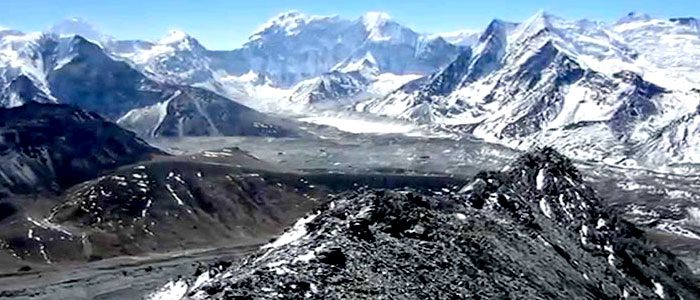
Day: 09 Trek to Lobuche via Kongma- La pass 5535 meters
From nineth days, you’ll pass through your first pass on the journey of Everest Three passes, Kongma La pass. Early in the morning, with a headlamp and packed lunch, you’ll start trekking for your first pass on the trek. The journey from Chhukung to Kongma La-Pass is adventurous with a steep ascend.
Before getting to Kongma La Pass, you’ll walk through rocky and probably snowy terrain. During the trek, you need to be physically and mentally fit to avoid altitude sickness problems. Within 5 hours of trek from Chhukung, you’ll reach the top of Kongma La-Pass at an elevation of 5535 meters from sea level.
Getting on the top of Kongma La Pass provides a sense of accomplishment when you get the eye-catching view of Mount Ama Dablam, Lhotse, Lhotse Shar, Neptune, Pumo Ri, and stunning Khumbu Glacier. From Kongma La Pass, you’ll get to see the stunning view of the highest mountain in the world, Mount Everest, much closer.
You’ll enjoy your packed lunch at the top of Kongma La Pass while appreciating the views of the surrounding landscapes. After exploring the area and relaxing your eyes with beautiful scenery, you’ll descend to Lobuche. Three hours of trek from Kongma La Pass takes you to Lobuche village, a village that lies in the shadow of the high mountains at an elevation of 4910m. Dinner and overnight at Lobuche.

Day: 10 Trek to Base Camp and Gorakshep
The 10th day takes you to the well-known trekking destination, Everest base camp. After finishing your breakfast at Lobuche, you’ll head towards Gorakshep at an elevation of 5140m.
The distance from Lobuche to Gorakshep is km, which takes approximately 3-4 hours to reach. The trail from Everest Base Camp to Gorak Shep goes through a rocky path along with a stunning view of Khumbu Glacier and surrounding peaks.
You’ll have lunch after getting to Gorakshep, and after an hour’s rest, you’ll go for Everest Base Camp exploration. Along the way to Everest Base Camp, you’ll get a close view of the Khumbu Icefall, providing stunning scenery while walking.
Views of Ama Dablam, Imja Tse (Island peak), Everest, Pumori, and many other surrounding mountains can be seen from the Everest Base Camp top.
However, Mount Everest’s view can’t be seen due to blockages from other mountains. After taking photos at the Everest Base Camp top and appreciating the area’s beauty, you’ll be back at Gorakshep for Dinner and an overnight stay.

Day: 11 Kalapathar and trek to Dzongla
Early in the morning, you’ll set off for Kalapathar, 5550m above sea level. Kalapathar is another stunning viewpoint on the journey to Everest Three Pass. From Kalapathhar, you can get a spectacular view of the mountains, including Mount Everest, which can’t be seen from the Everest Base Camp. Kalapathar is also famous for providing stunning sunrise views. 360-degree views of Everest, Nuptse, Pumo Ri, and Changtse, along with other surrounding mountains, can be seen from the top of Kalapatthar. After appreciating the view from one of the best viewpoints in the Everest region, you’ll be back at your tea house in Gorakshep for lunch. It takes 2 hours to get to the top of Kalapatthar and Half an hour to get back to Ghorakshep.
After lunch at Gorakshep, you’ll head towards Dzongla at an elevation of 4830m. The trek from Gorakshep to Dzongla combines some parts: challenging terrain and stunning Himalayan scenery.
On the way to Dzongla, you’ll pass through Lobuche Pass, a high-altitude pass providing panoramic views of surrounding peaks, including Ama Dablam Pass and Cho La Pass. It takes 5 hours to get to Dzongla from Gorakshep. Lunch at Lobuche, Dinner, and overnight stay at Dzongla.

Day: 12 Trek to Thangnang 4700m via Cho-la pass
Early in the morning, with a headlamp and packed lunch, you’ll head towards your second pass on the Everest Three Pass journey, Cho La Pass. As you have already passed the Kongma La Pass, remember that Cho La Pass is a little more challenging due to the icy trail.
The journey is memorable due to the combination of adventure and awe-inspiring mountain views. You’ll experience the thrill of passing high passes while surrounded by the majestic peaks of the Everest region. Five hours of trek from Dzongla takes you to the top of Cho La Pass at an elevation of 5368m.
As you get on the top, you’ll be welcomed by the views of Gokyo, Cho Ouy, Cholatse, Gyazumba (one of the longest glaciers), and other stunning snow-capped mountains. You’ll descend towards Thangnang from Chola top, but the journey is not easy as it involves the risk of falling rock and includes a slippery path and difficult icy crossing.
Three hours of trek from Cho La Pass takes you to Thangnang at an elevation of 4700m overnight and dinner at Sam tea house of Thangnang.

Day: 13 Trek to Gokyo, 5,357m
After crossing a second pass on the Everest Three Pass trekking journey, you’ll now set for Gokyo at an elevation of 4790m. Early in the morning, with a warm breakfast, you’ll make way for Gokyo. The distance from Thangnang to Gokyo is short, with 4km generally taking 3-4 hours.
No lodges and tea houses are on the Thang Nang trail to Gokyo, so you need packed food for energy during trekking hours and a bottle of water to stay hydrated. Upon reaching Gokyo, you’ll be surrounded by the peacefulness of Gokyo Valley.
Your lunch will be at Gokyo’s tea house. The view of the mount Ama Dablam is spectacular, and you’ll get it from Gokyo. You can visit the different lakes near Gokyo, including Dudh Pokhari, Gokyo Lake I, II, and III.
Your accommodation will be a tea house in front of Gokyo Lake, where you’ll have dinner.

Day: 14 Explore at Gokyo Ri and overnight
Gokyo Ri is the best viewpoint of Gokyo, which is close to the Gokyo Lake at an elevation of 5,357m. You have an exploration day at Gokyo Ri on the fourteenth day of the trekking journey of Everest Three Passes. With a morning meal, you’ll go towards Gokyo Ri. The exploration day usually starts early with a climb to Gokyo Ri to get the sunrise over the fantastic views of the mountains. Mount Makalu, Cho-Oyu, and Mount Everest are the peaks you’ll get a closer view from Gokyo Ri. Seeing Mount Everest, glowing in the morning sun, is the best view seen from the Gokyo Ri early in the morning. Within 4 hours, you can visit and return to Gokyo, so you’ll have a short hiking trail on this day.
After returning to your tea house in Gokyo, you’ll have lunch, and at the remaining time, you can visit the Gokyo IV and Gokyo V, which are a little far from Gokyo village. Dinner and overnight at Gokyo.

Day: 15 Trek to Lumde via Renjo-La pass
After enjoying the views from different areas of the Everest region, including Cho La Pass, Kongma-La Pass, Everest Base Camp, Kalapathar, and Gokyo Ri, it turns out to enjoy the view from Renjo La Pass. After breakfast at Gokyo, you’ll go for a final pass on the trekking journey of Everest Three Pass, with a packed lunch. The trek from Gokyo to Renjo La Pass is somehow adventurous but has pretty views of Nepal’s Everest region. We are hiking 4 hours of trek from Gokyo take you to Renjo La Pass.
Getting on the top of Renjo La Pass at an elevation of 5360m provides a spectacular view of Mount Everest, Makalu, Cho Oyu, and other surrounding peaks. The view of the Everest Himalayan range and the Rolwaling range of the Everest region are the best parts of getting on the top of Renjo La Pass.
As you have passed all the passes, including Renjo La Pass, Cho La Pass, and Kongma La Pass, you’ll descend to Lumde with a feeling of pride. The trail from Renjo La Pass to Lumde is a descent. The descent can be steep at certain sections, so you need to be careful where you step.
The journey from Renjo La Pass to Lungden is exciting and allows you to see different landscapes and cultures in the Everest region as you go down from a high mountain pass. The 3 hours of trek takes you to Lumde. Dinner and overnight and Lumde.

Day: 16 Trek to Thame
The descent journey begins as you get on the Lumde, and another descend destination you’ll get is Thame, at an elevation of 3800m. With a warm breakfast at Lumde, you’ll descend towards Thame.
The trail passes through rhododendron forests, juniper trees, and alpine meadows alongside the bank of Bhote Koshi Nadi. Marlung, Tarango, Hungmo, and Thameteng are the most beautiful settlements of the sherpas you’ll pass through to get to Thame. The distance from Lumde to Thame is around 10 km, taking 5 hours. Thame is famous for its ancient monastery, the Thame Gompa. The monastery is important for culture and spirituality, providing a glimpse of the area’s rich Buddhist history— lunch at Taranga, overnight and dinner at Thame.
Day: 17 Trek to Monjo, 2835m.
Early in the morning, you’ll have breakfast at a tea house in Thame and then set foot for Monjo at an elevation of 2835m. The distance from Thame to Monjo is approximately 18km, and it goes down through Sherpa village and dense forests.
Along the trail, you’ll pass through the towns of Thamo, Phurte, Gangla, Namche Bazaar, and Larja Dobhan. At Namche Bazaar, you’ll stop for a lunch break for about an hour. During the trek, you’ll see and visit different Buddhist mani walls adorned with prayer walls, creating a spiritually rich atmosphere. The path goes down to the Bhote Koshi Nadi and crosses suspension bridges over the river, making the journey more exciting. Five hours of trek, including lunch break, takes you to Monjo. Dinner and accommodation at Monjo.

Day: 18 Trek to Lukla
With a morning breakfast at Monjo, you’ll check out from the Sagarmatha National Park by registering and completing the necessary formalities before continuing your descent towards Lukla. Day seventeen is your final trekking day in the Everest region and at the Everest Three Pass journey.
The trail from Monjo to Lukla is about 8 km long. It goes downhill through beautiful rhododendron forests, Phakding, Ghat, and Chheplung villages, and it is next to the Dudh Koshi River.
The trek lets you learn about different cultures by talking to locals and experiencing the Sherpa people’s warm hospitality at different stop points. Views of distant mountains, including Kongde Ri, Kusum Kangguru, and varying mani walls, will accompany you throughout the journey.
You’ll have lunch with the rat in the village of Phakding or in the town of Chheplung. The trek from Monjo to Lukla takes 5 hours—dinner and overnight at Lukla.
Day: 19 Fly to Kathmandu.
The journey of Everest Three Pass ends with a scenic flight from Lukla Airport to Kathmandu after breakfast at Lukla. Flight to Lukla probably takes early in the morning, so you must be prepared early. You’ll be staying nearby to Lukla airport. 5-minute walk to Lukla airport . You’ll fly towards Kathmandu from Lukla airport with all the memories in your heart. The 45-minute flight takes you to Kathmandu domestic airport. After landing at Kathmandu Domestic Airport, you’ll be dropped off at your hotel. As you land at Kathmandu airport early, you’ll have enough time to visit nearby areas where you’re staying (probably Thamel). You can even go shopping—dinner and overnight at Kathmandu’s hotel.

Day: 20 Back to suite Home.
Yes, Have a warm breakfast in the Hotel in Kathmandu and check out the hotel from Kathmandu by car/van. Our airport representative will drop you off at the Tribhuvan international airport of Kathmandu.
Note: If your flight is late at night or afternoon, let us know because the hotel check-out time is Noon.
Wish you have a pleasant journey ahead. Please let us know your feedback on the trekking and what you have done.

What's Included?
- Airport picks up and drops by private car/van/bus.
- Full board package trip with meals three times a day (Breakfast, Lunch, and Dinner) and Accommodations during the trekking.
- Round trip of Kathmandu –Lukla –Kathmandu flight tickets for all of you.
- Sagarmatha National Park permits and TIMS permits.
- Ground transportation from your hotel to the airport and hotel at the End of the trek.
- Experienced English-speaking Guide: Every two clients got one porter. Options (Required number of Porters to carry your luggage during the trek.)
- Food, accommodation, salary, insurance, and equipment for all trekking staff.
- Per person, one trekking map
- Domestic Airport departure tax.
- Domestic airport taxes.
What's Excluded?
- Your travel Insurance.
- Hot Shower during the trekking.
- Hotel and meals in Kathmandu.
- The rest of the expenses not mentioned in the price include the following.
Add-ons & Options
We have long experience organizing the Everest Three Passes trek and upgraded our website with various unique features. We are thrilled to introduce one notable feature, add-ons, to enhance your three-pass expedition. With a service of add-ons, one can design and customize their journey themselves. We are committed to extraordinary service to ensure that every step of our client’s journey is remarkable and achievable.
Cost of the hotel in Kathmandu.
Boundless Adventure offers hotel accommodation features to those who desire it. We only include accommodation on the three-pass journey rather than in Kathmandu. Thus, we can manage the hotel in Kathmandu only at your request. However, you are required to cover the hotel expenses. Usually, we provide a three-star hotel in Kathmandu that costs $45/- daily, including necessary facilities such as a double bed, wifi, and breakfast.
The cost of the helicopter to Lukla
Unlike airplanes with limited seats and ordinary means, a helicopter to Lukla from Kathmandu is a luxurious, personalized, and flexible experience. The helicopter tour is ideal when the weather conditions affect flight. We have an add-on service for helicopter flights at an extra cost. While the trekking package covers airplane costs but must pay extra for helicopter options. However, the cost of the helicopter tickets from Kathmandu to Lukla and Lukla to Kathmandu is US$ 550/- per head.
Cost of one porter.
Hiring a porter is a trekker’s personal preference. However, if you want someone to carry your backpack during the journey to the most adventurous trekking destinations, consider choosing an experienced porter. You can freely hike on your trip while enjoying the Everest region’s beauty. If you want a personal porter, we will manage it for you, and if you want to share your porter to reduce the cost, we are also okay with it. But remember, one porter can carry 23 to 25 kg in weight altogether. Furthermore, the price of a porter is US $390/-
Exportation of Chitwan National Park.
On the trekking package to Everest Three Passes, Boundless Adventure has included exploring the Chitwan National Park as a part of the Add-ons. Combining Chitwan National Park exploration with the Everest Three Pass trek allows you to participate in different adventures rather than just trekking. Also, we have included the exploration to immerse trekkers in cultural richness. While trekkers learn about Sherpa culture during the Everest three passes, they’ll learn about Tharu culture during the tour to the National Park.
After a challenging journey of three passes, trekkers relax during the tour to the National Park. Jungle Safari, canoeing, bird watching, visiting elephant breeding centers, and exploring Tharu villages provide refreshing opportunities for travelers in Chitwan National Park. The trip is a two-night and three-day program from Kathmandu to Chitwan and return to Kathmandu, including bus tickets, costing US$170/—per head.
To get add-ons, you can follow straightforward steps.
Phase 1: Click on Book this trip. The bottom is at the right corner of the website, and continue filling in the blanks. Phase 2: Fill in your details Phase 3: Choose your trip details Phase 4: Write your payment details. Phase 5: You may Choose Add-Ons as Options Phase 6: Follow the payment details with the number of travels
Essential Information - 20 Days Everest Three High Passes Trekking
Everest three high passes trek route.
Your thrill-some Adventure begins after crossing Namche Bazaar. This dense Sherpa settlement is a whole new world in itself. The trail then navigates higher, making steep ascents via a semi-arid landscape. As you follow through the Everest high passes trek, your Trek sets on a rollercoaster ride. Your first challenge of this traverse is the Kongma-La Pass at 5535 . The climb to this pass begins from Chukkung. This stretch is a steep climb for about 5 hours, so start early in the morning. After that, we go to Everest Base camp and return to Gorakshep.
Thereon, we trek to the majestic Kalapathhar peak at 5,555 meters and head toward Dzongla—Chola Pass (5420m), stationed between Dzongla and Thagnak. Furthermore, we trek to the pristine Lake Gokyo and follow another pass, Renjo La Pass (5345m). Everest three passes, Trekking ends with this traverse and returns to Lukla.
Three Passes Trek Package
The high passes trek in the Everest region begins with a short flight from Kathmandu to Lukla. It follows the classic trail along Phakding, Dudh Kosi Valley, and Namche Bazaar. Subsequently, it makes it through Dingboche, Chhukung Kongma-La pass, and Lobuche, and the course takes you to the Everest Base Camp.
After the excursion around the Khumbu glacier, you will return to Gorakshep overnight. You will have a side trip to Kalapathar in the early morning for beautiful sunrise views over Mount Everest and its surroundings. The climate is freezing, so wear warm, windproof clothes and gloves.
After having breakfast, you will be heading towards Zongla and crossing the Cho-La pass the next day. Then after an overnight stay, you will trek to Thank, Gokyo, via the longest glacier in the Khumbu region. Please note that glacier changes their shape every year, so there are high chances of getting lost on your way. You will need to have a guide with you for this very reason.
Syangboche Viewpoint
An hour’s hike from Namche Bazaar sets you up for an astounding view of Everest Panorama. Syangboche is stationed right above Namche Bazaar, with a famous hotel stationed here. Syangboche also has a seasonal airport with grassland as its runway. Above the airport is the Syangboche viewpoint offering the best views of the mountains. It is a famous sight trip for trekkers to glimpse the Everest vista before continuing their journey. Trekkers trek up to the Syangboche viewpoint during their rest day at Namche. It makes for a worthwhile round-trip journey. Trekking Cost
Although the high Pass trek is a bit costly compared to other trekking routes in Nepal, Boundless Adventures provides it at a reasonable cost. We can adjust the price according to your budget and travel preferences.
However, Boundless Adventure arranges solo and small group trips from Kathmandu. If you are solo, the charge is higher than with a group. You can contact us for prices, itineraries, and Everest 3 High Pass Trek information.
Documents and Paperwork Required For Everest Three Passes Trek
For Everest Three Passes trekking, you require three kinds of different permits/documents. The permits required are:
- Sagarmatha National Park Permit: The whole journey to Everest Three passes encompass the Sagarmatha National Park. Thus, obtaining a Sagarmatha National Park permit is necessary to start your trek on Everest Three passes.
- Trekkers Information Management System (TIMS) Card: Except for restricted areas, each of the trekking destinations of Nepal requires a TIMS card. In collaboration with the Trekking Agencies Association of Nepal (TAAN), and Tourism Board (NTB) the TIMS is applied for the safety of trekkers.
- Khumbu Pasang Lhamu Rural Municipality Permit: To regulate and manage the trekking activities within the Khumbu region, the Khumbu Pasang Lhamu Rural Municipality Permit has been in implementation since 2018 AD. The permit provides a chance for trekkers to contribute to the local economy of the region by giving money for projects in the community with obtaining permit.
All three permits are mandatory for Everest three-pass trekking. All the above-mentioned permits are managed by Boundless Adventure. On your behalf, without any trouble, we manage all the necessary permits for your enjoyable trek. The required documents for obtaining the permits are:
- Three photocopies of the valid passport with a Nepali visa
- Three or more Passport photo
- Details of trekking itinerary
- Viewpoint Exploration During Trekking
The entire journey to Everest with three passes provides you with a stunning view of the region. Each step provides you with something different to see. However, there are some unforgettable and unmatchable viewpoints during the trek, from where you’ll get a stunning 360 view of the region.
Sagarmatha National Park Entry Permit
You can get the Sagarmatha National Park Entry Permit from the city office at Boundless Adventure, Kathmandu.
There are three different types of permits that you will require for the Everest High Passes trek. These permits are The Sagarmatha National Park Entry Permit, TIMS Permit, and Khumbu Rural Municipality Permit. Getting these permits is easy. You can get these permits from Boundless Adventure in Kathmandu. National park entrance permits are required for every nationality.
Some Monastery Encounter
The trek to Everest Three Passes is more than just a walk. Indeed, the views of the mountain ranges are remarkable at Everest three-pass trekking but besides the breathtaking views of the mountain, the journey takes you on a spiritual journey. Throughout the trek to Three passes, you’ll encounter lots of monasteries along the way. As the Everest region has a unique culture the monasteries of the trail add to the more cultural significance of the region. There are some notable monasteries you’ll encounter during the trek to Everest three passes:
Tengboche Monastery:
Tengboche Monastery, the largest and oldest monastery in the Khumbu region, was built in 1916 AD by Lama Gulu. Tengboche monastery is situated in the village of Tengboche, at an elevation of 3867m. Tengboche Monastery is a Tibetan Buddhist monastery of the sherpa people in the region. The monastery of Tengboche is also known as the Dawa Choling Gompa.
The main building of the Tengboche is built with the traditional Tibetan architectural style. The building is beautified with woodwork, murals, and paintings, showcasing the artistic craftsmanship of the region. Mostly, Wood is used in the construction of the monastery.
The main prayer hall is the main focus of the Tengboche monastery with numerous religious assets, statues, and the image of the Shakyamuni. On the trail to Everest Three Passes, a Tengboche monastery is the most visited spiritual site. There you can learn more about the culture of the region.
Thame Gompa:
Thame Gompa located in Pangboche village is another significant monastery you’ll encounter on the trekking journey to Everest Three Passes. At an elevation of 3800, Thame Gompa lies to the west of the Namche Bazar of the Khumbu region. Thame Gompa and Tengboche monastery is like a magnet of the Khumbu region, As these two monasteries are constructed by the different disciples of the Lord Buddha.
The Thame gompa holds great significance to the cultural and spiritual hub of the area. Many monks live inside the Thame Gompa, the monks participate in the daily rituals and prayer to contribute to the spiritual well-being of the community.
The architecture of the Thame Monastery is designed in the Tibetan style. The art of wood and the colorful painting showcases the stories of Buddhists and create a peaceful ambiance. The traditional chants and music at the Thame Gompa, along with the sight of monks dedicatedly involved in the spiritual practices, provide a glimpse into the Sherpa culture of the area. Moreover, the prayer wheels around the monasteries also provide a feeling of peacefulness when roaming around the monastery.
Exploring the Thame monastery during the journey of Everest Three Passes not only provides you with a beautiful sight of the Gompa but also provides you spiritual experience. On the hectic day of trekking, you’ll find calmness at the time when you explore the Gompa. Over and above that, the gompas showcase the Sherpa tradition and their spiritual beliefs that have been alive for many generations.
Accommodation During the Trekking
The tea houses are maintained by the local sherpa people. On the tea houses along the way, each tea house offers you warm hospitality by the friendly Sherpa people. With a warm meal and comfortable resting point, you’ll be treated well in the lodges/tea houses along the way. Usually, the washrooms are outside the room, meaning you may not find an attached bathroom.
The rooms you’ll get are simple yet authentic. Each room contains two or three single beds. You’ll get a soft and warm blanket to keep yourself warm on a cold night. The pillows will be soft, additionally, the mattresses are simple but provide comfortable sleep.
Although the facility is small, the views you’ll get from your room’s windows are mind-blowing with snowy mountains, flowing glaciers, and rolling valleys.
While on your Trek, you will have three times meals a day. You may check the itinerary and cost details. You can choose your meals from various options on the tea houses’ menus.
We recommend having a heavy breakfast as it will fuel you to start your Trek for the day. You can pick from Corn Flakes, Oatmeal, French Toast, Eggs, and Pancakes for breakfast.
Then, you can have a light lunch during the day according to the available options on the menu. When you finish your walk, you can have a delicious dinner at the end of the day. There are options for Lunch and Dinner, including local meals.
Typically, you can get mineral water at every tea house along the trekking trail, but if you need a camel bottle to fill up with boiling water, you can get it in the tea house. The alternative option is to fill from the stream or hilly sources. You can carry a purifying tablet or chlorine to purify the water and make it worth drinking.
Guide and Porters at the Trek
Having a guide and porter with you is always advisable during a pass trek in Everest. Boundless Adventures provides professional, experienced guides and porters tailored to your preferences and journey. It is always helpful to have a guide and a porter.
A proper guide gives you an in-depth experience of the Trek and makes for a memorable one. The guides, having vast knowledge of the trekking route and being experienced trekkers, will ease your trekking experience.
A guide will also help you easily communicate with locals and provide insights into the historical importance of the places. Our guide is trained by the Nepal government, which has a guide and first adds a license.
If you want to travel freely with the weight of your heavy luggage off your shoulders, then we advise you to get a porter. A porter will carry all your loads through the Trek. This makes it considerably more accessible for you to trek. The porters are also locals who reside in the region, so they can also provide you with valuable insights.
The porters are very friendly and good companions. However, they only speak basic English, so there might be a communication barrier. Similarly, We are providing a porter from Lukla on your request only.
Whenever going on a trek, it is advisable to have a proper gear set to ease your trekking journey. However, you should only carry the essential things you require on your journey. Extra luggage will make it difficult for you to get through the Trek. We recommend you bring a list of essentials and additional items per your requirements.
We at Boundless Adventures can help you prepare all the necessary equipment for your Trek. Also, we can manage the items you need if you require us to. Feel free to contact us through mail or WhatsApp to start your preparations.
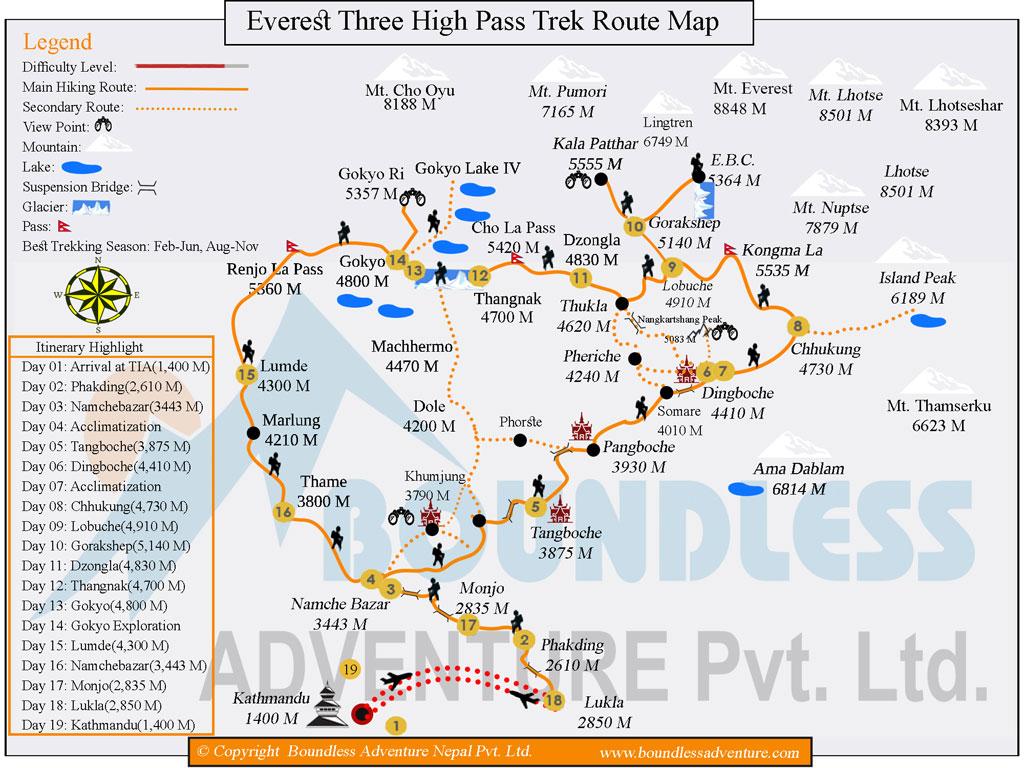
Boundless Adventure provides a trekking map to each trekker for the Everest Three Passes trek with a 1:60,000 scale. The map provided by us is new with an updated trekking trail. At the top and left side of the map, you can get to see the LEGEND that explains each sign on the map. Below the LEGEND you can see INDEX, where you can get to see the names of the places, Mountains peaks, bases, and passes. Moreover, at the bottom left side of the map, there is another LEGEND that explains the signs including airports, health posts, and others.
Once your journey is about to begin, you’ll get a map, here is a short description of the map that will help you on your journey to Everest Three Passes:
Your journey begins with a flight to Lukla airport, as you get on the Lukla, you can see the map provided by us. The trekking journey from Lukla begins towards Namche Bazar at an elevation of 3440m. Before reaching Namche Bazar you’ll encounter several villages during the trail. Chheplung, Thado Koshigoan, Ghat, Phakding, Mondo, and Larja Dobhan are the major villages you’ll see before reaching Namche Bazar. Chepplung Khola, the view of the different mountains, prayer wheels, and painted mani walls are also able to be seen during the trail.
From Machine the journey goes towards Tengboche village at an elevation of 3860m. To get to Tengboche village from Namche Bazar, you need to pass several sherpa towns including Kyangjuma, Chhatyang Kharka, and Phungi Tanga. From Tengboche, the journey moves forward to Dingboche at an elevation of 4410m. Deboche, Milinggo, Shomare, and Orsho are some notable villages you’ll pass before reaching Dingboche. You’ll also pass several suspension bridges to reach Dingboche from Tengboche.
Following the red line from the Dingboche, you’ll get to Chukkung at an elevation of 4730m. As seen on the map, there is no specific village on the way from Dingboche to Chukung. However, the trail follows walking through the bank of the river. From Chukkung, following the orange dotted line, you’ll get to Lobuche at an elevation of 4910m. To get Lobuche from Chukung, you’ll pass Kongma La Pass on the way.
Ascending from Lobuche you’ll get to village Gorakshep at 5110m. To reach Gorakshep from Lobuche, you’ll pass via Lobuche pass. As shown on the map, passing through the base camp of the Pumo Ri, the trail leads you to Everest Base Camp, heading north from Gorakshep. Moreover, heading in the southwest direction from Goarkshep, you’ll reach Kalapathar.
Descending in the west direction from Gorakshep, you’ll get to Dzonglha village at 4830m. Along the way, you’ll pass through the Lobuche Pass. Proceeding the red-dotted main trail, you’ll move to Thangnang Kharka at 4830m. During the trail, you’ll walk through the Cho La Pass trail and cross through Cho La Pass, and Cho La Phedi to reach Thangnang Kharka.
Continuing the trail, you’ll walk through Dragnag, and reach Gokyo Village, at 4790m. Heading southward and taking the main trekking route with orange dotted lines take you to Gokyo Ri. Continuing the red dotted line from Gokyo, you’ll get to Lugden at an elevation of 4380m. Reaching Lungdhen involves passing via Renjo La Pass and walking through the trail of the Renjo Pass trek.
Monjo is the village you’ll descend from the Lungdhen village. As you can see on the map, descending from Lungdhen you’ll pass through Marlung, Taranga, and Thameteng village and get to Thame at 3800m. From Thame, you’ll follow an orange-dotted trail, the Main trekking route, and reach Monjo at 2835m. Taking the trail on the right side, and passing through the villages of Samde, Thamo, Phurte, Kunde, Khumjung, Namche Bazar, and Larja Dobhan you’ll get to Monjo.
Monjo to Lukla is the last trail on the journey. Heading south from Monjo, the walk takes you to Lukla at 2840m. Phakding, Ghat, Thado Koshi Goan, and Chheplung are villages you’ll pass throughout the walk. Besides, you’ll cross several suspension bridges to get Lukla.
Departure Date & Cost
Most asked questions by travellers, 01. is everest three passes trekking safe.
Yes, the Everest Three Passes Trekking is safe for trekkers. It has well-designated trails that require no technical mountaineering skills. There are a few risks, such as altitude sickness, steep trails, and varied terrains, but overall, it is a safe trekking route.
02. Can beginners do the Everest Three Passes Trek?
With proper preparation, beginners can do the Everest Three Passes Trek. The trails are demanding, and trekkers must cross an elevation above 5000 meters. Hence, it can be a physically and mentally challenging trek for beginners.
03. Is a solo Everest Three Passes Trek possible?
Everest Three Passes Trek is among the destinations in the Everest region that does not require a guide. Hence, it is possible to trek solo, but it is better to hire a guide for safety purposes.
04. How hard is the Everest Three Passes Trek?
The Everest Three Passes is a challenging and strenuous trek. Although there are no technical sections, trekkers must have good physical fitness, stamina, and endurance. They must hike on steep, rough trails and cross high mountain passes above 5,000 meters.
05. What kind of accommodation can I have during the Everest Three Passes Trek?
Along the Everest Three Passes Trek route, you will find teahouses, lodges, and guesthouses. These accommodations provide basic facilities, including beds, blankets, and pillows. The rooms are twin-sharing, and the bathrooms are primarily communal.
06. What are the average walking hours during the Everest Three Passes Trek?
The average walking hours during the Everest Three Passes Trek is 4 to 5 hours daily. However, the walking hours can vary depending on the destination. It also depends on your walking speed.
07. What permits are necessary for the Everest Three Passes Trek?
Trekkers will need a Sagarmatha National Park Entry Permit, which costs NPR 1500 for SAARC nationals and NPR 3000 for Non-SAARC nationals. The next permit is the Khumbu Pasang Lhamu Rural Municipality Entrance Permit, which costs NPR 2000 for the first four weeks and NPR 2500 afterward.
08. Is Wi-Fi available during the Everest Three Passes Trek?
Yes, Wi-Fi is available during the Everest Three Passes Trek, but you will have to pay extra for it. The accommodations usually charge around $2 for the service. However, the connection is typically poor and unsuitable for data-intensive work.
09. Are ATM facilities available during the Everest Three Passes Trek?
The ATM facility is available only at Namche Bazaar during the Everest Three Passes Trek. You cannot use credit cards for payments either. So, trekkers must carry sufficient cash for the trek for personal expenses.
10. What is the possibility of flights getting delayed or canceled?
Flights may be delayed or canceled due to weather, which can change anytime at higher elevations. At such times, you have no option but to wait for the weather to clear up.
Reviews on 20 Days Everest Three High Passes Trekking
Based on 278 Reviews

Smooth Three passes trek
We just returned home after 18 days of the Everest Three Pass trek organized by Boundless Adventure, and I couldn’t stop myself from writing my honest review. Those 18 days of trekking changed our life and perspective of seeing the world. The journey was indeed adventurous. However, it was rewarding, too. When we set foot on the Everest region, the majestic views encouraged us to reach our destination.
All three passes were adventurous, but we found Cho La Pass a little tricky due to its challenging trail. However, our guide helped us immediately and did everything to smooth our trek. While standing on the top of the world’s renowned base camp, Everest Base Camp, we felt somehow proud of ourselves, and my wife and I hugged each other at that moment.
Those memories will always be in our hearts. Thank you, all the crew members of Boundless Adventure, for being our companions throughout our journey.
Aidan and Aina, Malaysia

knowledgeable guide with Service
Our trekking journey on Everest Three Pass with Boundless Adventure was exceptional. A knowledgeable guide, a well-planned itinerary we customized per our preference, and the finest service made our journey fabulous. The journey itself is enhancing and a must-do for adventure seekers.
From the stunning snow-capped views to mountain peaks to challenging yet rewarding passes, every step on the trek is unforgettable. The traditional settlements with hospitable and kind locals made our journey memorable. The accommodations and meals managed by Boundless were also the finest. Due to the help of the Boundless team, we focused only on our trip. We appreciate their attention towards us and their dedication to providing us with a never-to-be-forgotten experience. We highly recommend Boundless Adventure to anyone seeking a trustworthy trekking agency for a memorable trek.
Abdul Banerjee, Bangladesh

Marvelous Trip in Three passes
The Everest Three pass I completed with my group of four friends was marvelous. Choosing Boundless Adventure for our journey was the best decision we made. The crew members’ support and the guide’s expertise made the challenging adventure thrilling. The journey took 18 days, with three days of acclimatization. Not even for a single day did we feel bored or discouraged. Every day, we wake up in the Everest region excited to explore new areas, and I can gladly say that our expectations exceeded each day. From the beautiful village to significant monasteries with prayer flags, stunning mountain peaks from every angle, and friendly inhabitants, everything feels like a dream while recalling those times.
Getting on the Everest Base Camp, Kalapathar, Gokyo Ri, and three passes, Kongma la, Renjo La, and Cho La, gave us pride of accomplishment. Boundless Adventure’s attention to each detail, from accommodation to meals and the assurance of our comfortable journey, was truly remarkable. We highly recommend the team and their service.
Nick, Ivonov, Russia
Related Trips

Nature of trip
Helicopter Tour
For the 3-hour Everest Base Camp Helicopter Tour, our chopper takes any one of 5…
View Detail

10-day Everest Base Camp Trek with Helicopter Return to Kathmandu is an enthralling experience at…

Fourteen days of Manaslu Circuit Trekking cover the world's eighth-highest peaks, including Manaslu Base Camp.…

Trip Advisor Awards

Email Support

24/7 Phone Support
Three passes trek itinerary.
Attention readers! You just landed on the NEST Adventure website. My name is Raj, and I’m the team leader at NEST (Kathmandu based local company). What I’m just about to share is my experience as a mountain guide for over ten years in the Himalayas. Here you will get exact information on how to plan Three Passes Trek Itinerary and other details.

Why Everest Three Passes Trek?
The three pass circuit trail in the Everest Region includes some of the major destinations such as Everest Base Camp , Gokyo Lake, Gokyo Ri, Kalapatthar, KhongmalaPass, Chola Pass, and Ranjola Pass. So you will see the same places as on the standard EBC trail, but with many additional bonuses!
- It is remote and off-the-beaten-path. Only 5-10% of the 60,000 EBC trekkers follow the Three Pass Trek route. So you can enjoy the scenery without too many tourists!
- On this trail, expect to be surrounded by four of the highest mountains in the world, including Mt. Everest. Not to mention that the three high passes are all above 5,000m. Very few places on this earth have these combinations!
- The Three PassesTrek offers a lot more side-trips than any other trail. You can spend more than 3 weeks and venture into different places.
- It is the only trail in the entire Khumbu Region that follows a circuit tail. Unlike the Everest Base Camp, the classical trail requires to hike down the same path you hike up. However, in three pass trek, Every day is a new trail as you make a loop on this trek.
- It is part of The Great Himalayan Trail (GHT). The Three Pass Trek is one of the major components of The Great Himalayan Trail.

Where does the trail start from?
At this point, there are some names of the place involves in these writings. Which might totally strange sound to you. If you follow me on the map, as I explain, you may have a better understanding. Here is the map of the Three pass trek .
Read More: Everest Base Camp Trek Best Time
This trek starts from Lukla (you will need to fly from Kathmandu to Lukla), a small mountain village with a small local airport. Statistically speaking Lukla airport and the flight itself is the most dangerous flight and airport in the world. This is because of the weather, altitude, and size and location of the airstrip for landing. But don’t worry, this is the usual jump-off point for any Everest treks and climbs, and most survived it!
Read More: Everest Base Camp Trek Itinerary
After two or three days of following the classical EBC trail from Lukla to Namche, the three-passes trek takes you to Thame or Dingboche, depending on the route you decide to take.
How many days will this take?
For a hiker with some basic trekking experience, this can be completed in about 3 weeks, or roughly 19 days without extra days but If you want to keep one extra day for any problem/ flight delays or acclimatization you may want to give at least 20 days.
Which route should be taken?
A couple of options are available, but you should consider the trail that goes gradually. In fact, the three passes trek, well known for off the beaten path in the Everest region. The routes (from Namche to Thame is the clockwise route) take you to the first high-pass in just two to three days. This could be risky, given that the altitude of these passes is above 5000m. (But the perfect route to skip the overcrowd).

If you choose the first clockwise usual route, It is highly recommended to have one acclimatization day in Mirlung to give maximum chances to complete this trail without any sickness issue. Although you might find some travel bloggers, experiences posted online without a rest day in Mirlung, which I personally see as adding risk for not having a rest day.
Three Passes Trek itinerary Clockwise
Day 19: you can finally take the flight from Lukla-Ramchep-Kathmandu. Note: Based on Alltrails GPS map Three Pass Trek total distance is about 111.87 miles/180km which is per day on average 6.2mil/9.9km per day. And the elevation was measure based on the 2020 map attached in this article.
Another option also refers to it, the counter-clockwise route. You follow the classical EBC trail all the way to Dingboche, and then from there, take the path that goes to the first pass, Khongma-la. This route might be a good alternative for better acclimatization and to avoid altitude sickness as you reach the high pass within 6/7 days On this route. But for the first week, you may need to deal with an overcrowded tourist number. The Everest Region has the highest probability of experiencing mountain sickness. So we advise you to take as many side trips as you can to make sure you complete your trek safely.
I hope you enjoy reading my writings. If you are indeed one of those, who would like to explore Everest reason differently, compear to a regular tourist. This Three Passes trek Itinerary is for you. I want you to learn everything before you embark on this trail. So you can enjoy the hike up to the limit. This part of the itinerary is just one fragment from what you should know. There are still so many other things you should be aware such as the difficulty , Best time weather and season, etc. I’ve so many different readings in my blogs about Three Pass Trek. Please don’t forget to read my blogs here.
At the end of this article If you are one of those looking for a guided tour, We are happy to organize this trek with one of our most trusted guides who has explored this route over 20 times. NEST Adventure has a well-established record when it comes to client satisfaction. Our team has earned 5/5 star ratings on TripAdvisor from our recent clients . So the chances are incredibly high; you will receive the same experience with us. If you believe NEST could be the BEST partner to plan your trip, please do not hesitate to email one of our office representatives.
Planning trip to Nepal and need help?
- Number of Adult *
- Number of Children
- Age of Children at time of trip *
- I have my exact travel dates
- I have approximate dates
- I don't have my dates yet
- Travel Start Date *
- Travel End Date *
- Month of departure* * Choose Month May 2019 June 2019 July 2019 August 2019 September 2019 October 2019 November 2019 December 2019 January 2020 February 2020 March 2019 April 2020 May 2020 June 2020 July 2020 August 2020 September 2020 October 2020 November 2020 December 2020
- Approximate Duration * Choose Duration Less than a week 1 Week 2 Weeks 3 Weeks More than 3 Weeks
- Full Name *
- Phone Number
- Give Your Trip a Short Title* *
- Describe Your Trip* *

Rajendra Khanal (Raj)
Born and raised in Gorkha, Nepal, I am proud to call the Manaslu region my home! I have been in the travel business for over a decade from being assistance guide, leader, to being a manager. And finally today I am the founder of NEST Adventure. So you could say I know my way well enough in the Himalayas, especially in some of the off-the-beaten-trails in Nepal like Manaslu, Kanchenjunga and Mustang !
I am passionate about travelling and I strongly believe that seeing the world shouldn't break the bank (at least not too much!). I have backpacked to over 15 countries in Asia, Central America, USA, Canada, one-third of Europe, the Caribbean Islands, and Latin America.
I studied in the UK and moved to the United States. During that period, I had the opportunity of working with multinational companies which taught me how to deliver quality customer service in the business. As a world travelling backpacker myself , and travel expert for the Nepalese Himalayas, I started writing about my own country. Which I would love to share with you. In case you required free information about Nepal or join a group with our existing departure, ( particularly If you are a solo hiker for the restricted area ) please do not hesitate to visit my office in Thamel. We are located in the centre of Kathmandu called Thamel. I am happy to share a cup of Nepali tea and free information .
Our team at NEST has earned 5/5 star ratings on TripAdvisor. Don't forget to visit our customer feedback page on TripAdvisor . If you believe our expert team can be helpful in planning your next trip to Nepal, then please do not hesitate to contact me at [email protected] . I am also available 24x7 on WhatsApp +977- 9851052042 . If you are interested to know more about my travel journey follow me on Facebook , Twitter , and Instagram .
Recommended Articles
Everest base camp trek.

Green Boots Of Everest

Three Pass Trek vs Everest Base Camp
Leave a reply cancel reply.
Your email address will not be published. Required fields are marked *
Save my name, email, and website in this browser for the next time I comment.
Halfway Anywhere
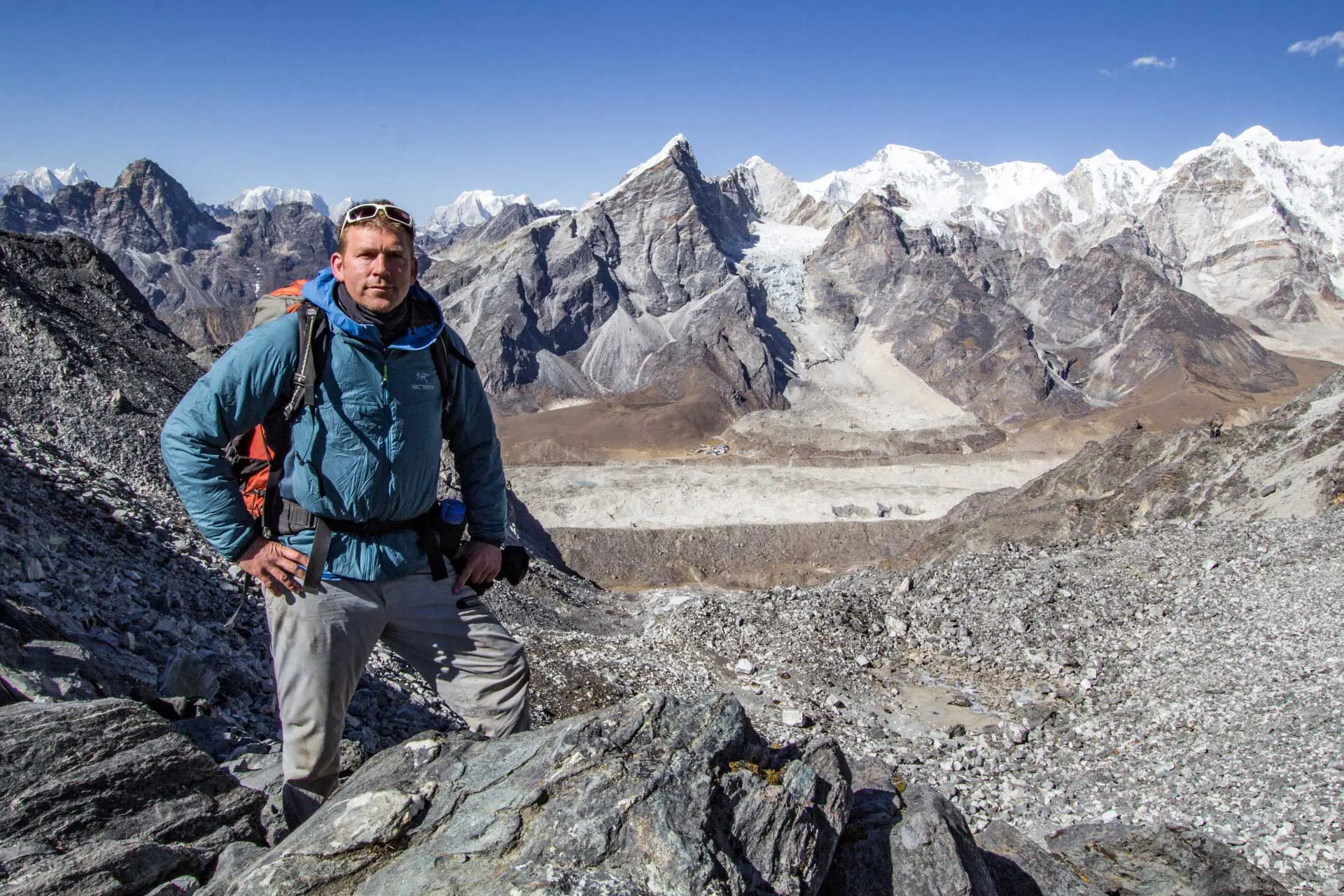
Guide to Nepal’s Three Passes Trek
The Three Passes Trek in Nepal is in the Everest Region (Sagarmatha National Park) and takes trekkers across three high passes, Kongma La (18,209 ft / 5,550 m), Cho La (17,782 ft / 5,420 m), and Renjo La (17,560 ft / 5,360 m) – hence, the Three Passes Trek. It’s a lollipop loop that can be done starting at Lukla (that scary mountain airport that you fly into) or further down the mountains at Jiri, Shivalaya, Salleri, or Phaplu (I recommend starting at Jiri if you have the time – it will also save you on having to buy plane tickets to/from Lukla).
If you’re only going to Nepal once in your life – as you should – and you’re intent on hiking (not doing a meditation retreat or growing dreads and hanging out in Pokhara), then you need to do the Three Passes Trek. And ideally, you need to hike in from Jiri. Fuck Everest Base Camp, fuck the Annapurna Circuit, fuck the Manaslu Circuit , and fuck Poon Hill. Three Passes Trek from Jiri. This is what you need to do. And if Everest Base Camp is really important to you, it can easily be done as a detour from the Three Passes Trek (normally this will add one day – if you’re slow, maybe two; if you’re fast, maybe none).
Are you required to have a guide for the Three Passes Trek? No. Do you need a guide for the Three Passes Trek? Not really (do not buy into all the fear-mongering in Kathmandu – these are just people trying to get you to hand over your rupees). Is hiking the Three Passes Trek expensive? No. Do you need to bring a tent, sleeping pad, or winter sleeping bag? No. Is it expensive to fly to Nepal? Usually, yes, but once you arrive, everything is cheap!
Three Passes Trek Facts
- (Unofficial) Capital: Namche Bazaar
- Language: Nepali
- Currency: Nepalese Rupee, NPR
- Time Zone: NPT (UTC+05:45)
- Calling Code: +977
- Drinking Age: 18
- Drinking In Public: Yes
- Drinking Tap Water: No
- Flushing Toilet Paper: No
- Vaccinations Required: CDC
- Credit Cards: Carry cash
- Tipping: Not expected
- Emergency Number: 100
- Outlets: Type C / D / M (230 V / 50 Hz)
- Visa Requirements: External Link!
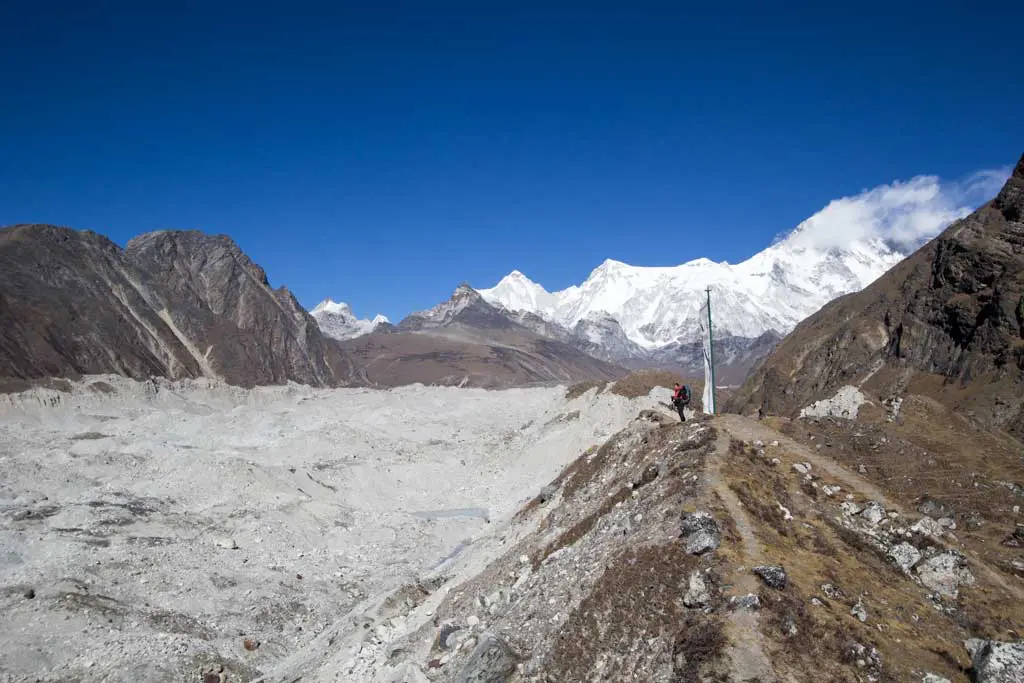
Three Passes Trek Basics
On the Three Passes Trek, almost everyone you meet will have some English language abilities (talk to the kids – they’re very interested in you), so don’t fret if your Nepalese or Hindi is rusty. The two words that you’ll need are namaste (hello) and dhanyabad (thank you). The Sherpa language, called Sherpa, is also spoken by some people. Sherpa is unwritten, which accounts for the various spellings of many of the villages (e.g. Dzonglha/Dzongla/Zonglha), so don’t worry if you’re confused by different spellings on your map versus the menu in your tea house versus your guidebook (which is probably too heavy to be carrying in the first place).
The route to the Three Passes Trek heads north into the mountains until Namche Bazaar. From here, hikers can choose to hike either clockwise or counterclockwise. Counterclockwise is the more common route and the one I recommend (particularly if it’s your first time at altitude). The Three Passes trek takes trekkers through four valleys in addition to the three passes, Kongma La (18,209 ft / 5,550 m), Cho La (17,782 ft / 5,420 m), and Renjo La (17,560 ft / 5,360 m). Kongma La is generally considered the most difficult (longest), Cho La requires you to cross a glacier (microspikes are helpful here), and Renjo La is commonly thought to be the easiest. Granted, this can all change depending on weather and conditions. For more on the Three Passes Trek route, check this post .
The tea houses (i.e. lodges) scattered throughout the villages along the Three Passes Trek are where you will (probably) stay each night (if you wanted to camp, you could, but it’s totally unnecessary and absolutely not required). During peak season, these can (apparently) get crowded. However, if you’re awesome and you go in the winter (more on this below), you shouldn’t have any trouble finding space in a lodge (as practically half of all the buildings in any given town are lodges). The tea houses usually cost between 100 and 400 rupees per night (~$1-$4) and have hot meals and beverages for purchase.
As much as you may imagine “trekking through the Himalayas” to be an exercise in solitude, this idea errs wildly on the side of “nope, sorry.” On the the Three Passes Trek, you will be constantly met with other trekkers, locals, pack animals, and, most exciting of all, villages. Depending on your route, you may pass through as many as five or six villages in a single day. They all (at least on the Three Passes Trek) have food, accommodation, and friendly mountain-dwellers to aid you on your way up into the mountains. If you go up alone and decide you need a guide, hiring someone from one of the villages to go with you on your trek will also be possible.
The most popular season for the Three Passes Trek is the same as Everest Base Camp, the fall (September to November). The second most popular season is spring (March to May), also the peak season for Everest climbers. The summer months are monsoon season in Nepal, so unless you are a huge fan of trekking through the rain with limited views, it’s probably best to avoid this time (unless you are willing to trade views for solitude – but maybe you’ll get lucky with the weather). Winter generally has limited crowds and great weather, but it is cold (I like the winter – more on this below).
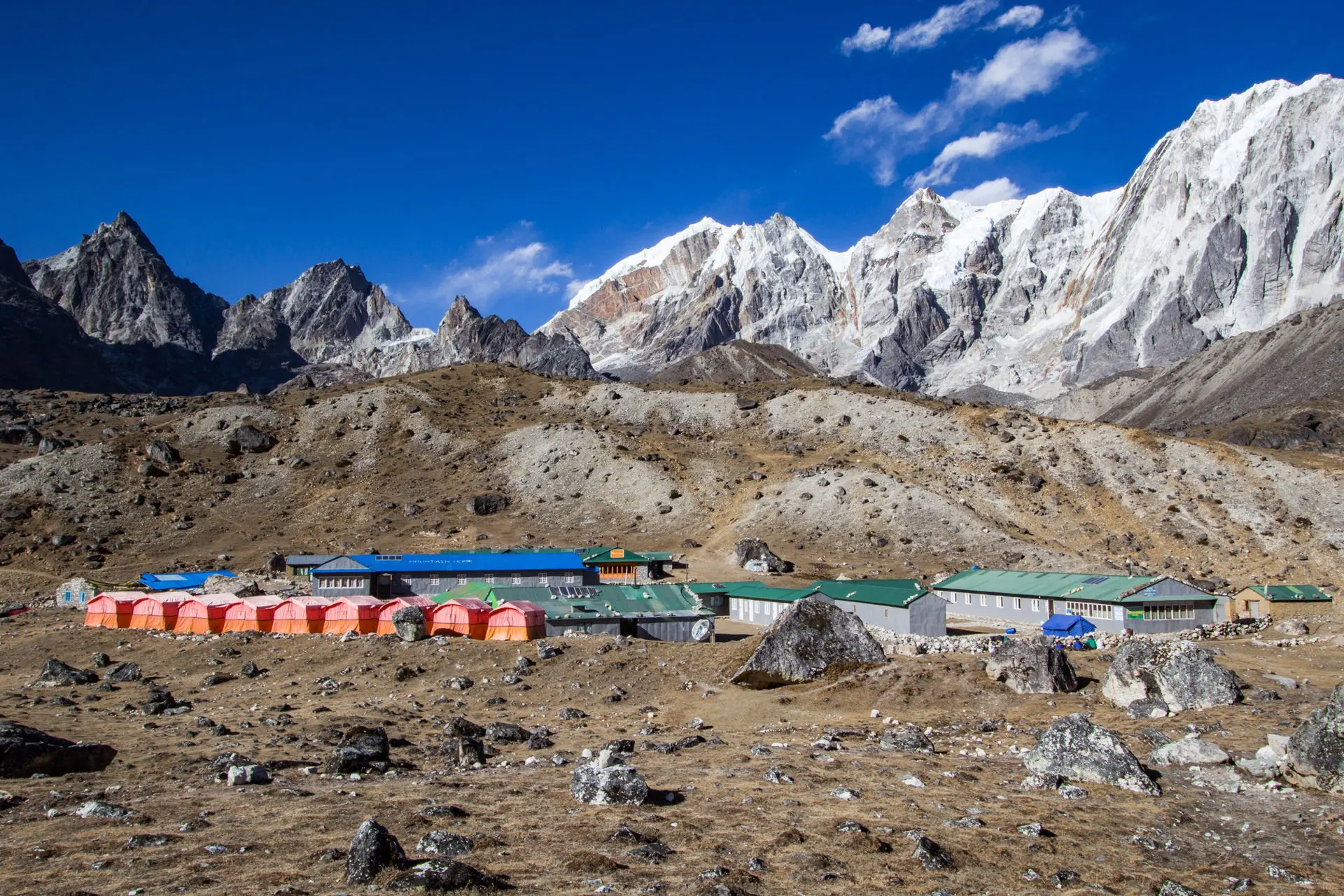
Three Passes Trek Route
The Three Passes Trek trail is very well-defined. The scale of the mountains makes navigation much different than what you would find in a heavily forested area. Most of the time, you walk up, down, or across a valley and have few options for where to go. It’s not like you will suddenly make a wrong turn left and accidentally go over a 23,000 ft / 7,000 m. You can get a paper map in Kathmandu for the region, which should help you with the big junctions (if you somehow find yourself alone and with no locals to ask for directions). For more on the Three Passes Trek route, check this post .
As stated above, the passes are Kongma La (18,209 ft / 5,550 m), Cho La (17,782 ft / 5,420 m), and Renjo La (17,560 ft / 5,360 m). Again, Kongma La is generally considered the most difficult (longest), Cho La requires you to cross a glacier (microspikes are helpful here), and Renjo La is commonly thought to be the easiest. Granted, this can all change depending on weather and conditions. It’s wise to get an early start on the days you plan to cross each pass to give yourself adequate time and avoid the afternoon weather (typically worse than what you wake up to).
Everest Base Camp
This is completely doable if you want to detour to Everest Base Camp and/or Kala Patthar. The first village west of Kongma La (the second village east of Cho La), you can make it to Everest Base Camp and back in a day (via Gorak Shep). If you also want to hike Kala Patthar, you could either do one huge day back to Lobuche or stay the night in Gorak Shep and do Kala Patthar the afternoon before your stay or the morning after. For more on Everest Base Camp, check this page .
Hiking from Jiri
Taking a bus or jeep to Jiri (or Shivalaya, one village ahead) and then hiking to Lukla (instead of flying to Lukla) is a challenging and rewarding section of the region that is not as heavily trafficked as the trail above Lukla (where most trekkers start). If you’re short on time, instead of starting from Jiri, you can save yourself a day or two and take a bus or jeep to Salleri or Phaplu, which puts you about two days close to Lukla from Jiri.
Turning Around
Every time I have been up in the Everest Region, there has been much fear-mongering about the passes. “The passes are closed, there is too much snow” or “The passes are closed because ‘I don’t know why I just heard somebody say that.'” Listen, friend, if you’re in Nepal to hike the Three Passes, go and hike the Three Passes. Go and see for yourself. Start early in the morning, and if the trail, pass, or the weather turns out to be too much, turn around. In absolute terms, the passes really aren’t that far from the nearest villages. Don’t be afraid to go and check out the conditions for yourself, but don’t be afraid to turn around if things look above your experience level.
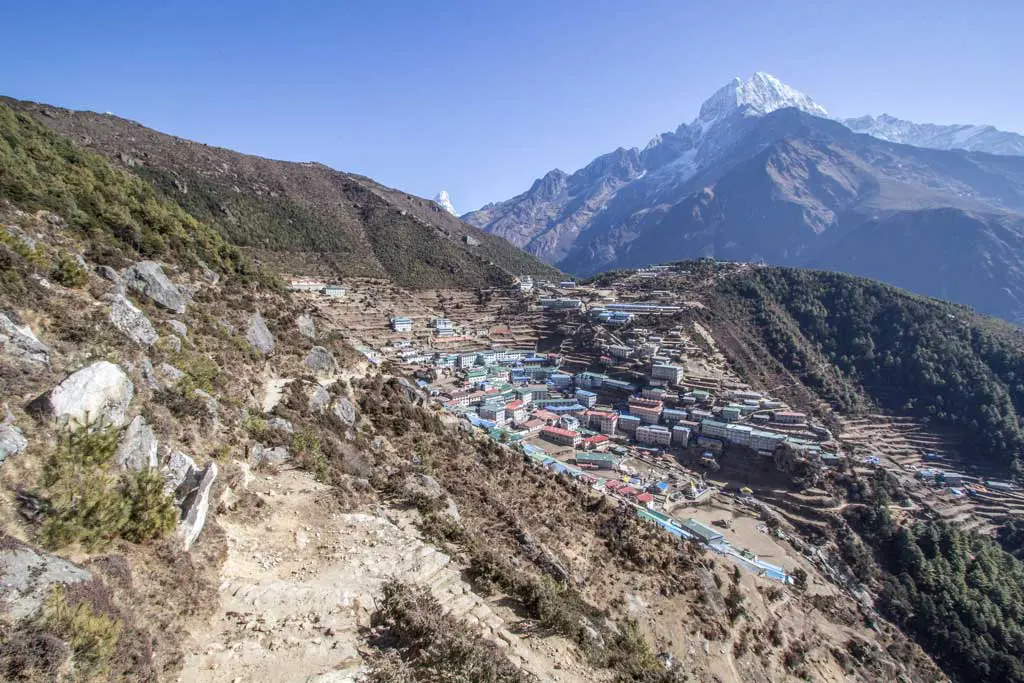
Three Passes Trek Food
Food on the way to Three Passes Trek is far more plentiful than you may imagine. Many lodges have many options, and you could easily eat something different every night (or be like me and stick to Dal Bhat, pizza, and momos). Check out this post for more on food on the Three Passes Trek.
Dal bhat is perhaps the most plentiful dish on the road to the Three Passes Trek and is certainly one that you should be eating to fuel your marathon mountain march. This traditional meal consists of rice, lentil soup (dal), and vegetables (and/or some meat if you’ve opted to eat animals on this trek). In addition to typically being one of the cheaper options on the menu, dal bhat also means refills. You get complimentary refills on your rice, lentil soup, and vegetables. It’s easy to see why this is what the guides and porters usually eat. Remember, “Dal Bhat power, twenty-four hours.”
There’s not a huge debate surrounding the quality of meat on the way up to Base Camp (that I’m aware of), but it’s something trekkers should consider. As much as I love eating roasted animals, I do not eat meat in the Himalayas. Do I have a scientific reason for this decision? No. It’s simply because I don’t know how many days in the sun each meaty meal spent on the back of a porter (and because the meat is generally more expensive). Also, since eating beef isn’t really a thing in Nepal, and since cows are my favorite animals (to eat), it’s not worth the risk.
As with meat, alcohol is something I avoid whilst hiking (upward) in the Himalayas. This is a personal decision, but drinking alcohol (especially in excess) can hinder your acclimatization efforts – and altitude sickness is not something to be taken lightly. A night of partying in Namche is not worth turning your Three Passes Trek adventure into an expensive (but probably awesome) helicopter ride back to Kathmandu.
So now that you’ve sworn off the bottle, it’s time to get serious about hydration. Water should be something you’re constantly ingesting on the Three Passes Trek. Chances are that your body will be in nonstop and desperate need of water to fend off the effects of altitude sickness, dehydration, and the possible fallout from your third helping of dal bhat last night. I bring a SteriPEN with me on my hikes in Nepal and purify water that I get from the tea house’s tap (you usually have to ask for this). Buying plastic water bottles contributes to the garbage problem in the mountains (and we all know plastic bottles are evil).
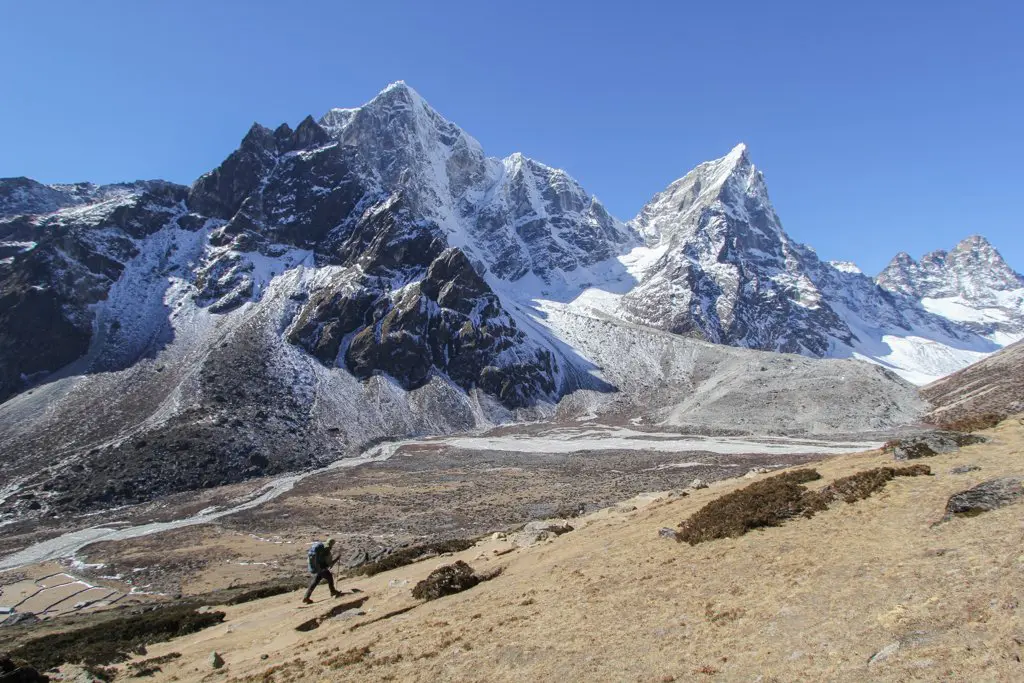
Three Passes Trek Tips & Tricks
Yes, “Winter in the Himalayas” may sound scary, but the truth is that it’s probably the best time to visit (this is based on my having been there twice in winter and once in spring). You may expect the Himalayas’ winter months to bring a ton of snow, but this is not the case. Most days, you can expect clear skies with very little precipitation. Just make sure to bring an extra base layer because it’s cold.
Yes, with the civilization in the Himalayas, you will also find wi-fi. Generally speaking, once you get above Namche Bazaar, getting free wi-fi will be difficult (if not impossible). Generally, you must buy cards from the lodges with passcodes to access the “EVEREST LINK” wi-fi network. These cards are sold in different denominations, the most expensive being 1,000 NPR (~$10 US) for 24 hours of use. These cards may not always be available, and lodges may not always sell them at face value. Also, many lodges turn off the electricity after a certain time (which means no more wi-fi), so be sure to ask beforehand. You will probably get a cell signal in many places if you have a SIM from Kathmandu (Ncell is what you want).
Lukla Flight
I highly recommend taking a bus to Jiri and beginning your hike from there, but if your time is limited, then a flight to Lukla may be your only option. The flight to Lukla is commonly referred to being “the most dangerous flight in the world”. This is largely because of its being placed on under-researched lists of random internet blogs (there have been three fatal accidents involving airplanes at the airport – the most recent of which was in 2010). Yes, the flight to Lukla is an adventure, but it’s certainly not a death sentence. The flight will cost around $150 each way – more on the flight here.
Yes, there are ATMs in the Everest Region. As of writing this, there’s one in Lukla and two in Namche Bazaar. None are guaranteed to work, so I would bring cash from Kathmandu to avoid headaches. Ninety-five percent of places do not accept cards. If the ATMs aren’t working, places in Lukla and Namche offer cash advances with a credit card. Some places in Namche Bazaar accept cards, but few places above Namche will take anything besides cash. Ensure you have enough money for the way up (and back down).
For more on the Three Passes Trek, visit my Three Passes Trek page .
Similar Posts

Trail Blazing To Kathmandu
I am finally underway and on a path that will hopefully lead me to Everest Base Camp. However, my second of two trains to Kansai…
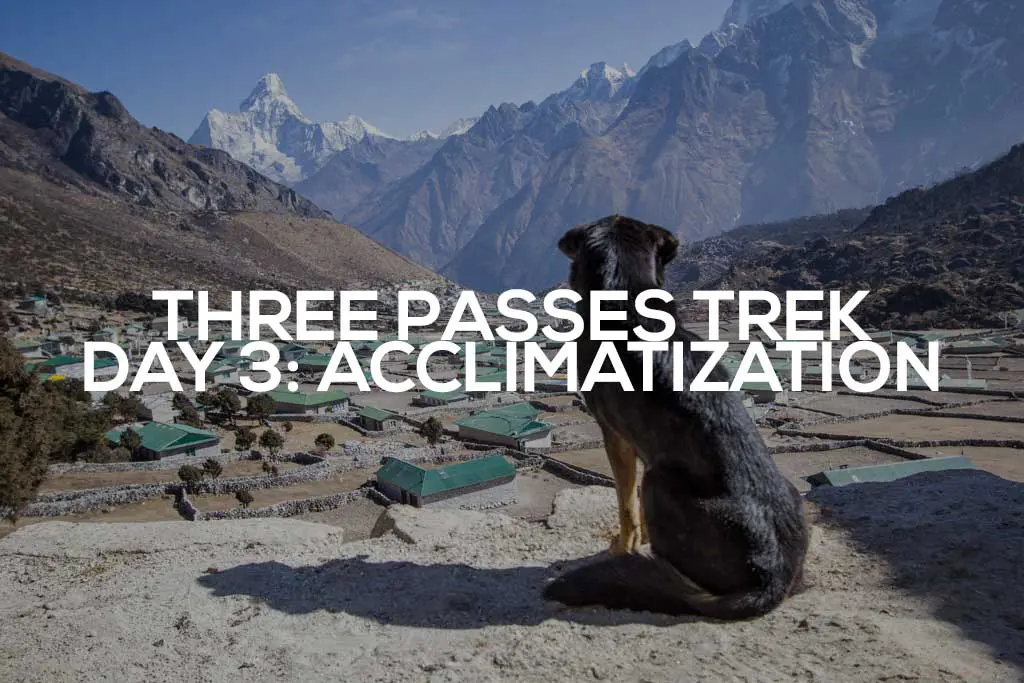

Three Passes Trek Day 3: Namche Acclimatization Loop
My alarm isn’t set to go off for another forty-five minutes, but my body appears to met its sleep quota for the night (something I…

The Annapurna Circuit in 54 Photos
The Annapurna Circuit is one of Nepal’s best-known and most-traveled treks. That said, it can be difficult to know what to expect on the circuit…

Off To Nepal (And Certain Death)
I have already presented “The Ultimate Everest Base Camp Plan” and my exhaustive “Everest Base Camp Gear List”, so now if (when) something goes wrong…
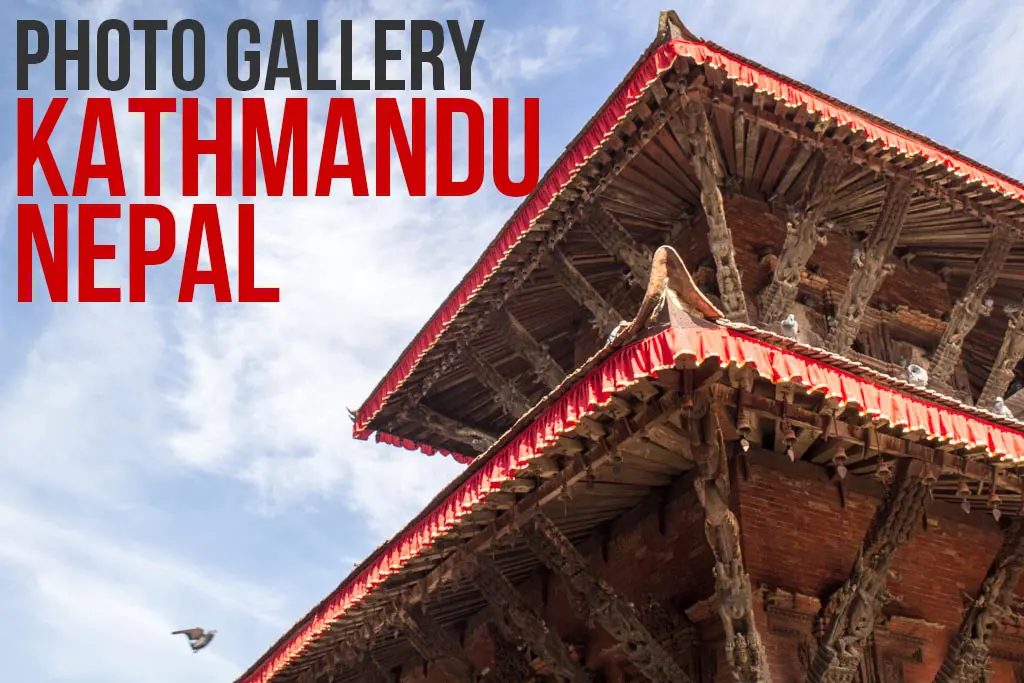
Photo Gallery: Kathmandu, Nepal
Most people find themselves in Nepal with the goal of trekking in the legendary Himalaya, but there’s a lot to see at the lower elevations…
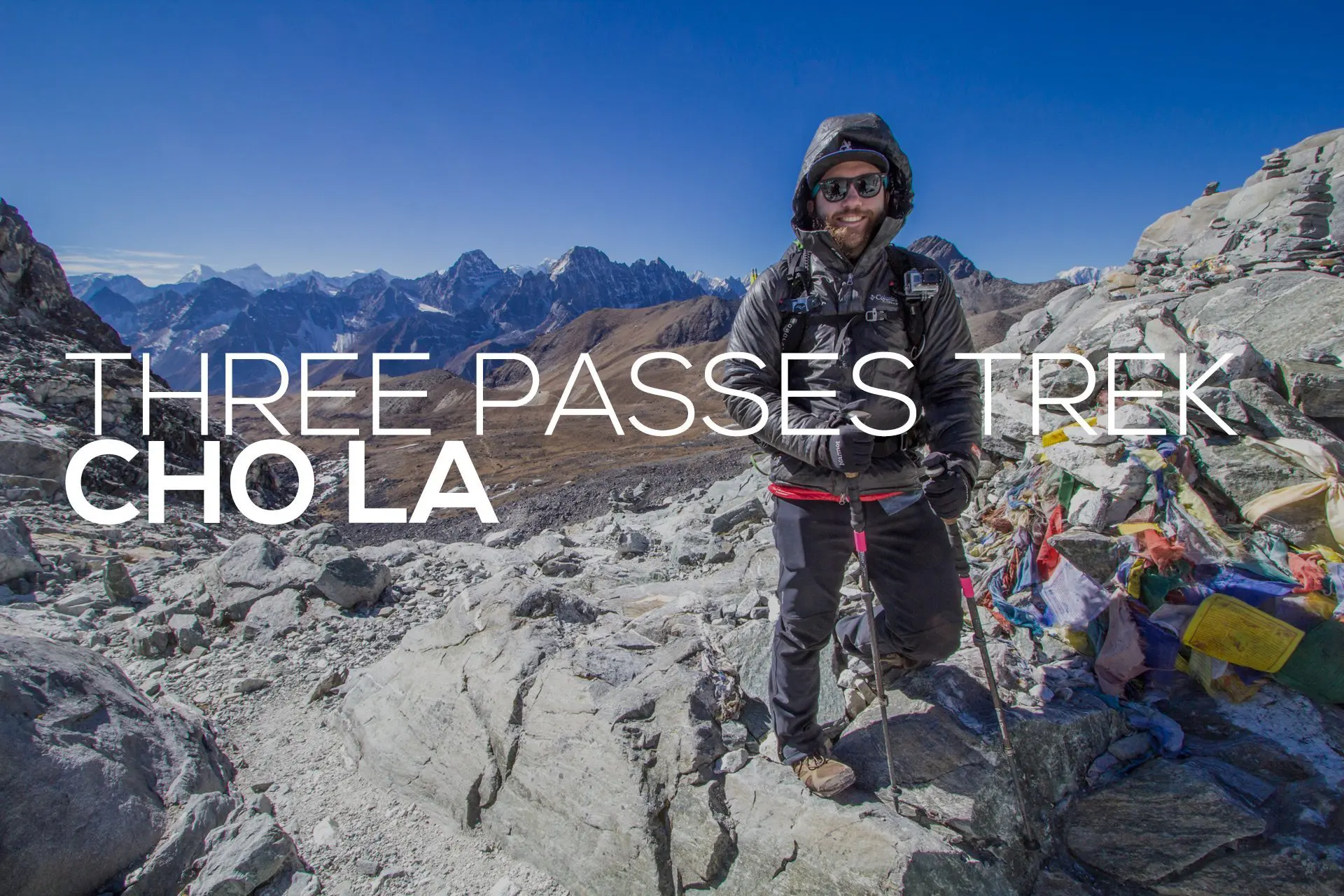
Nepal’s Three Passes Trek: Cho La
Cho La is the second pass of Nepal’s Three Passes Trek (regardless of which direction you are heading) and is probably the most frequently crossed…
44 Comments
Hello, starting Three Pass trail on May 25 from Salleri. Reading that I might need Ice Axes for some passes, is it true? Very experience hiker but I don’t do climbing.
It’s possible that conditions could warrant using ice axes and protection. This has never been the case when I’ve been there, but that doesn’t mean it’s impossible.
What a fantastic article on the Everest Three Passes trekking in the Everest region! It provides extensive information about the breathtaking natural landscapes, towering mountains, and vibrant Sherpa cultures.
Glad you enjoyed it!
Thank you very much for the great post
Thank you for reading!
Thanks for sharing such an amazing post, The Everest Region is the hub for adventure, and adventure people complete their passion for adventure in this province. Your blog helps people plan their trip at the right time and the pictures are awesome.
This is very informative. Thank you for taking time in sharing your experience. I have just decided to do it in March 2024 as a solo backpacker, without a guide or porter. In case anyone here is going in the same month I’m more than happy to buddy up instagram handle: ikaterox
Thanks for the great blog. I will be retuning to Everest region in March 20224 and am trying to figure out of I can take on the 3 passes as a solo trekker (no guide, no porter) as a reasonably fit 56 yo woman. The other option is to repeat the amazing trek I did when I was 29 yo from Jiri to Gokyo Ri. Ideally Id like to do something differeint thoigh and dealing witht he throngs of trekkers heading to EBC is not really my thing. I’m wondering aboit path finding – how clearly marked are the passes? Im aware that I can most likely buddy up on the passes or even hire a guide for them but would love your thoughts. THANK YOU!
The trails over the passes aren’t well-marked (although they’ve added more markers since I first did this hike as I saw when I went up Kongma La once more a few years later). The passes themselves are fairly well marked as they’ve been covered in prayer flags.
Thank you Mac! Thinking for me either take a guide or choose an easier better marked trail.
Hi! What an amazing and encouraging trip report! I have done a similar trek in Peru called the Ausangate circuit that went over 4 high altitude passes, but it only took me about 6 days. I have a question about meat eating, however. Did you find plain meats available in the villages at all? I eat a keto low carb diet due to autoimmune issues. I’m fat adapted, so I fuel off of animal fats + meats. I’m planning on bringing pemiccan bars and jerky. I’ve heard I might be able to find yak butter available. Do you know if I can find any dried meats to carry, even in Katmandu?
I avoided meat in the mountains although it was generally available. I am not sure about the availability of dehydrated meals in Kathmandu as I didn’t eat any of these myself. Honestly, if you have a restricted diet I would suggest bringing as much as you’re comfortable with from home.
Thanks so much. Ya, it’s pretty complicated for me because I can’t handle any nuts, grains and seeds in my diet. I’m really hoping I can find dried meats at the very least in Katmandu. I’m a full time nomad so carrying foods from “home” won’t really be possible for a longer trek in Nepal. Anyway, thanks again for this amazing report!
@crystal , Hi im a sherpa living and studying in new york to be a nurse. In our culture we have a dehydrated meat called “sukuti” . In the past sherpas didn’t have a way to keep meat edible and not rot. We didn’t have fridges back then and still we don’t really have them. Sukuti is a goat/lamb dried meat , thats really chewy and tasty in my opinion. you can do a google search on it. Most tea houses and homes in this area will have sukuti , but its usually reserved for their family . Not really sold . BUT I am sure if you ask kindly , they might sell it to you and I think some places sell it to tourists anyway.
Wonderful information! I’m here now getting ready for my first trek. I’ll look for some sukuti in Katmandu!
Hi there, my brothers and I will do the Three passes, starting late March this year. Do we need crampons during this trek because we have to cross a glacier? If so, how big is the distance we have to cover through this glacier? I’m in doubt if my hiking boots (Hanwag tatra II) are suitable in case we need crampons.
Thanks in advance!
I used microspikes to cross the glacier on the east side of Cho La. If in doubt, it’s best to bring some traction with you – worst case you don’t use it.
Thanks for the advise.
I’m going to hike the three passes loop starting from Jiri. I’m traveling solo and would love to meet others to hike with. I’m planning on starting early March 2023. Anyone interested in joining me? I’m female and would prefer to travel with women or a combo.
Hi — I am considering this trip and leaving in the next few days. Have you already arrived / have a group together?
I am leaving for Nepal on 3/20 so will start hiking from Jiri probably on 3/24. No group, going to start solo and hopefully meet up with friendly trekkers. What is your plan???
A complete guide for Everest 3 High Pass Trek. Thanks for sharing your experiences here. Keep on sharing and inspire other people to trek in the Himalayas.
It’s a beautiful place to trek!
Hi there, I am looking at tackling the Three passes trek solo this upcoming late Feb, early march. I have scoured the web and haven’t been able to find any beta on potential snow conditions. Any idea what I may encounter? I am okay with some post holing but I am just curious about avalanche hazards and snowbound conditions. Any insight would be greatly appreciated thanks 🙂
I’ve been up there in March and there was little snow. The mountains get most of their precipitation in the summer months while winter is typically the dryest When I was there I went up Kongma La and there was a bit of snow (it had snowed three days before I hiked), but it was completely manageable.
Thanks for your speedy reply! I really appreciate it. That is good to hear. Any other high pass trekking you would recommend as well?
Hey Mac, Thanks for all the information and great website. There is one thing that is not clear to me about this route. Do I take a satellite/gps device or not? Does gps navigation on phone (with downloaded offline maps in Komoot) will suffice? I have always navigated this way but since the Himalaya are new to me… Is it necessary to have satellite reception on the pass in case of emergency? Hope to hear from you! Best Funs
GPS navigation on a phone will function so long as you’re familiar with it; phone apps will work the same in the Himalayas as they do elsewhere so long as you have the maps downloaded for offline use. When you ask “satellite reception on the pass in case of emergency” are you talking about calling for help? If you need to call for help with a phone you will need (and not have) reception. It’s best to bring a PLB for times like this.
Nowadays we can see many people blogging without information but this article is really informative which is important for travelers.
That’s the goal!
I’m doing the three high passes in October this year! You definitely have the most detailed blog I’ve found. I’m just curious what you do with your toilet paper if you can’t flush it? Do you carry a garbage bag full of toilet paper around? Thank you!
Throw it away or pack it out (bring extra Ziplocs).
I still remember when we met at Tengboche while you were doing this trek. We had some beautiful conservation went on and you were so adventurous. I follow you on Facebook as well love to see your post on there too. And Keep posting such a piece of great information to everyone who wishes the adventure in Nepal.
I remember when we met, too – I can’t wait to make it back to Nepal!
As a trekking guide, i have done this Everest three-pass trek couple of times every time i go there i feel more energetic and fantastic. Reading this article now while staying in the home because of the coronavirus and no trekkers in Nepal for the trek recall all my walking experience in those places.
It’s an awesome post, and really useful to get the information of an Everest Three Passes Trek. Thank you so much for publishing such a nice article.
Thanks for the feedback!
Amazing Trip.
Highly recommended!
It is a great guide Mac. We have a similar 3-passes trek in Indian Himalayas.
I have yet to get there – what’s it called?
Auden’s Col – Mayali Pass – Patangini Dhar trek
I would love to know too. Waiting for reply. Thanks!
Leave a Reply Cancel reply
Your email address will not be published. Required fields are marked *

- Trekking In Nepal
- Mount Everest Trekking
Everest 3 Pass Trek with Island peak Climbing
Mount Everest Trekking , Trekking In Nepal
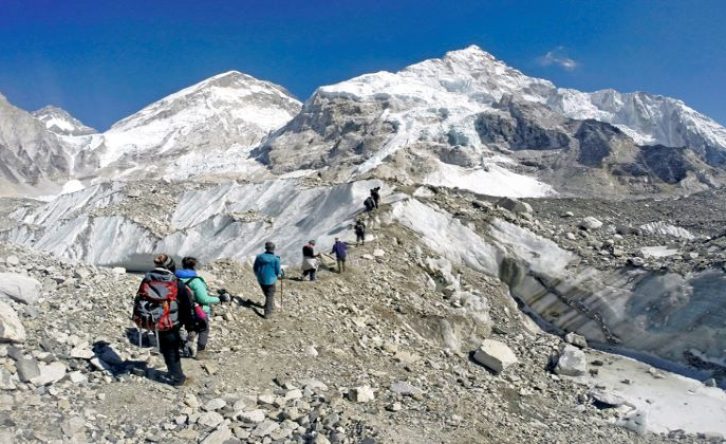
Group Discount Price
Number of Travellers
Trip Itinerary
Cost include / exclude.
Everest 3 Pass Trek with Island Peak Climbing is one of the most adventurous journeys in the Everest region. This trekking and climbing itinerary takes you to beautiful Gokyo lakes, the famous three high passes: Renjo La (5,360m) Kongma La (5,535m),(5,535m), Cho La (5,420m), and finally Summit the Island Peak (6,189m)
Our Everest 3-pass trek and Island Peak start with a scenic flight to Lukla from Kathmandu. We will follow the regular Everest Base Camp trek route by trekking to Phakding, and Namche, where you will acclimatize for a day. We will walk to Thame and Lumde before arriving at Gokyo via Renjo La pass from Namche. The scenic beauty of Gokyo lakes along the trail will enthrall you, and the entire Himalayan mountain vista will enchant you.
You will arrive at the Everest Base Camp , crossing Renjo La pass and Cho La Pass. We hike to the viewpoint of Kala Patthar (5,545m) to observe the full 360-degree view of the world’s highest mountains. Such Mountains are Mt. Everest, Ama Dablam, Makalu, Lhotse, Nuptse, and others.
We continue our Everest three Pass trek with an Island Peak climbing journey descending to Lobuche and Chukung via Kongma La.
After some training, we climb the famous Island peak from its base camp and descend back to Pangboche. From there, we make our way to Namche Bazar and Lukla, where our trek stops. Finally, we take an adventurous flight back to Kathmandu from where you can board a flight to your desired destination.
Highlights of the Trip
- Breathtaking Himalayan sunrise from various viewpoints along the trail
- 360 degree panoramic views of snow capped mountains including Mt. Everest, Ama Dablam, Lhotse, Nuptse, Makalu and others
- Crossing highest mountain passes including Kongma La (5,535m), Cho La (5,420m), and Renjo La (5,360m)
- Experiencing the beautiful Gokyo lakes and climbing Gokyo Ri
- Climbing the famous Island Peak (6,189m)
- Opportunity to explore culture, tradition, and lifestyle of Sherpa community
- Warm hospitality of local people and tasting delicious cuisine
The Best Time for the Everest Three Pass Trek and Island Peak Climb?
The ideal time for the Everest Three Pass Trek and Island Peak climb is the months of Autumn and Spring. These seasons are known for their stable weather conditions, modest temperatures, and favorable climate.
Autumn (September-November) provides you with ideal trekking conditions and moderate temperatures. Clear blue skies and fantastic mountain views are the prime attractions of the trek in Autumn. Besides, many festivals also fall in this season making it a great time for cultural expiration along the trails.
Spring (March-May) is another excellent time for this exciting trek. Trekkers will walk along the beautiful landscapes and scenic environments. Wildflowers bloom all over the hills in Spring making the trails colorful and pleasant. Active wildlife and green vegetation are highlights of trek in Spring season.
How Difficult is the Everest Three Pass Trek and Island Peak Climb?
The Everest Three Pass Trek and Island Peak Climb is one of the most challenging treks in Nepal. It is a long duration and high altitude trek that involves peak climbing. Trekkers need to walk for long hours and climb steeply along the rugged trails. Crossing the three mountains passes will test any trekker to their core.
Altitude sickness is another big difficulty for trekkers. One should acclimatize well and hydrate properly during this trek. A good training regime before the start of the trek is also essential. Previous hiking experience is always an advantage.
Besides that, unpredictable weather can also make your trekking difficult. A basic level of fitness, proper preparation, and positive attitude will help you complete your journey with ease. Overall, the Everest Three Pass Trek and Island Peak Climbing is moderate to extreme in terms of difficulty.
Arrival in Kathmandu. Transfer to hotel. Evening Dinner.
Airport transfer, 3 Star Hotel
Take morning flight from Kathmandu to Lukla (2,830 m.) and trek to Phakding (2,640 m., 4-hour trek).
Lukla flight ticket, Guide, porter, meals and Accommodation
Trek from Phakding to Namche Bazaar (3,440 m., 5-hour trek).
Guide, porter, meals and Accommodation
Rest day at Namche Bazaar for acclimatization and excursion.
Trek from namche bazaar to thame (3740 m., 6-hour trek)., trek from thame to lumde (4,370 m., 4-hour trek)., trek from lumde to gokyo via renjo la pass (4,800 m., 7-hour trek)., acclimation day in gokyo valley. hike to gokyo ri (5, 357 m.), trek from gokyo valley to thangna (4,700 m., 4-hour trek), trek from thagna to chola pass (5,330 m.) and trek to lobuche (4,930 m., 7-hour trek), trek from lobuche to gorakshep- visit everest base camp ( 5,354m) and overnight goraksheph (5,170 m, 8-hour trek), hike to kalapather (5545m, and trek to lobuche {4,930 m., 6-hour trek, trek from lobuche to chukung via kongmo la pass (4,700 m., 7-hour trek)., trek to island peak base camp and pre- climb training (5190 m., 6-hour trek).
Guide, meals and tented Camp Accommodation
Island peak Base Camp To Summit Island peak (6189m) and Back to Base camp (5190m)
Guide, meals and Accommodation
Trek from Island peak Base Camp to Pangboche (3980m) 5 Hour
Trek back to namche, 5 hour, trek from namche bazaar to lukla (2,800 m., 6-hours), take flight back to kathmandu.
Guide, Breakfast, Kathmandu flight and Hotel
Free day, in case of flight cancellation from Lukla
Breakfast and Hotel
Transfer to the airport and departure from Nepal
Airport transfer, Breakfast
Include/Exclude
What’s included.
- Airport Transfer (Airport- Hotel – Airport) .
- Hotel in Kathmandu :-3 nights hotel in Kathmandu, Including breakfast.
- Meals : Daily 3 Meals During The Trekking (Breakfast, Lunch and Dinner)
- Drinks : Tea / Coffee
- All Trekking permit , TIMS Card and all necessary paper works.
- Domestic flight Ticket from Kathmandu to Lukla and return Kathmandu.
- All accommodations With Good lodges/tea houses during trekking.
- Trekking Guide: An experienced, helpful, friendly, and English speaking trekking guide (including his well-paid salary, insurance, meals, drinks, accommodation, transportation, flight, etc.)
- Trekking Porter: A strong Sherpa porter to carry your backpack.
- Climbing Guide and His Insurance, equipment , Food etc.
- Climbing Permit
- Arrangement of Emergency Helicopter service which will be paid by your Travel insurance company.
- Adventure Certificate and Trekking map.
- Company T-shirt
- Medical supplies (first aid kit will be available).
- All Government Taxes and Service Charge.
What’s excluded
- International Airfare and Nepal entry visa fee
- Travel Insurance
- Lunch, Dinner in Kathmandu.
- personal expenses (phone call, laundry service, battery recharge, bottle of water, hot water, hot/cold shower etc.)
- Tips for guide and porter.
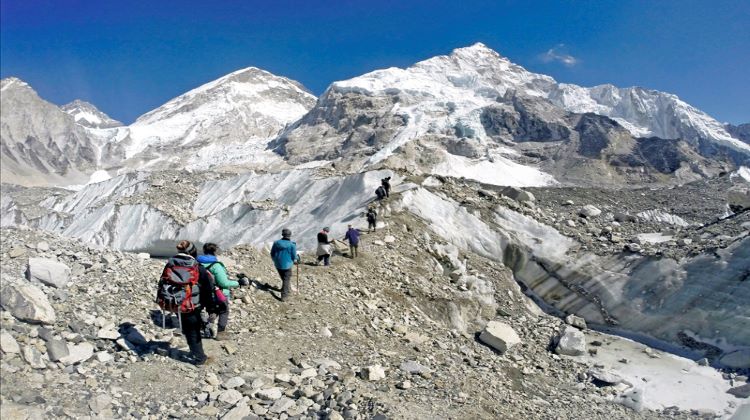
Write a Review
Enquiry form.
Note: Please ensure names must be exactly the same as your passport (for ticketing/security purposes). You could incur extra costs or even miss your flight if the names are not correct.
Interested Program: *
Full Name: *
Email Address: *
Contact Number: *
Afghanistan Albania Algeria Andorra Angola Antigua and Barbuda Argentina Armenia Australia Austria Azerbaijan Bahamas Bahrain Bangladesh Barbados Belarus Belgium Belize Benin Bhutan Bolivia Bosnia and Herzegovina Botswana Brazil Brunei Bulgaria Burkina Faso Burundi Cabo Verde Cambodia Cameroon Canada Central African Republic (CAR) Chad Chile China Colombia Comoros Democratic Republic of the Congo Republic of the Congo Costa Rica Cote d'Ivoire Croatia Cuba Cyprus Czech Republic Denmark Djibouti Dominica Dominican Republic Ecuador Egypt El Salvador Equatorial Guinea Eritrea Estonia Ethiopia Fiji Finland France Gabon Gambia Georgia Germany Ghana Greece Grenada Guatemala Guinea Guinea-Bissau Guyana Haiti Honduras Hungary Iceland India Indonesia Iran Iraq Ireland Israel Italy Jamaica Japan Jordan Kazakhstan Kenya Kiribati Kosovo Kuwait Kyrgyzstan Laos Latvia Lebanon Lesotho Liberia Libya Liechtenstein Lithuania Luxembourg Macedonia Madagascar Malawi Malaysia Maldives Mali Malta Marshall Islands Mauritania Mauritius Mexico Micronesia Moldova Monaco Mongolia Montenegro Morocco Mozambique Myanmar (Burma) Namibia Nauru Nepal Netherlands New Zealand Nicaragua Niger Nigeria North Korea Norway Oman Pakistan Palau Palestine Panama Papua New Guinea Paraguay Peru Philippines Poland Portugal Qatar Romania Russia Rwanda Saint Kitts and Nevis Saint Lucia Saint Vincent and the Grenadines Samoa San Marino Sao Tome and Principe Saudi Arabia Senegal Serbia Seychelles Sierra Leone Singapore Slovakia Slovenia Solomon Islands Somalia South Africa South Korea South Sudan Spain Sri Lanka Sudan Suriname Swaziland Sweden Switzerland Syria Taiwan Tajikistan Tanzania Thailand Timor-Leste Togo Tonga Trinidad and Tobago Tunisia Turkey Turkmenistan Tuvalu Uganda Ukraine United Arab Emirates (UAE) United Kingdom (UK) United States of America (USA) Uruguay Uzbekistan Vanuatu Vatican City (Holy See) Venezuela Vietnam Yemen Zambia Zimbabwe
Number of People: *
SHARE THIS TRIP
Customer's reviews.
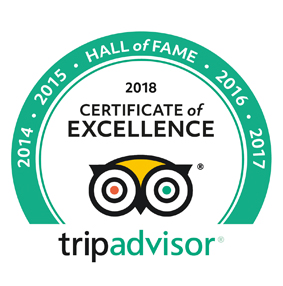
Adventure Great Himalaya Pvt. Ltd. (Private day tours)
Why booking with us ?
- Fully Locally Owned Company
- Quality Of Service and Competitive price
- Highly Professional Staff
- Flexible and customization trip itinerary
- 100% Customer satisfaction
24 hour customer service

Details of Everest Three Passes Trek Map And Itinerary
- Last Updated on Dec 2, 2023
We at Mountain Rock Treks provide you with the best and most interactive maps and itineraries for the Everest Three Passes trek of the Everest region. Our Updated Everest three passes trek map and itinerary provides all the trekkable routes in the Khumbu region.
Our Everest three passes trek map offers all the new updated routes. Likewise, we have uploaded the map in its original and high quality, where the trekkers can experience an exact print copy of the Everest three passes geographic map online. Our map beautifully demonstrates the various trails and landmarks. Also, there is a feature of zooming in and out to discover the places and highlights you have been searching for in the Everest Three Passes trek.
Therefore learn more about the Everest Three Passes Trek Map and Itinerary.
Table of Contents

Everest Three Pass Trek | Booking Cost for 2024-2025
Understanding everest three passes trek map.
Talking about the Everest Three Passes trek is one of the most recognized treks close to the world, tales mountain- Everest. Many trekkers venture to the Everest region after a short flight from Kathmandu to Lukla to make a circuit trek successful. If you are considering completing the Everest three passes trek, remember to carry your Everest three passes trek map and itinerary with you provided by Mountain Rock Treks.
It is a modern ear, and technological gadgets are a must to make your trek in any place more hassle-free. Similarly, these technological gadgets are helpful, as you can learn and plan the route you will be taking in advance, allowing you to complete your trek more easily and quickly. However, one example of such technical gadgets is Handheld GPS, which has taken over the market recently.
However, the electronic device can fail, so to prevent you from being stuck, you can always carry a paper Everest three passes trek map and a compass or backup from Mountain Rock Treks. In fact, we, too, provide our guests with one full piece of ma before trekking to Everest three passes trek.
Everest is the tallest peak in the world, with its peak rising above 8,848.86 m (29,031 ft). and trekking to its base camp or around means trekking to the famous area, which is visited by almost thousands of travelers every year.
The trek through Everet's three passes gives you breathtaking views of the famous peaks rising above 8000m, 7000m, and 6000 m. Likewise, it also means trekking through the multiple Sherpa villages in g with the multiple landscapes and diversity of flora and fauna of Sagarmatha National Park. In simple words, Everest three passes is a trek to the area of Mt. Everest. Using our trek to Everest does not rise in its glory alone. There will be several peaks like Makalu (8,516m), Lhotse (8,516m), and Ama Dablam (6,812m) to accompany you as you second higher with the help of our Everest three passes trek map itinerary.
The trail of this trek is somewhat tricky as you need to pass through three high passes of the Everest region: Cho La Pass, Renjo la Pass, and Kongma La Pass. So if you are just a beginner in trekking, do some serious physical endurance training and more.
In addition, there are many routes for Everet's three passes to choose from. With this in mind, you can not opt to take on a regular Everest three passes trek and pick different starting points and ending points for this trekking. Therefore Mountain Rock Treks Everest's three passes trekking route and itinerary help you to decide about the track, which is very consuming and equally adventurous, so you do feel guilty about not taking the conventional route of Everest three passes trek.
With the help of this map, you can learn about the distance, altitude, places, etc., which is an essential piece of information. Following this map, many people have finished their trek quickly.
Our Everest three passes trek map and itinerary are carefully planned for trekkers. It provides information about altitude, distance, and various places (famous and remote). Everest’s three maps and itinerary have guided trekkers around the Everest region.
Everest Three Passes Trek Summary
Everest Three passes trek which officially takes place in the Everest region and contains some of the major attractions to visit, like Renjola Pass, Gokyo Lake, Khong Ma la Pass, Chola Pass, Everest Base Camp, Kala Patthar, and More. Therefore with our three passes trek maps and itinerary, you will take the same route as the standard Everest base camp trek but with many bonuses.
Everest three-pass trek map guides you to the remote and off-the-beaten path, which only 5-10% of the 60,000 EBC trekkers have followed.
The Everest Three Passes trek's standard starting point is the same as the Everest base camp trek , which you can see below on the map. Trekkers will first take a 35-45 minute flight to Lukla referred, the most dangerous airport in the world. The treks now start after you land in Lukla. Lukla airport is colored a most dangerous one probably because of its weather, altitude, size, and location.
Trekkers can choose from many route options as the trek lies within the Everest region's off-beaten paths. But trekkers should be considerate and choose the trails to reduce the risks of high altitude sickness gradually. If you choose the clockwise route from the Namche Bazaar to Thame, you will reach your first high pass in two or three days. This route has both advantages and disadvantages. The disadvantage because this could be risky as the highest pass is located above the 5000m elevation here, and the advantage is it's the perfect route if you want to avoid overcrowding.
If you go with the Everest Three Passes Trek clockwise, the route will include at least one acclimatization day in Mirlung. This will increase your trek success ratio without causing any sickness issues.
Clockwise Everest three passes trek is a fast way to complete the trek, but we at Mountain Rock Trek offer you the counter-clockwise route, which is far better than the clockwise route. This being said, you will follow the Everest three-passes trek map that takes you along the EBC trail up to Dingboche . You take another route from Dingboche to your first high pass, called Kong Ma La Pass, at 18,209 ft / 5,550 m. This route map is better for proper acclimatization before hiking through high passes. The only disadvantage is that trekkers may have to deal with overcrowding for the first few weeks.
Everest Three Passes Trek Map Explanation
Our Everest three passes trek map is an updated and high-quality map that will accurately describe the Everest three-pass trekking route in the Everest region. Trekkers have many options, from the starting point to the ending point.
For example, instead of taking a direct flight to Lukla from Kathmandu, you can travel by land from Phaplu or Jiri and then to Lukla for a more gradual ascend. Many options like this may confuse you, so we provide You with Mountain Rock Treks' detailed Map below, which will help you choose the best route, clockwise or anti-clockwise, for Everest three passes trek.
What is included in the Everest Three Passes Trek map?
Our Everest three-pass trek map shown above is the exact digital copy of the print version. With the coordination of the experiment, map developer Mountain Rock Treks has brought this Map online to provide its trekkers with the best experience during their Everest hike.
Our Everest three passes trek map is well-designed and presents both the physical features and terrains of the Everest region and the three passes. Our Map also shows the highest and lowest elevations, along with the. Moreover, you can also see many colorful symbols representing mountains, trails, driving trails, waterfalls, glaciers, roads, etc.
Our Everest three passes trek map includes:
- A comprehensive list of local villages is in blue, along with their respective elevations.
- The simple symbol represents the detailed mapping of all flights you will take.
- Identification of panoramic viewpoints along hiking trails, marked in numbers ensured in yellow circles.
- Collection of mountain names in the Everest region, along with their elevations, denoted by the mountain's symbol.
- Identification of temples.
- Provision of a map indicating alternative side trips apart from the classical route represented by a blue dotted line.
- A red flag represents the list of all high passes within the Everest region.
- Our map also shows the avalanche area denoted by the white mountain encircled in the blue circle.
Note: This representation of the Everest Three Passes trek Map allows you to zoom in and out for convenience. Just right-click on our map to enlarge it.
Everest Three Passes Trek Outline Itinerary
Day 1: arriving in kathmandu.
- Kathmandu Elevation- (1,400m / 4,593ft)
- Airport to Thamel Driving Time- 20/30 minutes
- Accommodation- Hotels
Day 2: Fly Kathmandu-Lukla and Trek-Phakding
- Lukla Elevation-(2,850m / 9,350ft)
- Phakding Elevation- (2650m / 8562ft)
- Flight Hours- 40 Minutes
- Trek Distance- 6.2km / 3.8miles
- Trekking Hours- hours
- Accommodation- Tea Houses
Day 3: Trek Phakding-Monjo and Namche Bazaar
- Monjo Elevation- (2,835 m/9,301 ft)
- Namche Bazaar- (3,440m / 11,285ft)
- Trek Distance- 7.4km / 4.6miles
- Trek Hours- 6 hrs
Day 4:Acclimatization Day
Day 5: Trek Namche Bazaar - Tengboche
- Tengboche Elevation- 3,870m/12,697ft
- Trek Hours- 5/6 hrs
Day 6: Trek Tengboche-Dingboche
- Dingboche Elevation- 4,360m/14,305ft
Day 7: Trek Dingboche- Chukung
- Chukung Elevation- 4,730 m/15,518 ft
- Trek Hours- 4 hrs
Day 8: Trek Chhukung to Kongmo la pass - Lobuche
- Kongmo la pass Elevation- 5,550 m/ 8,209 ft
- Lobuche Elevation- 4,940 m (16,210 ft)
- Trek Hours- 7-8 hrs
Day 9: Trek Lobuche - Gorakhshep
- Gorakhshep Elevation- (5,164 m/16,942 ft)
Day 10: Trek Gorekhshep-Kalapathar-Dzongla
- Kalapathar Elevation- (5,644.5 m/18,519 ft)
- Dzongla Elevation- (15,846 ft / 4,830 m)
Day 11: Trek Zongla-Chola pass and to Thagnak
- Cho la pass Elevation- (5,420m/ 17,782 ft)
- Thagnak Elevation-4700 m/ 15419 ft
- Trek Hours- 3/5 hrs
Day 12: Trek Thagnak to Gokyo
- Gokyo Elevation- (4,750 m/ 15,583 ft)
Day 13: Rest day
Day 14: trek gokyo to renjo la pass- marlung.
- Renjo la pass Elevation- (5,360 m / 17,560 ft)
- Marlung Elevation- (4,210m/ 13812 ft)
- Trek Hours- 8/9 hrs
- Trekking Distance- 9.5 km / 5.6 mi
Day 15: Trek Marlung to Thame-Namche Bazaar
- Namche Bazaar Elevation- (3,440 m / 11,286 ft)
- Thame Elevation- (3820 m/12,533 ft)
- Trek Hours- 7/8 hrs
Day 16: Namche-Phakding-Lukla
- Trekking Distance- 17.6 km / 10.7 mi
Day 17: Fly Back to Kathmandu
Day 18: final, departure or onward for the next program, details itinerary of everest three passes trek.
Today, we will pick you up from Tribhuvan International Airport and transport you to your hotel in Thamel, a bustling and lively district of Kathmandu. The journey from the airport to the hotel takes approximately twenty minutes or thirty.
Once you are all settled in and want to explore Kathmandu and Thamel, we can help you. The central lanes of Thamel are exclusively designated for pedestrians, creating a perfect environment for leisurely exploration, especially at night.
Day 2: Fly Kathmandu-Lukla and Trek-Phakding
Your official journey begins today with a short flight to Lukla, about 35-45 minutes. After landing at Lukla, we trek toward the Phakding past Chaurikharka village.
Today will be a short trek, which also helps in acclimatization. Overnight will be at one of the teahouses in the Phakding. During your leisure time here, feel free to venture out and discover the attractions in and around Phakding. Phakding lies in the lower elevation; you still enjoy the facilities like shops, hotels, swimming pools, and restaurants. Moreover, there are also famous local monasteries around here. Among them, the one not to miss is the monastery named Rimishung Monastery.
Today's trek will be harder than yesterday's and will take us up the Dudh Kosi Valley. Along the way, we will encounter the enchanting Toktok Waterfall near the park's entrance, providing an ideal spot for a brief rest.
As we trek, one of the most exciting aspects of today's journey will be many bridges that span the river, creating a fascinating crisscross pattern. Also, these suspension bridges are adorned with vibrant prayer flags and often tower high above the rushing waters. The Edmund Hillary Suspension Bridge is the main highlight, towering 125 meters (410 feet) above the river and stretching 140 meters (459 feet). We will reach Namche Bazaar shortly after crossing the bridge and stay the night there.
Day 4: Acclimatization Day
Today just enjoy your rest day at Namche Bazaar. Acclimatization at Namche Bazaar allows your body to acclimate to the increased altitude. However, there are numerous activities you can opt for, such as exploring the Sherpa Museum or the nearby monastery. Additionally, you can go on a short day hike to the Everest View Hotel, where you can relish a refreshing beverage and indulge in a delightful snack. Or you can watch Everest and enjoy the day at Namche Bazar.
After a whole day at Namche Bazaar, you will trek towards Tengboche (a village near Pheriche Valley). We will gradually reach the northeast following a smooth and level contour path. Eventually, the trail today will lead us down to the valley floor before ascending to Tengboche.
As we reach the Tengboche mountain peak, rising above the clouds like Tawache, Everest, Nuptse, Lhotse, Ama Dablam, and Thamserku will greet us. We will also visit Tengboche monastery, the largest one in the Khumbu region. This monastery is surely worth visiting due to its 20-foot Buddha sculpture. Likewise, you also get to learn about detailed wall hangings, Buddhist culture, and more. We will stay the night at Tengboche.
Leaving Tengboche, we will ascend to the Imja Khola valley passing through the woods and views of peaks rising above 700m and 8000m in front of us. After trekking for around three kilometers from Tengboche, we will pass by Pangboche (3,985 m), the highest year-round settlement.
Just before reaching Dingboche, there is a separation in the road. Those following the traditional EBC trek continue on the left path, leading to the village of Pheriche. However, we take the right path and cross a bridge, followed by a challenging ascent to Dingboche. We will spend the night in one of the tea houses. The surrounding Dingboche is beautiful, with mountain peaks like Kangtega, Cho Oyu, Ama Dablam, and Taboche.
Today, we will take on a less challenging journey, following a gentle slope along the Imja Khola valley floor towards the village of Chhukung (or Chukhung). This section of Sagarmatha National Park is notably peaceful, resulting in a less crowded trail than the route leading up to Tengboche.
Along the way, we will pass by fields enclosed by stone walls and eventually venture into the moraine area before reaching Chhukung.
Chhukung, originally established as a village of teahouses (lodges), serves as a convenient stopover for trekkers en route to Kongma La and climbers aiming to reach the peak of the Island Peak.
Day 8: Trek Chhukung to Kongma la pass - Lobuche
Today we will hike through our first high passes called Kongma La. Also, it surpasses the elevation of Everest Base Camp. Kongma La pass lies more easternmost and is the highest among the three passes and Everest base camp.
Considering these challenges , today calls for unwavering focus, crampons, and trekking poles, as a significant portion of the route is rugged and uneven. However, there are also stretches of the trail that are remarkably smooth during the ascent.
Upon reaching the summit, a feast for the eyes unfolds with awe-inspiring vistas for trekkers to the east and west. These panoramas make the difficult climb entirely worthwhile. Thus, proceeding slowly and at one's own pace is crucial. There is no need to rush.
As we are ned of the high pass, e ill pass the Khumbu Glacier, the same glacier that flanks Everest. Also, it is the largest glacier in Nepal. After crossing the Khumbu Glacier, we will reach Lobuche, where we will also spend the night.
Day 9: Trek Lobuche - Gorak Shep
Gorakshep lies ahead, trail winds through Khumbu Glacier's lateral moraine. Passing the pyramid signpost, we glimpse Everest's north ridge, Pumori, Mahalangur, Lingtern, Khumbutse, and Nuptse. Likewise, ThangmaRiju unveils a 360-degree vista of snow-clad peaks.
A top Changri glacier, Kala Patthar, reveals beneath Pumori's green knoll. Gorakshep offers a view of snow-capped mountains, including Everest. The trail leads to Everest base camp via Gorakshep Lake, Indian army memorials. At base camp, we will witness treacherous Khumbu icefall, Nuptse, and Khumbutse dominating colorful mountaineers' tents.
Kala Patthar tops everyone's list as it provides a breathtaking view of Everest. Today, we will head north for the climb. It's not too difficult, but the altitude makes it tiring for us to move.
After capturing Everest's beauty and other peaks, like Lhotse and Makalu, from Kala Patthar, we return south via the traditional Everest Base Camp trail. Passing through Lobuche, we will divert west near the Imja Khola River, heading to Dzongla village. The path to Dzongla is clear, offering incredible mountain vistas. Peaks like Arakam Tse, Cholatse, Taboche, and Chola Tsho Lake greet us.
Today we will go for our second high pass, Cho La, at 5,420 m / 17,782 ft and 5,420 m / 17,782 ft. Crossing Cho La Glacier during the ascent makes this pass quite challenging. But, reaching the summit grants us breathtaking panoramas in both the eastern and western directions, where many peaks surround us. On the way down, the descent proves to be even steeper than the ascent, so we need to be more careful during this section.
Once we successfully conquer the pass, our trek takes us through the picturesque village of Thangnak, which is nestled close to the base of the pass. This remote and stunning portion of Sagarmatha National Park remains hidden from the view of many.
Our third high pass is still uncrossed, so we will leave Thangnak early in the morning and hike toward Gokyo. Gokyo is a small village that proudly resides in the majestic presence of Mt Cho Oyu (8,150 m / 26,739 ft), famed as the sixth-highest mountain.
Ngozumpa Glacier is located directly above the village, and it stretches out, showcasing its magnificence as the longest glacier in the entire Himalayan range, spanning an impressive distance of 36 km (22 mi). Adding to its allure, Gokyo finds itself graced by one of the most remarkable features in the world—the Gokyo Lakes.
This pristine freshwater lake system sits at the highest altitude globally. These lakes hold deep significance for Buddhists and Hindus, with approximately 500 Hindus embarking on an annual pilgrimage to immerse themselves in their sacred waters every August.
Today holds a momentous occasion as we hike on a thrilling expedition to conquer the summit of Gokyo Ri (Peak), granting us extraordinary panoramic vistas. Our journey encompasses a relatively straight path leading us to the peak and back to Gokyo overnight.
From the pinnacle of Gokyo Ri, our eyes feast upon the majestic spectacle of Gokyo IV (or Tonak Pokhari), the largest among the Gokyo Lakes, sprawling beneath us in the north. Towards the southwest, the mesmerizing sight of Renjo La captivates our gaze, anticipating our forthcoming traverse. Extending beyond, to the north and east, an unending procession of illustrious peaks unveils itself, including four towering giants that surpass the formidable 8,000-metre mark: Everest, Lhotse, Makalu, and Cho Oyu!
Today, we will pass on the third and final leg of our trekking route, Renjo La (5,360 m), a pass lower than the previous two we conquered. Interestingly, you might encounter local people with their yaks along the way as they populate this path. Renjo La is relatively quiet compared to other passes, with only some trekkers passing through.
We begin our journey by leaving Gokyo behind and heading west, walking alongside the lake's northern edge. And as we gradually ascend the pass, the view behind us unfolds, revealing the breathtaking beauty of Gokyo and Ngozumpa Glacier. The higher we climb, the more magnificent the panorama becomes. The terrain leading up to Renjo La is rugged and uneven, making it a perfect day for using trekking poles.
Our overnight stop is Marulung, one of the few settlements in Sagarmatha's less densely populated area.
Today we trek from Marlung to Namche Bazaar. For this, we started our journey early and walked alongside the Bhote Kosi River. The valley initially presents a steep terrain but gradually widens as we continue t trek. Unlike some other regions, this serene valley remains relatively untouched by the effects of tourism, so we see very few travelers here.
Our journey takes us through the picturesque village of Thame, once inhabited by renowned Sherpa mountaineers such as Tenzing Norgay and Apa Sherpa. Visiting Thame Monastery, situated above the village, is highly recommended if time permits.
We will return to Namche Bazar from the very different path we took the previous time. This path will reward us with breathtaking scenery as we traverse along the contour of the northern bank of the Bhote Khosi, a tributary of the Dudh Khosi. Those fortunate enough to be in Namche on a Saturday can explore its vibrant market.
We again retrace our steps back to Lukla from the Namche bazaar.
We took a two-day journey from Lukla to Namche Bazaar during our ascend expedition, with a brief overnight stay in Phakding. However, on our way back, we will cover the same distance in a single day, allowing our bodies to relax and hike simultaneously. We will stay overnight at Lukla.
Today we will wake early and have our breakfast in Lukla. If everything goes well, we will board a plane for a 40-minute flight to Kathmandu. This flight will be relaxing with the landscapes and forest views below you. After reaching Kathmandu, you can relax in your hotel or just stroll around the Vibrant Thamel for some shopping.
As the last day arrives, you bid farewell to Kathmandu and take a flight back to your homeland, cherishing the remarkable memories of an extraordinary trekking expedition in the Everest region of Nepal.
- Latest Update

Dipak Pande
Dipak starts to step up from potter, guide, and trekking leader to the company owner. Sometimes he share his experience with others as well as wrote in local travel news. Most of time he spend his time on mountain and his company.
Drop a message
Recent posts.
- Know before ABC Trek Food, Drinks and Lodges
- Early Bird Booking or Low Deposit Holidays in Nepal
- Manaslu Circuit Trek in Spring 2025 on March, April and May
- Female Trekkers Safe to trek in Langtang valley?
- Shamanism Tour in Nepal - Spiritual and Meditation
- Why Manaslu known as a killer mountain in Nepal?
Related Posts
- Everest Trek Guide
- Latest News and Update
- Map and Itinerary
- Nepal Trekking Cost
- Peak Climbing
- Tour in Nepal
- Trekking in Nepal
We use cookies to ensure that we give you the best experience on our website.
You are using an outdated browser. Please upgrade your browser to improve your experience.

Three Passes Trek
- Trekking in Nepal
- Everest Region
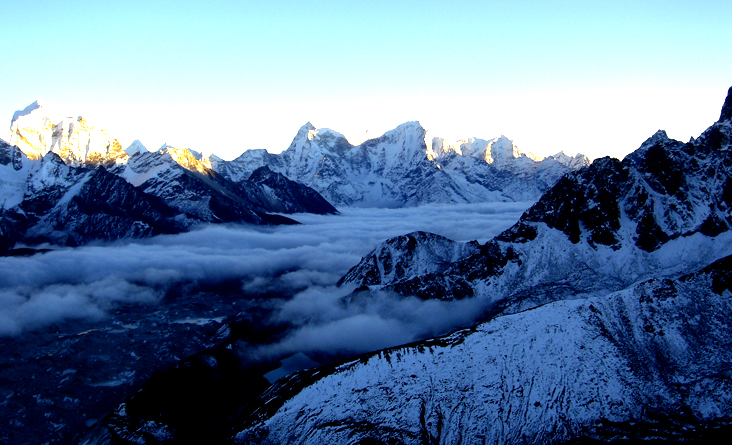
Since the terrain can be hard and the days long, hikers on these treks should be in good physical condition and have some previous mountain walking experience. Steep climbing may be involved, although it is never necessary to use ropes. Treks at this level can he arranged for periods of 16 to 21 days. Typically, a gradual ascent through a green river valley will lead you up to a number of high passes, where you will reach the altitude of 5416m. Often times, you will get a close insight into the Tibetan culture. Participants should expect to trek above 5416m/17872ft.
Group Price
Number of Travellers
- Detail itinerary
- Cost Includes/Excludes
- Fixed Departures
- Reviews (20)
Everest Three Passes Trek in Nepal:
The Three Passes trek in the Everest region is very famous in Nepal. You walk through three different passes, each with its beautiful views. You see the stunning Himalayan scenery, green meadows, and high passes on the alpine plateau of the Everest Region. This trek is also called The Three Passes Three Peaks Trek. It includes Renjo La Pass ( 5,388 meters / 17,678 feet), Cho La Pass ( 5,420 meters / 17,782 feet), and Kongma La Pass ( 5,535 meters / 18,159 feet). As the three passes, Kala Patthar ( 5,643 meters / 18,514 feet), Gokyo Ri ( 5,357 meters / 17,575 feet), and Chukhung Ri ( 5,550 meters / 18,208 feet) as the three peaks. You don’t need climbing permits to climb these peaks.
The 3 pass trek follows the Everest Base Camp route for a 17 -day Trip, which provides some stunning views of the Himalayas and Mount Everest during the trek. As one of the most scenic treks in the world, the Everest Base Camp trek can be enjoyable. But the Everest Three Passes trek can offer you even more of the region’s beauty. There has been a lot of interest in the inner Sagarmatha National Park of the Gokyo Lakes trek and the EBC trek, including the three passes. And this trek takes you through the endpoint of that trek.
The Everest three passes trek is through a remote alpine highlander area of Sherpa Villages, various landscapes , charming Sherpa village, Namche Bazaar the Birthplace of Apa Sherpa “village THAME” which summits 21 times the top of the world’s highest peak Mt. Everest, glory Gokyo lake , and largest Khumbu glacier. The total distance of the Three Passes Trek is about 92 miles round trip. It takes 17 days in total to complete the trek. Many solo travelers and small groups of travelers like to take the Three Passes Trek.
Everest 3 High passes trek difficulty:
Additionally, the Everest Three Passes trek also demands moderate difficulty, necessitating significant stamina and hiking skills, along with well-prepared equipment including microspikes if needed. The three passes in the Nepal trekking region are consistently blanketed in snow and ice. This itinerary caters to adventurers seeking a challenging and extended journey, comprising 17 days of strenuous hikes up the mountains, traversing the high-altitude Bhanjyang, Renjo la Pass , Cho la Pass , and Kongma-La Pass .
The best options route is clockwise to do Everest high passes trek that summits Gokyo Ri at 5,420 m ( 17,782 ft), and Kala Patthar at 5,644 m ( 18,519 ft). Chhukung Ri 5,550 meters ( 18,209 ft) or Mhra peak without climbing permits, from these Trekking peaks, you can film – take photographs of beautiful mountains Mt. Everest, Mt. Pumori, Mt. Makalu, Mt. Lhotse, Ama Dablam, and many white peaks, it is a breath-taking mountain view. December and January are remedied alternative paths via Phorche village instead of Cho La because Cho La will be closed if there is heavy snow.
Hidden Peaks Along Everest’s 3 Passes Trek
Enhance, there are many hidden Peaks, surrounding Everest’s three high passes Trek , the Sundar Peak 5,360 m in Thame, Nangkartshang Peak 5,100 M in Lungden, Ngozumpa Tse Peak 5,553 M in Gokyo, Awi Peak 5,245 M in Zhong la, Pokalde peak (Dolma Ri 5,806 m) in Kongma-La ridge, Chukhung Ri 5,546 in Chhukung, and Nagartsang Peak 5,083 M in Dingboche. so if your time permits to ascend all peaks then can add some more extra days.
Why Choose Clockwise Over Counterclockwise Itinerary?
Our previous experience leading the passes trek has shown that “many customers give up after the Everest base camp and Kala Patthar”. Because “they have only set their minds on trekking Everest Base Camp”. There are, of course, beautiful Gokyo Lakes and charming Gokyo Peak to admire.
If we lead clockwise from Renjo Pass , they all make their way to Everest Base Camp via Gokyo Lake, which is also excellent acclimatization for further passes. Via clockwise since Renjo Pass is located at 5380 meters, Chola Pass is located at 5420 meters. Kongma Pass is located at 5540 meters.
Numerically, it doesn’t matter , but when you are on the spot, even climbing 30 meters matters. However, for us, it is no problem to lead you on both sides as you wish. So we listed both itineraries and so we do lead as you wish.
Trekking over the three passes:
The highest 3 passes trek is the most popular trekking destination among those seeking extreme adventure worldwide. Various trekking routes are available for you to choose from. You will be able to make the best choice according to the length of your stay, your desire for adventure, and your level of determination. You will encounter several trekkers and tourists along the way. As a result, the route is relatively safe. There is no doubt that the 3 passes trek is one of a high caliber, offering a truly unique experience. This package offers a 17-day trek with three high passes and 3 peaks, which is not only beautiful but also more adventurous.
Three passes trek distance of km:
Three passes trek vs. Everest base camp, Length is a total distance of 148 kilometers, per day hike is approximately 11.5 Kilometers, though depending on the altitude area. low altitudes can hike more than 11.5 km per day, and above 5,000 altitudes is less km than that.
Guide Essential for Everest 3 Passes Trek
A 3-pass trek is not recommendable without guides and porters for independent solo travelers, the reasons are miserable trails, difficult ascent climbs, icy, slippery Cliffs, high altitude passes, and often changing weather.
Nepal wilderness trekking guide team is an expert in the 3 passes trek route, we lead a small group and solo trekkers every day at season time at a competitive cost, our guide knows all and every corner of the Everest region, because of a local guide who did three high passes trek uncountable, every month at season time, so guides know every stone steps, mountains, peoples, cultures, area parameter trails
Three Passes Trek with NWT Company:
The tourism industry recognizes Nepal Wilderness Trekking and Expedition as the top-rated company due to the following salient features. Locally Owned and Operated with Competitive Cost. As a local travel operator, we have a lot of experience regarding the Three Passes Trek and its surroundings. We know how to get you to the Three Passes route in the best way possible and how to get you there in the same way.
Our Three Passes Trek’s success rate is great because Nepal Wilderness Trekking is a very trustworthy trekking company in the sense that we are operating all Three Passes Trek based on reality, integrity, and honesty. We are committed to meeting your needs. We highly value all trekkers and are responsive to their needs and preferences. Depending on the interests and plans of our customers, we can customize our Three Passes Trek package to suit their needs.
Value for money. Nepal Wilderness Trekking provides the value of what you buy of our services at least equal to the amount you pay. You will not be charged any middle and hidden fees when you purchase our services. Our one travel consultant or our local expert trekking guide will stay in close contact with our clients every step of the way. Our company ensures customers’ safety at all times so that they will have peace of mind while trekking to Three Passes with us.
Challenging for beginners:
For beginner trekkers; The altitude and rugged terrain of the Three Passes trek can pose several challenges. Altitude sickness is a real concern, as the trek takes you above 5,000 meters, where oxygen levels are significantly lower. Proper acclimatization and a slow ascent are crucial to minimize the risk of altitude-related illnesses. Additionally, the trail itself can be physically demanding, with steep ascents and descents, rocky paths, and potentially harsh weather conditions. Trekkers should be prepared for long days of hiking, often averaging 6 to 8 hours of walking per day. Ultimately, while the Three Passes trek may be tough for beginners. It is also a transformative experience that rewards those who dare to take on the challenge with unforgettable memories and a sense of accomplishment.
Everest high passes Trip Highlights:
- The three best places for photographers during the Everest High Passes Trek are Gokyo Ri, Kala Patthar, and Chhukung Ri. These vantage points offer breathtaking views of all the high mountains in the area from these three peaks along the route of the three-pass trek.
- The unsurpassed breathtaking view of Mount Everest, Cho Oyu, and Makalu from Gokyo Ri, Kalapathar, and Chhukung
- Experience vibrant Sherpa communities’ cultural heritage
- Stunningly Buddhist religious old monasteries
For the Everest Three Passes trek , you only need two types of permits: the Everest National Park Entry Permit and the Khumbu Pasang Lhamu Rural Municipality Entrance Permit. These permits cover the entire region.
Note: All published dates below guarantee departures. If they don’t match your schedule, we’re delighted to organize a trip on your preferred dates. Share your desired trip details, and we’ll turn your dream destination into a reality.

Detail Itinerary
- Day 01: Fly to Lukla Hillary airport early in the morning ( 2860 meters , 35 minutes) and trek to Phakding ( 2640 meters, 3 hours). Overnight at Lodge .
- Day 02: Trek to Namche Bazaar ( 3440 meters. 6/7 hours walking) and stay the night at the lodge.
- Day 03: Rest day in the same place for acclimatization. Visit the Sherpa Museum and Everest View Lodge for panoramic views of the Himalayan.
- Day 04: Trek to Thame ( 3820 m) walking for 5 hours. This village is well known to Everest climbers and is a comfortable place to stay overnight.
- Day 05: Trek to Lungdeng (4360m) 5-6 hours walking) and stay overnight at the lodge.
- Day 06: Gokyo ( 4770 meters. ) via Renjo Pass (5360 meters.) 6-hour walking trek) Stay overnight at Gokyo.
- Day 07: Gokyo Peak ( 5360 meters ), our highest point (four and a half hours walking), offers sunrise and an expansive view of the mountain range. Return to Gokyo, and stay overnight at the lodge.
- Day 08: 5 hours walk to Tangnak 4600M . overnight at the lodge (if you have extra days, you can stay one more night in Gokyo and visit the 5th Lake for even more incredible mountain views).
- Day 09: Trek to Zhong La ( 4830 M. via Chola Pass ( 5420 meters. Six or seven hours walking) today the path is narrow and tiny ascending to the top of Cho La. Stay overnight at the lodge.
- Day 10: We trekked to Lobuche ( 4960 meters ..4 hours walk) and stayed at a lodge.
- Day 11: Trek to Gorakshep 5190M , visit Everest base camp 5,364 m the same day, and return to Gorakshep, totals hike will be 8/9 hours, overnight at lodge.
- Day 12: Explore Kalapattar ( 5,550 meters). for the most stunning view of Everest, climb up in the morning before trekking back to Lobuche (5 hours of walking), and spend the night at a lodge.
- Day 13: Cross Kongma-La ( 5545m ), and stay overnight at Chhukung.
- Day 14: Trek back to Tengboche 3860m in five hours and spend the night at the lodge.
- Day 15: Trek back to Namche Bazaar ( 3440 meters , 6/7 hours walking). Stay overnight at the lodge.
- Day 16: Trek back to Lukla (7/8 hours walking) and overnight at the lodge.
- Day 17: Fly back to Kathmandu around 7:00 AM (35 minutes)
Itinerary Options B:
- Day 01: Fly to Lukla Hillary airport early in the morning ( 2860 meters , 35 minutes) and trek to Phakding ( 2640 meters, 3 hours). Overnight at Lodge . During the evening village tour,
- Day 02: Trek to Namche Bazaar ( 3440 meters 6/7 hours walking) and stay the night at the lodge.
- Day 03: Rest day in the same place for acclimatization. Visit the Sherpa Museum and Everest View Lodge for panoramic views of the Himalayan mountains.
- Day 04: Trek to Tengboche 3860m in five hours and spend the night at the lodge.
- Day 05: Trek to Dingboche 4,340 m 5-hour hike, overnight at lodge.
- Day 06: rest day for acclimatization, hike to Nagarjuna hill 4800 m.
- Day 07: Trek to Chhukung 3-hour hike, overnight at Chhukung, 4700m
- Day 08: trek to Lobuche ( 4940 meters . Via Kongma-La pass (5540m.6.7 hours walk) and stayed at a lodge.
- Day 09: Trek to Gorakshep 5190M , visit Everest base camp 5,364 m the same day, and return to Gorakshep, totals hike will be 8/9 hours, overnight at lodge.
- Day 10: Explore Kalapattar ( 5,550 meters ). for the most stunning view of Everest, climb up in the morning before trekking back to Zong la 4830 M (5 hours walking), and spend the night at a lodge.
- Day 11: 6 hours walk to Thangnak 4600M . via Chola Pass ( 5420 meters, overnight at the lodge
- Day 12: Trek to Gokyo ( 4770 meters. ) 3-hour walking trek) Stay overnight at Gokyo.
- Day 13: visit Gokyo Peak ( 5360 meters ), our highest point (four and a half hours walking), which offers sunrise and an expansive view of the mountain range. Return to Gokyo, and stay overnight at the lodge.
- Day 14: 5-6 hours walking) to Lungdeng (4600m) via Renjo Pass (5360 meters and stay overnight at the lodge.
- Day 14: Trek to Namche Bazaar ( 3440 meters 7 hours walking) and stay the night at the lodge.
- Day 16: Trek back to Lukla (7/8 hours walking) and overnight at the lodge.
- Day 17: Fly back to Kathmandu around 7:00 AM (35 minutes)
Cost Included
- Domestic flight tickets from Kathmandu to Lukla and Lukla to Kathmandu
- Italian, Chinese, Nepali, Indian, and other European foods are available three times a day (breakfast, lunch, and dinner).
- Accommodation in tea houses according to the itinerary
- Kitbag for storing your belongings.
- Sleeping bag for a comfortable night's sleep on a trek in minus-25 degrees
- Everest National Park Entrance Trekking Permit
- Khumbu Pasang Lhamu Rural Municipality Entrance Permit
- Experienced English-speaking trekking guide licensed by the government, familiar with the area.
- One porter for every two to three participants. (Note: An additional cost applies for solo clients requiring a porter.)
- Guide, and Porter meals, accommodation, salary, and insurance.
- Necessary paper works, all government, and local taxes.
- A certificate of appreciation from Nepal wilderness trekking after a successful trek.
Cost Excluded
- Airfare for international flights
- Upon arrival at Tribhuwan International Airport, Nepal entry visa fees vary by duration (15 days - $25-30, 30 days
- Accommodations and meals in Kathmandu before and after our journey
- Personal equipment for high and cold temperatures
- Emergency high-altitude rescue and evacuation are covered by travel insurance
- All beverages, Soft and coffee table drinks such as coke, beer,
- Drinking water/mineral water, Dessert, etc. Hot shower, laundry
- Tip for guide and porter
- Excluded are all costs and expenses not listed under "cost includes"
- Inclusion of costs or delays beyond the control of the management, such as landslides, weather conditions, itinerary modifications due to safety concerns, illness, changes in government policies, strikes, etc.
Highly recommend (trekking agency and the femail Sherpa)
I had been planning this trip for a year and was initially concerned about traveling solo. However, Himal arranged for a female Sherpa, Pasang Sherpa, who made me feel comfortable and took excellent care of me. She was incredibly strong and resilient. The hotel booking in Kathmandu, transportation, flight to Lukla, and all trek logistics were well-managed. It was a relief not having to handle any details myself.
Overall, my trek on the Everest 3 passes was fantastic, largely due to the great company and especially the wonderful guide!
I highly recommend Nepal Wilderness Trekking. Himel was incredibly responsive, helping me arrange my trip with just a week’s notice. Many other operators I spoke with wanted to steer me toward a less challenging route in February, but Himal and I decided to give the 3 passes a shot, agreeing to adjust plans if needed for safety. When I arrived in Kathmandu, Himal warmly greeted me at his office, provided the necessary gear (like a sleeping bag, jacket and crampons), and set me up for the journey ahead.
I had an incredible experience with my guide, Naba Raj Rai, whom I would also strongly recommend. His deep knowledge of the region enriched the trek, and he consistently ensured my safety. Naba and I frequently discussed our route, making adjustments as necessary or requested, which significantly enhanced the journey. Moreover, Naba’s assistance with logistics and carrying loads made the trek far more enjoyable. Thank you, Naba!
Wild time with NWT!
My wife and Mirthe I completed the Three Passes Trek with Nepal Wilderness Trekking and had an amazing time. Upon arrival in Kathmandu we visited several trekking agencies and immediately had a good feeling with Himal, the owner of NWT. We choose his company and are very happy we did. Himal professionally took care of all the organization and we left two days later with our guide Abinta and porter Ram. Our guide Abinta was very professional, proactive and social and had excellent English skills and a great sense of humour. It often felt like we were on the trail as a group of friends, while we could rely on Abinta for her help and guidance as well. Ram was a very strong and friendly porter and we could not have completed the trek without him.
Overall, we can recommend Nepal Wilderness Trekking for the experience of a lifetime!
Stunning Three Passes Trek
My friend and I booked the trip with Nepal wilderness, modified Three Passes Trek with the Everest Base Camp add-on, and it was truly an incredible experience! Our guide, Yakub, played a crucial role in making this trip so memorable for us. His attentive care and wealth of knowledge made all the difference.
We encountered a travel delay with our flights into Lukla at the start of our journey, but Yakub handled it brilliantly. He remained positive and quickly arranged an alternative, ensuring that our trip proceeded smoothly.
Thanks to his efforts, we were able to fully enjoy our adventure without any hiccups. It was an unforgettable journey!
Base Camp, Cho La Pass, Renjo La Pass, Kongma Pass, Gokyo Ri, and Kala Patthar
It was under the provision of Mr. Himal Ghale’s Nepal Wilderness Trekking Agency that I participated in one of the most beautiful treks in Nepal, the 17 days Everest Base Camp and three Passes.
As a result of being free from work, I returned to Nepal on October 5th. I felt a sense of misgiving as the plane landed at Tribhuvan since I saw rain out the window. The monsoons lasted longer than expected this year, and the rain followed Rajesh Gurung and me for the first few days. Because of the rain, we spent three days in Dingboche waiting for the rain to stop instead of the two days planned for acclimatization. The rest of the days, however, were sunny and crystal-clear, so we didn’t miss anything.
Visitors are often caught in the defilements caused by high altitudes. It happened to me more or less this time as well. As a result of Rajesh’s assistance on the way, I was able to reach the Everest Base Camp and all three passes with three peaks by October 23rd. As a result of Rajesh’s assistance on the way, I was able to reach the Everest Base Camp and all three passes with three peaks by October 23rd.
Kongma La Trek was a bit of an adventure since the sun had already set when we reached the edge of Solukhumbu Glacier, where the Lobuche direction marker was. Therefore, we had to continue crossing the glacier in the dark. Currently, it appears that we have lost our way. Unfortunately, when I had already resigned to the fact that we would spend the night there, listening to the rocky boulders falling into the water, Rajesh detected the way.
The assistance of his knowledge, patience, and thoughtfulness can match the requirements of critical trekking incidents.
The beauty of nature was worth dying for, so I didn’t regret any shortness of breath. The beauty of nature was worth dying for, so I didn’t regret any shortness of breath. My camera captured some unforgettable moments.
The best of the best are Himal and Riddhi! If you are looking for an agency that can help you plan your Nepal hiking trips, I highly recommend Nepal Wilderness Trekking. We did the 3 Passes Trek, and I have to say, that this is by far the hardest trek that I have ever done, however, it is also the most rewarding.
We are really lucky to have Riddhi as our guide, and the two porters taking care of us the whole time we are in the mountains. There is no doubt that Riddhi is considerate, caring, and has a wealth of knowledge about the area in which he lives. As a result, I really appreciate that he constantly makes sure we have a good time by adjusting our pace and itinerary to ensure we are having a good time.
The purpose of this comment is to thank Himal, Riddhi, and the two porters for their hard work in making this 17-day three passes trek so special to me and memorable for me.
Nepal Wilderness Trekking is a company that is completely trustworthy and seriously committed to its clients. For me, it was a DREAM COME TRUE!! I hiked in the KHUMBU Valley for 16 days to Gokyo, Renjo, and Kongma La, it was an awesome experience, I wanted to go alone to the Everest Region and this trip was incredible, I was with a fantastic guide GUNESH, who took care of everything for me, including logistics, food, and helped make this an incredible experience.
Nepal Wilderness Trekking is a trek I highly recommend. Himal, the owner of the property, was always responsive both leading up to and during the trip. Furthermore, after my hospitalization, Himal took very good care of me and made sure that I still had a memorable experience while I was in Nepal.
As soon as we arrived in Kathmandu, we met up with him for a pre-day check-in and he made himself available for any further questions our group may have. Furthermore, he gave us the option of storing our luggage at his office if we did not want to store our luggage at the hotel. As well as offering some trekking tips, he also gave us the option of either using the duffel bags from his trekking company or the ones we brought with us. The porters would be responsible for carrying the duffel bags.
I am very grateful to have had a trekking guide and a porter to accompany me on the trip. Our trekking guide took care of all the logistics related to permits, and teahouses, and guided us on the right path all by himself. All of the items that I was not going to use while trekking for that particular day was carried by the porter. The result of this was that I was able to trek with a light daypack (maximum recommended weight of 7kg) while the porter carried the remaining 10kg to 15kg of my luggage. The trekking guide we had was Riddhi and my porter was Sid. Both were caring, thoughtful, and wonderful people.
I had the unfortunate experience of getting Acute Mountain Sickness (AMS) on day 3 of my 17-day trek and had to be med-evacuated to the hospital. Since I was unable to be at high altitudes as a result of my medical condition, the Himalayas were no longer an option for me. Instead, Himal and I worked together to design a low-altitude itinerary that would align with all of the parameters of my health requirements. In addition to a personal trekking guide/porter, I visited the cultural and culinary history of Kathmandu, spelunked, and went sightseeing around Pokhara, including a 2-day trek to Poon Hill. I also visited the Buddhist monasteries of Lumbini (birthplace of Buddha) and took a mountain flight through the Himalayas.
Despite the fact that I was unable to complete my 17-day trek through the three passes which included Everest Basecamp, Himal helped me salvage my trip and put me on a custom trip that he and I planned together. Himal was thoughtful, responsive, and did his best to ensure my experience in Nepal was good. He even visited me the first two days I was in the hospital. It was a great pleasure to book my trip through Nepal Wilderness Trekking. I doubt that any other trekking company would have worked as hard as Himal did to help me create such a wonderful 3-week experience in Nepal despite my inability to hike the Himalayas.
I have done the 3 Pass Trek with this company and I have to say it was very challenging, but rewarding and worth it nonetheless. It was one of the hardest ones yet compared to the ones that people usually do (16 days, several nights above 15,000 ft and counterclockwise direction), so it can really push you to the very edge of your abilities. I recommend this trek only to those who are in pretty good hiking shape as even in the best shape, you will still be able to kick your butt out of this trek.
It was a great pleasure to have a guide and porter with us. As a group, we were led by Riddhi who was a great guide – he was warm, welcoming, and took great care of us (there was a lot of adjustment needed to get used to the altitude, cold, and physical requirements required for this trek). We were together for a long time doing this hike and it was wonderful to have someone who knew what they were doing and could take care of the lodging and details for us. In addition, it was really nice to see that the guides also got excited about the mountains as well. He was just as excited as we were to see the views from the passes and Mt Everest from up there.
We also had our porters carry our extra luggage, and they did a great job. In hindsight, it is hard to imagine having to carry everything you would need for this trip all by yourself. Our guide manager, Himal, prior to our trip was very communicative and responsive. We asked him all the questions we had, and he was very helpful when one of our friends needed help during the trip. I would highly recommend him as someone to know when going on a trip like this. As a whole, I found the value and price for this tour to be very good, and I would recommend this company to others.
During our trek to the Everest area, we did an amazing and epic 17-day trek covering three passes. Our guide Riddhi did an outstanding job of setting up a challenging yet spectacular itinerary through some of the tallest mountains in the world with our owner Himal, who was extremely communicative and helpful throughout the trip. On this trek, we had a guide and porters – this made things a lot less stressful, and the passes were all quite challenging (the few people we saw out there carrying all their stuff were suffering).
Also, they were there for us when things went wrong and one of our group members came down with altitude sickness due to an underlying heart condition that they were not aware of. Himal and Riddhi got them the medical care they needed on the mountain, arranged for the helicopter evacuation and subsequent care, and arranged an alternative adventure at a lower altitude after they had recovered. Throughout the whole process, we felt very well taken care of and supported.
Kevin James
Very great place to plan a trek. Walking into Himal’s office you can tell he is a great and experienced trekker himself. If I recall correctly, he has been running the agency since 1990. I asked him for a very strong guide because I wanted to do the Everest Three Pass Trek in 7 days and he gave me a great guide, Parkhidhan Tamang. At first, I was unsure that I needed a guide, but Parkhi helped me so much, that I don’t think I could have done it without him. He guided me through tricky and technical sections of the route – he had friends at all of the best local teahouses and facilitated my stay at each one. Sometimes when we were running late he would call ahead to reserve our spot. He had the strength to both complete my ambitious trek and also support me at the same time.
Ron & Lara
The 3 passes trek was amazing. Himal is a friendly owner who responds quickly to questions.
Mingmar, our guide, was excellent. We are grateful for everything he did for us. He is very familiar with the route and knows everybody and every town up in the mountains. He is fun to be around. He made us feel safe and we highly recommend him to anyone who goes trekking.
Our porter Fulonn was also great. Incredible to see how easily he is walking through the mountains. We considered doing the trek without a porter, however, you’ll provide the opportunity for someone to work and get some extra income. And then we would recommend Fulton.
Arrived alone, left with friends – best agency!
Wilderness Trekking is an excellent agency for trekking and climbing tours in Nepal. Himal’s professionalism has greatly impressed me. Throughout the trip, he never tired of answering my thousand questions – and this almost instantly! Because he has done many kinds of treks himself, as a pleasure or even as a guide, he knows what he is talking about. He remains attentive to any requests or sudden weather changes. Parkhi Dhan, my guide, was absolutely great, trustworthy, and knowledgeable. Parkhi Dhan was one of the most sociable guides I met along the way.
Due to heavy snowfall, I was unable to cross the three high passes, so I trekked each valley separately to the end, then into the next one and back again. The most beautiful panorama and view on Mount Everest can definitely be seen from Gokyo and Gokyo Ri if you have limited time and are not sure which valley to go to. The Khumbu Valley is also beautiful, especially with snow.
Despite going to Kathmandu knowing nothing or anyone, I have left with two new friends – THANK YOU HIMAL and PARKHI DHAN!!!
Three-passes-tour breathtaking
I just finished a trip with my husband, Three passes trek (Ama Dablam BC, Island Peak BC, EBC, Chukhung Ri, Kala Patthar, Gokyo Ri, Bhote Koshi Valley) over 24 days. We met our wonderful porter/guide Makaraj Tamang thanks to Himal Ghale who responded to all our e-mails promptly and competently.
In all situations, Makar was willing to help (finding the most suitable lodges at the best price, giving information on the landscape, culture, and food). It was a joy to start every new day seeing him smile and have fun with me. Throughout our stay, he was very attentive and considerate so that we always felt safe. Trekking in the Everest region is possible with Nepal Wilderness Trekking and Guiding Makar Tamang.
Agnieszka K
Everest Three Passes Trek from Bupsa
In April of this year, my husband and I hired a guide from the agency, Mr. Makaraj Tamang. We had a great time. Mr. Himal, the owner of the agency, answered all of our online questions quickly and efficiently. He was also very helpful on-site. In addition, he respected our “independent trekkers” attitude. It was highly appreciated that he did not try to upsell us services we did not need, so thank you Himal, and 5 stars for not being pushy.
Mr. Makaraj was very knowledgeable and talkative. We learned a lot about Nepal’s culture. During the snowstorm, he walked us through glaciers like it was a stroll in the park on Sunday. He made us feel safe. Thanks for making our trip enjoyable.
I had a great time on the trek. It was likely caused by a pandemic, but to be alone at all the peaks was amazing. This trek is well worth trying even during crowded times since it is so breathtaking. Nepal Wilderness Trekking and Makaraj as a guide are highly recommended.
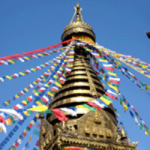
Three Passes Trekking
Our trip with Prakash over Cho La and Renjo La was beautiful! We were delighted with the service and support that Prakash delivered. He has a bright future and is suited to his role as guide. Even though we only needed his services as a porter, we would recommend him to anyone as a guide due to his professional attitude and excellent English.
I will be pleased to provide a testimonial shortly and look forward to using your services again in the future.
Until then, may you have good health and good fortune
Kind regards, Jude Trevillien
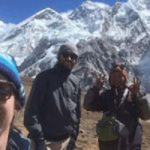
Dean & Laynni
Three pass trek.
Hi, Himal. Just wanted to let you know that we had a fantastic trek up to EBC. We had fantastic weather all the way up. The clouds started only on our way down from Kala Pattar and stayed most of the way down, but the mornings were still lovely.
We wanted to thank you for your help in organizing our porter/guide and porter. They were great guys and worked very hard to make sure our trip went well. Prakash was always very eager to help us in any way possible. He was still watching the other guides and improving his guiding skills as the trip went on and his English was better than we expected for a porter/guide.
We were also surprised by how much English Milan knew, and he often helped us communicate. Thanks again, hope the rest of the season goes well Dean & Laynni
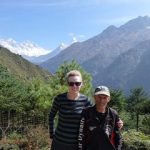
Lex and Kerry
Three pass trekking.
We used the Nepal Wilderness Trekking company for a 19 day “3 Pass Trek” in the Everest region, in October 2012. Himal Ghale, the owner, was highly knowledgeable about the Everest Region having worked there as a Guide in the past.
Himal organized a tailor-made itinerary for us, based on our interests, abilities and time commitments.
That is included the “3 Passes” route, Everest Base Camp and Kala Pattar, and the addition of a summit of Island Peak. Himal was very responsive in answering our initial questions (remotely), meet with us in Kathmandu, and dealt with some challenges that arose from unforeseen weather conditions.
We were also delighted with our assigned Porter/Guide – named “BB.” BB provided first class support to us throughout the trek and lived up to his reputation as a reliable and highly experienced Porter/Guide. Amazingly, BB had competed over the past eight years in the Tensing/ Hillary Everest Marathon!! He knew the region exceptionally well, including the many route variations and options we could take for different terrain/altitude, and chose excellent guest houses for us to stay at BB was well known, respected and welcomed by guest house proprietors along the way. He was also a very kind and caring gentleman – we will always remember BB with great fondness, respect, and gratitude for a wonderful trekking experience.
We wish Himal well over the future years and would recommend the Nepal Wilderness Trekking company to other trekkers for the Everest region.
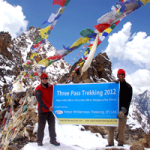
3 pass trekking reviews
Just finished the 3 Passes Trek (Renjo, Cho La and Kongma La pass), EBC and Kala Patthar, and finally, Island Peak summit with Nepal Wilderness Trekking Had a great trip. Himal and our guide Purna worked everything out perfectly. This team comes highly recommended from me.
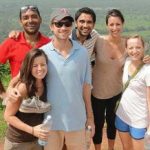
Fred and Evan
3 pass trekking.
We enjoyed our three pass trek. Challenging but rewarding. Magnificent views, Purna + Bir did a very good Job-they were very flexible when we wanted to alter our plans, and we always helpful + supporting their attitude + personality helped us a lot on some of the long climbs, and through the cold +wind. It was a very memorable trip – thanks to Himal + everyone else who helped us along the way!
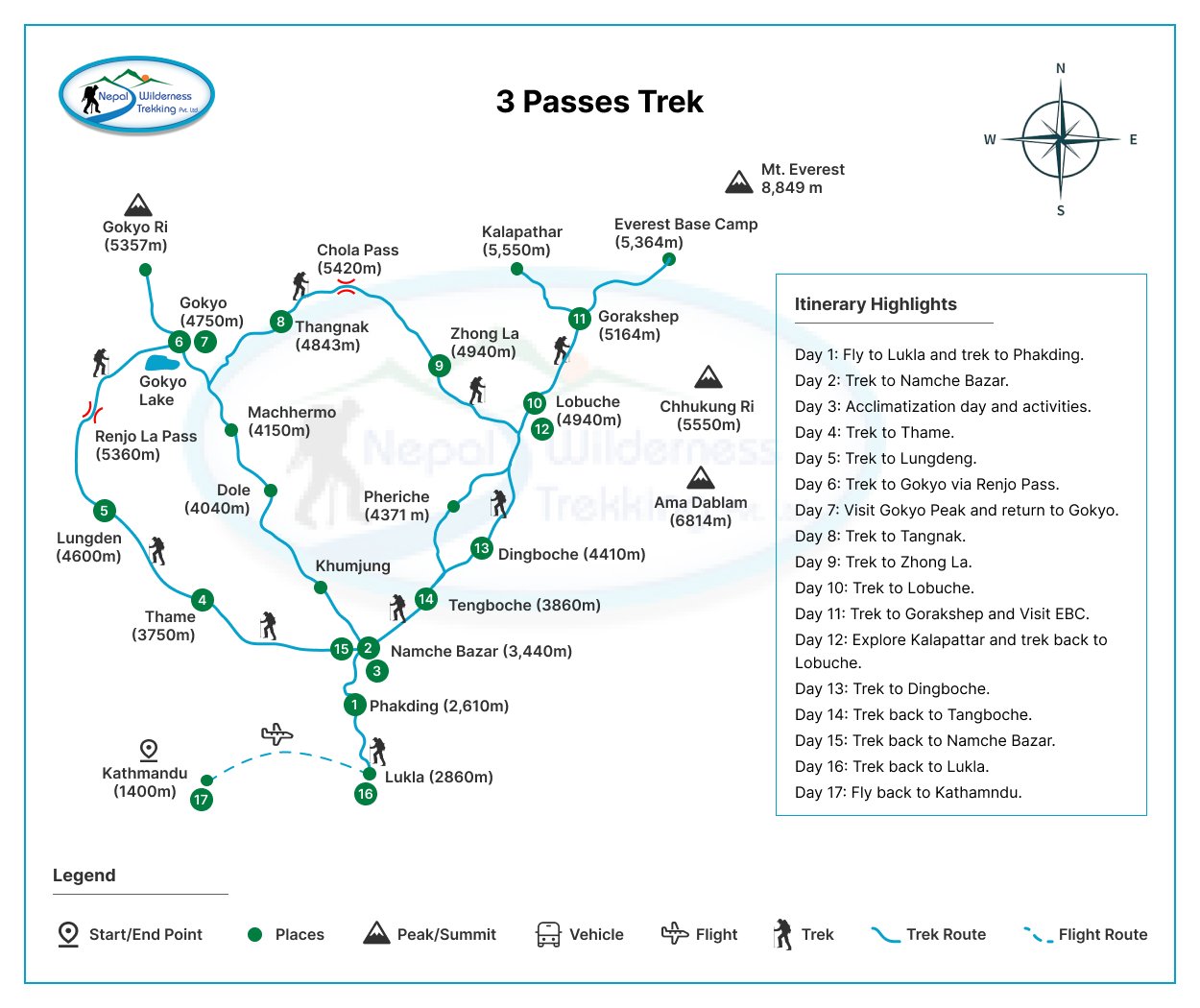
Frequently Asked Questions
How difficult is everest high passes trek, what is the maximum height of this trek, is it possible to do private trek, when is the best time to do the trek, what is the temperature in october and april, what is the accommodation type, are there atms available along the trail, how to prevent altitude sickness during the trek, why are acclimatization hikes necessary, what kind of clothes, gear and equipment do i need for the 3 passes trek, is drinking water available during the trek is it safe, what is acute mountain sickness (ams) and how likely am i to experience it, altitude chart, similar packages, nangpa la pass trek, short trek to everest, luxury everest base camp trek with helicopter return, chola pass trek, numbur cheese circuit trek, classical jiri to everest trek, we are recommended on.
Nepal Wilderness Trekking Pvt. Ltd.
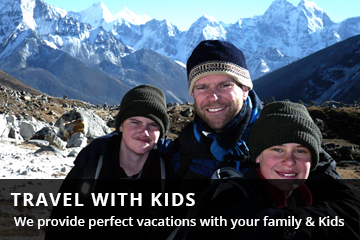
Nepal Traveller's Information
- Nepal Information
- Nepal Visa Information
- Entry Procedure to nepal
- Altitude Mountain Sickness

Base Camp Adventure

- Email: [email protected]
Everest Three Passes Trek

Everest Base Camp Three passes trek, also known as Everest Three High Pass trek, is one of the best alternatives to the casual Everest Base Camp Trek. This journey takes you to all the major places of the Everest region including the Everest Base Camp (5364m), Kala Patthar (5545m), and the three major passes; Cho La (5420m), Renjo La (5360m), Kongma La (5535m).
Along with this, the trek gets more special as you explore the unexplored section of Gokyo Valley and Gokyo Lakes. Hiking to Gokyo Ri (5360m) is another highlight of this trek. Also, the view from Gokyo Ri provides the best panoramic view of the Everest range. Plus, there is an excursion to the higher Gokyo Lakes like the fourth and fifth ones. On the top of it, the beautiful glaciers like Ngozumpa, which is also the highest in the entire Himalayan region. And not to forget, the outstanding views of the humongous peaks like Mount Everest, Lhotse, Makalu, Nuptse, Cho Oyu, Ama Dablam, and whatnot.
Believe it or not, the Everest Base Camp Three passes trek is a wholesome journey that is like the ultimate adventure. Thus, if you’re an adventure lover, who feels fit to take on adverse physical challenges, this trek is for you. And we, at Base Camp Adventure, will make sure this journey is well supervised and fully hassle-free.
If you opt to go with us, the trek will take 18 days to complete. The starting point of the Everest Three High Passes trek is Kathmandu. You will take an early morning flight from here to Tenzing Hillary Airport, Lukla. The flight is also the highlight as the airport is a challenging feat in itself. Plus, it’s scenic as you can have great aerial views of the whole Khumbu & Kathmandu valley.
After reaching Lukla, your trekking officially begins. You follow the usual route upto Dingboche. In this stretch, the route progresses through major destinations like Phakding, Namche Bazaar, Tengboche, and Dingboche. From Dingboche, you’ll head to Chhukung, Lobuche, and embark Kongma La Pass, the first pass that you encounter.
Thereafter, you follow the climb to Everest Base Camp (5364m) and Kala Patthar (5545m). Kala Patthar is the vantage point of the Everest Base Camp trek. You’ll enjoy the fabulous views of Everest, Nuptse, Changtse, Lhotse, and many smaller peaks. They include Awi Peak (5245m), Arakam Tse (6423m), Cholatse (6335m).
Then, the trek moves to Gokyo valley & Gokyo lakes going from the remaining two passes Renjo la and Cho la. You get back to Lungden from there and retrace your steps to Namch then Lukla. You take flight back to Kathmandu and this marks the end of your trek.
The region you trek encompasses a variety of floral & faunal species. You walk through the Sagarmatha National Park. It’s rich in rare species like red panda, snow leopard, dazzling pheasants (crimson-horned & Impeyan), pikas, martens, and more. Talking about ethnicity, the whole region shows the dominance of Sherpa culture & tradition. The whole Khumbu region is also famous because of Sherpas as it’s often reckon as ‘Land of Sherpas’. They are the brave-hearted superheroes who not only help carry your heavy loads but also welcome you to their place whole-heartedly.
If you’re here on the trek in their major festivals like Tiji, Losar, Dumje, and Mani Rimdu, you’ll get to enjoy more. They easily let you be a part of their feasting, drinking and singing.
Hence, in every aspect, Everest Three Pass trek is the best ever challenge an adventure lover could opt for. The grade of the trek is very strenuous, so besides good preparation, you’ll need experienced guidance. And Base Camp Adventure is all here for it.
So,when are you planning to celebrate the most adventurous ride of your life? If you need any help or info, don’t forget to contact us .
Things to Experience in Everest Three Pass Trek 18 Days
- Experience the wholesome activities that you would do in treks like Everest Base Camp trek and Everest Gokyo Valley Trek
- Embark all the highest vantage points of the Everest region like Everest Base Camp(5364m) and Kala Patthar (5545m)
- Set your foot on all the three major passes; Kongma La Pass (5535m), Renjo La (5360m), and Cho La (5420m)
- Explore the beautiful Gokyo Tso (Lakes), Gokyo Valley, and visit Gokyo Ri (5360m)
- Fabulous panorama of majestic peaks like Everest (8848m), Nuptse (7861m), Changtse (7543m), Lhotse (8516m), Cho Oyu (8153m), and Makalu (8485m)
- Have a close look into beautiful glaciers like the longest Ngozumpa, Khumbu glacier, Khumbu Icefalls, and many more
- Visit the oldest monasteries of the region; Tengboche Monastery and Dingboche monastery
- Go to traditional village of Khumjung, explore the ancient Khumjung monastery, and the legendary Khumjung school
- Full exploration of the major capital of Khumbu region i.e. Namche Bazaar and its surrounding places & free market
- Celebrate the success of your journey at the world’s highest pub, at 11000ft, in Namche Bazaar
- Explore the unexplored settlements like Dingboche, Chhukung, Dzongla, Lungden, Thame, etc
- A memorable and scenic flight to/from Lukla’s famous Tenzing Hillary Airport
- Flexible modification of itinerary according to your availability & comfort
- If feasible, a half-day sightseeing in Kathmandu going to places like Swayambhunath, Pashupatinath, Boudhanath, Durbar Squares, etc

Everest Three Pass Trek Altitude Chart

- Location Everest Region
- Maximum Height 5545 M in Kalapathar
- Comfort Hotels / Guest Houses
- Difficulty Level Moderate to Strenuous
- Group Size 02-08 People
- Note Full board package on trek
Welcome to the land of mountains and unique ethnicity! After you arrive here, our representatives will be all ready to pick you up and transfer you to your hotel. You can have some rest and can explore around later. Make sure you carry all the important documents like your passport, visa, copies of travel insurance, passport sized photos, etc. Overnight in a three-starred hotel in Kathmandu.
You’ll miss a lot if you don’t sign up for sightseeing in Kathmandu whenever you’re in Nepal. So, this day is especially dedicated to it. You will visit UNESCO listed cultural heritage sites. It will include religious sites like Pahupatinath, Boudhanath, Swayambhunath and cultural sites like Durbar Squares. You’ll be visiting with a guide, so s/he will fully explain the stories behind them.
Also, on the same day, you’ll meet your fellow travelers and get trekking permits. It’s the day before you head out for the trek, so check the necessary gears. If you’re missing anything, you can do the last minute shopping in Thamel. You’ll find everything you need for the trek there!
Lukla Altitude: 2850m
Travel Duration: 30-40 minutes of flight & 3-4 hours of walk
Walking Distance: 8.2 KM/5.1 miles
Overnight at: Teahouse
Your journey to Everest Base Camp Three Passes Trek begins with an early morning flight to Lukla. There will be a private vehicle arranged to take you to TIA. Right after you come on board, you’ll start enjoying the lovely views of Kathmandu valley, green hills, rivers, and surrounding mountains. The flight takes only half-an-hour but it will be one of the most scenic flights.
Upon reaching Tenzing Hillary airport, you will meet with your remaining crew and start walking towards Phakding. Within this stretch, you get to enjoy the rich greenery, varied flora & fauna, suspension bridges, and great views of Dudh Koshi.
Namche Altitude: 3450m
Walking Duration: 6-7 hours
Walking Distance: 10.4 KM/6.4 miles
It’s one of the longest yet a memorable part of your journey. You will begin by climbing an uphill and walk along the forested ridge of Sagarmatha National Park. You can have early glimpses of Mount Everest, Kusum Kanguru, Lhotse-Nuptse from here. Continuing your path, you’ll cross the five different suspension bridges filled with colored flags over the Dudhkoshi river.
Likewise, you’ll pass via settlements like Jorasle, also the check post where you register. From there, you’ll reach Namche within three hours. As the most celebrated village of Khumbu, you’ll have a lot of options to explore at Namche. End your day by strolling around its market and a hot bowl of their local Tibetan dinner.
Khumjung Village Altitude: 3780m
Walking Duration: 4-5 hours
Walking Distance: 4-5 KM
This day is an extra day for acclimatization as the altitude is gradually increasing. It will help to adapt with the low oxygen condition that will be prominent on coming days & destinations. Your morning at Namche starts with a refreshing view of gorgeous peaks like Thamserku (6648m), Khumbila (5707m) Kwangde Ri (6187m). After your breakfast, you’ll head to explore Namche.
First, you’ll hike up to the Everest View Hotel (3962m). It’s one the highest placed hotels in the world that offers mesmerizing views of the Everest (8848m), Nuptse (7861m), Ama Dablam (6856m), and more. Similarly, you’ll visit another traditional village i.e. Khumjung. Besides the local settlements, you can explore Khumjung monastery and the legendary Khumjung School. Also, the pristine view of countless mountains, glacial lakes of Gokyo from its top is another highlight of the day. After the exploration, you’ll get back to Namche for the overnight stay.
Tengboche Altitude: 3865m
Walking Duration: 5-6 hours
Walking Distance: 9.2 KM/5.7 miles
Leaving Namche, you’ll head to Tengboche, another famous village in Khumbu. You will gain more than 400 meters of elevation in this stretch and the trails are full of ups & downs. It’s going to be tough so you need to brace yourself. You will traverse through an uphill climb leading to teahouses at Khumjung and Kyangjuma. The view of Ama Dablam from Kyangjuma is breathtaking, don’t miss it out.
From there, you will descend down the trail alongside the Dudh Koshi river. Upon walking a few hours further, you’ll reach the most sacred & oldest monastery of Khumbu; Tengboche. This world-famous monastery lies on a high ridge and offers 360-degree views of Everest, Ama Dablam, Kangtega, Thamserku, Lhotse, and more. Also, get ready to dive into its peaceful environs of spiritual divinity. Overnight stay in Tengboche!
Dingboche Altitude: 4410m
Walking Distance: 6 KM/3.72 miles
Bidding farewell to Tengboche, you will continue with a descent into the forest at first. After an hour of descent, the remaining trail is a slow ascent. Most of the part is flat/steady incline, so it won’t be tough as the day before. On the way, you walk past Deboche village first. Here, you will witness walls of inscribed stones and a few guesthouses. It’s a good alternative to Tengboche for a night stay as well.
From there, you will cross the suspension bridge and continue walking along the valley walls. The view of Ama Dablam and surrounding mountains appear on the backdrop. Then, you’ll reach Pangboche village (3985m). Here, we can have plans to go to Ama Dablam Base Camp (4576m). Else, you’ll take a short break and enjoy the majestic views of the Everest range. Leaving Pangboche, you’ll climb another uphill, pass by the Shomare village, and then reach Dingboche.
Chhukung Altitude: 3450m
Walking Duration: 2-3 hours
Walking Distance: 5 KM/3.1 miles
It’s another important day for your Everest Base Camp Three Passes Trek. You’ll be taking an alternative route from the casual Everest Base Camp trek route to head to Kongma La Pass. It’s one of the three passes you’ll be embarking on. This stretch is an interesting one where you explore a lot. Since very few people follow this route, you get to freely go to places like Island Peak Base Camp (6189m) and Chhukung Ri (5550m).
Other than this, the way to Chhukung is sandy and rocky. You have to be careful while walking on them. Also, you’ll get to see lovely snow capped mountains throughout your way. Upon reaching Chhukung, the view of Lhotse and Nuptse becomes clearer and more beautiful.
Lobuche Altitude: 4940m
Walking Duration: 8-9 hours
Walking Distance: 10.6 KM/6.6 miles
Another intense day of trek begins as you make an attempt to reach Kongma La from Chhukung. Be ready to walk along the deserted areas filled with sand, rocks, and snow at times. You will begin the climb to Kongma La Pass with an hour of flat walking and then a steep climb. The trail is well-defined and takes you closer to the mountainside.
From the top of Kongma la, the view of mountains and frozen glacial lake appears amazing. The trail then descends through cliffs & rocky fields and takes you to the Khumbu glacier. You’ll love how the trails are and how near the surrounding peaks seem. The whole atmosphere is just magical. After a long day, you’ll have an overnight stay at Lobuche.
Gorakshep Altitude: 5140m
Walking Duration: 7-8 hours
Walking Distance: 4.5 KM/2.8 miles
Lobuche is the final destination before reaching Everest Base Camp (5364m) and Gorakshep (5140m). Leaving Lobuche, you will follow the long, flat, and sandy trail to Gorakshep. Surrounded by mighty hills and peaks, you get to explore the frozen lakebed of Gorakshep. You will also explore its tremendous flat lands, great for camping.
Following the snow-capped mountains, you’ll also get to Everest Base Camp. The way to EBC is full rocky and filled with icefalls & crevasses. You may not view prominent peaks from there. It’s famous for mesmerizing views of Khumbu glaciers, icefalls, mysterious landscapes, colorful prayer flags, and thrilling altitude.
Dzongla Altitude: 4860m
Walking Distance: 10 KM/6.4 miles
So, the ultimate day to witness the majestic peaks to its closest is here. You’ll wake up early in the morning and hike to Kala Patthar, at 5545m. This notable landmark is famous for its 360-degree view of the Khumbu range. You can enjoy the spectacular views of Everest (8848m), Nuptse (7861m), Changtse (7543m), Lhotse (8516m), Pumori (7169m) with Khumbu glacier & Khumbu icefall. Also, you can’t miss the lovely sunrise that makes the mountains more stunning.
Afterward, you’ll head to embark another pass of your trek i.e Cho La. For that, you’ll be heading to Dzogla, also called Zongla or Dzonglha. On the way there, you will pass via Thokla pass. Do enjoy the awesome view of Awi Peak (5245m), Arakam Tse (6423m), Cholatse (6335m), and frozen lake, Chola Tsho.
Gokyo Altitude: 4790m
Walking Distance: 9.5 KM/ 6 miles
Another exciting and challenging day of Everest Base Camp Three Passes Trek begins. The trails of this stretch are the most difficult one, so you’ll need proper supervision. With Base Camp Adventure, you won’t have to worry about it. Our experienced guides and porter will take care of you all the way.
Leaving Dzongla, you’ll head northwest uphill, climb a steep boulder, cross a stream, and reach the glacier below Cho La. Then, you climb the icy path to Cho La walking past the glacier. Afterward, you descend to Dragnag. You will witness the longest Ngozumpa glacier and Gokyo from there. Thus, after walking a few more hours on an uphill morain, you’ll reach Gokyo valley.
Gokyo-Ri Altitude: 5360m
Walking Duration: 3-4 hours
Walking Distance: 4.43 KM/2.75 miles
The trail from Dzongla to Gokyo is the hardest part of your trek. So, instead of heading for Renjo La immediately the next day, it’s better to take a day rest at Gokyo. Gokyo Valley has a lot to offer i.e. you can either hike up to Gokyo RI or visit the world’s highest freshwater lake system.
Visiting the Gokyo lake will let you explore the unclimbed Mount Kyojo Ri. You’ll have a great time witnessing the valley, crystal clear lakes, and surrounding moraines. Whereas, if you go to Gokyo Ri (5360m), you’ll explore numerous glaciers. Also, you’ll enjoy the closest panorama of Cho Oyu (8153m), Makalu, Lhotse, Everest, and other towering peaks.
Lungden Altitude: 4368m
Walking Distance: 8 KM/ 4.9 miles
Heading out of the Gokyo Valley, you’ll now walk towards the final pass of the Three Passes trek i.e Renjo La Pass (5360m). The trail to Renjo La Pass includes remarkable spots like Thame village, Nangpa La Pass (5808m). You can begin the climb along the northern shore of Gokyo Lake. The altitude keeps on increasing so you need to maintain slow pace and breath properly. Also, there are major crevasses on the trail, you need to be careful about that too.
After an hour or two, you will reach Renjo La (5360m). Here, you’ll love the panoramic view of Makalu, Tengi Ragi Tau, Gyachung Kang, and the Rowaling range. Thereafter, you will descend via remarkable trails filled with scree fields, cairns, and frozen alpine lakes. Following them, you’ll reach Lungden, a small Sherpa village. It lies on the west side of Renjo La and is less traveled. So, don’t expect much facilities here. Overnight in one of its teahouses.
You will leave Lungden village after you have your breakfast. The rest of the trails combine ups & downs and are relatively easier. On the way, you’ll meet many yak pastures and grazing yaks. There are a few teahouses where you can stop by to eat lunch. You’ll then be descending gradually through the village of Dingboche, Marulung, Thame, and finally Namche. This day is another long day, so you might want to take some rest.
Afterward, you can either take a stroll around the village/market or celebrate in a pub/restaurant. After all, Namche holds the world’s highest Irish pubs in the world at 11,290ft. There are a variety of shops where you can buy souvenirs for your loved ones. So, we recommend you to make the most of it, especially when you’re spending your time at Namche Bazaar.
Lukla Altitude: 3450m
So, you bid farewell to the gateway of the Everest region and start retracing your steps. You will begin the journey after your breakfast. If you wake up early, we can take a walk to nearby monasteries and be a part of their morning prayers. It would be a lovely way to begin your day. Then, you will head back to Lukla via te exotic alpine forest covering Sagarmatha National Park. Enjoy the breezy weather and make sure to make the descent to Lukla memorable one.
Kathmandu Altitude: 1100m
Travel Duration: 30-40 minutes of flight
Overnight at: 3-star hotel in Kathmandu
Your Everest Three High Passses trek comes to an end. You will bid a final goodbye to the Everest region and head on to Lukla airport early in the morning. You’ll catch an early morning flight to Pokhara from Kathmandu. There might be chances of flight delay depending on the climatic condition, so you need to be prepared for that as well.
So, within 30-40 minutes, we’ll reach Kathmandu and get back to your hotel. The remaining part of the day is free-time so it depends on you on how to spend it. We, Base Camp Adventure, are free to all kinds of add-on trips like Sightseeing in Kathmandu, Visit Garden of Dreams, etc. For that, don’t forget to inform us beforehand or simply contact us to know more.
As it’s your final day in Nepal, you’ll be bidding farewell to Nepal and everyone here. You don’t have to worry about your departure as our representatives will be ready to drop you at the airport. As per your flight schedule, you will reach there three hours ahead. We, as a Nepal Eco Adventure team will hope you had a great time and look forward to serving you in near future too.
Cost Includes
- Airport / Hotel / Airport pick up & drop by private car / van / bus.
- 3 night's accommodation l in Kathmandu.
- Guided city tour in Kathmandu by car / van / bus.
- All your standard Meals (breakfast, lunch and dinner) during the trek.
- Best available guesthouses during the trek (mainly in twin sharing).
- A local government licensed English speaking Guide during the trek.
- The required number of staff and Porters to carry your luggage during the trek.
- Food, accommodation, salary, insurance, equipment, medicine and transportation for all trekking/tour staff.
- National Park entry permit.
- TIMS Permit (Trekker’s Information Management System)
- Down Jacket, sleeping bag and duffel/kit bag by Base Camp Adventure (which needs to be returned after the trek.)
- First aid medical kits.
- All necessary land transport
- Domestic airfare (Kathmandu-Lukla-Kathmandu) and airport tax
Cost Excludes
- Lunch and dinner whilst in Kathmandu.
- Your travel insurance (compulsory).
- International airfare and airport departure tax.
- Alcoholic, hot and cold drinks, laundry, hot shower etc.
- Personal trekking equipment.
- Kathmandu city tour's entry fees
- Tips for trekking staff.
- Any others expenses which are not mentioned on Price Includes section
The best season for Everest Three High Pass trek is Spring (March to May) and Autumn (September to November). Since it’s a strenuous trek, you need to be careful about the situations of trails. And it highly depends on the climatic conditions so it’s recommended to go in these favourable seasons. If you want to explore them beside these two seasons, better opt for Everest Base Camp Helicopter Tour or Mount Flight to Everest.
The condition of food and accommodation for this trek is basic. The normal food routine is Dal Bhat for lunch & dinner, and the room is a twin sharing bed with pillows & blanket. Other than this, there might be extra options depending on the level of altitude you’re on. There are fewer options of teahouses in areas of Gokyo and Three passes’ range. So, you’ve to prepare yourself to accommodate even in very basic facilities.
The grade of Everest Three Pass trek is very strenuous or very challenging. There is a significant rise in altitude and the paths are equally steep & rocky. The altitude of this trek ranges from as low as 1100m (in Kathmandu) to Nangpa La Pass (5808m). The length of distance you cover everyday on average is more than 10 kilometers. The combination of high altitude with longer distance makes the trail more challenging. Thus, you need to go for adverse training for this trek.
Well, the right time to get into the training would be 5-6 months prior to the actual date of your trek. You should begin with normal aerobic exercise that would improve your stamina & endurance. Along with this, altitude conditioning, staircase climbing, hiking, bouldering, breathing, situps, pushups, etc will help to balance your body physically. Whilst if you want to boost your mental health, you must do yoga & proper meditation.
So, these two trips are similar and different in different kinds. The similarities include the starting and ending point along with points like Namche Bazaar, Everest Base Camp, Kala Patthar, and route from Lukla to Dingboche. Whereas, you get to explore three more passes, Gokyo valley, and Gokyo lakes. So, you get to explore the unexplored settlements in the trail of Everest Three Pass trek.
EBC three pass Trek

You can send your enquiry via the form below.
Why book with us.
- Outstanding Service
- Competent & professional local guide
- The real experience of Nepal
- Customized Trips
- Health and Safety
- Small to average group
View Details

Excellency Awards

Related trips you might interested in

Tsum Valley and Manaslu Trek

Everest Gokyo Ri Trek Itinerary

Langtang Gosainkunda Helambu Trek
Related trips.

Langtang Valley Trek

Narphu Valley Trek

Mt Everest Expedition

Jiri to Everest Base Camp Trek

Weekend Hiking Tour


- Annapurna Region
- Kathmandu Valley
- Khumbu and Everest Region
- Langtang Region
- Manaslu Region
- Mustang Region
- Region Far East Nepal
- Region Far West Nepal
- Highlight Tours
- Climbing Expeditions
- Cultural Tours
- Family-Friendly Tours
- Deluxe Tours
- Wildlife Tours
- Outdoor Activities
- Festival Tours
- Helicopter Tours
- Asian Heritage Group
- Sustainability policy
- Asian Heritage Foundation

Three Passes Trek Itinerary
The Three Passes Trek is a thrilling adventure that takes trekkers across three high mountain passes. Let’s discuss the Three Passes Trek Itinerary, how long it takes, the distance covered, the difficulty level, whether or not you need a guide, and the best time to go. offering stunning views of the Himalayas and an opportunity to immerse oneself in the local culture. The trek is known for its challenging terrain, but the rewards are well worth the effort.
Table of Contents
How Long Does the Three Passes Trek Take?
The Three Passes Trek itinerary can vary, depending on the pace of the trekker and the number of rest days taken.
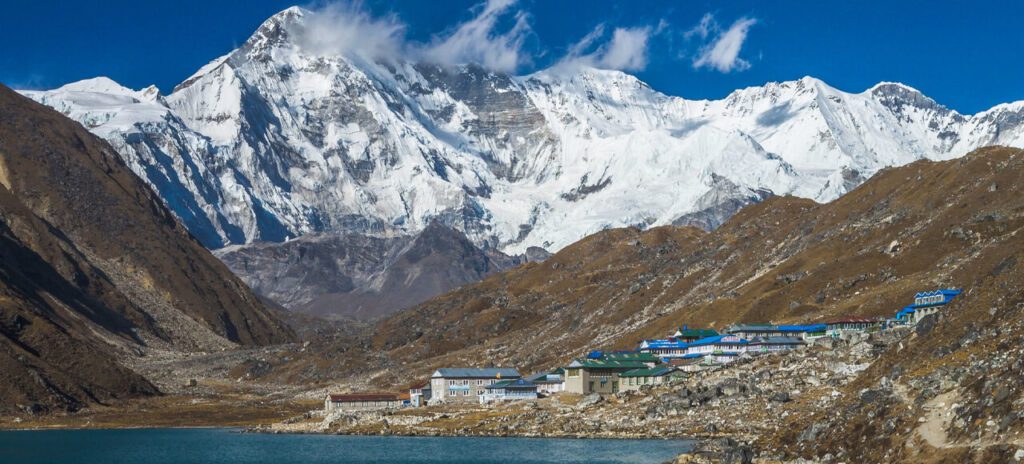
Typically, the trek takes around 19 to 22 days to complete . It is important to note that altitude sickness is a real concern on this trek, so acclimatization days are necessary to avoid any potential health risks.
How Far is the Trek to 3 Passes?
Three passes trek itinerary- The trek covers a distance of around 160-170 kilometers, starting from Lukla and ending in Lukla. The three passes – Kongma La (5,535m), Cho La (5,420m), and Renjo La (5,360m) – are spread across the trek and are some of the highest points trekkers will reach on this adventure.
How Hard is the 3 Passes Trek?
The Three Passes Trek is considered a strenuous trek and requires a good level of fitness. The trail is a mix of steep ascents and descents , narrow ridges , rocky terrain , and icy paths , which can make the trek challenging. Moreover, altitude can also be a factor and may cause difficulties in breathing, headaches, and nausea.
Also Read: Three Passes Trek Without a Guide
Do You Need a Guide for the Three Passes Trek?
Three passes trek itinerary – It is highly recommended to hire a guide for the Three Passes Trek , especially for first-time trekkers or people who are not familiar with the region. A guide can also provide you with knowledge about the area, help with navigating, and help ensure the safety of the trekker. Lastly, a guide can also help with the logistics of the trek, such as accommodation and food.
When to Do Three Passes Trek?
Three passes trek itinerary – The best time to do the Three Passes Trek is during Autumn (September to November) and the Spring season (March to May) . During these months, the weather is generally stable, which means clear skies and mild temperatures, making it ideal for trekking. However, trekkers should still be prepared for the possibility of snowfall and cold temperatures, especially when crossing the high passes.
Different itineraries for the three passes trek:
Three passes trek itinerary 1:, day 1: arrival in kathmandu.
Asian Heritage Treks & Travel Representative welcome you at the Airport and bring you to your hotel, in the evening you will have time to stroll around Thamel.

Day 2: Sightseeing in Kathmandu
A guide will pick you up in a private vehicle and take you to all the beautiful temples and mesmerizing UNESCO world heritage sites .
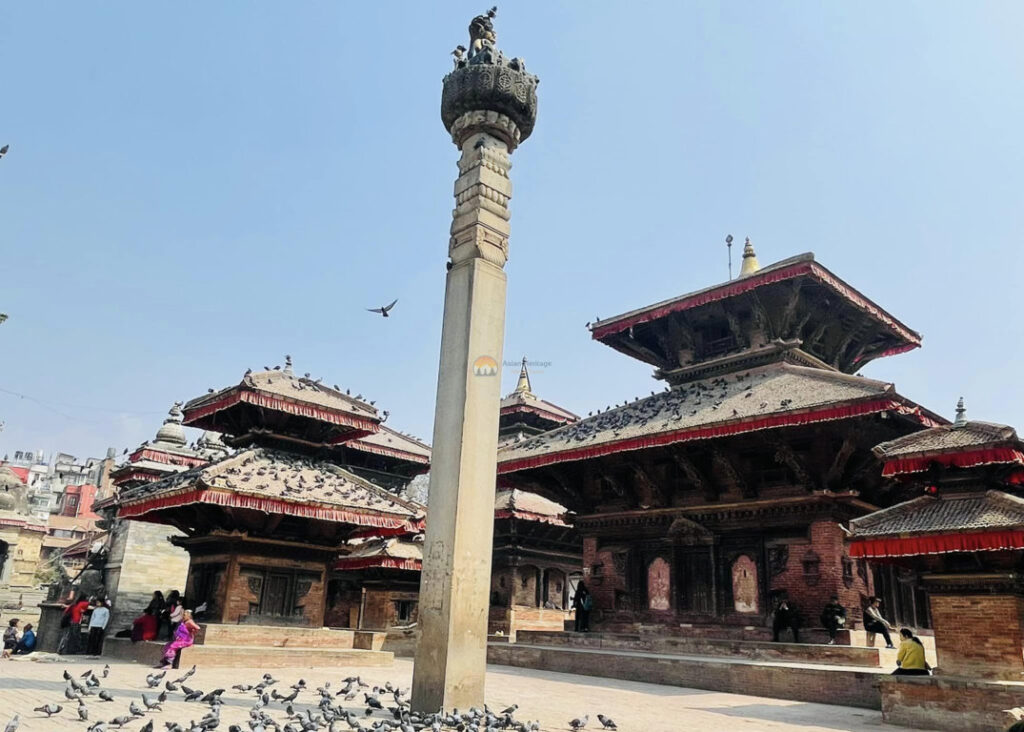
Day 3: Kathmandu To Lukla & Lukla To Phakding (2860 M), Flight Duration: 40 Minutes, Hiking Duration: 3 To 4 Hours
Fly to Lukla from Kathmandu Airport. From Lukla, we commence to climb up towards Phakding. The trail runs along the Dudh Koshi (Milk River). You will be trekking amidst rhododendron forests while smelling the strong aroma of evergreen oak.
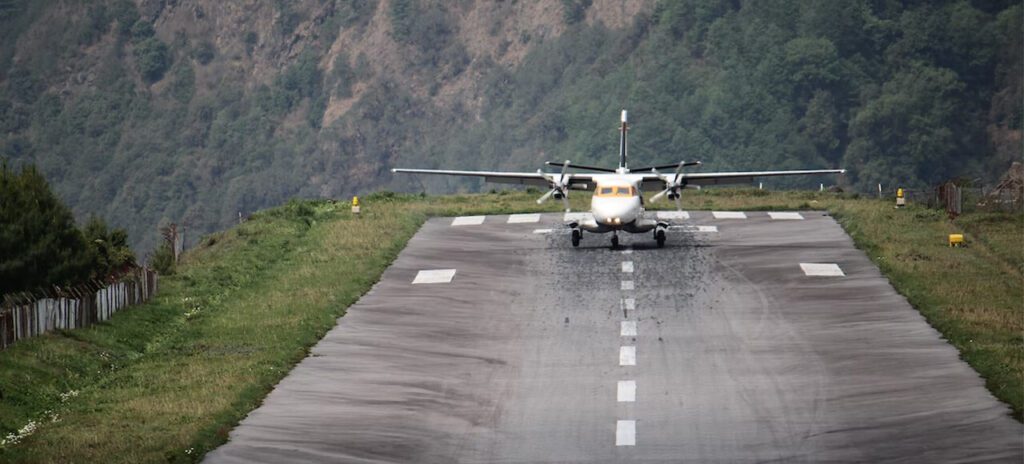
Along the way, you will pass by many villages until you reach Phakding.
Day 4: Phakding To Namche Bazaar ( 3480 M), Hiking Duration: 5 To 6 Hours
You will be able to get your first glimpse of Everest as you are crossing the mighty Dudh Koshi . As you proceed further, the trail will lead you to Monjo, where you could have a stopover for lunch.
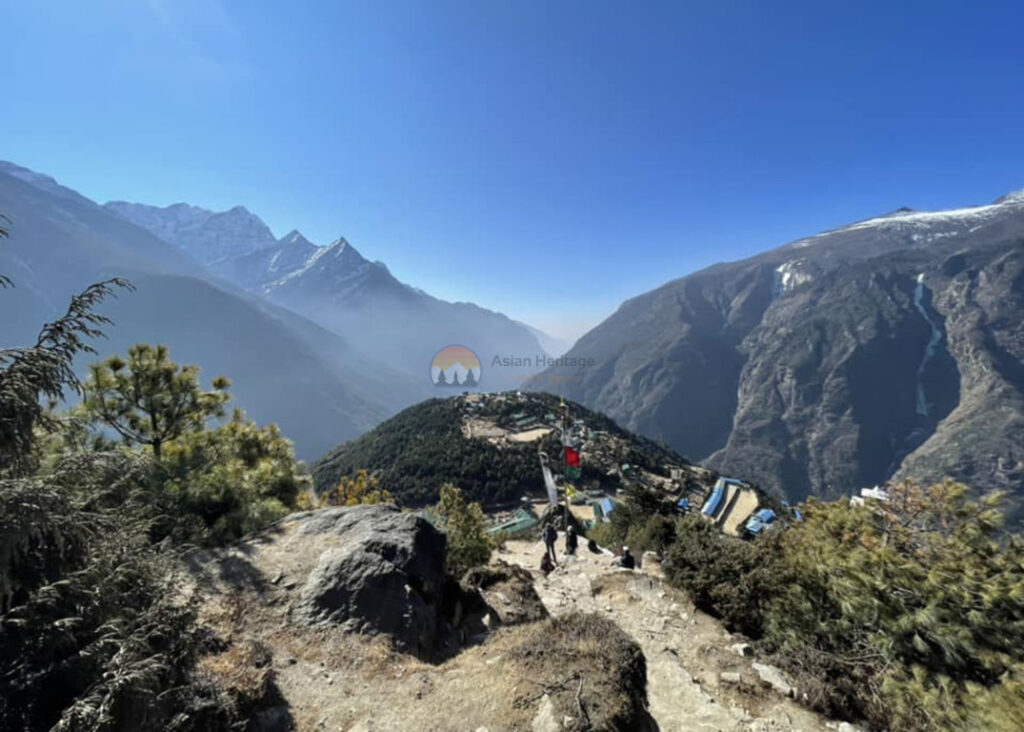
The next part of the trail will be more difficult. You will be making a pit stop at Namche Bazaar to stay the night there.
Day 5: Rest Day at Namche Bazaar
On the fifth day of the Three Passes Everest trek , you can use your time to acclimatize, relax and explore the surrounding places.
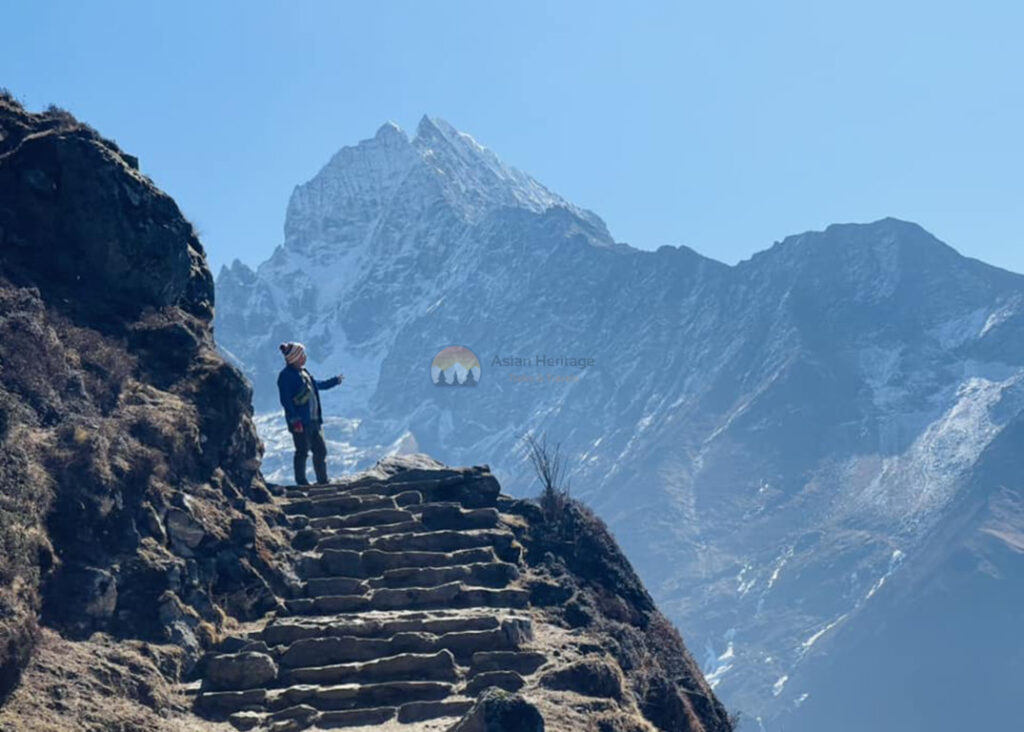
Most of the trekkers prefer to get up before sunrise to view the magnificent views of Mount Everest, Thamserku, Amadablam, and other glorious peaks from the Sagarmatha National Park.
Day 6: Namche Bazaar To Thame (3750 m), Hiking Duration: 5 To 6 Hours
One must be prepared for the drastic and rapid change in climate and temperature – one minute the sun will be glaring fiercely and the next it will be as if even darkness has engulfed you.
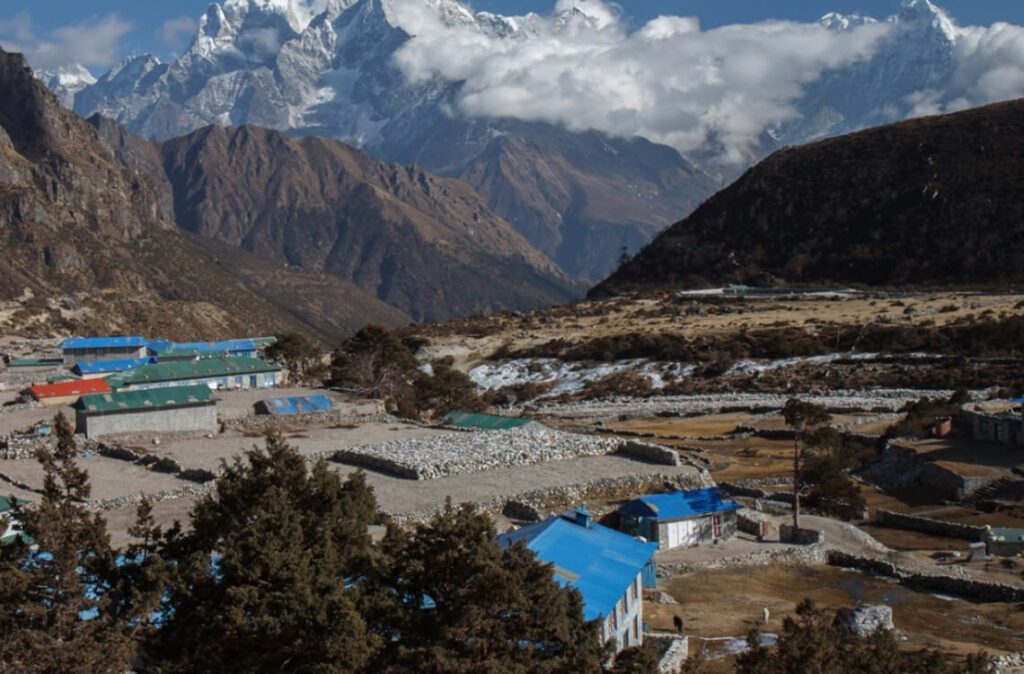
The initial part of the trek is easy-going as it is relatively flat, however, the views will be outrageous. After a few more hours, you will reach Thame. In the neighboring village, Nauje is a small Monastery for Tibetan Nun.
Day 7: Thame To Khumjung (3750 m), Hiking Duration: 4 To 5 Hours
We will begin the trek to Khumjung with an early start, climbing uphill to the monastery above Thame village. If the weather is fine, you will be able to witness a scene where the natural beauty of the majestic landscape combines with the ancient Buddhist culture of the Sherpa people.
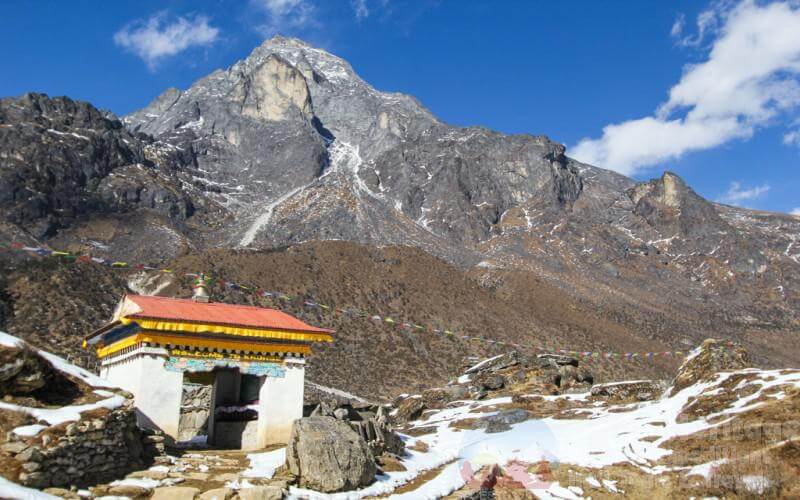
After the visit, you will be heading back in the direction of Namche Bazaar towards Khumbila.
Day 8: Khumjung To Pangboche (3985 m), Hiking Duration: 6 To 7 Hours
Today you will start hiking along the old but still used, Everest expedition trail.
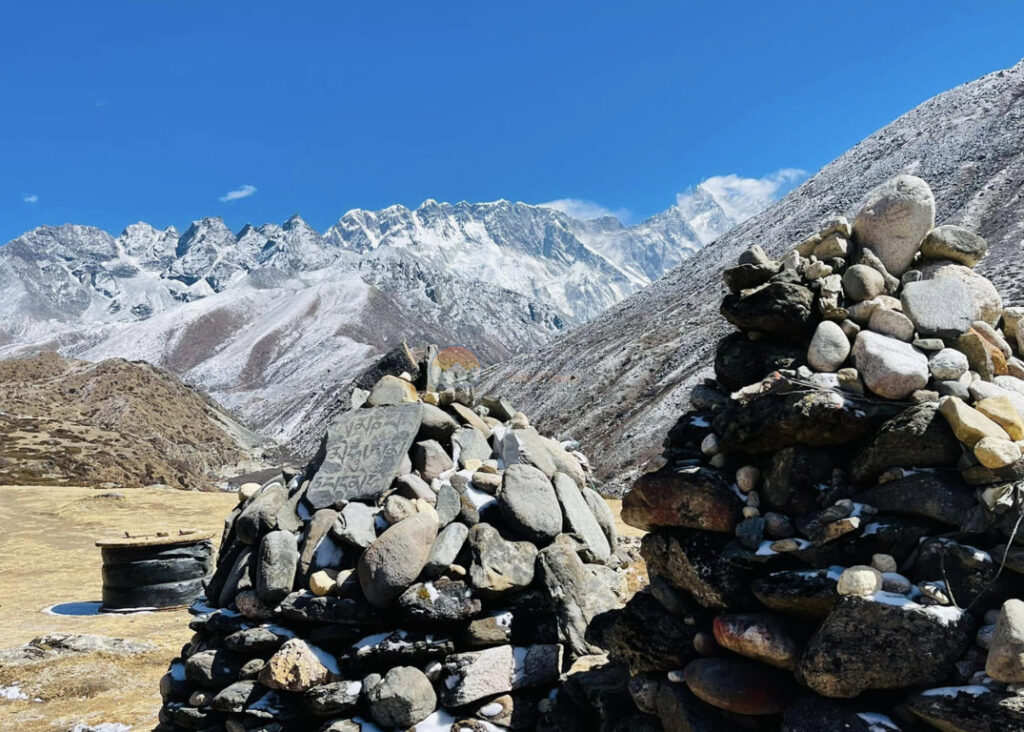
There will be a possibility of you stumbling upon some rich Himalayan wildlife like deer, pheasants, and monkeys.
Day 9: Pangboche To Dingboche (4410 m), Hiking Duration: 6 To 7 Hours
Today, we start our walk towards Dingboche. Dingboche is at an elevation of 4410m so that means the trek is going to be quite challenging due to the elevation and the stones/rocks-filled trail.
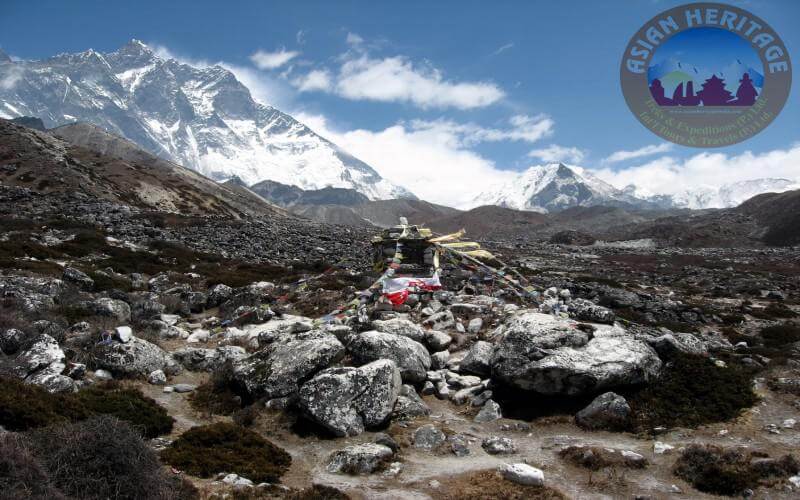
On the way, we will see forests with a variety of lush trees (birch, conifers, and rhododendron) and we will meet lots of yaks during the walk.
Day 10: Dingboche To Chhukung Village ( 4730 m), Hiking Duration: 3 To 4 Hours
After Breakfast, as soon as you start to walk, you will see the amazing mountain scenery which you didn’t expect. You will climb up Chhukung Ri 5,550 m.
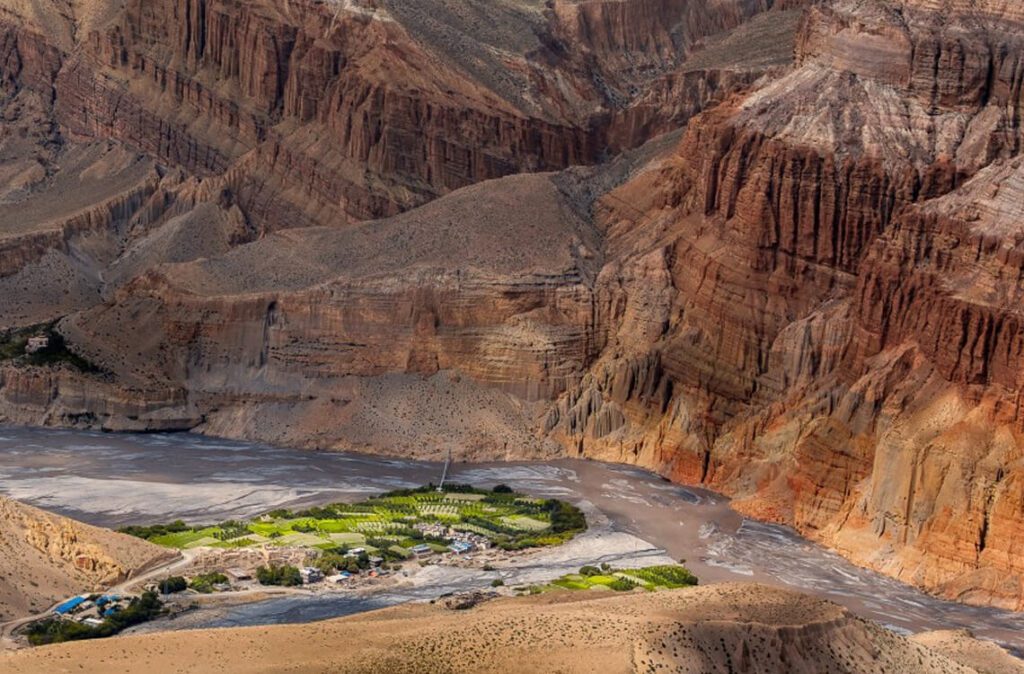
Here, the reward will be valued above our effort as we find ourselves within access to beautiful peaks.
Day 11: Chhukung To Lobuche Via Kongma La (4900 m), Hiking Duration: 7 To 8 Hours
Today, you need to walk quite a bit longer than earlier times. We will cross the first pas called Kongma La (5400m).

Then we will start our trail climbing up to the Niyang Khola Valley.
Day 12: Lobuche To Dzongla (4830 m), Hiking Duration: 7 To 8 Hours
On the way to Dzongla, you’ll also enjoy the scenic Cho La Lake along with the greatest views of Mt. Everest, Mt. Nuptse, Mt. Pumori, Mt. Amadablam, Mt. Thamserku, Mera Peak, and many more.
You may also like: Three Passes Trek Route Facts you may unaware of
Day 13: Dzongla To Dragnag Via Cho La Pass (4700 M/ 5368 m), Hiking Duration: 7 To 8 Hours
Our journey heads towards the Cho La Pass (5368m) which is very vertical and a tough climb that will take around 3 hours over a rocky ridge before you reach the top of the pass.

After crossing the Cho La pass we hike over the glacier across the snow and ice for about an hour. After lunch, we rest for some time and walk down for around 3 hours through the rocky path to Dragnag.
Day 14: Dragnag To Gokyo (4790 m), Hiking Duration: 7 To 8 Hours
After Breakfast, we start walking a trail for 1.5 hours which first leads uphill before becoming an easy walk for a while.

After some rest at the lodge in Gokyo, a short climb to the ridge is needed from where you can explore the amazing view of the Glacier with its small glacier lakes.
Day 15: Gokyo Rest Day
Today, you will enjoy the best day of the entire trail! Although it is called a rest day you will enjoy the surroundings of Gokyo.

Day 16: Gokyo To Renjo La Pass & Lungden ( 5415 m/ 4380 m), Hiking Duration: 4 To 5 Hours
After climbing a steep sandy ridge for about 3 hours, we will reach the top of Renjo La where you have fabulous views of above 7000 and 8000 m high peaks of Everest, Lhotse, Cholatse, and Taboche.
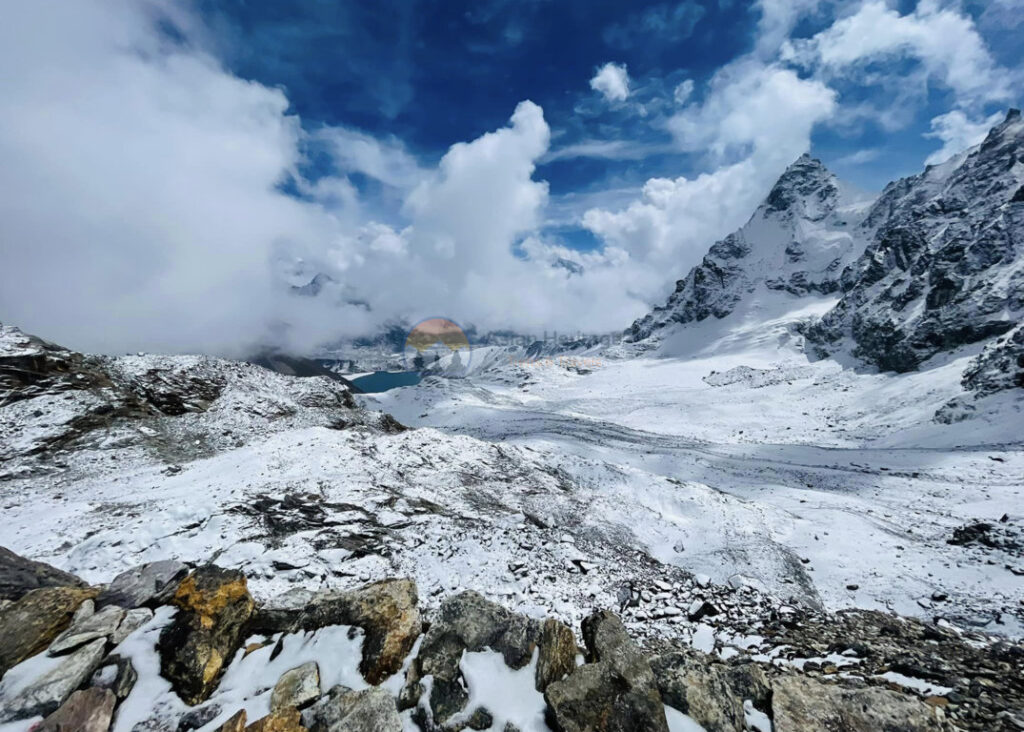
Continuing the pass we will head through the pathway of stone stairs which leads to the south bank of a small serene lake, The Angladumba Tsho. After another 4 hours walk, we reach Lungdun (4,380 m).
Day 17: Lungden To Namche Bazaar (3440 m), Hiking Duration: 4 To 5 Hours
After Breakfast, your day starts with walking downhill through the Rhododendron forest.

The walk continues after lunch towards Namche Bazaar.
Day 18: Namche Bazzar To Lukla (2800m), Hiking Duration 6 To 7 Hours
After having breakfast in a teahouse at Namche Bazaar, we will begin our trek to Lukla.

Day 19: Lukla To Kathmandu
After Breakfast, you have a flight back to Kathmandu.
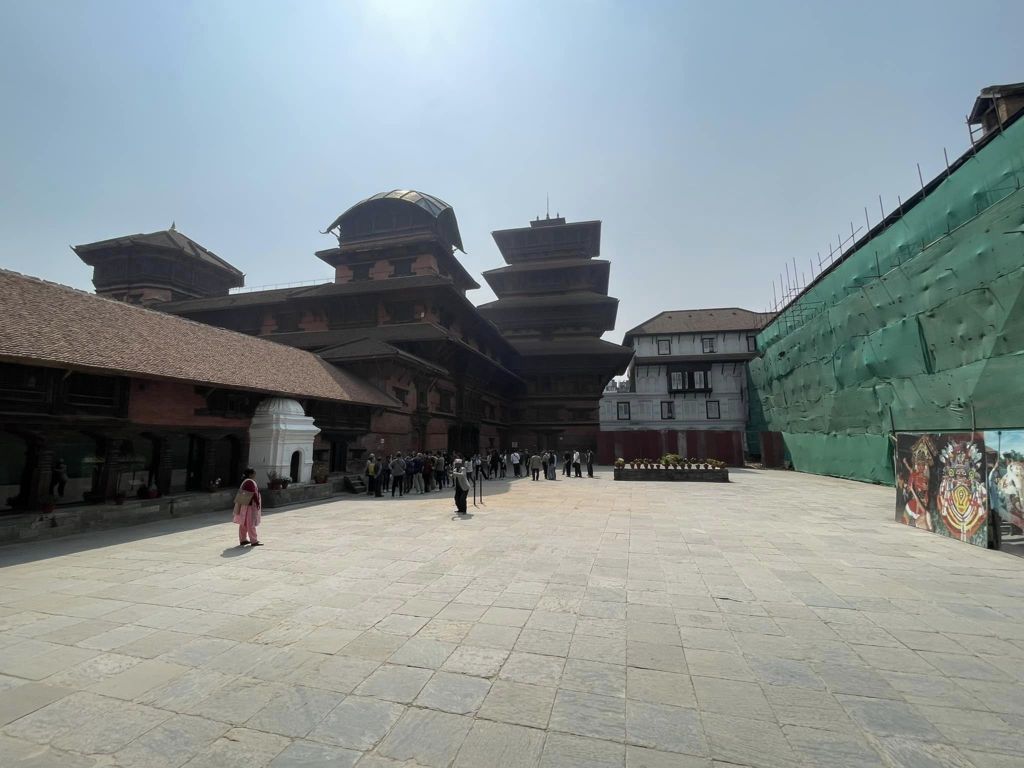
Day 20: Sightseeing Bhaktapur-Patan & Kirtipur
Today our guide will pick you up and drive you to Bhaktapur and visit UNESCO World Heritage Site, Bhaktapur Durbar Square.

Afterward, you’ll be driven to one of the ancient cities inside Kathmandu Valley i.e. Patan Durbar Square for sightseeing.
Day 21: Departure
Our representative will pick you up and drive you to Kathmandu.
Three Passes Trek Itinerary 2:
Day 1 – arrive in kathmandu.
We pick you up from Tribhuvan International Airport today and take you 20 minutes or so to the hotel in Thamel, a vibrant and busy area of Kathmandu.
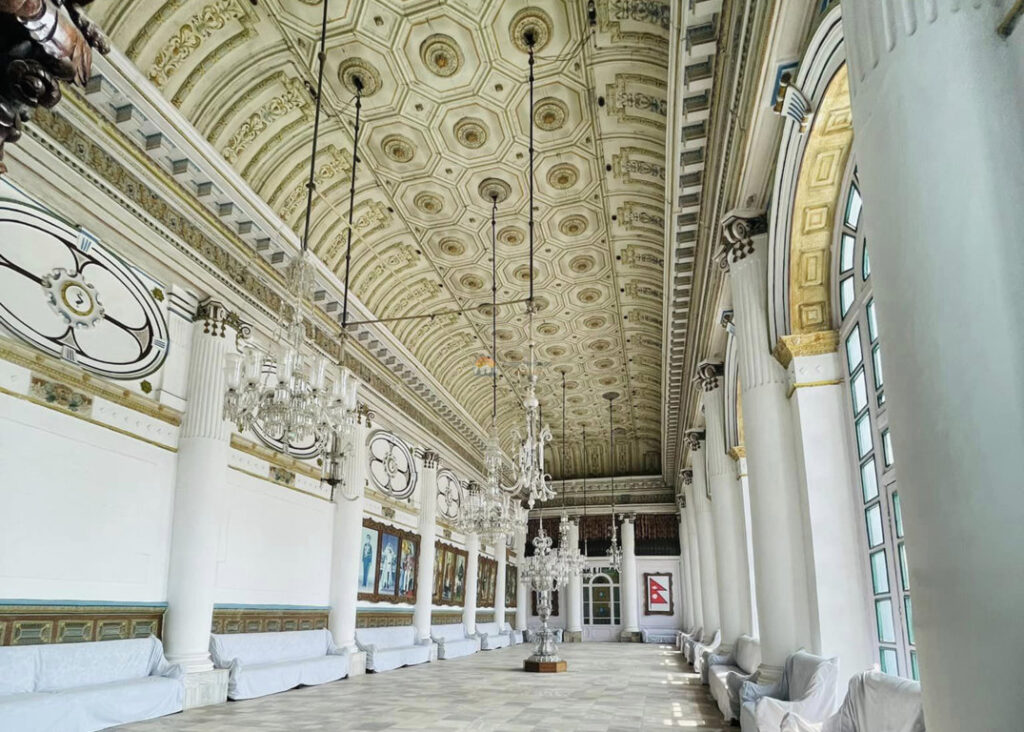
We advise you to spend some time visiting Kathmandu if you aren’t too worn out from your journey. Thamel boasts a variety of trekking gear stores, so you’re covered if you forgot something or want to rent something for your hike.
Day 2 – Drive to Manthali
In order to take a flight from Manthali Airport to Lukla, the starting point of the EBC trek, tomorrow, we go southeast in our personal vehicle this morning to reach the charming neighborhood of Ramechhap.
More: Lukla Airport: Runway Length, Crash, History & More
Day 3 – Trek to Phakding
This morning, we fly in a little plane to the mountain village of Lukla from Raemchhap in an exciting and brief journey to the east. The flight itself is a special experience with breathtaking mountain vistas.
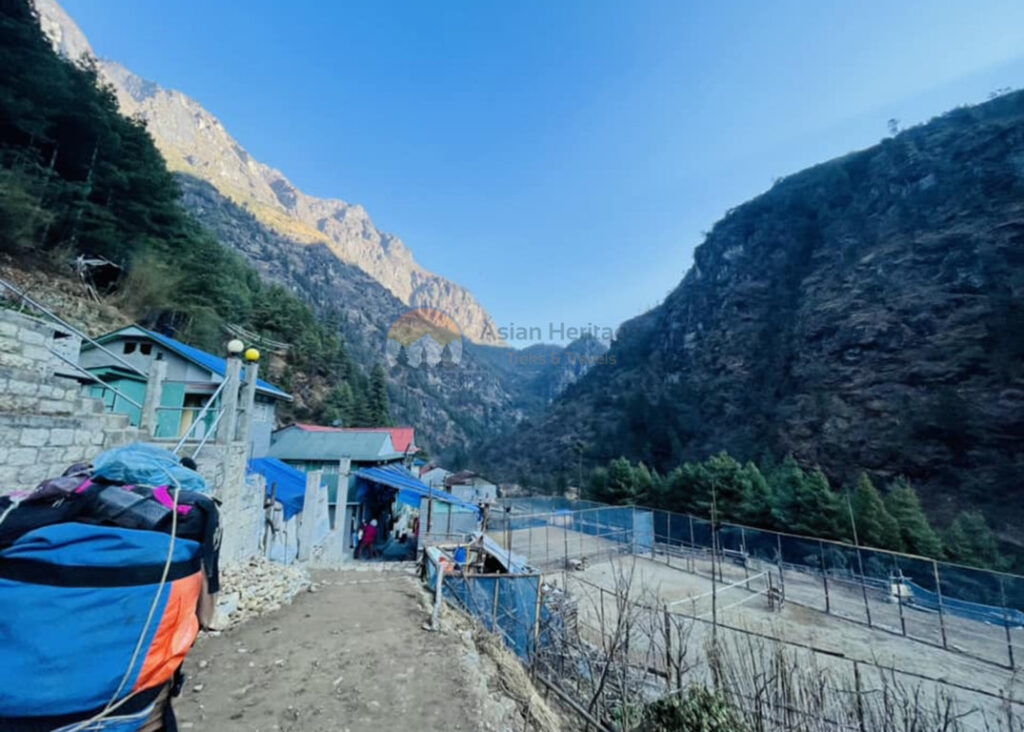
Following the completion of our scenic flight, we seamlessly transition into the next phase of our adventure. Swiftly donning our daypacks and entrusting our duffel bags to yaks for transportation, we embark on foot. This segment of the journey unfolds amidst breathtaking beauty. The enchanting and wooded Dhudh Kosi river valley greets us swiftly, and we gracefully wind our way up, with the river consistently flowing to our left. Along this picturesque path, we traverse charming Sherpa towns like Surke (as depicted below).
Day 4 – Trek to Namche Bazaar
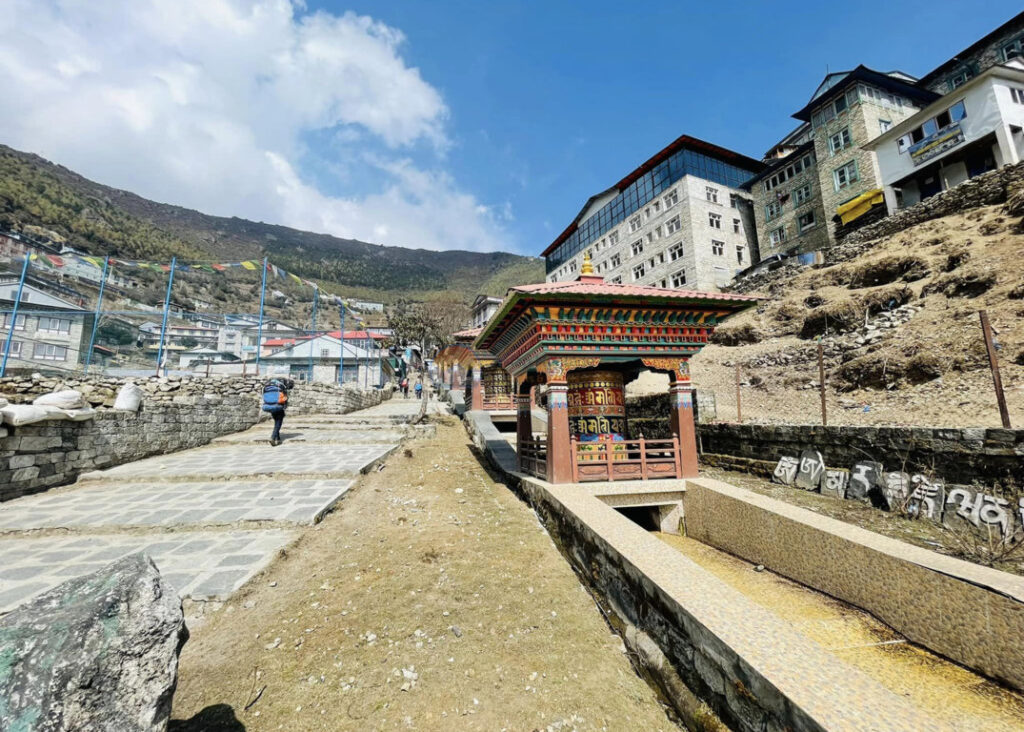
Day 5 – Acclimatisation and Hotel Everest View hike
We remain in Namche today because it’s crucial to give your body time to adapt to the higher altitude. Nevertheless, there are many things you may do, such as going to the Sherpa Museum or a nearby monastery or taking a lovely day trip to the Everest View Hotel for a drink and some snacks.
Day 6 – Trek to Tengboche
Today, in order to go to Tengboche, we travel northeast and up the Pheriche Valley. We travel a considerable distance on a quite flat and pleasant contour path. The trail eventually drops to the valley level.
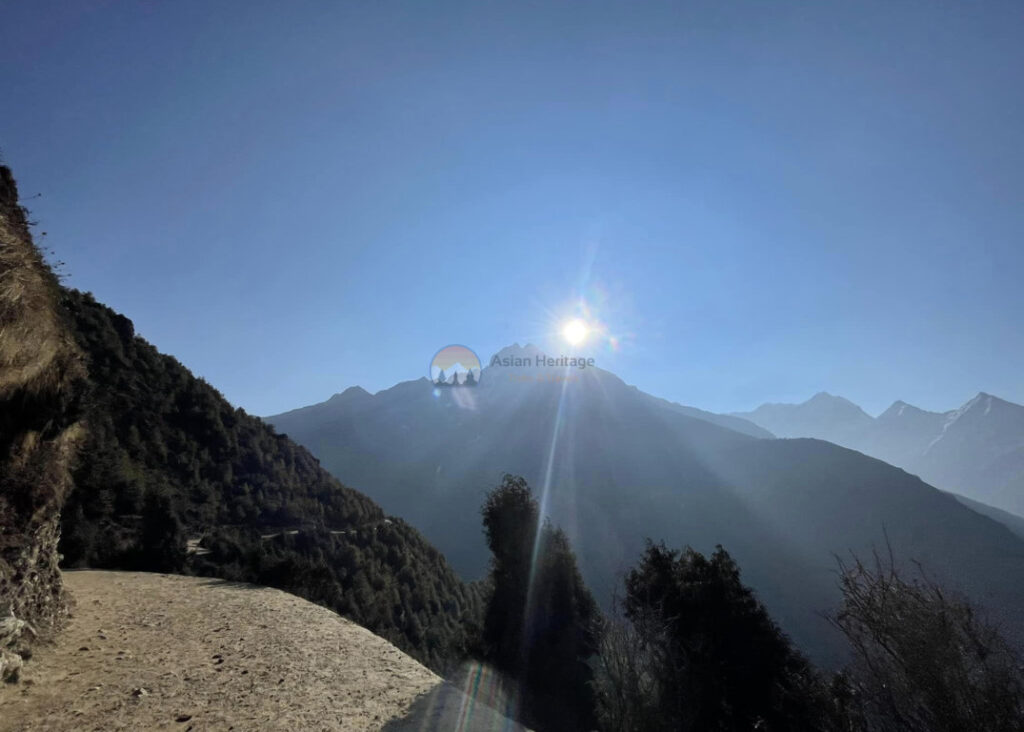
Then there is a steep ascent to reach Tengboche (or Thyanboche), which is perched on a hill at the meeting point of the Dudh Kosi and the Imja Khola.
Day 7 – Trek to Dingboche
We ascend the Imja Khola valley while strolling through forests and taking in ever-more-spectacular vistas of the surrounding snow-capped hills.
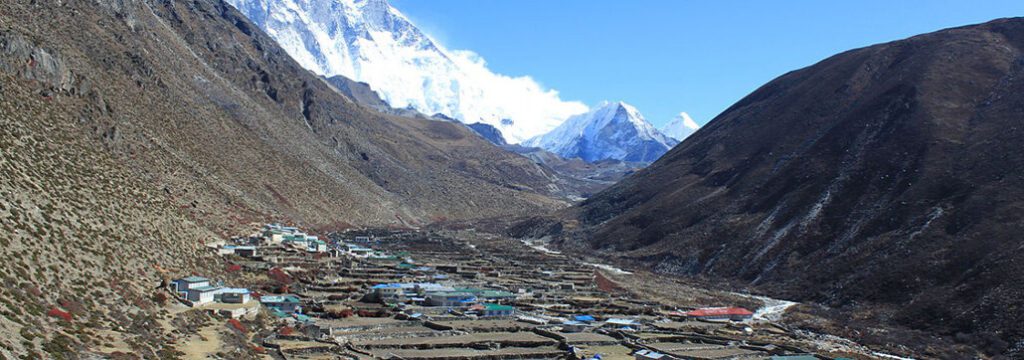
In particular, Ama Dablam and Island Peak are magnificent.
Day 8 – Trek to Chhukung
Today’s expedition promises a smoother experience as we ascend along the Imja Khola valley floor. Transitioning with ease, we’ll make our way towards the settlement of Chhukung (or Chukhung), navigating a relatively gentle incline along the route. The Sagarmatha National Park is quieter here, thus the trail won’t be as crowded as it was till near Tengboche. Until arriving in Chhukung, we walk through farms with stone walls until eventually entering moraine terrain.
Day 9 – Acclimatisation and hike
To let our bodies adjust to the steadily rising altitude, we stay put today and spend another night in Chhukung.
Popular : 19 You Need To Know Before Visiting Nepal
There are a couple of options on the table: go outside and go on a day hike, or unwind inside the lodge with a nice book and excellent company. Then, if we decide to hike, we have the option of climbing Chhukung Ri or visiting Island Peak Base Camp.
Day 10 – Summit Kongma La
Today we tackle our first pass! Kongma La is a challenging mountain pass that’s actually higher in elevation than Everest Base Camp.
As part of the EBC and Three Passes trek, it is also the easternmost and highest pass.
Day 11 – Visit Everest Base Camp!
Today We head northeast after breakfast, to reach Everest base camp.

Day 12 – Climb Kala Patthar
First and foremost, we embarked on the challenging journey to reach Kala Patthar. This ascent, though demanding, promised an extraordinary payoff—a breathtaking panoramic view of the majestic Mt Everest.

Day 13 – Summit Cho La
Now it’s time to tackle our second pass! During the ascent, we cross Cho La Glacier. The top of the pass rewards us with magnificent views to both the east and west. Once again, the descent is steeper than the ascent.
Day 14 – Acclimatisation and Gokyo Ri hike
Today will be a special day because we will hike to the top of Gokyo Ri (Peak) for some breathtaking views!
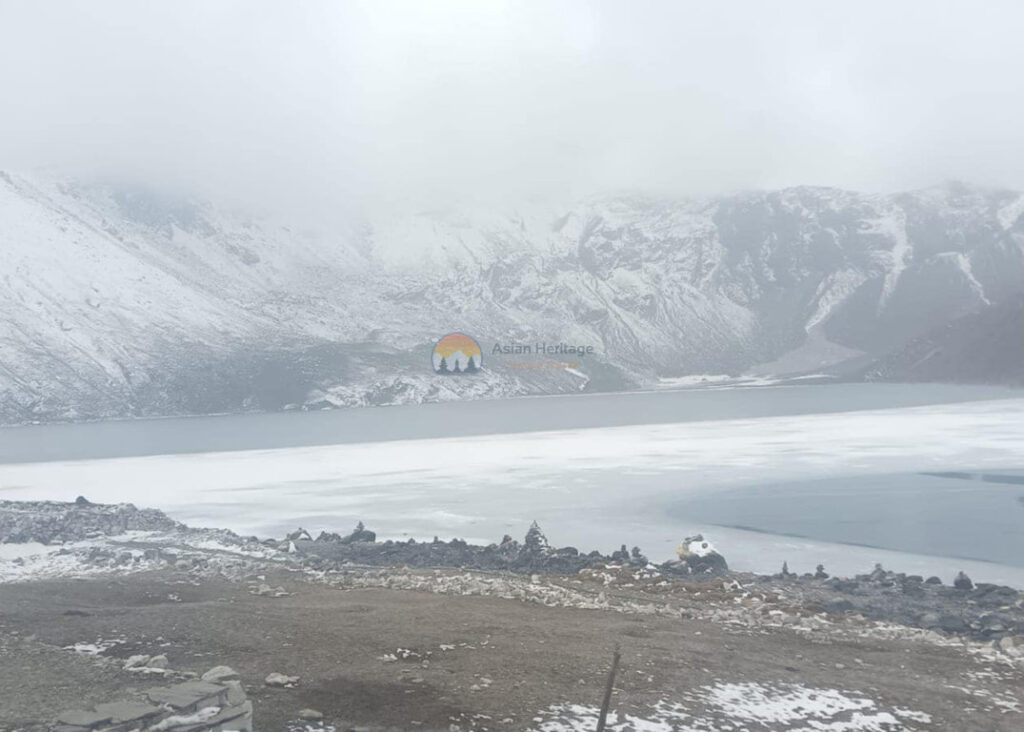
Our hike follows a roughly linear path to the peak and back.
Day 15 – Summit Renjo La
Today we tackle the third and final of the passes on our trek route!
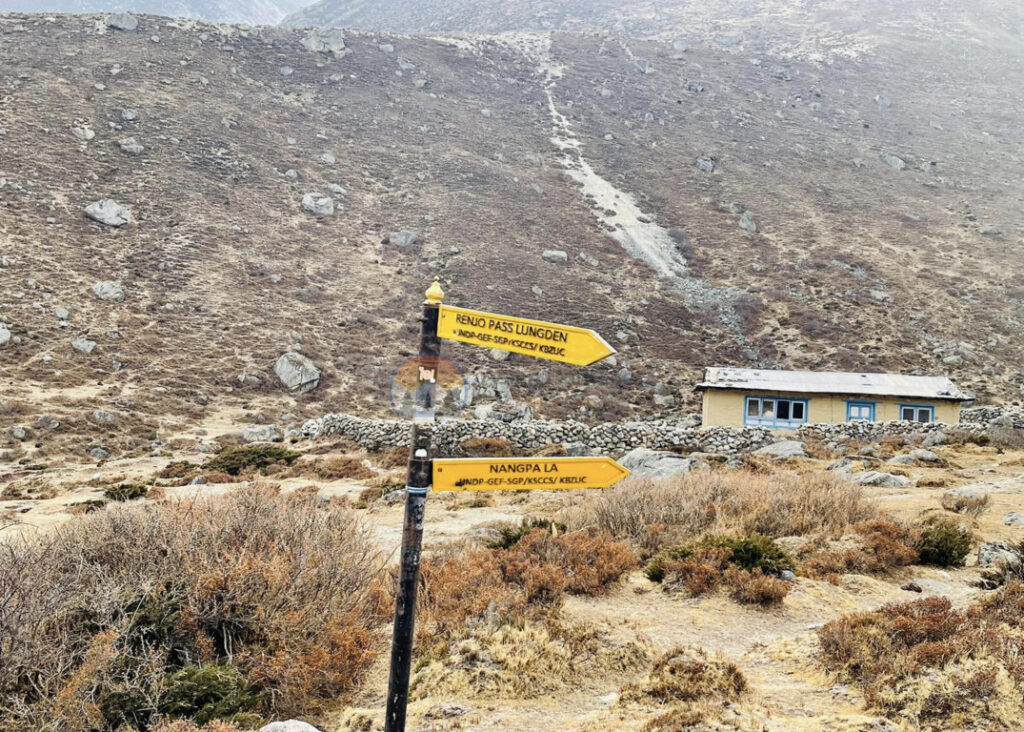
You might even see locals with their yaks using Renjo La (5,360 m), which is not as high as the other two passes. In terms of trekkers, it’s a very quiet pass.
Day 16 – Trek to Namche Bazaar
Today we trek alongside the Bhote Kosi. It starts out with very steep valleys, but further along, they get wider.
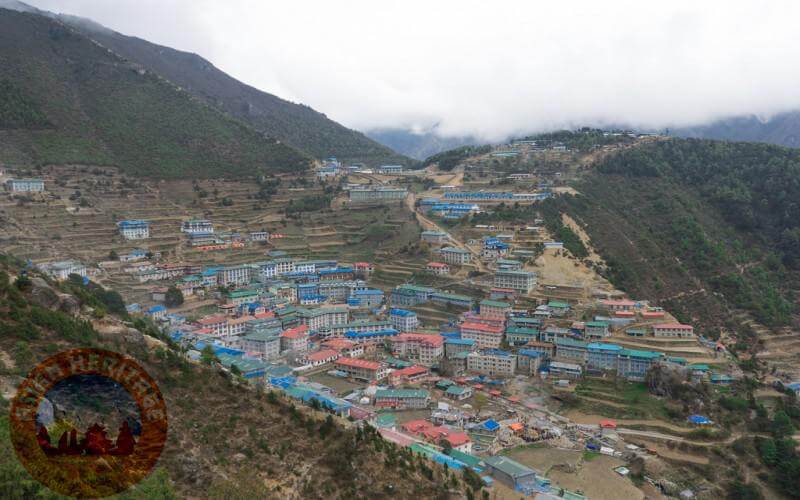
This valley is still less affected by tourism.
Day 17 – Trek to Lukla
We travel from Lukla to Namche Bazaar over two days, where we stopped last night in Phakding for an overnight stay.
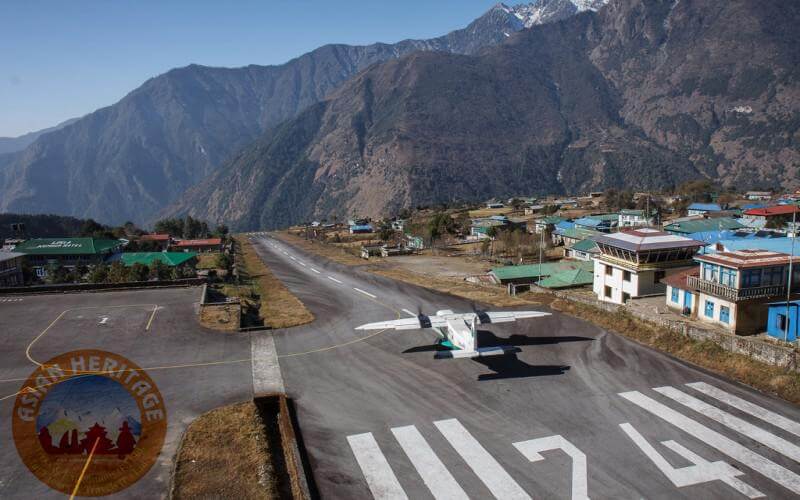
Day 18 – Transfer to Kathmandu
From Lukla, we will fry back to Kathmandu this day.
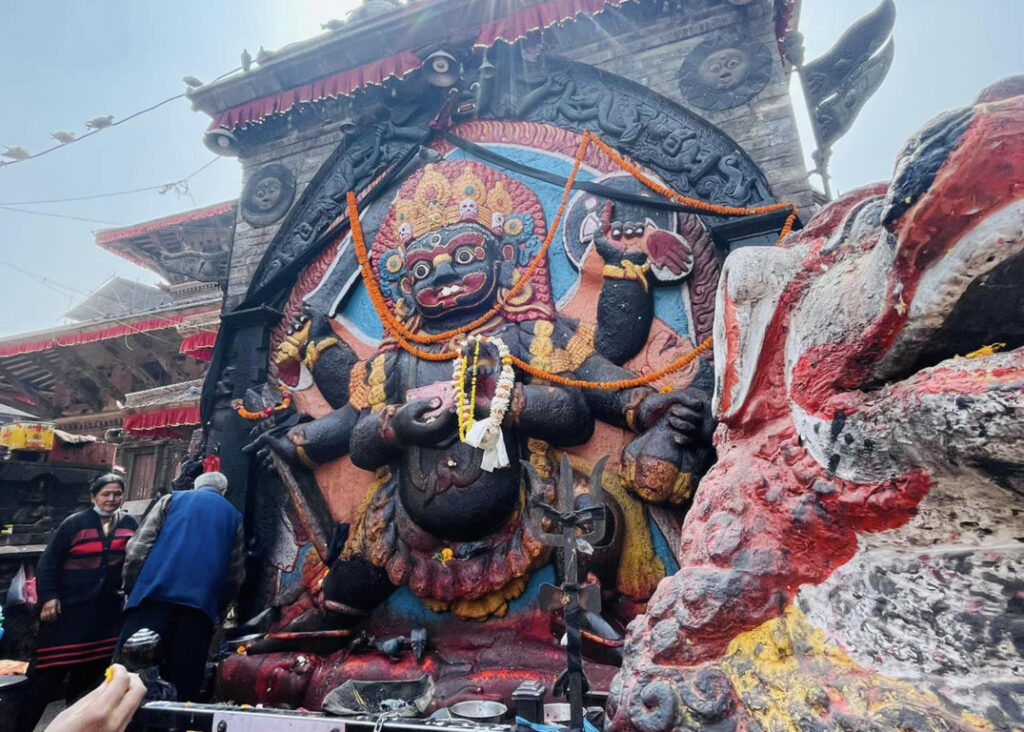
Day 19 – Depart Kathmandu
Leave a reply cancel reply.
Save my name, email, and website in this browser for the next time I comment.
Popular Packages:

Everest Base Camp Trek | 14 Days

Nepal Highlights Tour | 11-Day

Upper Mustang Trek | 18 Days
Related post.


- Everest Base Camp Trek - 10 Days
- Everest Base Camp Trek - 9 Days
Pikey Peak Trek - 8 Days
- Solo Everest Base Camp Trek
- Everest Cho La Pass Trekking - 16 Days
- Short Everest Base Camp Trek - 8 Days
- Gokyo Lake Trek - 12 Days
- Shivalaya To Everest Base Camp Trek
- Phaplu To Everest Base Camp Trek
- Everest View Trek - 5 Days
- Tengboche Monastery Trek - 9 Days
Everest 3 High passes Trek - 19 Days
- Everest Base Camp Via Gokyo Lakes Trek - 19 days
- Everest Base Camp Trek - 12 Days
- Everest Base Camp Trek - 14 Days
- 13 Days Everest Base Camp Trek From Lukla
- Annapurna Base Camp Trek Solo
- Annapurna Base Camp Trek - 8 Days
- Mohare Danda Trek - 8 Days
- Khopra Danda Trek - 7 Days
- Tilicho Lake Via Annapurna Thorong La Pass Trek
- Jomsom Muktinath Trek
- Annapurna Circuit Trek With Tilicho Lake - 19 Days
- Ghorepani Poon Hill Trek - 7 Days
- Annapurna Base Camp Trek Via Poon Hill Itinerary - 11 Days
- Annapurna Circuit Trek Solo
- Annapurna Thorong La Pass Trek With Local Trekking Guide
- Mardi Himal Trek - 7 Days
- Annapurna Circuit Trek - 13 Days
- Dhampus Sarangkot Trek - 5 Days
- Mardi Himal Base Camp Trek - 8 Days
- Annapurna Base Camp Trek - 10 Days
- Gosaikunda Lake Trek 5/6 Days
- Tamang Heritage Trail Trek - 8 Days
- Helambu Circuit Trek - 7 Days
- Langtang Valley Trek Solo
- Langtang Gosaikunda Pass Trek - 16 Days
- Langtang Gosaikunda Short Trek
- Langtang Gosaikunda Helambu Trek
- Langtang Valley Trek - 7 Days
- Ganja La Pass Trek - 12 Days
- Langtang Valley Trek - 8 Days
- Langtang Trek - 5/6 Days
- Tamang Heritage And Langtang Valley Trek
- Tsum Valley Trek - 12 Days
- Manaslu Trek - 16 Days
- Manaslu And Annapurna Circuit Trek
- Manaslu Circuit Trek - 12 Days
- Manaslu Tsum valley Trekking - 22 Days
- Nar Phu Valley Trek Solo - 10 Days
- Nar Phu Valley Trek
- Ruby Valley Ganesh Kunda Lake Trek
- Nar Phu Valley Via Annapurna circuit trek
- Local Trekking Guide Service For Upper Mustang Trek
- Upper Mustang Valley Trekking
- Upper Mustang Trek
- Changu Narayan Nagarkot Day Hiking Trip
- Nagarkot Sunrise View Tour From kathmandu
- Local Culture Tour In Nepal
- Kathmandu Valley Sightseeing Tour
- Volunteer Tour In Nepal
- Mera Peak Climbing
- Paldor Peak Climbing
- Tent Peak Climbing
- Island Peak Climbing
- Yala Peak Climbing
- Best Season
- Acute Mountain Sickness
- Frequently Asked Questions
- Nepal At Glance
- Trekking Equipment
- Travel Insurance
- Nepal Visa Information
- How To Book
- Terms And Conditions
- Booking And Payment
- Privacy Policy
- Why Himalayan Local Guide
- Legal Documents
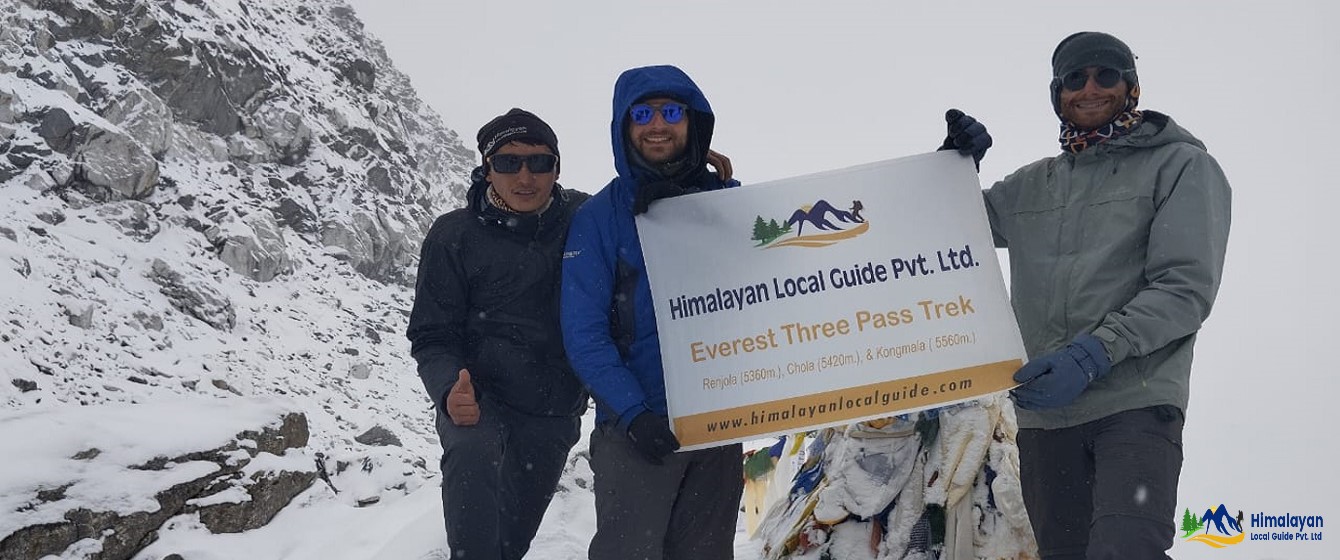
Renjola (5360m) , Chola (5420m) and Kongmala (5560m)
- Cost Inc/Exc
- Departure Date
- Map / Video
- Useful Info
- Everest Region Trekking
Duration 19 Days
Cost per Person US$ 1570
- No. Of Person Per Person
- 2 - 5 $1650
- 10 & Above $1570
Trip Specialist:
- Destination : Nepal
- Activity : Everest Region Trekking
- Duration : 19 Days
- Trip Difficulty : Challenging
- Group size : 1-20 Pax
- Accommodation : Hotel/Lodge/Tea House
- Meals included : Breakfast, Lunch & Dinner
- Transportation : Flight/Car
- Trip starting point : Lukla
- Trip Ending point : Lukla
- Trip Altitude : 5560 Metres
Best season : March, April and May & September, October and November
- A: picturesque Mountain flight from Kathmandu to Lukla.
- Following the Dudh Khosi River.
- Investigate the nearby sherpa's way of life and Typical Houses.
- National: park permit and Pasang Lahmu community fee checkpoint at Monju.
- Delightful mountains view from Gokyo Ri (5,359m).
- Magical: sherpa towns of Phakding, Namche, Tengbuche, Dinbuche, Chhukung, Labuche, Gorakshep, Zhong la, Gokyo, Thame, and Lukla.
- We: the chance to explore the old Sherpa Museum in Nache Bazaar (3,445m).
- Hike to Everest View Hotel (3,870m) and the colorful village of Khumjung.
- World's most elevated air terminal Syangbuche.
- Antiquated Buddhist Monastery in Tengbuche.
- Wonderful: a perspective on mountains from the 3 three passes (Renjo La, Cho La, Kongma La pass, and so on).
- Golden: colorful sunrise and sunset view from Kala Pathar (5,545m).
- Explore Everest Base camp (5,306) and take a picture with the Khumbu glacier and Mountains.
- Untamed: life creatures like Musk deer, Himalayan Thar, Mountains Goats, and Monkeys.
- High: Passes of Cho La (5,360m), Renjo La (5,420m), Kongma La (5,560m).
- An: Excellent Gokyo Lake, Everest Base camp, Kalapathar.
- Khumbu: Valley customary house and culture.
- Professional and knowledgeable guide team.
- Sample Itinerary and Everest 3 Passes trip route Map.
- Airport pick up and drop off services.
- Farewell dinners in Kathmandu.
- Safety: and security during the Everest high pass trek.
- No hidden cost.
Trip Overview
Everest three passes trek nepal 2024-2025:.
Your 19 - Days Everest Three passes trek included: the Renjola (5360m) , Chola (5420m), and Kongmala (5560m) passes in the Everest region have been extremely popular these days. The trek is thrilling and challenging as well as breathtaking scenic Mountain Vistas. The Everest Three Passes trek Itinerary is Designed for those trekkers. Who is looking for a super demanding trek in Nepal? From the Renjo la Pass top, you have a magnificent view of the world's highest Mount Everest (8848m) , Makalu (8463m), Lhotse (8516m) , and Cho Oyo (8201m) . Not; only eight thousand highest peaks but many other tiny mountains are seen in the regions of most stunning peaks like Amadablem, Pumori, Cholatse, Khumbutse, Khangtega, Labuche East and West, and many more.
Everest Three Passes Trek Route:
Three Passes trek trails take you throughout the moraine and you will finally reach the lap of the top mountain in the world Mount. Everest thus, you will have plenty of chance to explore the Himalayas region. Capture the picturesque beauty of the mountain. Walk through a snowy trail. Stony and Sloppy Hills moreover no doubt walk around the unique lifestyles of Sherpa ethnic groups. The Buddhist monasteries are located in high elevations, with birds, animals, flora and fauna, and several more. With all the features, the Everest High Passes trek has been one of the most difficult trails since the trekking revolves approximately the high elevation areas. However, the trekking trail is well-developed. Where there are lavish places for taking rest, therefore even a characteristic person also chooses this trekking package.
19 - Days Everest 3 High Passes Trek Itinerary begins with a short flight from Ramechhap or Kathmandu to Lukla and follows the traditional trail alongside Phakding. A trek continues next to the Dudh Koshi River. Namche Bazaar next. It makes it through Dingbuche, Chukkung, Labuche, and finally, the trail takes you to Everest base camp then making an excursion around you will return to Gorekhshep, then we will climb to Kalapathar head to Zongla and will cross Chola pass Gokyo Renjo la pass and to Thame Valley descending the Bhote Koshi river then reach to Namche and Return Lukla and finally fly to Ramechhap or Kathmandu.
Is it possible to do the Everest Three Passes trek without a Guide?
It is possible to the Everest High Passes trek without a guide. In some parts of restricted locale trekking routes in Nepal, without a Government-registered license holder guide, not permitted trek, trekkers should hire a license holder Guide. However, on this trip to the Everest region, independent trekkers can do without a guide. But, we do not want to recommend the Everest 3 Passes trek without a guide and porter team. Because there are miserable trekking trails during snow-covered along the journey, icy, difficult, slippery, and High Pass.
What is the whole Distance of the Everest Three Pass trek?
The total distance of the Everest three-pass trek is 166km (103 miles), which it is depending on the route you trek as well as the side trips along the journey. This distance normally you need to complete within 19 to 23 days required including the rest and acclimatization days. The daily trekkers walk approximately 10 to 15 Kilometers with varying levels of elevation improvement and loss.
Trekking Permit Types:
This trip required two types of permits.
- The Sagarmatha National Park permit.
- Pasang Lhamu Community Entrance fee.
Both Normal permits cover the whole Everest region trekking, but if you wish to do peak climbing or Expeditions, you ought to buy a Special Permit.
Is Everest 3 High Passes Trek Difficult Route?
The Three High Passes Trek is Nepal’s superior trekking destination in the Himalayas, and it is also a moderately difficulty trek. Most trekkers require good health, and sensible physical fitness is essential for this trip as you are going to over 5,000 meters in altitude. If your physical fitness is good, then I am 99% certain you will be able to complete this circuit. It’s one of the most significant to drink a lot of water and get plenty of rest to let your body adjust naturally to the improved altitude. As always, your local trekking guide will take care of your adjustment and make sure that you take pleasure in a safe and rewarding trek to the Nepal Himalayas.
We are offering, if you are looking for further adventures or to spend additional days in Nepal, Himalayan Local Guide Pvt. Ltd is conceited to present diverse routes for you to think about. Travelers/Trekkers extra time will find our Trip packages to Everest Base Camp Trek , Everest Base Camp Gokyo Lakes Trek , Phaplu to Everest Base Camp Trek - 18 Days , Shivalaya to Everest Base Camp Trek - 19 Days
Trip Itinerary
Day 01: arrival in kathmandu (1350m/4,429feet)..
Our company staff will come to pick up; you up at Tribhuvan international airport. Our guide will stand up; your name on paper so it will be easy to know each other at the airport terminal gate. He will take you to your hotel by car or van: depending on the group size.
Day 02: Kathmandu — Tenzing Hillary Airport — phakding (2640meters/8,661feet).
- Breakfast, Lunch & Dinner
- Hotel/Lodge/Tea House
- Fly/ walking
Our trek to Everest Base Camp, after landing at Tenzing Hillary Airport Lukla and heading to Phakding village is going; to be exhilarating as it will be our first day of the trek. After our beautiful and scenic 35 minutes flight from Kathmandu to Lukla, we will start our journey through pass the delightful villages; of Chaurikharka and descent towards Ghat village. Then trek continues to reach Phakding. Today will be short and easy hiking day. After, we can explore the Buddhist monastery, or you can prepare the trekking equipment for the long journey Overnight at Lodge.
Day 03: Phakding — Manju — Namche Bazaar (3445meters/11,302feet).
Early morning breakfast. We will trek continue along the northern bank of the Dudh Koshi River side with the beautiful views around; there. We pass the beautiful village of Tokto, Benkar, and Monju are checkpoints. We will buy the Sagarmatha National Park entry fee, after which we will cross the suspension bridge and reach Jorsalle Village, passing through the delightful riverside with pine forest. Then we will be ascending; and ramble on the pine forest to reach Namche Bazaar Overnight at Lodge.
Day 04: Acclimatization day at Namche.
After breakfast, we will be hiking to the Everest view hotel. 1st part that; has to ascend to reach the viewpoint from there is the blue skies. We will be able to see the delightful mountain view like; Mt. Everest, Nupste, Lhoste, Ama Dablam, Thamserku, Kusumkangaru, and many more mountains, after then we go to visit the Khumjung village is one of the colorful villages in Khumbu region, explore the Sir Edmund Hillary School, ancient Buddhist monastery and back to Namche Bazaar. Overnight at the same place.
Day 05: Namche – Tengbuche (3870meter/12,696feet).
Today our journey will be more exciting, and chance to see the magnificent Himalayas view the top of the world’s highest peak Mt. Everest, Lhotse, Ama Dablam, and Thamserku on the way to Tengboche. The trail goes up and down the trek not easy. But we’ll be getting a vast view of the Himalayas as well as we will be chances to see the wildlife animals on the way such as Himalaya Thar, musk deer, Nepalese National birds of Pheasant and many more and our future trek down, passing through the dense pine forests, after then we will reach to lunch place we called phunky Thanga. Then we will trek to climb up reach; to Tengbuhce Village, when we get to the Hotel. We leave our luggage in the room. We can go to visit the monastery. The Tengboche monastery is one of the biggest Monasteries in the Khumb region.
Day 06: Tengbuche — pangbuche — Dingbuche (4320m).
After breakfast, today we’ll be heading towards the amazing trail on the way to Dibuche, Pangboche village, and Somare, passing thoughts the beautiful many Chortens and mani walls on our way. If the blue skies. We will be able; to see the magical view of the Ama Dablam, Thmasrku, Lhoste, Nupste, and Island Peak over; there. We will trek into the riverside and trek towards Dingboche overnight at Lodge.
Day 07: Acclimatization day at Dingbuche.
Today will be 2nd acclimatization in Dingboche. Beautiful breakfast. We will hike up to Nagarjuna Hill, which is above the 5000meters. Acclimatization is most important for trekkers. We are going to high an elevation. We will hike up at around 700 meters and back down; to sleep at the lower altitude. Which helps very much for travelers. If you do not; acclimatize at a high elevation may be; you will get high altitude sickness. That way, it is most important. From the top of the blue sky, we will be able; to see the delightful panoramic close-up view of the white snow-capped peaks of Makalu, Lhotse, Ama Dablam, and Island Peak to make the day attractive at it. Makalu is one of the six of the world’s highest mountains. Hiking Nagarjuna Hill. We trek down to Dingboche overnight at Lodge.
Day 08: Dingbuche – Chhukung Village (4700meters/15,416feet)
- walking/ Hiking
Today will be a more fun day; you walk along the Imja Valley and reach Chhukung village (4700m/15,416ft). It will take around 2 hours. We can have a Lunch break, then we hike to Chhukung Ri (5540m/18171ft), from the top, if the sky is clear, we will able to see the very close-up view of Lhoste, Makalu, Island Peak, Ama Dablam and many more, and back down to Chhukung village, we will stay overnight at Lodge.
Day 09: Chhukung Village – Kongma La Pass (5560meters/18241ft) – Labuche 4910meters/16,108ft)
We start early in the morning, from Chhukung village, as we have to conquest the highest; pass of the today. We take enough water and some dry foods, and lunch packed, because on the way no teahouse. We will enjoy mountain views of nature when we reach the top. We will spend a few hours there taking excellent pictures. After then, we trek descend to cross the Glacier and reach Labuche Village, and we will spend overnight there.
Day 10: Labuche - Gorakshep 5185m/17011ft
Today is a more exciting and hard day. From Labuche, the trail leads to a flat meadow. When following the Khumbu Glacier and shot climbing up. After then, the trail goes into the lateral moraine of Khumbu Glacier to Gorakshep. The trip; offers a beautiful view of the massive Khumbu Glacier and Trans Himalayas. When we reach; Gorakshep. We take off the bag pack at the hotel. We can have a Lunch Break. After then, we will go hiking at the Everest Base Camp. It takes around to go and back 4/5 Hours, and back to Gorakshep overnight at Lodge.
Day 11: Gorakshep - kalapathar - Zhong La (4870meters/15,977ft)
Wake up early morning. After then, we hike to Kalapathar for sunrise and mountain view. We have to climb uphill. Which takes around 2 hours, and if the good weather. We will see the beautiful sunrise views with all the panoramic Himalayas views from Kalapather. When we enjoy nature. We back down to the same hotel we can have breakfast. We trek continue downhill Dzongla. Overnight; at Lodge.
Day 12: Zhong La - Chola Pass - Thangnak Village (4690meters/15,318ft).
The journey will be from Dzong La to Chola Pass is challenging. We will cross the high-altitude pass of Chola. At the top of Chola, you can enjoy a panoramic view of the mountains, and the Cholatse peak looks awesome. The scenery is an attraction fighting for, and all the tiredness would fade away when staying for a while on the top. After we enjoy them, we trek descending to Thagnak Village. We will stay overnight at Lodge.
Day 13: Thangnak Village - Gokyo Lake (4780meters/15,682ft)
Today will be a short and easy day. After the delicious breakfast, we will start our journey to Gokyo village one of the most popular villages located; at around 4800 meters. When; we reach Gokyo. We chance; to explore the Gokyo Lakes, which; are the beautiful lakes in the Everest region, and we will relax with nature. Then, we back to Hotel. We will stay overnight at Lodge.
Day 14: Hiking to Gokyo Ri (5490meters/18,011ft)
Early in the morning, we will hike to Gokyo Ri. From the top; we will catch up on the Sunrise view of all the Himalayas ranges. We will spend a few hours on the top. After, we will take beautiful pictures of the Mountains and Sunrise. Then, we trek descend; to Gokyo. We will take a rest day there.
Day 15: Gokyo Village - Renjo La Pass (5360meters) - Lunden (4300meters/14,104ft)
Early morning, we will start our trek to the crossing of the Renjo La Pass will be more exciting and challenging as well;. Our trek continues into the remote northern valley, where access is restricted, and the scenery is gradually that of the Tibetan valleys beyond the border, also a chance to meet Tibeatn Trades descending from the Nangpa La Pass that leads through the Himalayas from Tibet. We will spend overnight at Lodge.
Day 16: Lunden - Thame (3800meters/13,464ft)
After the delicious breakfast, we trek descending to Thame. Today will be a more fun and exciting day because we are returning to descend, and also. We can meet Tibetan Trade encampments along the way for pictures of an atypical lifestyle. And we trek; continue to Thame. We will stay overnight at Lodge.
Day 17: Thame - Namche Bazzar (3445meters/11,302ft)
Early Morning Breakfast. After that, We continue our trekking following; the flat and descending to the first resting place Thame. After, heading towards Namche Bazaar. We will stay overnight at Lodge.
Day 18: Namche — Phakding — Lukla (2860m/9,383feet)
Today is our final day of trekking in the Khumbu region; we will back; down to Lukla. We will return the same way. Which is what we had used before going to trek. From this direction, the views will be different before entering. We continue downhill Jorsalle, Monju, Benkar, Tokto, Phakding, Ghat, Chaurikharka and reach Lukla overnight at Lodge.
Day 19: Fly Back to Kathmnadu.
If; the weather conditions are good at Lukla and Kathmandu. Then, I am 100% sure we will fly back to Kathmandu. It takes around 35 minutes flight back to Kathmandu. We will drop you at hotels, and upon your request, we can arrange for Kathmandu valley tours of UNESCO World Heritage Sites; Buddhanath Temple, Monkey Temple, Durbar Squares, Pashupatinath Temple, Bhaktapur Darbar Square, Patan Durbar Square, and many more place with professional local tours guide, etc.
Cost Includes
- Airport Pick up and drop-off services( Arrival and departure).
- Both-way domestic flight ticket costs include the guide, Ramechhap to Lukla and Ramechhap.
- Basic accommodations during the three passes trek.
- All foods (B+L+D) main course choose by the menu.
- Nepali Rupees 2000 per person for Pasang Lhamu comunity fee .
- RS. 3000 per head (Sagarmatha National Park permit fee) .
- HLG experienced trek guide.
- Friendly and strong sherpa Porters to help with your luggage.
- Basic first-aid kit Medical box.
- Oximeter to check your oxygen level and pulse.
- Water purification tablets for drinking water.
- Snacks: Cookies, snicker bar, Halls, and seasonal fresh fruit.
- Approval of Certificate after the successful trekking.
Cost Excludes
- Your International flight ticket cost.
- Nepal entry visa fees.
- extra luggage charge cost(limit: 10kg per person).
- Meals and accommodation in Kathmandu.
- Trekking Equipments.
- Travel insurance is just in case.
- Hard and Soft drinks, such as beer, mineral water, cock, Fanta, and Whisky, etc.
- Hot Tea and Coffee.
- Tips for Guide and porters.
Fixed Departure Dates
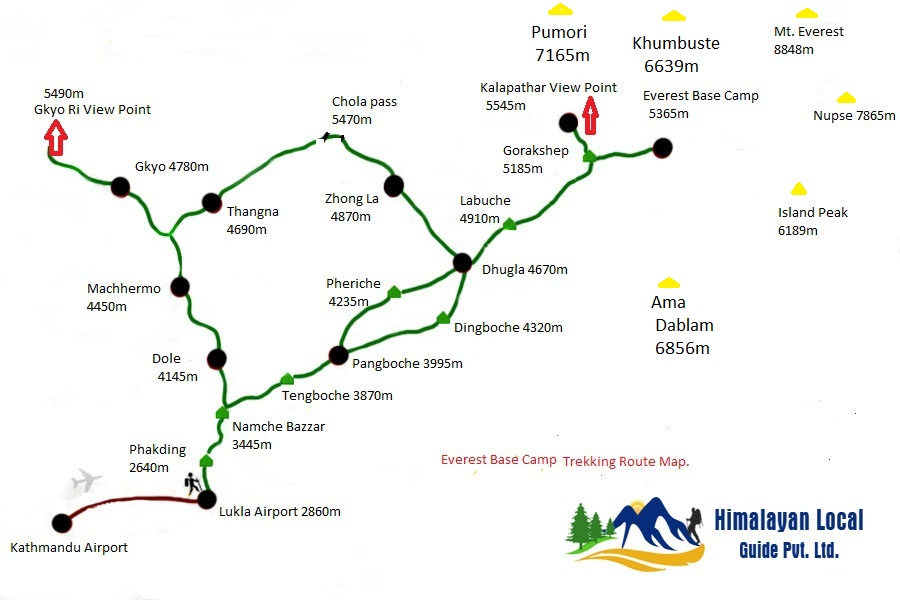
FAQ's Before Travel
How to Book the Three Passes Trek with the Himalayan Local Guide Team?
While you confirm your trek, you have to pay the 15% trip cost deposit via Bank transfer or Western Union Money transfer with a photocopy of your passport. After receiving the payment, we will send you a final confirmation email.
Do I need to Travel insurance?
Trekking to Everest High Pass requires travel insurance , travel insurance allows you to trek above 5000 meters with definitely , and travel insurance is one of the most important for your safety and security during the high elevation.
- Altitude sickness.
- In case any Injury
Therefore, travel insurance is highly recommended for everyone , who wishes to join Himalayan Local Guide Pvt. Ltd, However, make sure that your travel insurance covers your Helicopter rescue and medical treatment.
How much does it Lukla Flight Ticket Cost?
- Kathmandu – Lukla one-way flight ticket cost: 220U$D one way .
- ·Ramechhap – Lukla flight Ticket Cost: 178U$D one way .
Lukla flight:
The Lukla airport is known as the Tenzing Hillay Airport. Lukla is a small town in the Solukhumbu district of Nepal. It is situated at 2800 meters from the sea level.
Flight duration:
It will take around 32 minutes of pretty flight from Kathmandu to Lukla via small aircraft. Lukla airport is small and thrilling so , the flights start early in the morning because the afternoon time can be cloudy.
Flight from Ramechhap to Lukla:
The flight will be from Ramechhap – to Lukla and Ramechhap in the peak season time, due to air traffic at Tribhuwan International Airport, Kathmandu, Nepal.
Ramechhap to Lukla distance is not far away, only 74km , you can fly from Ramechhap – to Lukla – Ramechhap, which will take around 20 minutes one way.
Useful Information
Best season to trek to three passes:.
The best time to combine the three passes trek in the Everest region. The spring and autumn seasons will see more trekkers in this region. Because; of clear weather and merciful climate. The summer/monsoon season will warm & rain, and the winter season will be icy cold. Autumn and springtime will have blue skies and good weather conditions during; the journey.
Temperature range:
The spring season temperature range from 14 to 20 degree on the day, and at night will be around 0 to -5 degree . The autumn season temperature range from 15 to 20 degree day , and at night will be around - 5 to -10 degree .
Three Pass Trek in Monsoon & Winter seasons:
Both seasons require a lot of preparation and dare and risks. As for the trekking trail condition, we arrange three pass treks in the Monsoon and winter seasons as well. Who are physical fitness and want to challenge. However, if you wish to 3-pass trekking in the off-season. Keep: in touch with the Himalayan Local Guide team.
The main Symptoms of altitude sickness during 3 past trips:
- Difficulty sleeping
- Lightheadedness
- Loss of appetite
- Difficult to breath
Necessary documents For High Pass trek:
- Insurance paper.
- Passport-sized Photos.
- Tims Card (Trekking Information Management System Card.
- Sagarmatha National Park entry permits.
- Passang Lahmu Community fee paper.
Tip for Guide and Porters:
After finishing your trek at Lukla; 13% of the total cost of your trek is the average tip to staff , if you are more satisfied with our team, then as you wish more than 13% of the cost of your trek. It's kind and respectful to your helper team. You can tip any amount Dollar , Euro, or NPR, whatever is acceptable.
TREKKING EQUIPMENT LIST FOR THREE PASSES:
Body Clothing:
- Sleeping Bag
- Down Jacket
- Three pairs of trekking t-shirts
- Long sleeved shirts
- Thermal Shirt for Colder place
- Fleece Jacket
- Warm wool Sweaters
- Waterproof and windproof Jacket
- Cotton Trekking pants with folding
- Waterproof and windproof pants
Head and Face:
- Wool or fleece hat
- Sunscreen 50
- Face wipes and towel
List of Foot wears:
- Trekking Boats
- ¾ Paris Preferably Cotton Socks
- One pairs extra Sport Shoes
Necessary Gears:
- Gaiters just in case if snow
- Gloves and Thick Gloves
- Big rucksack above the 40 L
- Waterproof Bag Cover
- Trekking Pole (if you needed)
- Laundry Soap
- Toilet papers
- Water peals
- Bottle for drinking water
- Pen and Note Book
- Copy and Tourist Guide Book
- Battery charger
- Memory card
- Cell Phone and Charger
- Money Wallet
- Altimeters and Playing card
First aid Kid:
- Cotton bandages
- Paracetamol
- Painkillers
- Loperamide to Control diarrhea (just in Case).
- Water purified tablets
- Elastic bandages
- Thermometer
- Moleskin and sling.
Trip Gallery
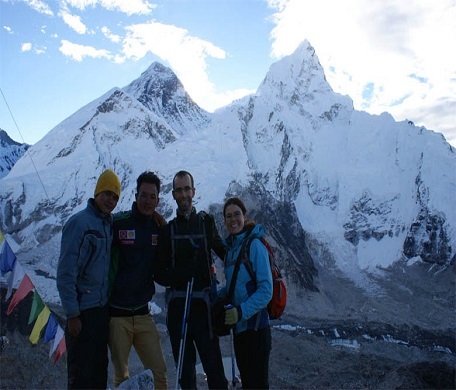
You May Also Like
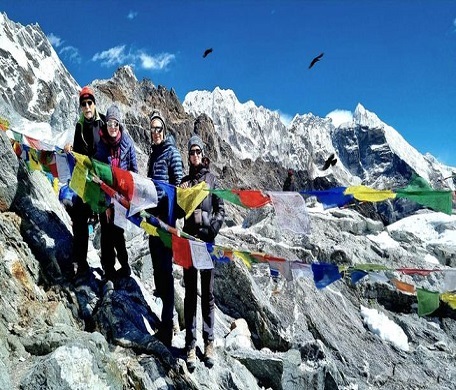
Everest Base Camp Trek
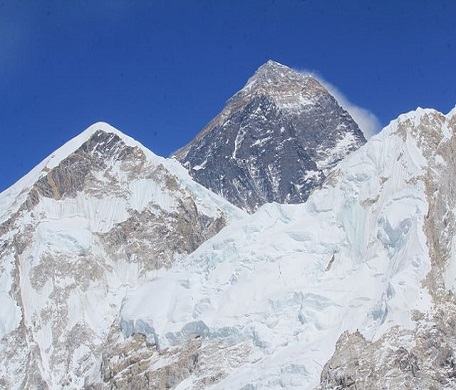
Everest Base Camp Trek -...
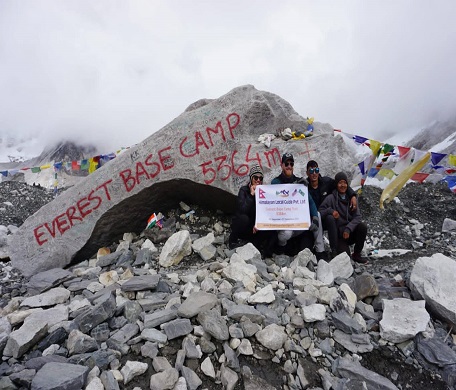
Solo Everest Base Camp Tr...
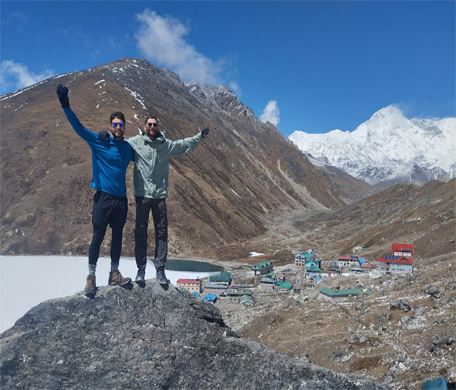
Everest Base Camp Via Gok...
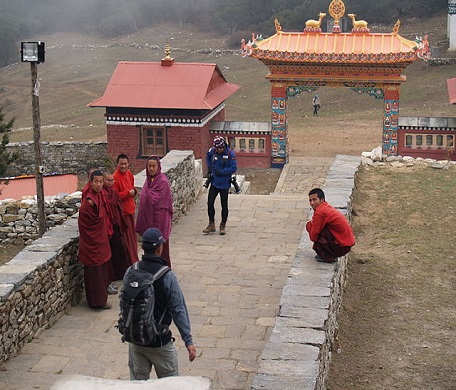
9 Days Tengboche Monaster...
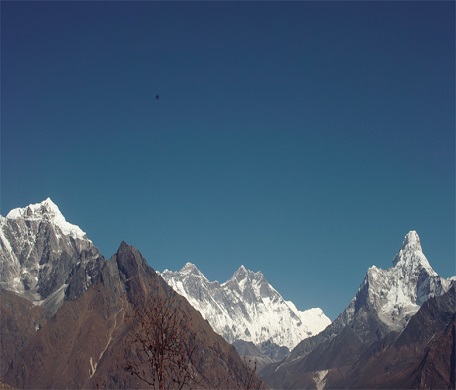
Everest View Trek - 4 Nig...
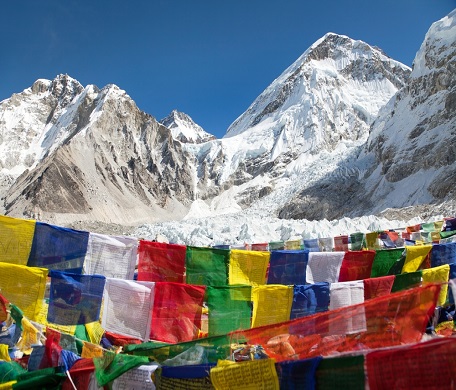
Phaplu To Everest Base Ca...
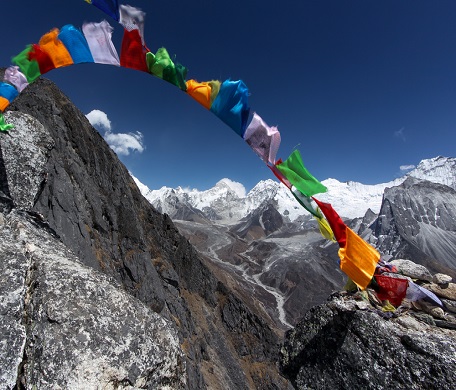
Shivalaya To Everest Base...
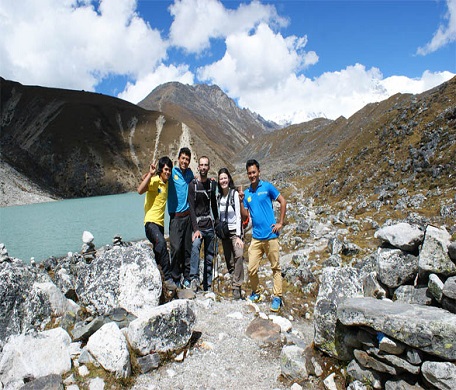
Gokyo Lake Trek - 12 Days...
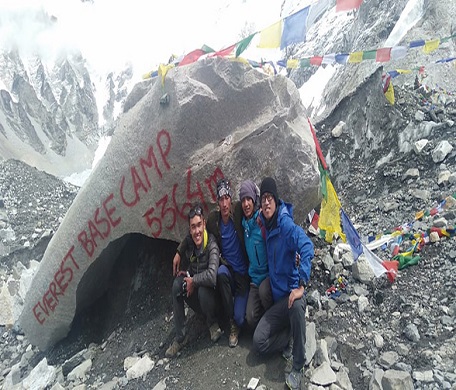
Local Guide Hire From Luk...
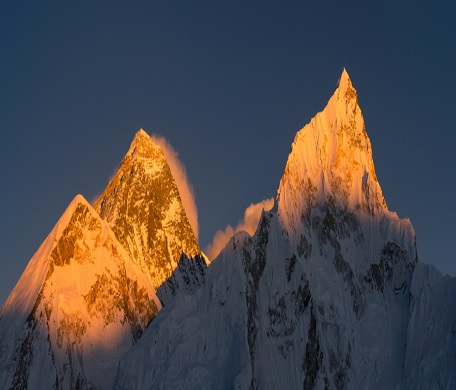
Short Everest Base Camp T...
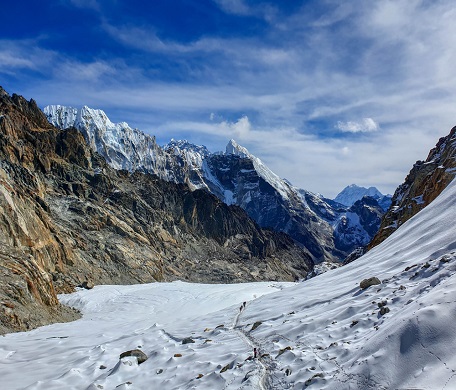
Everest Cho La Pass Trekk...
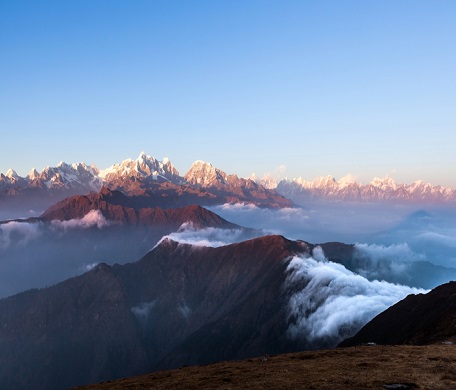
Quick Links
Useful links, booking information, about company.
- Company Profile

Address: Sorekhutte, Kathmandu
Phone: +9779818141334
E-mail: [email protected]
Associated with Following Company
Follow us on folloiwng links, payment options.

© Copyright 2024 Himalayan Local Guide. All rights reserved. | Developed by : Web Design In Nepal
Quick Inquiry
- Africa & the Middle East
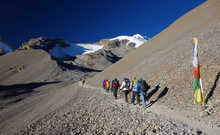
- The Three Passes Trek
- Kandoo Trekking
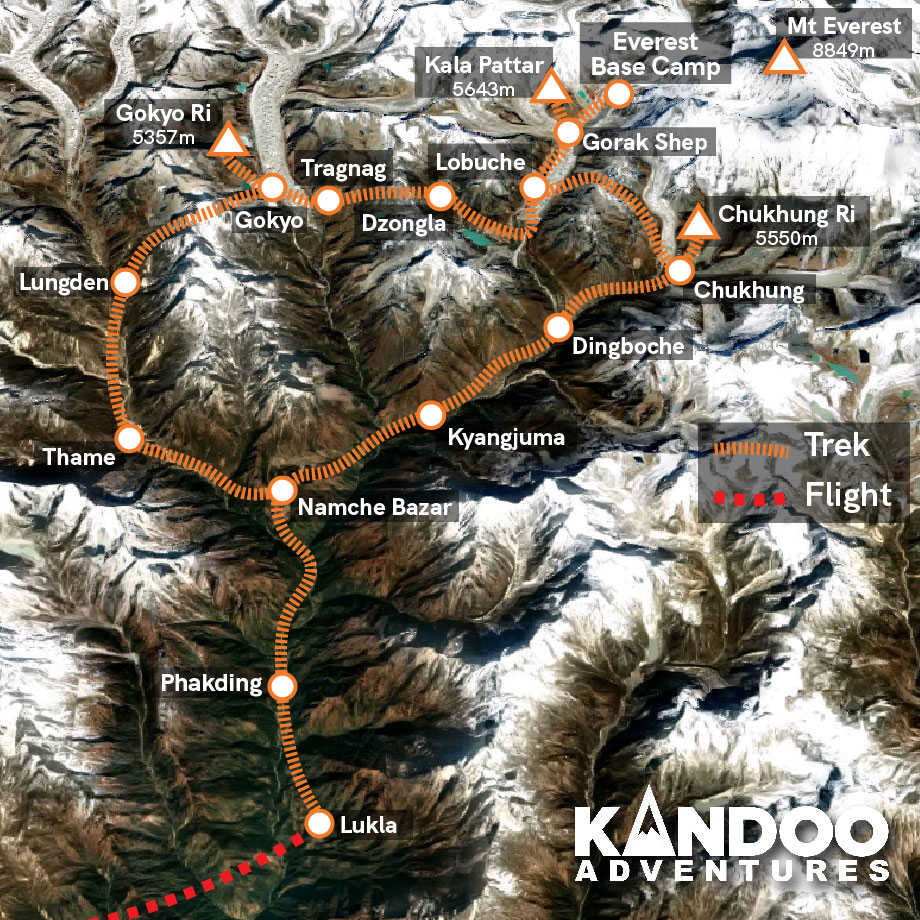
Contact our UK team
Our local team
Kandoo's view, trip highlights.
- An amazingly scenic circular route, climbing three peaks
- Cross the challenging Renjo La, Cho La and Kongma La Passes
- Lodge-based accommodation
Experiences
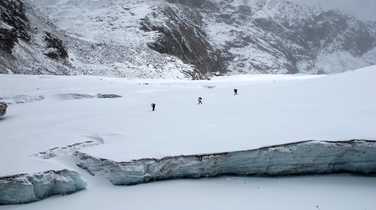
ARRIVE IN KATHMANDU
All trekkers need to organise their own flights to Kathmandu International Airport (KTM). From the airport we will arrange a private transfer to your hotel. That night you will meet your local Kandoo representative and have a full pre-trek briefing
- Accomodation: Hotel
FLIGHT TO LUKLA – TREK TO PHAKDING
The flight from Kathmandu to Lukla takes 45 minutes and is an adventure in itself with great views of the Everest region and ending with a hair-raising landing on a steep mountain runway. After meeting our crew, we will start our trek by heading up the Dudh Koshi Valley on a well- marked trail to Phakding.
- Transport: Flight (0.8 hour, 136 km)
- Hiking time: 3 - 4 hours
- Ascent: 1500 m
- Descent: 144 m
- Max. altitude: 2800 m
- Accomodation: Teahouse
- Meals included: Breakfast
TREK TO NAMCHE BAZAAR
From Phakding, we cross and re-cross the river on high suspension bridges. Beyond Monjo is the entrance to the Sagarmatha National Park. We then ascend steeply to Namche and along the way, if the weather permits, catch the first glimpse of Mt Everest. Namche Bazaar is the main trading village in Khumbu and has a busy Saturday market. You can enjoy an Illy coffee and amazing brownies here!
- Hiking time: 6 - 7 hours
- Ascent: 794 m
- Max. altitude: 3450 m
ACCLIMATISATION IN NAMCHE
Namche is tucked away between two ridges and has lots of lodges, tea shops and souvenir shops. Today we will trek up to the Everest View Hotel at 3880m for our first view of Ama Dablam and Mount Everest. Following the ‘walk high, sleep low’ principle, this hike will really help with your acclimatisation.
- Ascent: 430 m
- Descent: 430 m
- Max. altitude: 3880 m
TREK TO THAME
The trail now splits from the popular base camp route and heads north-west to the village of Thame where you will be staying the night. Take some time here to learn a bit about the local traditions and their intrinsic connection with the mountain on which you are standing.
- Hiking time: 4 - 5 hours
- Ascent: 434 m
- Max. altitude: 3884 m
TREK TO LUNGDEN
Today we will start to climb back up to higher altitude heading up the valley to Lungden. Make sure you have your camera at the ready as the higher you go the views across the snow-capped peaks in the region just get better and better.
- Ascent: 496 m
- Max. altitude: 4380 m
TREK TO GOKYO VIA RENJO LA PASS
Today wewill encounter the first of the Three Passes – Renjo La. The route starts off gently but will soon turn into a hard day of hiking as we near the end of the ascent to Renjo La. Try to think of the magnificent views you will get at the top to motivate you! After the pass, we will descend to the third of the beautiful turquoise Gokyo Lakes and then trek onto the village of Gokyo for the night.
- Hiking time: 7 - 8 hours
- Ascent: 1008 m
- Descent: 638 m
- Max. altitude: 5388 m
ASCENT OF GOKYO RI
Today you climb your first peak, Gokyo Ri, for fabulous views of Cho Oyu. We start the climb early and then have the rest of the day to rest to help our acclimatisation. If we still have energy, then later in the day we can hike up some of the surrounding moraine ridges and enjoy the views. As a treat for all our hard work we can then tuck into some delicious cake from the wonderful Gokyo bakery.
- Ascent: 733 m
- Descent: 733 m
- Max. altitude: 5483 m
TREK TO TRAGNAG
We leave Gokyo to cross the Ngozumpa Glacier. We descend to the second lake and drop down onto the glacier. The route across the glacier is marked by cairns and is generally quite well defined. We climb off the glacier and follow a shallow valley to Tragnag.
- Descent: 60 m
- Max. altitude: 4750 m
TREK TO DZONGLA VIA CHO LA PASS
An early start is required today to cross the Cho La Pass and make the long descent to Dzongla. Continuing up the valley, we cross a ridge and an old lateral moraine, before beginning the rocky scramble to the pass. From the top there are excellent views, across to the Rolwaling Valley in the west and Ama Dablam to the south east. The descent from here involves crossing a small glacier which is fairly straightforward. There are more excellent views of Ama Dablam and Cholatse as we descend.
- Ascent: 730 m
- Descent: 590 m
- Max. altitude: 5420 m
TREK TO LOBUCHE
The way to Lobuche contours the grassy slopes above a lake, the Tshola Tsho, to join up with the main Everest trail from Pheriche and Tengboche. The trail flattens out and follows the valley on the west side of the Khumbu Glacier to Lobuche.
- Ascent: 98 m
- Descent: 4928 m
TREK TO GORAK SHEP – EVEREST BASE CAMP – GORAK SHEP
To reach Everest Base Camp, we follow the Khumbu Glacier. The trail offers superb views of the surrounding mountains, especially where the path is forced to rise to cross a tributary glacier. We stop at Gorak Shep before making our way to Base Camp itself. This takes several hours as the trail weaves its way through ice pinnacles and crevasses of the Khumbu Glacier.
- Hiking time: 8 - 9 hours
- Ascent: 436 m
- Descent: 200 m
- Max. altitude: 5364 m
ASCENT OF KALA PATTAR - TREK TO LOBUCHE
An early morning start is needed to summit the trekking peak of Kala Pattar – the iconic viewpoint of Everest. After snapping some pics, we head back to Gorak Shep for a quick meal before descending further to Lobuche for the night.
- Ascent: 390 m
- Descent: 626 m
- Max. altitude: 5554 m
TREK TO CHUKHUNG VIA KONGMA LA PASS
We leave the classic base camp route today as we head east through the Khumbu Glacier to reach the third and final pass of the trip – Kongma La. At 5,535m the pass is the highest of the three. After a tiring ascent to the top, we descend into the Chukhung Valley and eventually to the village of Chukhung where we will stay in the lodge overnight.
- Ascent: 607 m
- Descent: 785 m
- Max. altitude: 5535 m
ASCENT OF CHUKHUNG RI - TREK TO DINGBOCHE
Today we will climb Chukhung Ri - the hardest of the three peaks on this trek which involves some easy scrambling near the summit. The views from the top down the Khumbu Valley are superb. We descend to Dingboche.
- Ascent: 800 m
- Descent: 1190 m
- Max. altitude: 5550 m
TREK TO KYANGJUMA
We now descend back to the main Everest trail through Pangboche before climbing to the monastery at Tengboche. From Tengboche we make a steep descent before climbing back up to Kyangjuma where we will stay overnight in a lodge.
- Descent: 696 m
- Max. altitude: 4360 m
TREK TO PHAKDING
We continue through Namche Bazaar, descend Namche Hill and cross the Dudh Koshi. We will trek back along familiar paths to Phakding where we will stay the night.
- Descent: 1008 m
- Max. altitude: 3664 m
TREK TO LUKLA
Our final day's trekking follows the Dudh Koshi back down to Lukla. This last evening in the mountains is the ideal opportunity for a farewell party with the Sherpa guides and porters, where you can look back on a memorable trekking experience.
- Ascent: 144 m
RETURN TO KATHMANDU
After an early breakfast, we will begin our return journey to Kathmandu.
FREE DAY IN KATHMANDU
A free day in Kathmandu to explore the city at your leisure
DEPART FROM KATHMANDU
We will collect you from your hotel and transfer you to Kathmandu Airport for your departing flight.
Trip information
Formalities & health, equipment & clothing.
Treks in the Himalaya present a substantial physical challenge , and the more fit you are before you start, the more you will enjoy your trek. However, the number one most important thing to cultivate is mental toughness . Most of the people who trek in the Himalaya aren’t professional athletes or mountain climbers; they are average people with an unusual degree of determination.
If you are comfortable walking for 7-8 hours with an ascent of 1000m every day for two weeks then you are certainly fit enough to succeed on this trek. We find that all successful hikers share a real Kandoo attitude and that means high levels of grit and determination.
Food & drink
You choose what you want to eat at the lodges, and settle your own bill in the morning. While you can eat heartily for very little money at any lodge, we do recommend that you budget £20 to £25 ($30 to $35) per day for meals and drinks. This will ensure that you not only have plenty of food, but that you enjoy it a lot more. Where once there was a choice of perhaps 5 different rice or lentil based meals at any one lodge, most now offer a wide menu of 40 or more choices from the basic (such as dhal bhat) to the sophisticated (yak steak with blue cheese sauce).Please note that we prefer some of the more expensive lodges, so the prices are higher than they might be at more spartan facilities.
One word of advice, place your meal order as soon as you can upon arriving at the lodge as it is strictly ‘first ordered, first served’, and the best lodges are quite busy at meal times.
Accommodation
Trekking in Nepal is more popular than ever. As a result, the standard of accommodation available on most of the trek routes has improved dramatically. Where there were once simple peasant huts, large hostels have been built featuring running water, indoor toilets (some en-suite) and electricity. However, while internet access, charging facilities and hot water are available, you will need to pay to use them - if you plan on using the internet and showering every day, then you should budget around $10 per day.
However, development is still ongoing, and as you get higher into the mountains the lodges become more basic. Furnishing is generally fairly spartan, and most rooms feature little more than a bench bed and a thin mattress, so your sleeping kit will probably see some early use. Showers are not always available and it tends to be just the communal areas that are heated.
The exception to that rule is Namche. Namche features some really great lodges, including the Hil-Ten (this is not a region that makes much of copyright infringement) and if you are in need of refreshment there both Illy and Lavazza coffee are available
Kandoo has a list of lodges that we prefer to work with, all of which are regularly inspected to ensure the best quality rooms available. Even at the worst, they are clean and well-kept. When the route is busy, we send a porter ahead to hire rooms for the night, as they cannot be reserved in advance.
The general standard of driving throughout Nepal is poor and badly regulated . Roads in Kathmandu are very congested, many drivers are not properly licensed and vehicles are poorly maintained. During the monsoon season (June to September) many roads outside the Kathmandu valley are prone to landslides and may become impassable.
We insist on using a high standard of vehicle and driver for all of our transfers. In Nepal it is not a legal requirement to have seatbelts fitted in the back of vehicles, and while we try to use vehicles that do have rear seatbelts fitted, this cannot always be guaranteed. If you are unhappy about any aspect of the vehicle or the standard of driving, please speak to the driver or our local office.
Duffel bags
You will be provided with a large duffel bag at the pre-trek briefing that will be yours to use for the duration of your trek. Your equipment will then need to be transferred into this bag. If you are travelling with a duffel bag then it is up to you which bag you choose to use for the trek, if you are travelling with a suitcase then this will need to be left at the pre-trek hotel and collected upon your return as our porters need the bags they carry to be flexible.
All items must be packed in your main equipment bag. They should not be attached to the outside, as we are not responsible if items fall off when the bags are being carried on the trek.
How do I get there?
Budget & change.
If you are relying on a credit or debit card for emergency funds, make sure you tell your card issuer that you will be using it abroad, or you may find that it won't work when you really need it.
We realize that tipping may not be a common practice in all countries but for Nepal it is a standard practice that all operators support. The decision on how much to tip should be determined by how well the team served you while you were on the trek. Tips are always discretionary and if you are not happy with the service you have received you do not have to pay tips. Tips can be made in US dollars or Nepali Rupees. It is very important that US bills be new (less than 10 years old), crisp and untorn.
We are members of the Trekking Agencies Association of Nepal and the Nepal Mountaineering Association, and follow their guidelines when recommending tip levels for guides and porters. We would suggest you budget $175-$225 per trekker for your tip contribution.
We say goodbye to our porters in Lukla before we return to Kathmandu. Any tips that you wish to give to the porters will need to be carried on the trek with you.
Vaccinations
Equipment supplied by kandoo adventures.
We do not have other gear available for rental but there are many places offering gear for rental in Kathmandu and we can recommend a number of places for you. The quality of rental gear is very variable and it is your responsibility to check carefully the condition of any item you rent. We accept no responsibility for the quality of equipment hired. An indication of the likely rental costs is below.
- Four Season Sleeping Bag - $2 per day
- Down Jacket - $2 per day
- Trekking Poles - $1 per day
Most of the rental shops close around 8pm, so if you are arriving on a late flight the day before the trek starts there will not be an opportunity for you to visit a rental store. If you are planning on renting equipment, you need to make sure you have allowed sufficient time at the beginning of your trip.
All rental equipment is included in your overall trekking bag weight, so make sure you have allowed for this when packing your bag at home. A sleeping bag will weigh around 2kg.
Clothing to bring
- Warm beanie style hat – knitted or fleece
- Neck gaiter or scarf. It can get dusty in Nepal and the air very cold. A scarf or balaclava comes in useful for keeping dust out and can double as a warm layer for your neck / face!
- Sun hat – preferably wide-brimmed for protection
- Sunglasses – high UV protection
- Headlamp (plus extra batteries)
- Thermal or fleece base layer (x2)
- Long sleeve shirt/tshirt – light or medium weight, moisture wicking (x3)
- Short sleeved shirt/tshirt – lightweight, moisture wicking (x2)
- Fleece or soft shell jacket (x2)
- Insulated jacket – down or primaloft
- Lightweight water/windproof hard shell outer jacket
- Gloves – lightweight, fleece or quick drying fabric
- Gloves or mittens – heavyweight, insulated, preferably water resistant
- Leggings – thermal or fleece base layer (x1)
- Trekking trousers – light or medium weight (x2) – convertible trousers work well
- Waterproof hard shell trousers – ski pants work fine (x1)
- Trekking boots – mid weight with good ankle support
- Training shoe or similar – to wear around the teahouses
- Micro-spikes – may be required in snowy conditions
- Mid-weight trekking socks (x5 pairs)
- Breathable, high-wicking liner socks (x3 pairs)
- Thermal trekking socks for upper reaches of your trek (x1 pair)
Equipment to bring
- Small Rucksack or Daypack (30-40 litres) to carry water and personal items
- Sleeping bag (4 season or -10 Deg C) and compression sack
- Trekking poles
- Water bottle or hydration bag – must be able to carry 1.5-2L of water
OTHER ACCESSORIES
- Sunscreen and lip balm - high SPF
- Toiletries, including toilet paper, wet wipes and hand sanitiser – please carry all rubbish back off the trail
- Camera and spare batteries
- Plug adapter, for charging devices in teahouses and hotels
- Personal medication and first aid kit
- Personal snacks and energy bars – dried fruit and nuts are also a good source of energy
- Isotonic drink powder / energy drink powder to mix in with your water. This improves flavour and helps replace electrolytes
- Microfibre towel for wiping hands and face each day
- Ear plugs, if you are a light sleeper
- Pee bottle, useful for late night toilet needs
- Dry bag (only required if your main duffle bag is not waterproof)
Dates & prices
Want to ask us a question or book a private trip? Don't hesitate to contact us!
Price includes
- Your hotel stay for one night before and two nights after the trek
- All airport transfers
- Return flight between Kathmandu and Lukla
- National Park entry and TIMS fees
- A fully supported trek with a qualified mountain guide
- All drinking water on the trek
- Teahouse accommodation on a room only basis
- Access to emergency oxygen and first aid kit
Price does not include
- International airfares and visas
- Tips for your guides and porters
- Personal items
- Travel insurance (you must be insured, and specifically for treks up to 6000m)
- Your personal trekking gear
- Your personal medicines or prescriptions
- Meals and drinks on the trek
- Meals and drinks in Kathmandu (breakfast is included)
- Additional hotel nights before or after your climb
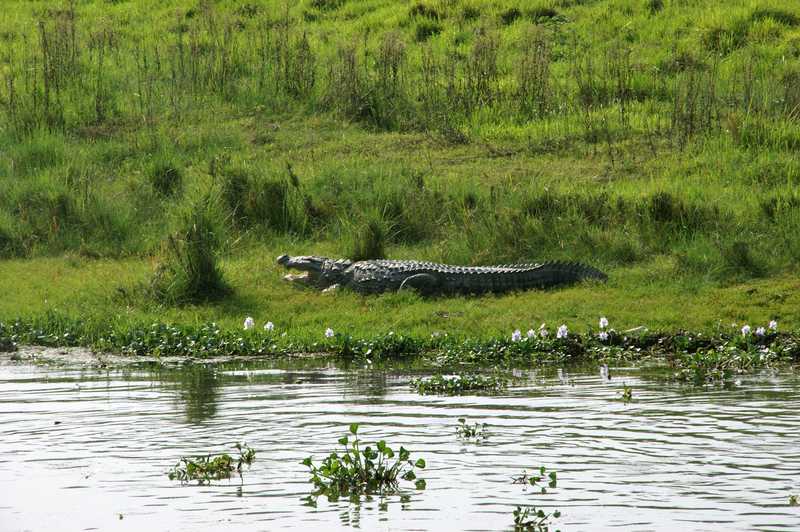
Chitwan National Park 3-day extension
You may also like.
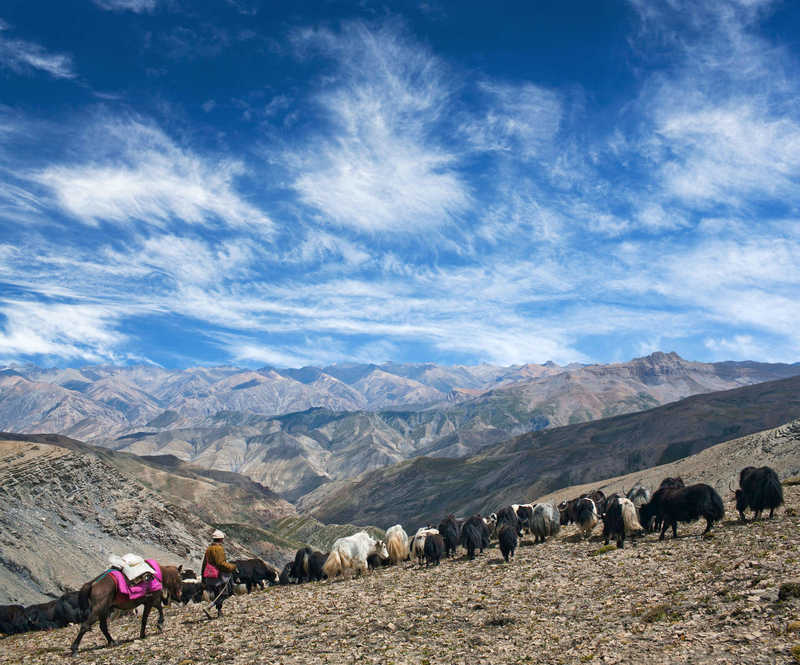
Changtang Lakes to Spiti Valley
- from $3,385
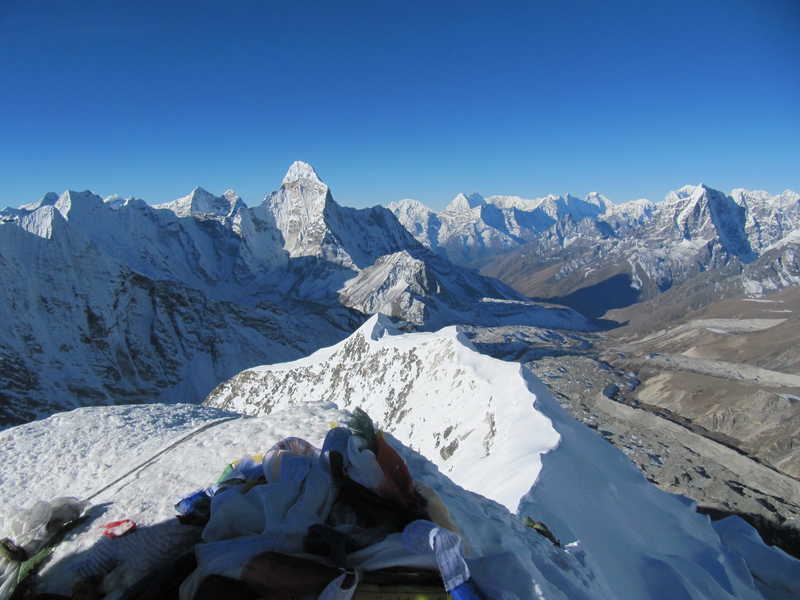
Everest Base Camp and Island Peak
- from $3,575
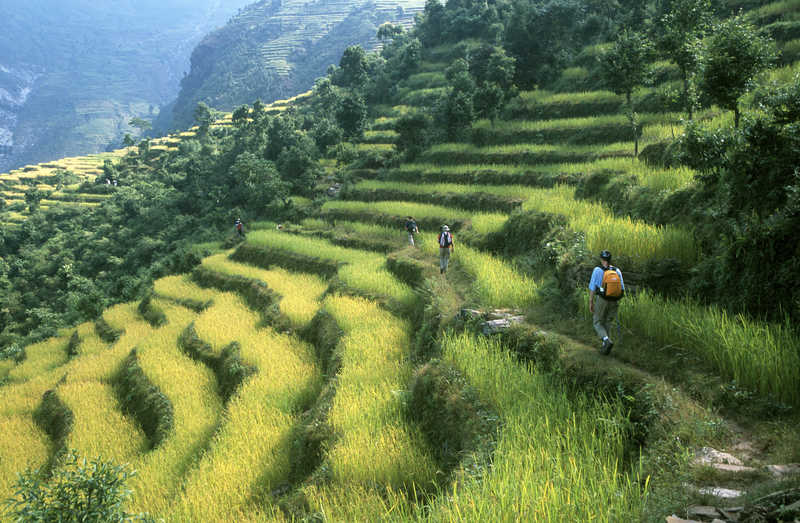
Poon Hill Trek
- from $1,365
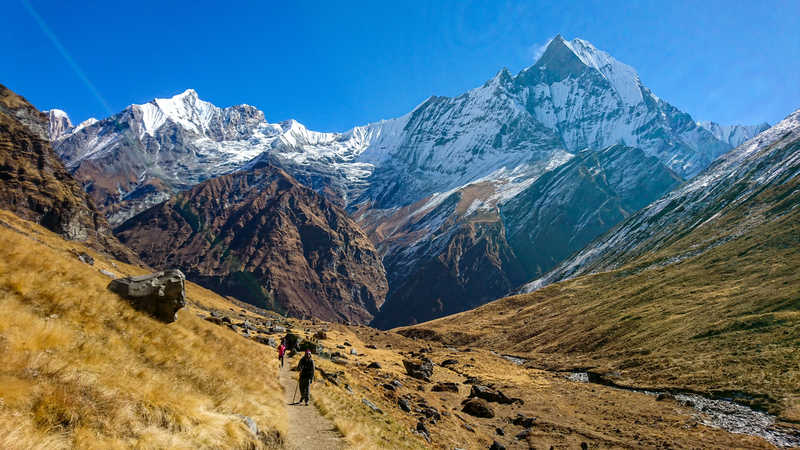
The Annapurna Sanctuary
- from $1,555
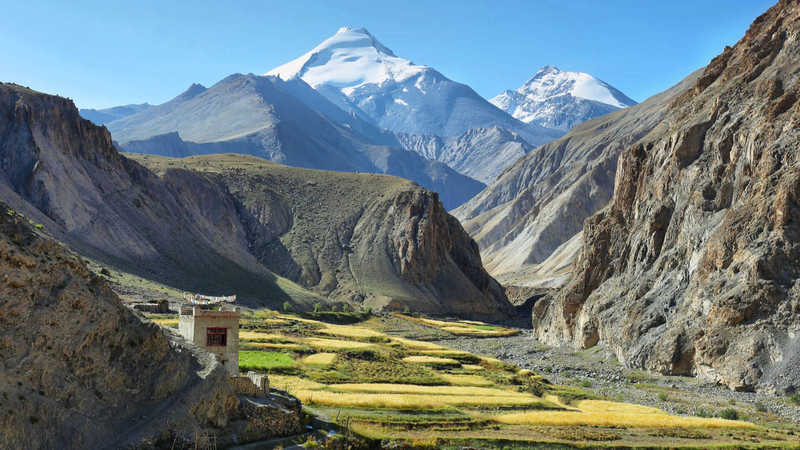
Markha Valley and Kang Yatse II
- from $2,335
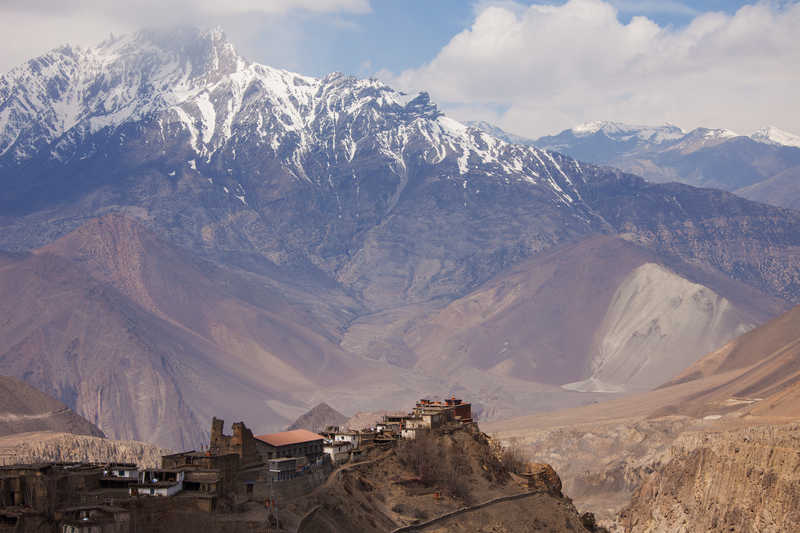
The Chomolhari Trek
- from $4,095
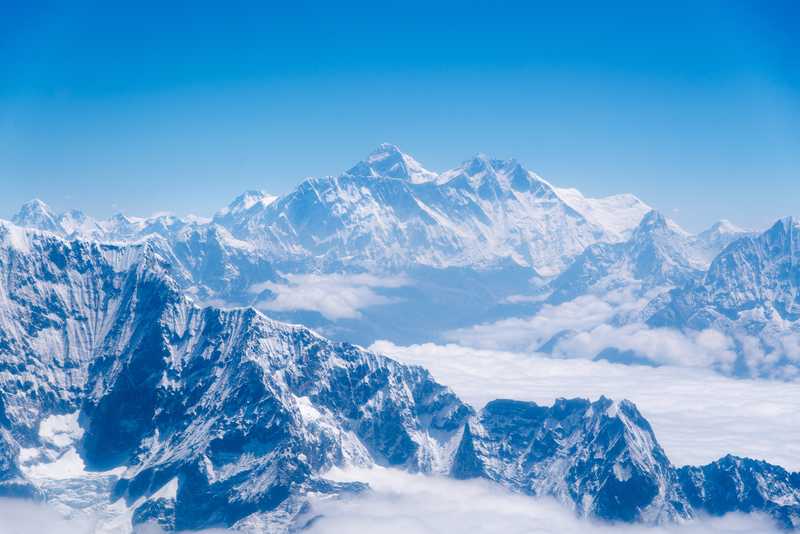
Everest Base Camp
- from $1,725
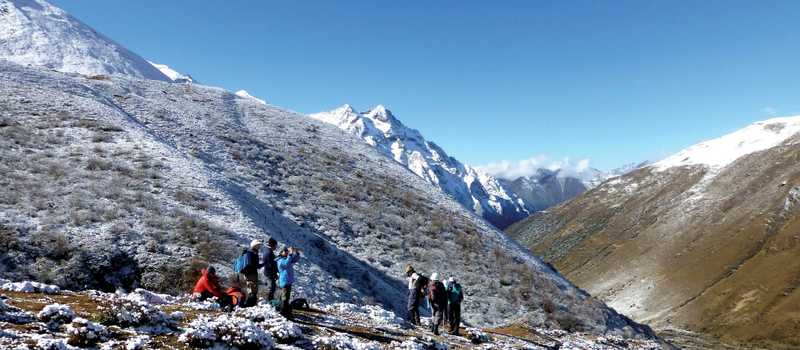
The Snowman Trek
- from $12,345
Nepal Govt. Reged. number: 39829/2005
Tourism License number: 805/2005
VAT/TAX Number: 302385791

Gokyo Treks Nepal
Nepal Trekking Agency
From 2015 - 2024 contineously
+977 9841 249 988
Three Passes Trek
Home » Three Passes Trek
Based on 7 Reviews
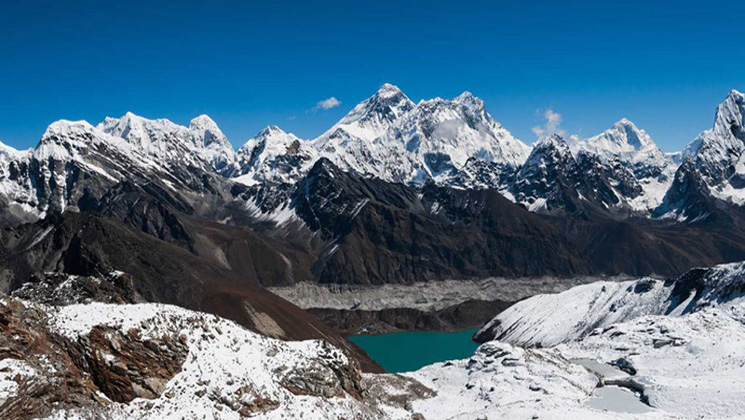
Three Passes Trek Summary
- Trek Duration: 15 Days
- Trek Difficulty: Moderate Hikes
- High Altitude: 5,535 meters / 18,160 feet.
- Trekking Hour: 6 hours daily
- Group-Size: 1 – 15 People
- Best Hiking Months: April, May, October, November
- Trip Mode: Guest House Basis
- Hiking Foods: Breakfast, Lunch, and Dinner
- Transportation: Car/Plane
Three passes trek is combined with three different challenging trekking specially designed for adventure trekkers. The Three Passes Trek to Everest Base Camp is arguably the most complete trek in Nepal as it covers most of the Mount Everest region’s highlights.
High passes trek in the Mount Everest region is very popular. It is the hardest hike in Nepal for beginners tourist. The Trek route is designed to focus on adventurer trekkers the Everest 3 high passes trek facilitates to Renjo La Pass (5,360m/17,586 feet), Cho La Pass (5,368m/17,612 feet) & Kongma La Pass (5,535m/18,099 feet).
Mount Everest high pass trekking is a fantastic trek, visiting all adventure three high passes of the Khumbu with extra time at Gokyo to explore the scenery of the upper basin.
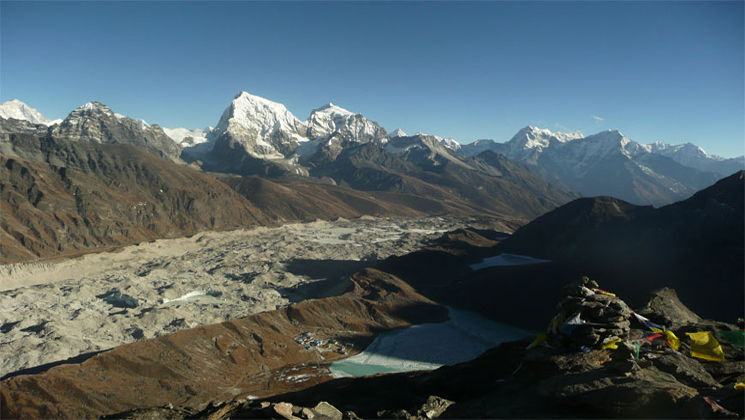
Mountain back stone Kalapatthar hill is a little peak and famous hill station to observe Mount Everest and many other Khumbu tallest mountains. Furthermore, you can see the tallest mountains, brilliant landscapes, high mountain villages, and Buddhist monasteries. It has a great opportunity to experience the local Sherpa hospitality.
Everest high passes trek explores the breathtaking Thame Nagpa la valley to Gokyo valley. Additionally, we cross three high passes in the Everest region ie. Renjo La, Cho La, and Kongma La route thus weather changes very quickly in the Himalayas mountains. However, check and get the latest weather forecast before you hit the high pass trail for your safe journey.
Often the trail is icy, especially in wintertime and stones are falling along the treks. Its adventure route therefore trek to three passes in February will have a very less chance to cross the high pass.
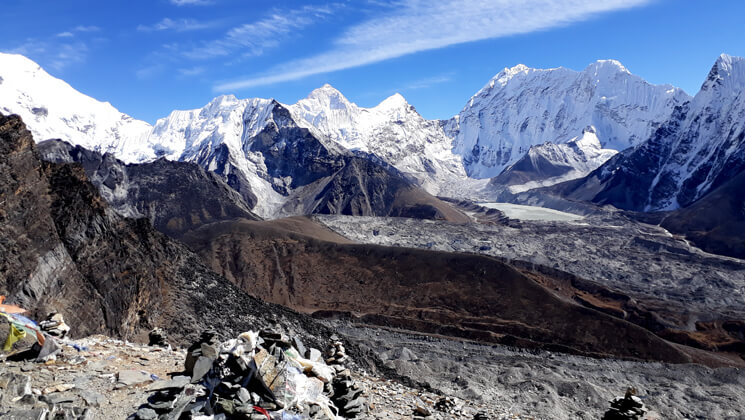
How much is the Three Passes Trek Package Cost?
The cost of Three passes trek package with a Gokyo Treks local Agency ranges between US$ 1098 to US$ 1599. But of course, the three passes trek costs will vary as per the service you choose. However, the given package price includes transportation, a guide, porters, hotels and food accommodation and hiking permits, facilities.
We have also the best deal for low-season treks in the Himalayas for leaders. For example, if you could bring 10+ travelers (except you) to your journey, you are treated as a group leader. So you can hike 3 passes for free of cost.
However, we often arrange private trips in order to avoid group tours with strangers. A private tour gives you a better experience on your adventure hikes. If you value personalization, flexibility, and in-depth experiences, a private trip customized to your personal needs will be the best option.
It’s a standard trip package price for 15 days hike in Everest three passes. If you are 2 Trekkers three passes trek cost US$ 1325 for 15 days trek as given the trekking plan. We can modify the trek route and price as per your wishes also. Here is the price list for 3 pass treks.
Price Per Person for 15 days Three Passes Trek.
If you’re wondering to know about what is included and what is excluded from this trip price, kindly check the cost given on a tab button.
Everest three passes trek itinerary details.
Most popular adventure Everest high pass is 15 days itinerary compared to most walks in this region leading up to the Everest High Pass. The particular route is designed for world travelers who wish to hike to the high passes mountain but are restricted time-wise. A nomad who wishes to reach on Everest high passes trek in a normal plan can try this Everest Three Pass trek plan. However, if this itinerary does not fit? send us an inquiry for a tailor-made itinerary.
Upon landing at Tribhuvan International Airport Kathmandu, we will receive you in a private vehicle and shift to the hotel in Kathmandu. A rest day in Kathmandu before heading to the high passes trek in Everest. Our representative will brief you on three high passes trek itinerary travel programs.
We take an early flight from Kathmandu to Lukla airport (2,840m/9,318 feet). Take breakfast in the Lukla hotel and hike to Phakding village at 2,630m elevation. Follow a gentle climb up the mountainside on the left bank of the Dudh Koshi.
Likewise, mountain Nupla at 5885m is just visible in a stone-throwing distance on the opposite side of the river. Along the way, we pass several Sherpa villages such as Ghat, Phakding, and Tok Tok and finally we reach Bengkar village.
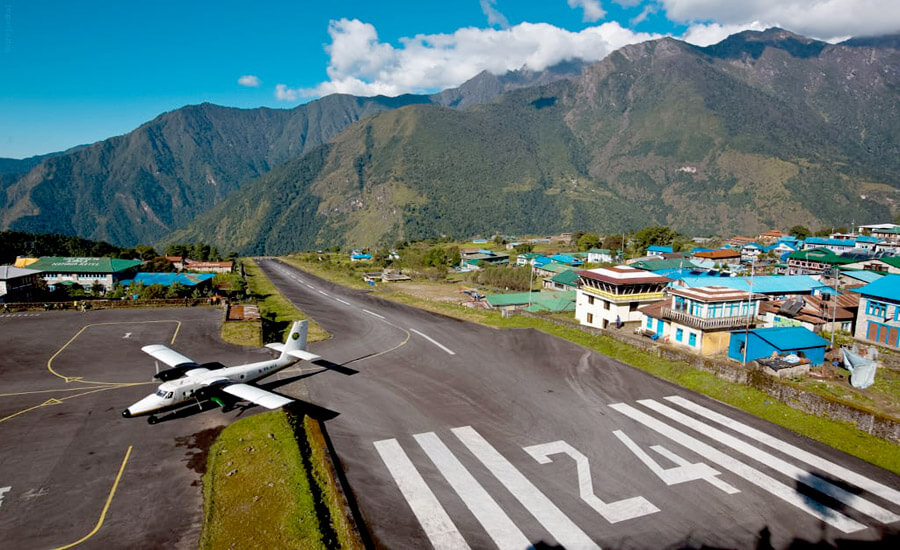
Walk continue along the classical trail with many ups and downs; cross a stream and pass a tiny Monjo village and Sagarmatha National Park office. After paying entrance fees, we walk continuously to Dovan the major river that meets each other.
Cross the Hillary bridge and the steep ascent to Namche village through the dense forest. You can see the Everest (8,848.86m) and Lhotse (8,516m.) first view. Surrounded on three sides by mountain ranges, Namche Bazar is a central hub of the area for food, trekking gear, and other necessary goods. In addition, Namche has also Buddhist Monastery which is a beautiful establishment located right in the Bazaar offers the pristine view of high mountains and entire Namche Bazaar Lodges.
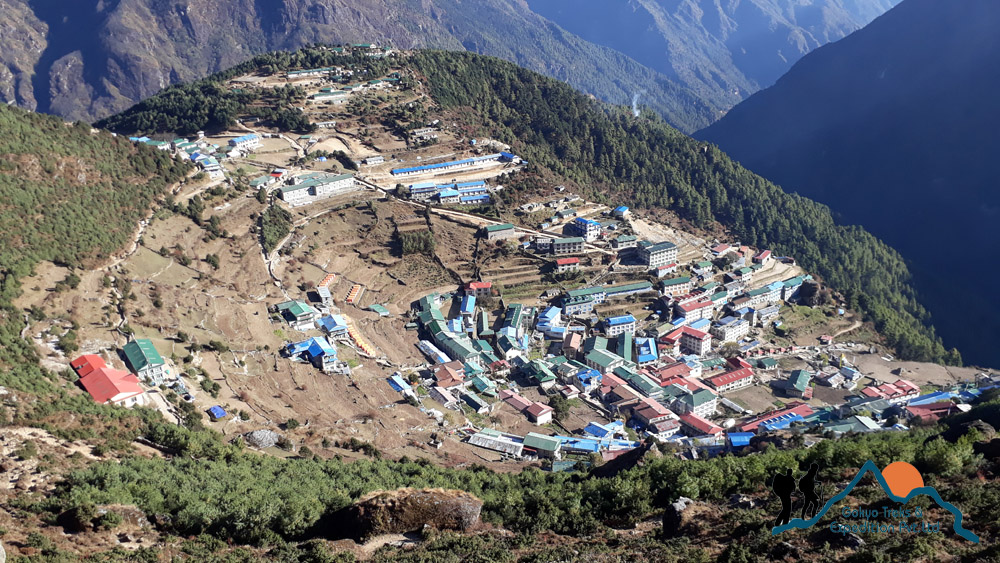
Explore the numerous attractions in Namche Bazaar either before lunch or at your leisure at the hotel. Take advantage of the morning to relax in Namche Bazaar until midday, and then, following lunch, embark on a gentle hike to reach Thame village.
In between, tourist can hike to Hillary Viewpoint that stands at an altitude on 3,980 meters just above the main trail. Hike to Hillary hilltop offers a picturesque vistas of majestic mountains, including Mount Everest (8,849m), Lhotse (8,516m), Nuptse (7,861m), Ama Dablam (6,812m), and other prominent peaks, making it a must-visit for nature lovers and adventure enthusiasts alike.
Likewise, this Hillary view point presents an unique adventure for travelers seeking an alternative hiking experience. It’s an ideal destination for a day hike after breakfast, with similar experiences and slight variations depending on the time of day.
continue to Thame, situated at the end of Khumbu Valley. Thame is a tiny village renowned for its pristine terrain and inhabitants untouched by the influences of modern civilization. Traverse a vast expanse adorned with prayer flags, Chorten, and intricately carved mani stones to arrive at the captivating Thame village.
Journey to Lungden is mostly uphill and trails pass by many old, walled Sherpa villages. Tourists can observe varieties of wild plants and animals with unique Sherpa culture. We can probably also share the trail with Tibetan Yak Canavans, a trading route to and from Namche to Tibet with the villagers. Tourists can stay overnight at the Lungden Guesthouse.
Trek to Renjo la pass often follows steeply ups and down with sandy ridge. Cross the frozen stream and walk through dramatic rock to pass several yak pastures and twin Renjo Lakes. View from the top is incredible, you can have a stunning view of 7000 to 8000-meter peaks and many more snowy mountains. Overnight stay at Gokyo lodge.
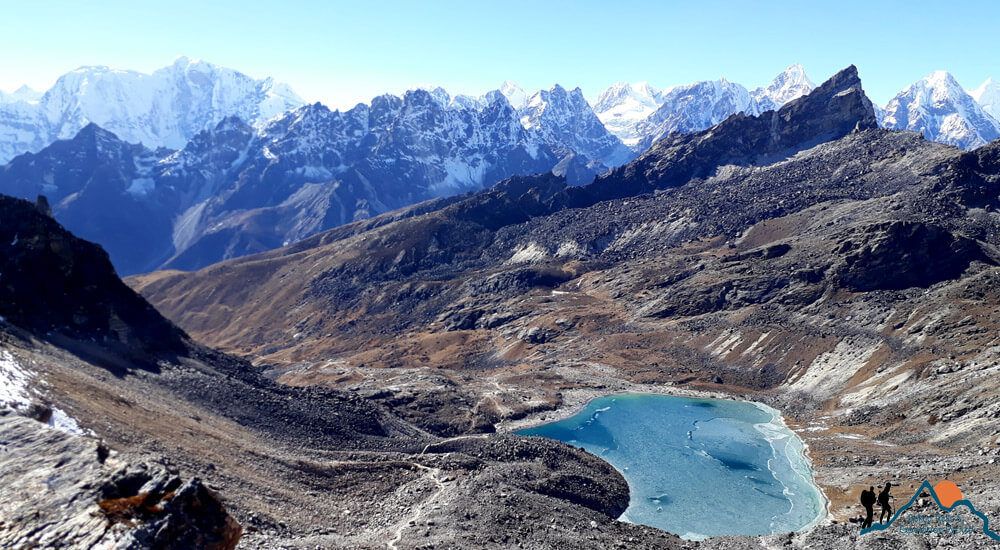
The excursion to the Gokyo peak usually starts early in the morning. The climb is quite steep first 30 minutes, it takes an hour to reach the top with its traditional prayer flags. From there you will have a magnificent view of the highest peaks, from the west to the east.
Cho you (8,153m), Gyachung Kang (7,922m), Everest (8848m), Lhotse (8,501m), and further way Makalu in a single line. While on the descent you can enjoy, a superb view of Gokyo Lakes, glaciers, and the lodges.
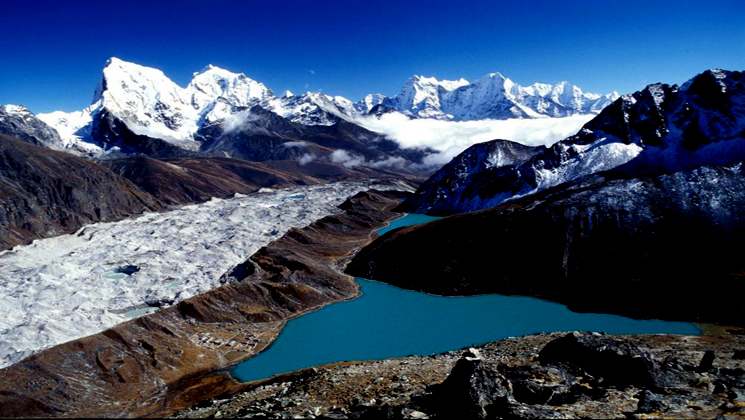
We cross Gokyo glacier and Dzomba glacier than descend downhill to get Thangnak. Thagnak offers nice lodges with modern facilities.
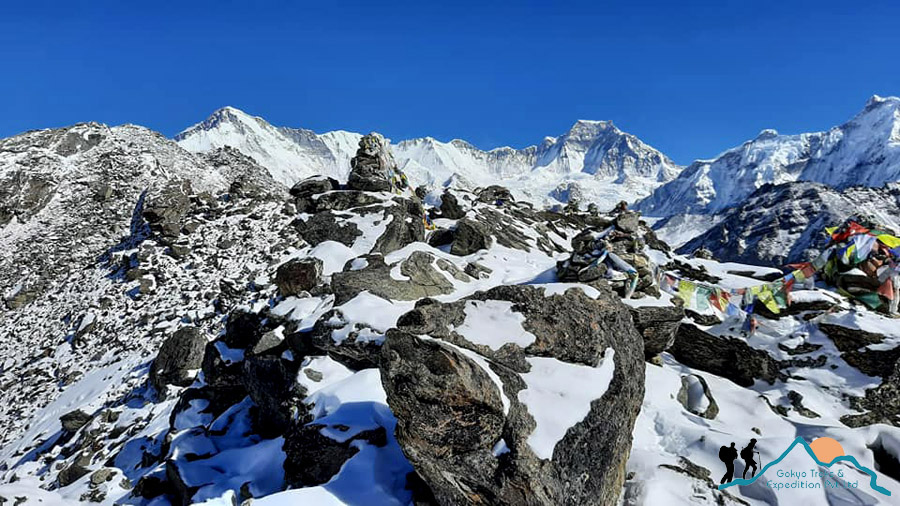
Trek through Cho La Pass (5,368m) is a rather difficult route but doesn’t require special climbing knowledge. If you are a professional trekker who can walk about 5/6 hours on a rocky trail can easily complete this journey. Hikes over the pass often stay with snow level above the stone payables which is actually hard to trek.
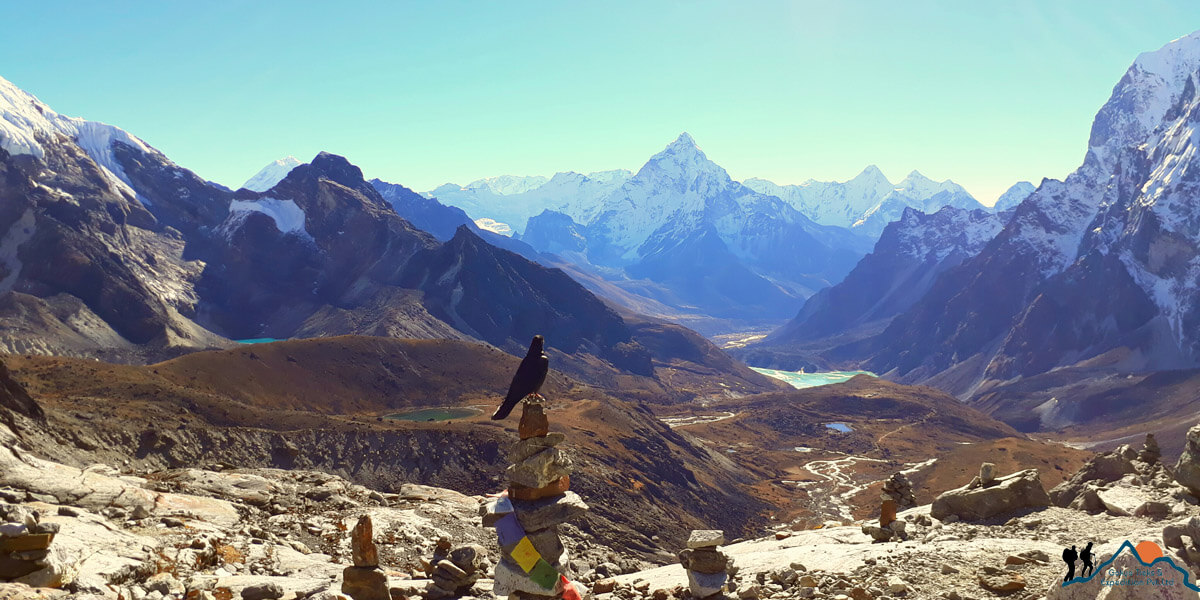
Actually, the pass is not difficult but it is steep and involves a glacier crossing. There are no technical problems and there is a trail in the rocks beside the icefall. We suggest that Tourists hike with all-important gear depending upon the hiking season.
Dzonglha situated at 4,830 meters where we stop for Lunch. Be that as it may, in the busy hiking season, all the guesthouses are open and welcoming to travelers. Continue the journey to Lobuche lodges watching Cholatse lake and dry Dughla Lake. Several tiny stupas are installed at Dughla pass in memory of dead trekkers and also climbers in the Everest zone.
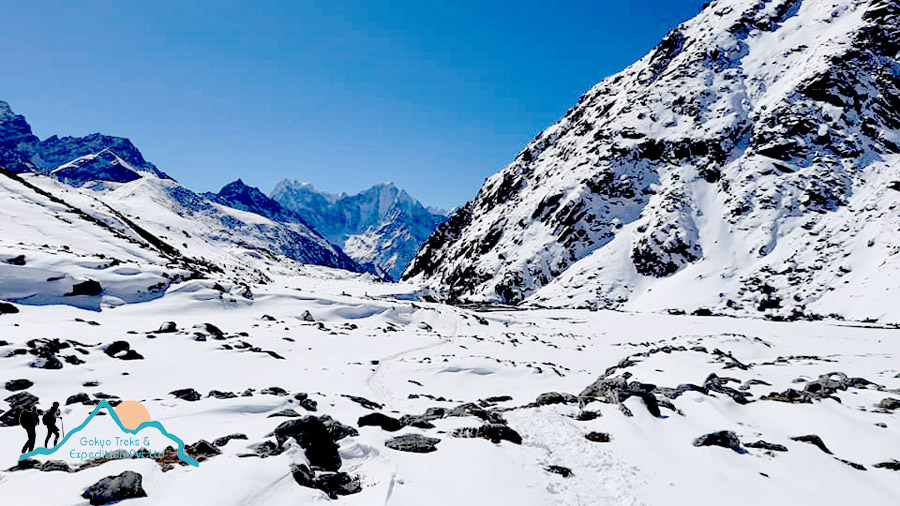
After having lunch, we then climb the 5,550 meters Kala Patthar for an incredible view of the Khumbu ice fall and the Everest base camp epic trail. Return to Gorak Shep for a stay overnight.
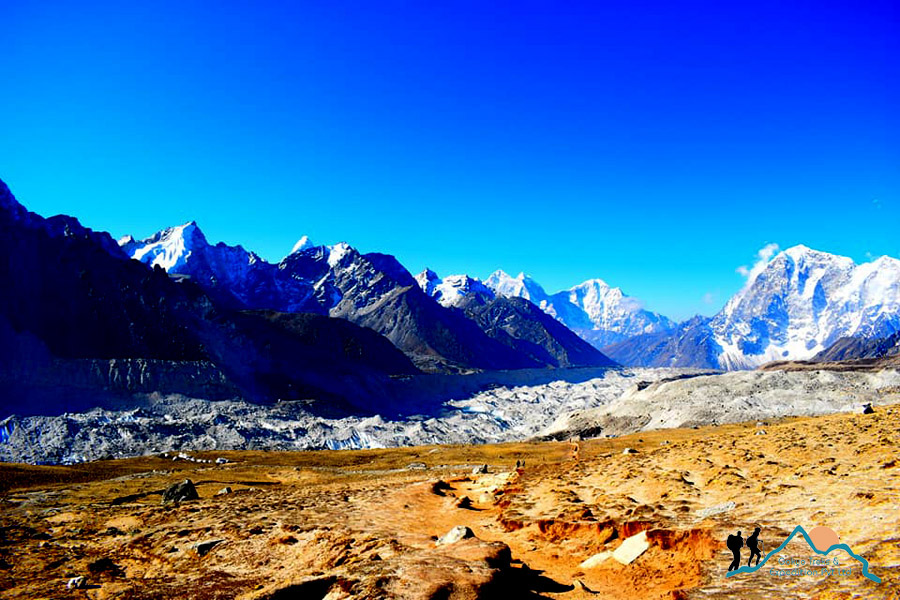
It’s another tough day for Kongma la pass trek today that we trek along the Khumbu glacier. But in terms of scenery, Kongma la pass offers superb mountains view, a gorgeous river valley, and Kyubo Kharka Mountain Lake on the Ama Dablam foothills.
Hike the Kongmala pass (summit viewpoint) is longer comparing other day hikes in Khumbu province. Take the best photograph from kongmala’s highest elevation at 15,519 feet and descend downhill to reach Chukhung resorts in chukung village.
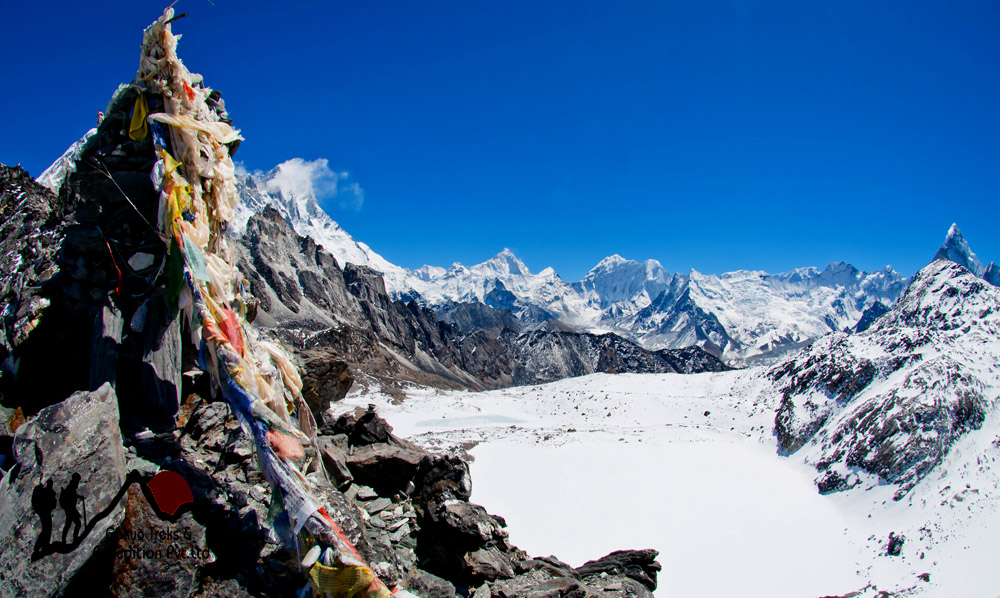
From Chukhung, we descend the valley of the Imja Khola, trek through the village of Dingboche with its stone-walled potatoes fields, down alpine pastures through the kharkas of Tsura, Orsho, and Shomare to the village of Pangboche, the highest year-round settlement in the valley. The Pangboche Gompa (monastery) is the oldest in the Khumbu and was once used to boast the skull and hand of a Yeti.
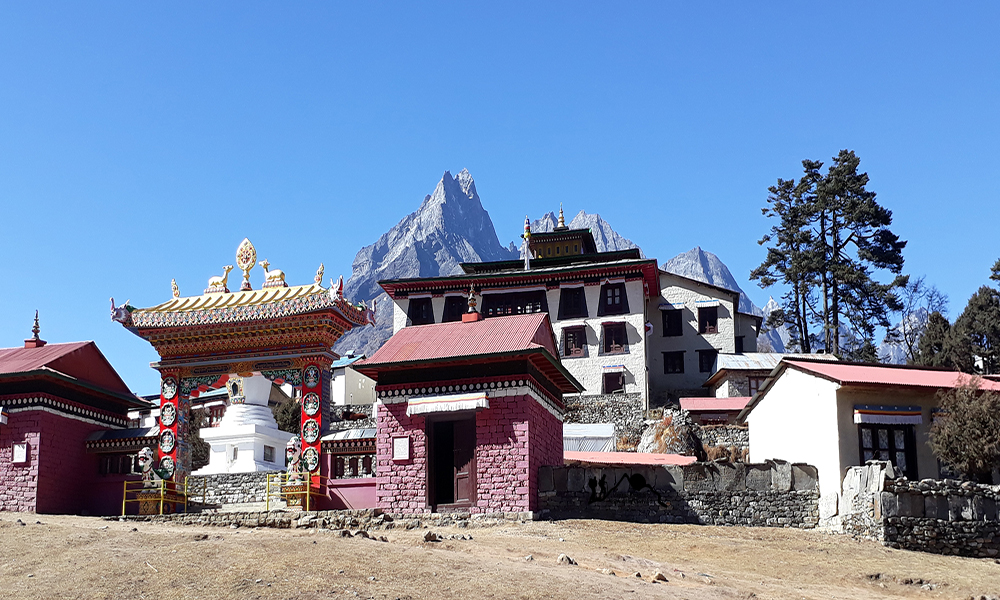
Tengboche Monastery is perhaps the most renowned Monastery in Nepal, likely on account of its unparalleled scenery of Mount Ama Dablam. The Buddhist Monastery of Tengboche also known as Dawa Choling Gompa is in the Tengboche village in Khumjung in the Khumbu region of eastern Nepal.
The Monastery is the main Buddhist place in the Khumbu locale with a dwelling Rinpoche which favors pioneers, mountain climbers, and voyagers going through. Expeditioners visit this monastery to light candles and seek the blessings of God for good health and safe mountaineering in the Himalayas.
Trek descends from Tyangboche to Jorsale passing the crowded Namche Bazaar is often downhill walking. Catch the way descends from Gokyo valley. Lunch at Sanasa, then continue hikes higher route to Khumjung village where one can visit traditional villages landscapes.
You might also visit Hillary Hospital located in Khunde. And in the meantime, we follow the trail to Monastery which offers Yeti Scalp and continue your journey over the pass before descending to Namche guest houses.
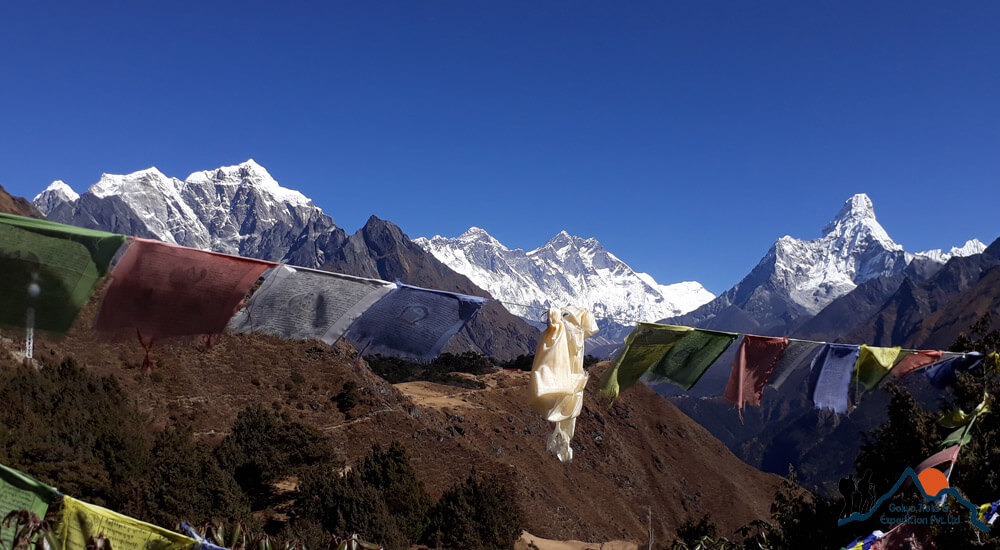
We trek to Lukla with the same trail we use on ascend. It is the final day of our high pass Everest trekking. Upon arrival at Lukla, take a hot shower and take some time to visit the Lukla market.
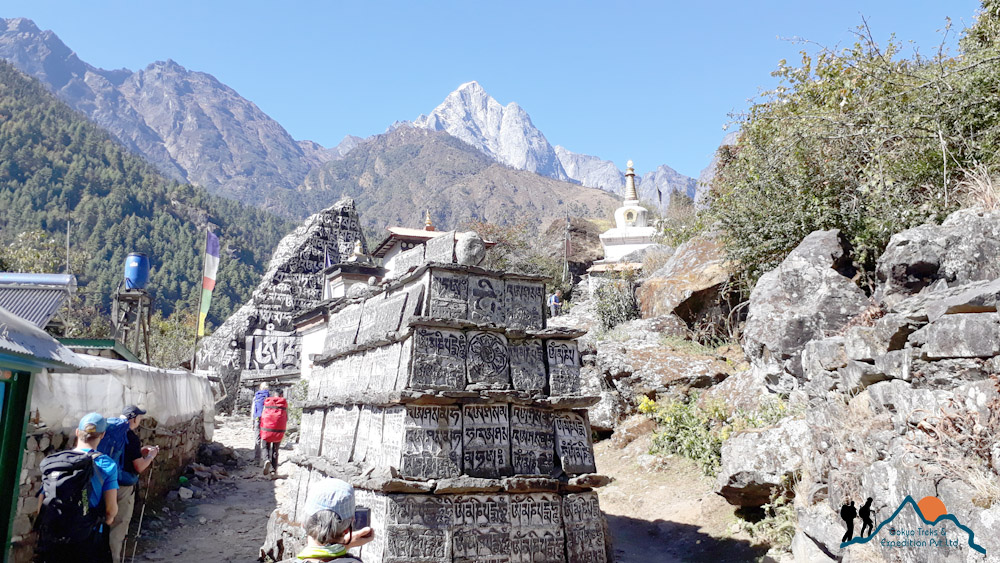
Not satisfied with above plan?
Interested in planning a custom trip? this might take 2 to 3 minutes.
How much does Three passes trek package price?
It’s a 15 Days Three passes trek price start at US$ 1098 and might reach up to US$ 1599 per person on double occupancy basis. Gokyo Treks and Expedition agency notify this express Three Passes Trek Package price for 2024 and 2025 based on group size you are travelling with.
For the deluxe and luxury trekking tour plan, we add a 3-5 star category hotel deluxe air-conditioned room in Kathmandu with breakfast. Likewise, a standard room with an attached Toilet/bathroom in the possible places en route. AND WE ARE OPEN TO CUSTOMIZING YOUR TOUR AND PACKAGES PRICE AS PER YOUR REQUIREMENTS.
Mount Everest three passes trek package price includes:
- Kathmandu international airport pick up your arrival time with a private car.
- Single night double bedroom accommodation in a Tourist standard hotel in Kathmandu
- Kathmandu to Lukla and Lukla to Kathmandu round trip airfare with domestic airport taxes.
- 14 Breakfast serve with a cup of tea/coffee, 13 Lunch and 13 Dinner [main course] during the Everest 3 passes trekking.
- 13 nights Guest House accommodation during the Everest three passes trekking route.
- Sagarmatha National Park fee
- Khumbu Pasang Lamu municipality entrance permit fees
- TIMS permit for 3 passes trek in Nepal.
- Certified – Professional Mountain Trekking Guide as per given plan.
- An assistant guide will provide for 7 plus group tourists.
- Required number of porters during the trek (one porter = two guest basis) because our porter can carry a maximum of 24 kg of your bag pack.
- Good salary, food, accommodation, and insurance for Nepalese staff.
- Agency’s duffel bag (50 liters capacity), and trek poles if Necessary – return after the trek.
- First aid medical kit including Oximeter to check your Oxygen level, Pulse rate to monitor every day to prepare for altitude risk.
- In a worst case, help with all Helicopter Rescue and evacuation arrangements (but not the rescue bills).
- Trek certificate and updated three passes trek map for each person, you keep a map as a souvenir.
- Nepal Government Tax, VAT, and as well as Company service charge.
Everest three passes trek price excludes:-
- Lunch and Dinner in Kathmandu city.
- Any kinds of battery charges, laundry service, phone calls, and hot showers during the trekking.
- Tourist personal trekking equipment and Clothing.
- Personal nature expenses, all types of drinks, and bar bills.
- Travel Insurance which covers emergency rescue, evacuation, personal loss, or damage.
- Any donation and monument entrance fees.
- Gratuities for guide and porters [Tip is a culture, so they expect highly].
We can organize a private trek to Everest high pass trek or three pass trek starting at any date that works for you. Please contact us for more information.
Guaranteed – Trip is Guaranteed to run.
Available – Trip is available to run if minimum group size is filled
Limited – Only few space available
Question: Do I need experience for three pass trek?.
Answer: Trek over the Everest zone high passes are adventures. Those who can walk around 5 hours every day, with a lightweight daypack can do this trip. However, if you have some experience hiking over 3000 meters above sea level, would be easier.
Question: Can I store my luggage stuff in Kathmandu for free?
Answer: Yes, you can leave your luggage at your hotel or at our office. Store your stuff in the Gokyo Treks agency office is for free.
Question: What kind of accommodation can I expect on budget 3 pass treks?
Answer: We provide tourist standard accommodation in Kathmandu and during the trek in the mountain. The rooms along the routes are clean with a cozy bed with a nice mattress and blankets. We recommend you take your own sleeping bags if you have one with you otherwise, you may rent them either in Kathmandu or at the Namche gear store.
Question: Is pick-up service available on my arrival day in Kathmandu?.
Answer: Yes sure. Provide us with your flight details. Our representative will come to pick up you at Kathmandu international airport.
Question: What kind of food can I expect in express 3 passes trekking?.
Answer: Guesthouses have attached restaurants. They cook a delicious range of mostly vegetarian such as Pasta, tuna bakes, noodles, potatoes, eggs, bread, soups, and vegetable rice. In the same way, the dinner and breakfast we provide in the same lodge you spend the night every night and Lunch will be served on the way to the next place where you hike.
Question: What opportunities will I have for a shower on the standard three passes trek?.
Answer: Everest high pass trek all the lodges have a shower which you can get it on pay however if you are in camping trek – we provide you hot water bucket then you will take a bucket shower.
Question: How do I get drinking water on the Everest three-pass trek?.
Answer: In almost all places in lower elevations, there are hotels and enough shops where you can buy mineral water. On a higher elevation hike, you can buy water from Lodges. But we advise against buying mineral water in plastic bottles, as currently there are no provisions for disposing of plastic materials in the Himalayas. Instead, please buy water purification aqua tablets to purify the normal water as the normal water is available at the campsite on the hiking route. If the guest doesn’t like the Aqua tablets flavor then the traveler can buy boiled water from the lodges.
Question: Can I charge my digital camera or other batteries on my trip?.
Answer: At 3-pass trek route lodges, tourists can recharge the battery. We recommend you bring an extra pair in case. Remember to bring your adapters! And we recommend you take extra batteries along with you.
Question: What should my insurance policy cover during three passes trek?.
Answer: Travel insurance is mandatory before joining any trips with us, and you need to get your travel insurance policy before joining your trips to Nepal. Your travel insurance must cover the helicopter rescue up to 6000m altitude. It comes in handy during medical emergencies and contingency situations. It is recommended to get it from your home country. In case you haven’t bought travel insurance after arriving in Kathmandu; we can help you get one.
Question: How to prevent altitude sickness during the Everest high three passes trek?.
Answer: You should never walk too quickly or too high ignoring your body’s symptoms. Proper altitude acclimatization is the best way to prevent high-altitude sickness. Listen to your body, trek gradually enjoying the best of culture and nature while giving enough time for your body to adapt to the changing atmosphere. Drink a lot of fluid & keep your body hydrated. If symptoms like a headache, difficulty in breathing, and others occur then descend to a lower altitude and take them to a hospital. If the condition worsened you will be airlifted to the hospital in Kathmandu.
Question: What happens if my scheduled flight in the Kathmandu-Lukla-Kathmandu route gets delayed or canceled?.
Answer: Weather in the Himalayas is uncertain and we cannot predict. Therefore, the rate of fight delay and cancellation is high at Lukla. If this happens, you will be boarded on the flight tomorrow and you have to spend an extra night at Lukla (if you are returning to Kathmandu) at Kathmandu (if you are going to Lukla).
Helicopter rescue can also be used, which depends on the situation. So, we recommend you allocate a couple of extra days after your Everest trek so that you will not miss your international flight back.
Question: What are alternates to flying from Kathmandu to Lukla?.
Answer: The best-recommended way to go for any Everest trek is to board a Kathmandu-Lukla 33 minutes scenic mountain flight. But there is also a second option to drive from Kathmandu to Phaplu (roughly 9-10 hours drive) and trek for 2 days to reach Lukla. In the present day, there is also a regular jeep service from Kathmandu to Salleri.
Question: Are there any communication facilities on three passes trek?
Answer: Everest Link is an internet service provider founded in 2014 that provides high-speed internet and Wi-Fi in the Everest Region. It is the only internet provider on the three passes trail, making it the world’s tallest internet service.
If you wish to stay connected with better WIFI to your family, friends, or business, we suggest you buy Everest Link internet. It’s better than other NETWORK connections and you can buy an Everest link card easily in the shops, hotels, or any small lodges in the Everest zone.
Question: Can I use credit cards in three passes trek
Answer: No. You need to have cash Nepali rupees because credit cards work only in the bigger city tours/city areas.
Question: When should I book my trip and what are the payment terms?.
Answer: We recommend booking your trip with us as early as possible. While we strive to accommodate last-minute bookings, a 15% advance deposit is required to secure your reservation. This deposit allows us to make all necessary arrangements for your trip however, the remaining payment can be settled upon your arrival in Nepal.
Question: Who will carry my luggage on 3 passes trek?.
Answer: We provide porters to transfer your luggage. As we are a responsible trekking tour operator agency, every porter carry a maximum of 24 kilos of your backpack which means 2 guests (12 kg luggage of each guest): 1 porter basis.
Question: How much distance do I walk each day?
Answer: three passes trek, the distance you cover each day can vary greatly due to gradient, terrain, and altitude. As such it is very hard to give specific distances for each day, however, you have to be prepared to walk for roughly about 5 hours each day.
Question: Do I need walking poles for Everest high pass trek?.
Answer: It is better to hike with walking poles. Learn how to use trekking poles for balance and stability, whether on the sidewalk or on trails. Walking poles can help prevent slips and falls. They are just recommended but not compulsory.
Question: Is it feasible to hire an experienced sherpa guide? how to hire a local Sherpa guide for Everest three passes trek in Lukla?.
Answer: Yes of course. If you are not happy to purchase the complete full board package trip, still you can hire our expert guide to make your holiday tour safer. However, visit a guide and porter hire for three passes trek budget or email us for your detailed travel inquiry.
Question: How much additional money do I need per day?
Answer: You can allocate US$ 08 – 10 for a lunch/dinner in Kathmandu and it depends on your spending habits. US$ 7 to 10 US$ each day will be enough to buy bottles of water, chocolates, tea coffee, and some drinks while you are on your trek.
Three passes trek highlights and best side trips
Besides thrilling adventure hikes over the high passes there are also some of the important places marked as the best side trips for the visitors. Side trips are located nearby the main classical trail. Some of them are given here which are very popular sight trips for tourists.
- Explore the best Himalayan view at 360 deg angles from Renjo la, Klapatthar & Kongma la summits.
- Sherpa Buddhism, an ancient monastery, Local Sherpa, and their lifestyles.
- Lukla airport is popular as a Tenjin Hillary airport, the top thing to experience on your journey on a flight.
- Namche Bazaar is a gateway to discovering like to get comfortable hotels, a beautiful loop of Mountains, and Nagpa La 5,716m to Tibet.
- Sengboche Hill at 13,000 feet altitude (Everest View Hotel) offers a top amazing view of the highest Mountains chain.
- Khumjung village at 12,434 feet, making it one of the highest Human settlements in Nepal and in the world.
- Thame Valley in the Everest trek is the birthplace of Tenjin Norgay Sherpa, a famous Everest superstar.
- Dughla pass is a memorable park of death and legendary climbers in the Everest zone.
- Get to know about the Himalayan glacier trail, Morraine, Landslides, and crevasses to reach the basecamp.
- Most beautiful sights of Mt Everest, Lhotse, Nuptse, Amadablam, Cholatse, Cho Oyu, Thamserku ..etc
- Kongmala pass is an outstanding viewpoint to catch the glimpse of the majestic mountains in a single line in few kilometers of distance.
- Nagarjuna hill, is the most popular day trip just above Dingboche Guesthouses to achieve incredible sights of the Makalu Mountains and more peaks with Amadablam.
- Tengboche Monastery is the oldest monastery in Khumbu Territory, popular as a land of Stupas.
How hard is the 3 passes trek?
Majestic three passes trek is rated “Challenging” and super adventure high passes trek in the Mount Everest region in Sagarmatha National Park. The passes are above 17,800 feet and a very serious adventure given its high pass crossings.
It is more challenging rather than its sibling treks Everest Base Camp and Gokyo Lakes, but not quite as challenging as trekking peaks. If you never hiked at a serious altitude before (the highest altitude trek similar or above 5,400 meters) or on a trek longer than 6 days, it is tough.
The distance and elevation maps are just a guideline about the edge of fitness level. Although it is a reputable hike to cross over the adventure high passes, it is not fit for novices.
Along the routes, you can walk at your own pace, with plenty of stops for rest. Adventure Everest base camp and three pass trek is possible with anti-clockwise also and it’s possible at any time except winter throughout the year.
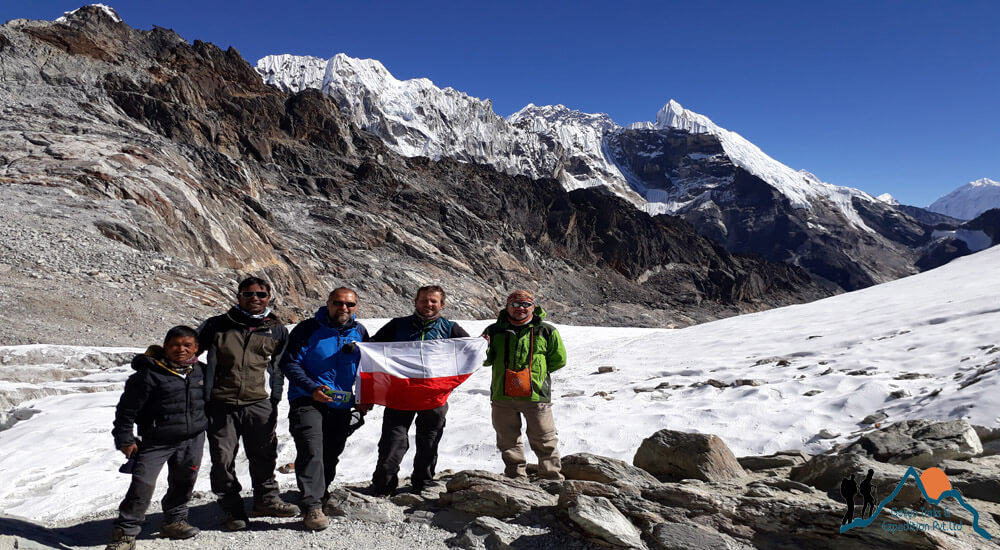
Notes for Mount Everest three passes trekkers!
The information stated above is just a guide and standard template that we provide you. However, adventure 3 passes trip possible to revise according to your wishes. Local politics, landslides, cancellation of local flights, weather, transport, or a multitude of other factors that are beyond our control can result in a change of itinerary during on trip.
It is, however, very incredible that the itinerary would be extensively altered. If alterations are necessary the leader will decide the best alternative option, taking into consideration the best interests of the whole group. When a change does occur, we do everything we can to minimize its effect, but we cannot be responsible for the results of changes or delays.
What makes Three passes trek special?
This trek provides stunning views of some of the world’s highest peaks, including Everest, Lhotse, Nuptse, and Ama Dablam, along with the chance to visit remote Sherpa villages and ancient monasteries
At Gokyo Treks and Expedition, we prioritize delivering high-quality services with a strong emphasis on safety and success. Our team consists of professional, trained, and licensed local guides who possess an in-depth knowledge of the destination. Additionally, we are committed to benefiting local communities and conserving natural resources, which not only reduces costs but also minimizes consumption.
Three Passes Trek Review
Couldn't have asked for a better trip, thanks to gokyo treks.
We couldn’t recommend Gokyo Treks more highly. From start to finish, everything was seamlessly organized for us. When we first arrived in the busy Kathmandu airport we had to queue with hundreds of others to get our visas but our driver patiently waited for us outside. We were then taken to our comfortable hotel in Thamel for the night and Ammar gave us the rundown of our tour (with a welcome tea on arrival, of course). Ammar is a seasoned professional and will happily help answer any questions you may have prior to or during your trip.
For our trek, we had the fantastic Som as our tour guide. We couldn’t have asked for a better tour guide! Som has been with Gokyo Treks since the start and is so passionate about his job and sharing stories about Nepal. He is an absolute wealth of knowledge, but he also deeply cares for his clients and will go above and beyond to make sure you are well looked after. Not only that but he is hilarious! When you are trekking together for 16 days, you need a light hearted tour guide who you can share a laugh with and Som will happily smile and laugh with you. Our porter Buddi was also fantastic. Although we can’t speak the same language, Buddi has a smile that will light up a room and makes you feel so welcome everyday when he comes to collect your bags.
By the end of the tour, we are more than just clients- we are now lifelong friends.
If you are looking for an authentic Nepalese experience, book Gokyo Treks.
Response from Gokyo Treks Nepal
Thank you so much.
Jiri + Three Passes Trek with lovely Bishnu
For our Trek, we were searching for a trekking agency to connect with a guide and organize the necessary permits and so on. We found Gokyotreks!its a company led by Ammar who responded very fast to every question and helped us were ever out was necessary. On our Trek, we had our guide very nice guy. He did everything to make the trek as easy for us as possible. We had a very great time trekking and can fully recommend the service of Gokyotreks. At the end of our holiday, we had a few spare days and Ammar organized a trip to Chitwan National Park.
Dear Guest Hannes Fleckl, Austria
Thanks a lot for your time writing us an excellent review. So, we are very much pleased that you are highly satisfied and writing us an excellent experience exploring Nepal. Be in touch as we are looking forward to serve you again for your other holidays in Nepal Himalayas!
With best regards, Ammar Raj Guni
Three Passes Trek in Sagarmatha National Park
I successfully completed my Three Passes Trek in Sagarmatha National Park with the help from Gokyo Treks & Expedition. The agency helped me arranged my porterguide and flights between Kathmandu and Lukla.
Agency operator Ammar was very friendly and helpful. Although I opted for a self-planned free and easy trek, Ammar offered me lots of good advice during my planning. When I arrived in Kathmandu, Ammar also met up with me to guide me through the trek arrangement. The service was professional.
Dear Guest Tony DXC, Singapore
Greetings from Gokyo Treks & Expedition Pvt Ltd, Nepal. Thanks a lot for your time writing us an excellent review of the Mount Everest Three Passes Trek 5,550 meters above the sea level in Nepal with our guide and porters. So, we are very much pleased that you are highly satisfied and writing us an excellent experience exploring Nepal. Be in touch as we are looking forward to serve you again for your other holidays in Nepal Himalayas!
With best regards,
Ammar Raj Guni
EBC Hiking via Gokyo Lakes - Chola Pass
Ammar, owner of the Gokyo Treks Company came to know from one of our office colleagues. He booked everything for us from we appeared to the airport in Kathmandu until the day that we leave. Everything is very satisfying throughout the whole trip. From shopping in Thamel Street (Our Guide Kamal follow us around the street to advise us for what is the appropriate hiking gear to purchase) to overcome to the 3 high passes adventure treks.
The guide will give us a briefing every evening throughout the whole hiking trip to get us not only physically and mentally ready for the second-day hike but also to carry the correct gear. Besides, he also briefs us on a lot of news about the mountain, how to prevent AMS and more.
Not to mention that our assistant guide Mr Bhupal did a really good job serving us from the daily hiking route as well as in the guest houses. Our four ever-smiling porters (Kieran, Hira, and Prem) did a great job too. The three porters also come back down to assist us when they reach the Chola Pass peak and Kongma la peak, contributing a lot to our successful crossing.
Before leaving to Europe, Ammar invited us for a typical Nepali dinner. It was an opportunity to talk more with Ammar about the volunteering organization that he helped society in various ways, including sponsoring kids who lost parents in Earthquake 2015.
In summary, Ammar and his team were honest and professional. Great arrangement and communication with Ammar were very quick. – Thomas, Woldgang and Tine Kilbert, Garmisch-Partenkirchen, Bavaria, Germany.
Dear Thomas Kilbert for the time to review your Nepal trekking with Gokyo Treks & Expedition agency. We hope to serve you again on your next trip to Nepal.
From US$ 1631

Quick Inquiry
No of People : 1 2 3 4 5 6 7 8 9 10 11 12 13 14 15 16 17 18 19 20
Cost & Departures
Your Trip Your Style!
ITINERARY, COST, DEPARTURES, will adjusted according to your GROUP SIZE NEED TIME
Book with Confidence
- Local Guides Company.
- 18 Years in Business.
- Lowest Price Guaranteed.
- 100% Customizable Trips
- Excellent Customer Service
- Hassle Free Booking.
- 90 % Repeated customers
- Highly Recommended agency
- Private/group tour options
Useful Information
- Trek in Nepal Himalayas
- Altitude Sickness
- Foods on the Trekking
- Trek Porters and Guides
- Trek TIMS Permit
- Trekking Equipment List
- Trek Permits & Fees
- Best Season for trek
- Trek Difficulty/Grade
- How to get Nepal Visa
Add on Safari Trip
- Chitwan Jungle Safari
- Bardia Jungle Safari
- Koshi Tappu Wildlife Reserve
Extra Fun on Adventures
- Mount Everest Flight
- Everest Helicopter Travel
- Bungy Jump Tour
- Paragliding Flight
- River Rafting
- Experience Zipline
- Wild Honey Hunting
- Mountain Biking
Book My Trip
- Booking Terms - Condition
- How to make Payment
Trek & Return with Heli
- Trek to Langtang with heli return
- EBC Trek with a Heli return
- Gokyo Trek with a Heli return
- Trek to ABC with a Heli return
- Tours by Helicopter in Nepal
Reference Contact
- Germany : Klaus Kummer
- Germany : Martin Aigner
- Austria : Verena Laner
- Austria : Dorothee Plunger
- Chicago: Beth Pekol
- Australia: Mark Panico
- Zürich: Marta Blickenstorfer

Classic EBC trek – a day-by-day itinerary
The classic Everest Base Camp (EBC) trek follows the most direct route from Lukla to the famous base camp. We offer this iconic trek while returning via a detour that also lets you enjoy a quieter, more traditional part of the region.
So you've heard about the classic EBC trek in Nepal ...
We know, we're as starry eyed about it as you are. 🤩
Here's a description of the famous EBC trek route, as well as the special detour that we at Follow Alice hike on the return. We do this because we think the variation takes what's already a great trek and turns it into a truly epic one!
What does the classic EBC trek look like?
The route of the classic EBC trek in Nepal (not to be confused with the EBC trek in Tibet ) starts in the town of Lukla and follows a relatively direct route to Everest Base Camp. It's not a straight line, of course, since the trail wends its way up various valleys.
After reaching Everest Base Camp, most classic EBC trek tour operators then lead you back along the same route and stop at the same villages, since that's the traditional path. But we think it's far more interesting and rewarding to hike some side trails and stay in different villages.

Khumjung is one of the villages visited on the return route
Classic EBC trek itinerary
Map of the classic EBC trek with Follow Alice's special return route
Here's a breakdown of what the classic EBC trek itinerary with Follow Alice looks like. As you can see, the entire trip lasts 14 days, but you're on the trail for 11 days.
Day 1: Arrive in Kathmandu
- Day 2: Fly to Lukla then trek to Phakding (3-4 hr)
Day 3: Trek to Namche Bazaar (6 hr)
Day 4: trek to pangboche (7-8 hr), day 5: trek to dingboche (4 hr), day 6: acclimatisation day in dingboche, day 7: trek to lobuche (6 hr), day 8: trek to everest base camp (7-8 hr), day 9: climb kala patthar then trek to pheriche (6 hr).
- Day 10: Trek to Khumjung Village (9 hr)
Day 11: Trek to Monjo (3-4 hr)
Day 12: trek to lukla (3-4 hr), day 13: fly to kathmandu, day 14: fly home.
Here now is a short description of each day, as well as the odd explanation for why we've made certain choices concerning the itinerary, such as having you wait a day after flying back to Kathmandu before flying home (heads up: it's a good reason!).
Your guide meets you at Tribhuvan International Airport and drives you to the hotel in the lively city district of Thamel. If you arrive early enough, we recommend wandering into the streets to explore and experience the atmosphere of this iconic city. There are also loads of trekking gear shops should you still need to buy or rent anything.

A Kathmandu street scene
In the evening you gather together for a briefing dinner with your trek guide.
Day 2: Fly to Lukla, trek to Phakding (3-4 hr)
In the morning you fly from Kathmandu to Lukla, the airport town known as the Gateway to the EBC trek.

Lukla's famously short airport runway
Fortunately, Lukla's elevation of 2,860 m (9,383 ft) above sea level (asl) isn't high enough to cause altitude sickness. But it's near the mark where one needs to take the elevation seriously, making it the perfect starting location for the EBC trek!
Once you land, it's straight on with the backpacks and you spend the next few hours trekking through forest alongside the river known as Dudh Kosi. Your first overnight stop is the charming village of Phakding, which straddles the river. At 2,610 m (8,563 ft) asl, Phakding is actually lower in altitude than Lukla.
Today you have a big trek ahead of you, not least because you must climb about a vertical kilometre to reach tonight's stopping point of Namche Bazaar (3,440 m or 11,286 ft). En route you cross suspension bridges dripping in multicoloured Tibetan Buddhist prayer flags, including the high Hilary Suspension Bridge.
Namche Bazaar sits in a natural amphitheatre and offers sublime views: to the east you look over the valley of Bhote Kosi to the high, sharp ridge of Kongde Ri, and to the west over the valley of Dudh Kosi to the white peaks of Kantega and Thamserku.

A night-time view of Namche Bazaar and snow-topped Kongde Ri
Namche Bazaar is a real experience, as its a regional trading hub while also being one of the primary waypoints on the EBC trek, so you can find people from all over the world hanging out here. Note that Namche Bazaar is a great place to draw cash and also stock up snacks and medicines, as the villages you visit after this are small and lean on amenities.
You have an early start today as there's many hours of trekking ahead! Your destination for the day is Pangboche (also spelled Panboche), a neat village with green roofs in the valley of Imja Khole. The trek today is incredibly pretty, with Mt Ama Dablam presiding all of the way.

A view of Ama Dablam over a rooftop in Pangboche
Pangboche has an absolutely incredible mountain backdrop. In fact, from here Ama Dablam really does feel like a brooding mother, as suggested by its name.
Note that there's a traditional Tibetan Buddhist monastery in the village that you can visit if you arrive in good time.

Sacred books in Pangboche's monastery
Today is a relatively short trek, but your body will be feeling the effect of the ever-increasing high altitude, so it's important to take things slowly.
An obvious sign of the high elevation is that you climb above the tree line today and enter scrubland. This vegetation zone has an austere beauty all its own, and you really start to feel the remoteness of your location here.

The mountain views in and around Dingboche are just breathtaking
Your destination (where you will stay for two nights) is Dingboche (4,360 m or 14,304 ft), a small farming community that sits on a bank of the Imja Khola.
Today is about allowing your body to acclimatise to the high altitude before making it climb higher. Altitude sickness on the Everest Base Camp trek is very common, and so it's absolutely vital to take a rest day on the ascent.

The glorious view from above Dingboche
While you can spend today just resting if that's what your body is telling you it needs, there are some great excursions on the cards if you're feeling up to it, for instance:
- A short hike of about an hour takes you to Nangkartshang Hermitage.
- Hike for another 90 minutes and you reach a viewpoint offering fantastic views of Ama Dablam, Cholatse, Taboche, Chhukung and Makalu (the fifth highest mountain in the world).
- Hike to Chhukung further up the Imja Khola Valley and enjoy some of the most spectacular views in a region that's famous for great views!

Ama Dablam and Chhukung Glacier as seen from the hill above Chhukung
Today's trek takes you up to Lobuche (4,930 m or 16,175 ft) along a path carved into a fairly desolate landscape. But as always, the views en route are awe-inspiring, and you can look forward to eyeing the peaks of Taboche, Cholatse, Ama Dablam and Kangtega.

Lobuche exists because of the EBC trek
Lobuche was originally a summer village for local herders, but now survives by catering to the needs of trekkers.
If you arrive early enough and have some energy left in the tank, it's just a 20-minute hike to the so-called Italian Pyramid , which is a scientific research station at the foot of Lobuche Glacier. Alternatively, you can climb to the top of the ridge east of Lobuche and enjoy your first sighting of Khumbu Glacier!
This morning you get up early with a twinkle in your eye, because you've got just one last push ahead of you until you reach Everest Base Camp. Wow.
The going is naturally pretty tough today, as the air is very thin and you must also ascend roughly 400 m to reach base camp at 5,364 m (17,598 ft) asl. Yet needless to say, every which way you look during today's hike rewards you with showstopper scenery.
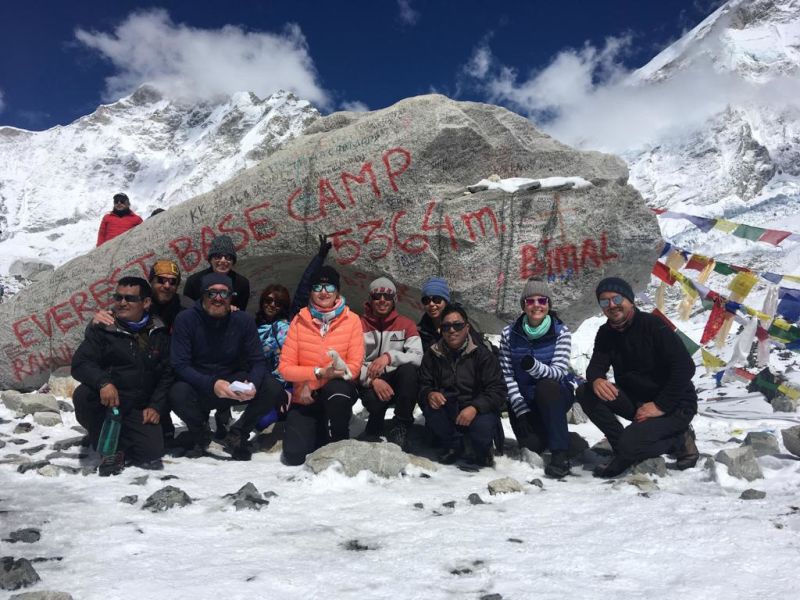
Our client Karen shared this great group shot taken at EBC in 2023
Before you know it, you're standing in Everest Base Camp, which is an unassuming spot in its way, but is festooned with multicoloured prayer flags, dotted with fellow visitors, and laden with the hopes and memories of thousands of trekkers and mountaineers before you.
Please note that you can't actually see Mt Everest from base camp. But you will see it tomorrow! So you head to Gorakshep (5,164 m or 16,942 ft) for the night, ready to earn that incredible view the next morning!

Kala Patthar offers an incredible, unobstructed view of Mt Everest
This morning you have another red-letter day ahead of you: enjoying that classic view of Everest from the top of Kala Patthar!
The hike up Kala Patthar ('Black Rock') is taxing, as you ascend to 5,643 m (18,514 ft), where the air is really thin. But the view from the top of that oh-so-recognisable mountain peak is worth every moment of effort.
From here, it's time to start the trek all the way back to Lukla. As promised, you deviate from the route followed on the way to base camp, tackling a parallel path for part of the day to arrive at your destination for the night, which is the village of Periche.

Very few trekkers visit the remote village of Pheriche
At 4,371 m (14,340 ft) asl, Pheriche is nearly 1.5 km lower than Kala Patthar, so expect a lot of downhill trekking. The village offers utterly sublime views of the surrounding peaks, which include Everest, Lhotse and Ama Dablam.
Periche was originally only occupied seasonally when locals would use it for yak grazing and growing potatoes and buckwheat.
Day 10: Trek to Khumjung (9 hr)
Today's trek is a long one, but by dropping down below the 4,000 m asl mark you can expect to feel the invigorating effect of more oxygen. During the second half of the day's hike you leave Periche Valley and enter Khumjung Valley, another impossibly picturesque corner of the world with towering mountain peaks and continued views of Everest.
Today's destination is Khumjung Village (3,780 m or 12,402 ft), a fascinating village with much to explore and appreciate, including a beautiful little monastery, a gorgeous mani wall, a famous bakery, and the high school founded by Sir Edmund Hilary.

Statue of Sir Edmund Hillary at Khumjung High School
Khumjung is presided over by the strikingly shaped Mt Khumbila, whose name means 'God of Khumbu' and whom many Sherpa consider too sacred to climb.
On the trek today you walk the beautiful path between Khumjung and Namche Bazaar, after which you link back up with your outward path, getting the chance to once again cross the truly photo-worthy Hilary Suspension Bridge.
Tonight you stay in the pretty village of Monjo (2,840 m or 9,318 ft), also spelled Manjo, which sits alongside the Dudh Kosi at the bottom of a narrow, tree-filled valley.

A guesthouse near Monjo
Today involves a relatively short hike to get back to Lukla, where you can relax and celebrate the mega achievement of the past several days!

A suspension bridge crossing the Dudh Kosi at Phakding
Today you begin your journey home, and this starts with a short airplane ride over incredible mountains to reach Kathmandu.
While this flight should leave early in the morning, mountain weather is unpredictable and so we've left this entire day 'open' to account for any delays. It's far too risky, in our experience, to have an international flight out of Kathmandu planned for the same day as your flight out of Lukla.

One of the small aircrafts that fly in and out of Lukla
So please think of today as a buffer day; should your flight to Kathmandu be delayed by a day, you should still be able to catch your international flight home the next evening.
That said, if all goes to plan with your flight to Kathmandu in the morning, you then have the afternoon and evening to explore the city! Your trip manager can give you suggestions of the very best things to do based on your preferences.
Today we drive you to the airport for your international flight home. Depending on your departure time, however, you could well have a nicely big window to explore this famous city further.
Kathmandu Valley is a UNESCO World Heritage Site as it boasts seven complexes of great historic and artistic importance, including the Buddhist stupas of Swayambhu and Bauddhanath. Whichever ones you choose to visit, you're guaranteed to see and experience something incredible during your time in the city!
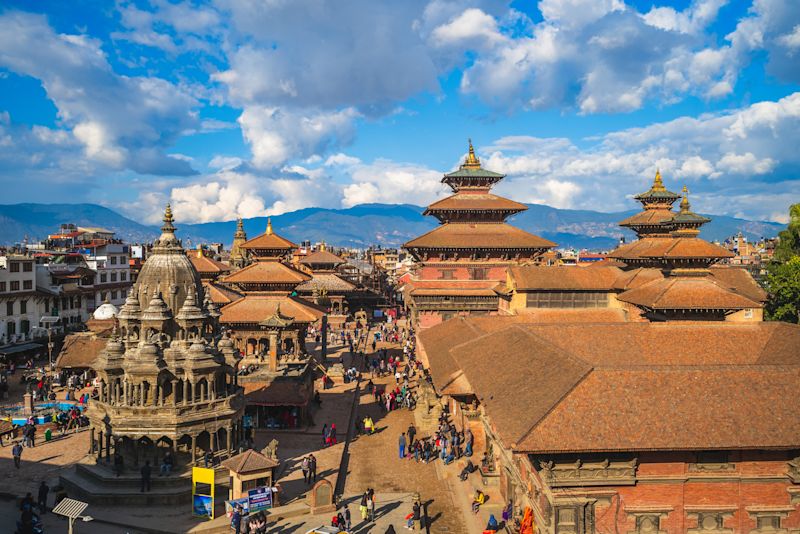
Durbar Square in Kathmandu
Follow Alice's inclusions and exclusions
Finally, please check out our Classic EBC trek trip to see what's included and what's not included in our package. We've scaled back the inclusions on this trip (in comparison to our other EBC trek itineraries ) for those looking for a really affordable package with a company that nonetheless retains its preoccupations with safety and quality.
- Logout Login
- Adventure Holidays
- Weekend Getaways
- Driving Holidays
- Travel News
Top Searches
Pune Weekend Getaway
Famous Places
Popular Cities
Udaipur Luxury Resorts
India Oldest Temples
Uttarakhand Trekkers Death
Caught in blizzard, 9 trekkers die in Uttarakhand; things to keep in mind before going for that trek
Priya Srivastava Priya Srivastava / TIMESOFINDIA.COM / Created : Jun 7, 2024, 16:08 IST
You're Reading
Nine trekkers died in a blizzard during the Sahastra Tal trek in Uttarkashi, Uttarakhand, with adverse weather conditions playing a major role in the incident.
Nine trekkers died in a blizzard during the Sahastra Tal trek in Uttarkashi, Uttarakhand, with adverse weather conditions playing a major role in the incident. Read less

More from Travel News

The incident
About silla-kushkalyan-sahastra tal trek.

Things to keep in mind before embarking on a trekking trip
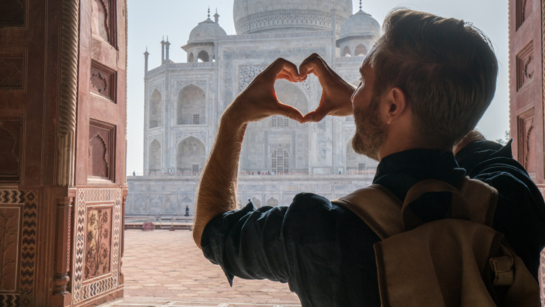
Most tourist-friendly places of India

Comments (0)

Refrain from posting comments that are obscene, defamatory or inflammatory, and do not indulge in personal attacks, name calling or inciting hatred against any community. Help us delete comments that do not follow these guidelines by marking them offensive . Let's work together to keep the conversation civil.
Comments ( ) Sort: Newest UpVoted Oldest Discussed Down Voted closecomments

SIGN IN WITH
Or post without registration.

Visual Stories
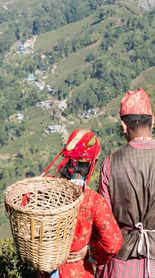
Popular Galleries
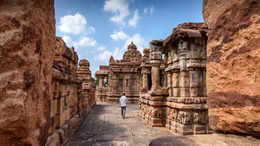
15 oldest temples in India and where are they located TRAVEL TRENDS , INDIA

Cities that are more popular than their country of origin TRAVEL TRENDS , WORLD

Places to visit near Pune within 100 km for weekend fun TRAVEL TRENDS , PUNE
Trending stories.
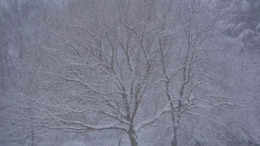
Trekkers die in Uttarakhand; things to keep in mind before going for that trek

15 oldest temples in India and where are they located

- How much does a budget trip to Europe cost? Detailed travel plan and tips

Udaipur luxury resorts: Here's a list for a royal treat

Cities that are more popular than their country of origin
- 1 Caught in blizzard, 9 trekkers die in Uttarakhand; things to keep in mind before going for that trek
- 2 How much does a budget trip to Europe cost? Detailed travel plan and tips
- 3 Top 5 national parks to visit in the USA
- 4 Odisha's Bhitarkanika mangrove forest is an ecological gem; here’s why
- 5 Exploring Kashmir in a 3-day itinerary

THE DEFINITIVE GUIDE TO DESTINATIONS, ITINERARIES, THINGS TO DO, RESTAURANTS, NIGHTLIFE and LOTS MORE!
FOLLOW US ON
Places to visit.
- Places to visit in Bangalore
- Places to visit in Mumbai
- Places to visit in Delhi
- Places to visit in Goa
- Hotels in Goa
- Hotels in Jaipur
- Hotels in Shimla
- Hotels in Mumbai
Things To do
- Things to do in Goa
- Things to do in Mumbai
- Things to do in Bangalore
- Things to do in Delhi
Travel Inspiration
- Visa on arrival for Indians
- Honeymoon Places in india
- Hill Stations in India
- Weekend getaways in Mumbai
- Weather in Delhi
- Weather in Chennai
- Weather in Bangalore
- Weather in Mumbai
Best Beaches
- Goa Beaches
- Mumbai Beaches
- Pondicherry Beaches
- Kerala Beaches
- Restaurants in Bangalore
- Restaurants in Chennai
- Restaurants in Pune
- Restaurants in Jaipur
- Hill Station near Delhi
- Winter trip to Ladakh
- Places to visit in Kerala
- Winter Honeymoon Destinations
- UK visa guide for Indians
- Winter Trip to Manali
- Vaishno Devi Yatra
- Special Train Ticket Booking
- HP inter-state Bus
- Honeymoon Destinations India
Latest News
Congratulations.
You have been successfully added to the mailing list of Times of India Travel. To complete the subscription process, kindly open your inbox and click on the confirmation link which has been emailed to you.
Share with friends
Thank You for sharing! Your friend will receive the article link on email mentioned.
- (For more than one recipient, type addresses separated by commas)
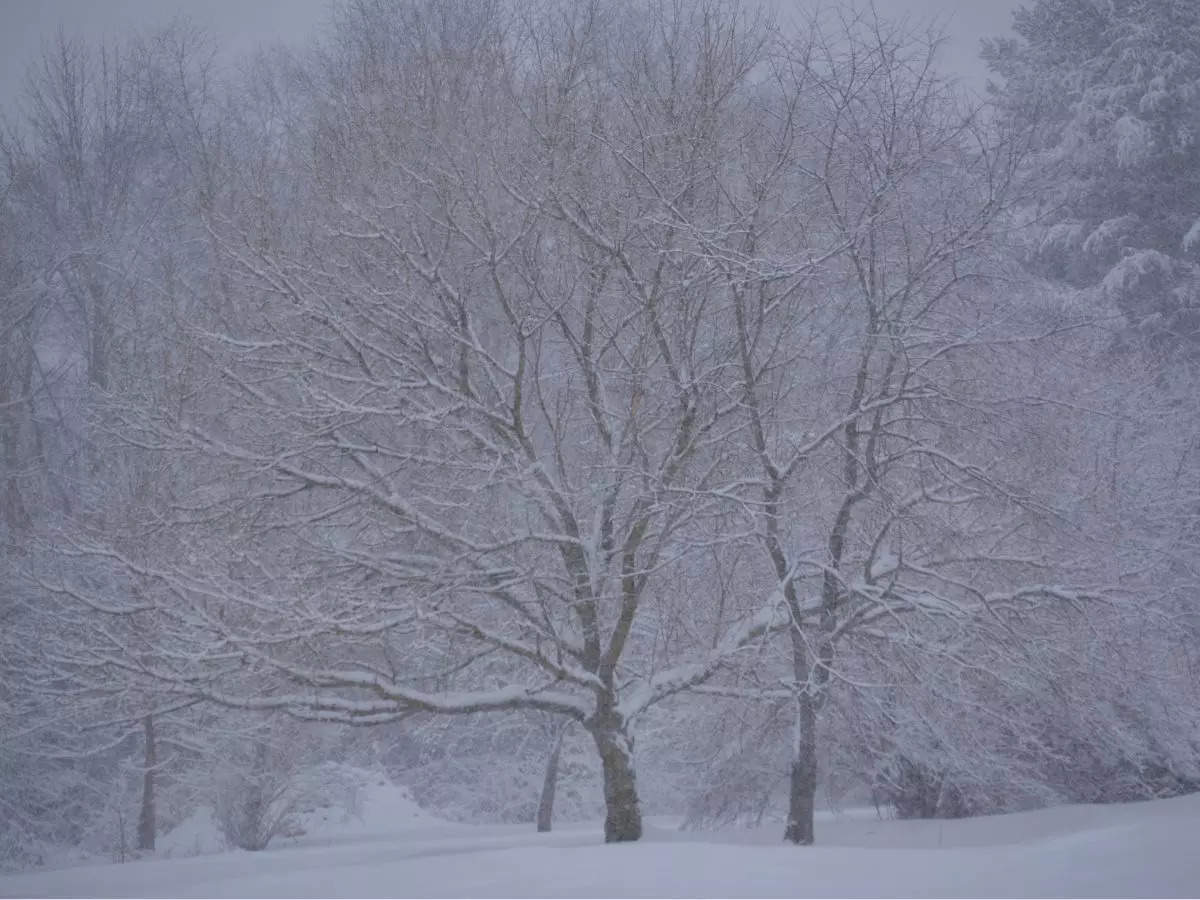
Nat Geo Expeditions Announces 3 New, Bucket List-Worthy Trips Beginning in 2025
Published: June 4, 2024

Contributed By
Public Relations Manager
Greetings travelers!
Today, I’m thrilled to share that beginning in 2025, you can discover Australia, Portugal and the Azores, and Sri Lanka with National Geographic Expeditions! These three new Signature Land trips will take you into authentic Nat Geo storytelling.
Imagine learning from researchers who are actively working in their respective fields , exploring wildlife sanctuaries and hearing the keepers talk about the the care and conservation of these marvelous animals, enjoying activities and visiting with locals who will share the history, cultures and food unique to each region.
Check out these three new experiences of a lifetime:
Australia: Reefs, Rainforests and Wild Tasmania
Our first trip is to the land down under where you’ll explore the nature, wildlife and aboriginal cultures at the heart of this thrilling 11-day itinerary.

The first activity in Australia is at the Great Barrier Reef where you’ll get up-close to colorful reef fish and coral by snorkeling or observing from a semi-submersible boat or underwater laboratory.
During the trip, you’ll also trek with aboriginal guides at the Daintree Rainforest and learn about the thriving ecosystem, view native wildlife at Bonorong Wildlife Sanctuary and at Healesville Sanctuary and hear about the rescued Australian animals there.
On Tasmania’s east coast, the adorable and endangered Bicheno penguins will take center stage (cameras ready!). You’ll also sample wines at local wineries. In true Nat Geo fashion, you’ll embark on a catamaran sailing to spot marine mammals at Wineglass Bay with Pennicott Wilderness Journeys and share the same inspiration as 2012 National Geographic Traveler of the Year and Tasmanian native Robert Pennicott .
This expedition concludes in Sydney with a private tour of the Sydney Opera House and exploring the Rocks District. For complete details, please click here.
Portugal and the Azores: Explorers, Ecological Wonders and Epicurean Delights
Next is our trip to Portugal. Founded in 1143, Portugal was once at the center of the Age of Exploration, and the Azores are a marvelous archipelago in the middle of the Atlantic Ocean. The marrying of these two splendid locations on this 10-day itinerary gives travelers the best of both worlds without having to choose.
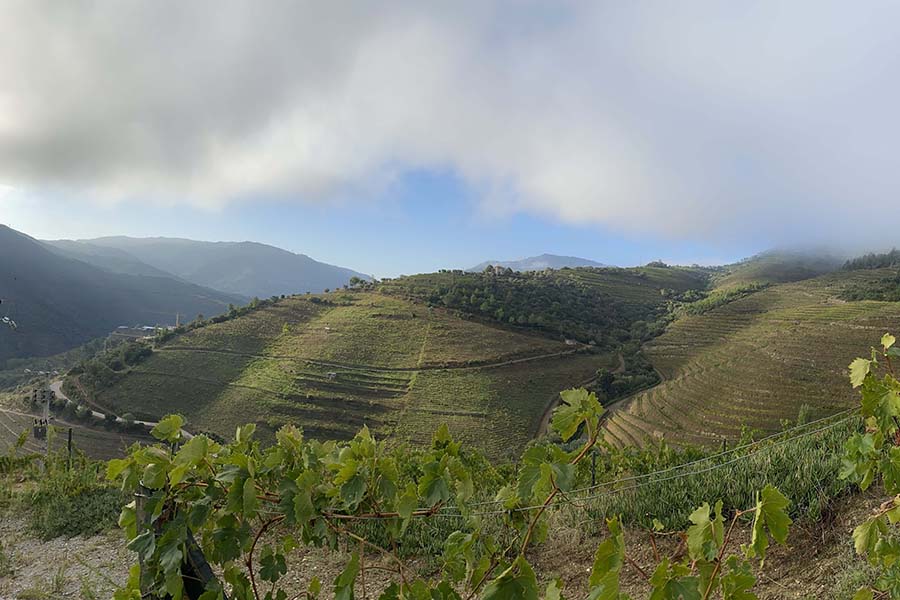
Five UNESCO World Heritage sites plus other activities offer deep connections to the country. Highlights include visiting the famed Lello Bookstore in Porto , savoring delicious food and wines, and embarking on an electric tuk tuk ride through historic town centers.
In the Douro Valley you can bike, kayak or walk alongside the Douro River while admiring the beautiful hills, valleys and grape wine terraces. In Lisbon, local guides will share their knowledge about architecture, monuments and history at Sao Roque Church, the Carmo Convent and Jeronimos Monastery, as well as through stories of trade, maritime findings and the colonization of this region.
The Azores welcome each guest with breathtaking views. Get ready for whale watching, interacting with a local marine biologist who will share insights into research and conservation in this region, touring the Parque Terra Nostra, savoring a delicious farm-to-table meal at a local farmhouse, and exploring the stunning Sete Cidades.
For complete details, please click here.
Sri Lanka: Wildlife and Wonders of the Spice Island
And our 11-day itinerary to Sri Lanka is a historical and cultural lesson come to life through art, dance, food and wildlife. With visits to six UNESCO World Heritage sites and numerous connections to National Geographic programming, you will be immersed in the unique stories of this biodiverse island country.

A tour of the Dambulla Cave Temple launches this exciting trip. In Polonnaruwa, be prepared to observe primate families that call the Polonnaruwa Ancient City and its monumental ruins their home. In Sigiriya, you can discover the Rock Fortress, one of Sri Lanka’s most iconic sites, then partake in a clay pot cooking class at a local family residence in Kandy for lunch.
You’ll also visit the Central Highlands to learn how the country is the fourth largest producer of tea in the world, and a cinnamon estate near the southern coast to see how 90% of the world’s cinnamon is produced here.
National Geographic Expeditions is also especially excited to take you on an exclusive ocean experience in collaboration with Oceanswell , founded by National Geographic Explorer Dr. Asha de Vos . Her foundation is supported by the National Geographic Society – and during your trip, you’ll even be able to assist with data collection!
Giving Back and Traveling with Purpose
I’m also excited to share that every trip booked with National Geographic Expeditions furthers the work of National Geographic Explorers around the world and helps support the global nonprofit National Geographic Society in its efforts to protect and illuminate our world through exploration, research, and education .
Have you started packing your suitcase yet? These new National Geographic Expeditions itineraries are sure to rise to the top of your bucket list of destinations to explore. I know they did on my list!
Booking Information
Bookings for the new itineraries will open on June 4. To learn more or to book these or any of the 150 National Geographic Expeditions on all seven continents, visit NationalGeographicExpeditions.com , call 888-732-2379 or contact a travel agent.

IMAGES
VIDEO
COMMENTS
EVEREST THREE PASSES TREK ITINERARY. We have outlined below what we feel is an ideal itinerary for the Everest Three Passes trekking route. This is a 19 day itinerary which includes flying to and from Lukla. We have noted the trekking distance and an approximate trekking time for each day (excluding lunch stops, breaks, etc), as well as stats ...
The Three Passes trek is the ultimate Everest experience. This route takes in all the highlights—both in terms of mountain views and local Sherpa culture—and combines them into a complete journey through the Everest region. Keep in mind, this trek is one of the most challenging teahouse treks in Nepal. C. Camilla G. Australia.
Three Passes Trek Itinerary. Below I've provided a day-by-day rundown of my recommended Three Passes itinerary hiking in an anti-clockwise direction (best for acclimatization). This is the exact plan and route that I took, with optional rest days and side trips including visiting Ama Dablam Base Camp and climbing Chukhung Ri and Gokyo Ri.
It's a full three passes trek blog with loads of information about doing the 3 passes trek solo - this guide should have everything you need to know! A Brief Summary of the Three Passes Trek ... your blog more impressive how we start Everest Three pass trek.It very beautiful photos.Thanks for sharing best itinerary for my next trek. Reply ...
Everest Three High 3 Passes Trek Itinerary. day 1 Flight from Kathmandu/Manthali to Lukla (2,850m / 9,350ft) Trek to Phakding (2,650m / 8,562ft) Itinerary Facts; Trek Distance: 6.2km / 3.8miles: ... Everest 3 Passes Trek is one of the most adventurous treks in the world, making it one of the most self-gratifying. This trek is very famous among ...
This is a sample itinerary for my Three Passes Trek Guide. It's the path that I took when I completed the Three Passes Trek and Everest Base Camp without a guide: Day 1: Kathmandu -> Salleri (jeep) Day 2: Nunthala. Day 3: Bupsa. Day 4: Ghat (we passed Lukla on this day) Day 5, 6, 7: Namche Bazaar. Day 8: Tengboche.
This Everest Three Passes trek takes around 3 weeks to complete. It is a challenging trek on its difficulty level that will push your limits and test your endurance. It involves 4 - 8 hours of walking at a higher elevation of 5000 meters for a week. The better you prepare, the more you enjoy the adventure that promises stunning landscapes and ...
This guide covers the clockwise variation of the Three Passes Trek circuit by providing a detailed itinerary, route maps as well as answering questions on cost, packing, best times to trek and more. ... Hi Gopal, it's possible to complete the 3 passes trek in 15 days, but the risk of altitude sickness (unless you are pre-acclimatised) is ...
Everest Three Passes Trek Itinerary. Day 1 - Arrival at Kathmandu (1345m). Day 2 - Kathmandu Sightseeing. Day 3 - Kathmandu to Lukla Flight and Trek to Phakding. Day 4 - Trek from Phakding to Namche Bazar (3440m) Day 5 - Acclimatization at Namche Bazaar. Day 6 - Trek from Namche Bazaar to Thame.
The three Everest High Passes are: Renjo La Pass (5420 meters) Cho-La Pass (5420 meters) Kongma-La Pass (5535 meters) The 20-day Everest 3 High Passes Trek is a popular trekking destination in Sagarmatha National Park. The national park covers an area of 443 mi² ( 1,148km²) and is at an altitude of 8,848.86 m around Mount Everest.
Three Passes Trek itinerary Clockwise. Day 19: you can finally take the flight from Lukla-Ramchep-Kathmandu. Note: Based on Alltrails GPS map Three Pass Trek total distance is about 111.87 miles/180km which is per day on average 6.2mil/9.9km per day.
The Three Passes Trek in Nepal is in the Everest Region (Sagarmatha National Park) and takes trekkers across three high passes, Kongma La (18,209 ft / 5,550 m), Cho La (17,782 ft / 5,420 m), and Renjo La (17,560 ft / 5,360 m) - hence, the Three Passes Trek. It's a lollipop loop that can be done starting at Lukla (that scary mountain airport ...
Overview. Everest 3 Pass Trek with Island Peak Climbing is one of the most adventurous journeys in the Everest region. This trekking and climbing itinerary takes you to beautiful Gokyo lakes, the famous three high passes: Renjo La (5,360m) Kongma La (5,535m),(5,535m), Cho La (5,420m), and finally Summit the Island Peak (6,189m) Our Everest 3-pass trek and Island Peak start with a scenic flight ...
There will be several peaks like Makalu (8,516m), Lhotse (8,516m), and Ama Dablam (6,812m) to accompany you as you second higher with the help of our Everest three passes trek map itinerary. The trail of this trek is somewhat tricky as you need to pass through three high passes of the Everest region: Cho La Pass, Renjo la Pass, and Kongma La Pass.
Detail Itinerary Options A: Day 01: Fly to Lukla Hillary airport early in the morning (2860 meters, 35 minutes) and trek to Phakding (2640 meters, 3 hours). Overnight at Lodge.; Day 02: Trek to Namche Bazaar (3440 meters. 6/7 hours walking) and stay the night at the lodge. Day 03: Rest day in the same place for acclimatization. Visit the Sherpa Museum and Everest View Lodge for panoramic views ...
Everest Base Camp Three Passes Trek is a vigorous climb that includes climbing 3 crests. The 3 passes are the ultimate trek experience one can have in Everest region. Search for: ... Flexible modification of itinerary according to your availability & comfort; If feasible, a half-day sightseeing in Kathmandu going to places like Swayambhunath ...
How Far is the Trek to 3 Passes? Three passes trek itinerary- The trek covers a distance of around 160-170 kilometers, starting from Lukla and ending in Lukla. The three passes - Kongma La (5,535m), Cho La (5,420m), and Renjo La (5,360m) - are spread across the trek and are some of the highest points trekkers will reach on this adventure.
Everest Three Passes Trek Nepal 2024-2025: Your 19 - Days Everest Three passes trek included: the Renjola (5360m) , Chola (5420m), and Kongmala (5560m) passes in the Everest region have been extremely popular these days. The trek is thrilling and challenging as well as breathtaking scenic Mountain Vistas. The Everest Three Passes trek Itinerary ...
The Three Passes trek is the toughest Everest base camp trek there is. Taking 21 days in total it is also the longest trek we run in Nepal. So this is one for the really hardened trekker. If you are up to it, the Three Passes trek really offers all the best of the Khumbu region. Starting from the far west in the Dhote Kosi valley it crosses ...
Kongma La is a challenging mountain pass that's actually higher in elevation than Everest Base Camp. It's also the easternmost and highest of the three passes that make up the EBC and Three Passes trek. With all that in mind, today is a very good day for concentration, crampons and trekking poles, as much of the route is rocky and uneven.
The Trek route is designed to focus on adventurer trekkers the Everest 3 high passes trek facilitates to Renjo La Pass (5,360m/17,586 feet), Cho La Pass (5,368m/17,612 feet) & Kongma La Pass (5,535m/18,099 feet). ... Our representative will brief you on three high passes trek itinerary travel programs. 2 Day Fly to Lukla airport. Trek to ...
Still, one of the most efficient ways to climb Island Peak is crossing three high Everest region passes, as you'll get enough acclimatization days. Renjo La (5,360m), Cho La (5,420m), and Kongma La (5,535m) are three of the most notable passes in the Everest region. Thus, as per our itinerary, the trail goes clockwise from Gokyo Lake, Everest ...
Here's a breakdown of what the classic EBC trek itinerary with Follow Alice looks like. As you can see, the entire trip lasts 14 days, but you're on the trail for 11 days. Day 1: Arrive in Kathmandu. Day 2: Fly to Lukla then trek to Phakding (3-4 hr) Day 3: Trek to Namche Bazaar (6 hr) Day 4: Trek to Pangboche (7-8 hr)
The ill-fated trek involved a 22-member team, comprising 18 trekkers from Karnataka, one from Maharashtra, and three local guides. The trek was organised by the Himalayan View Trekking Agency in ...
Nat Geo Expeditions Announces 3 New, Bucket List-Worthy Trips Beginning in 2025 ... During the trip, you'll also trek with aboriginal guides at the Daintree Rainforest and learn about the thriving ecosystem, ... And our 11-day itinerary to Sri Lanka is a historical and cultural lesson come to life through art, dance, food and wildlife. ...